
Cusco is an enchanting introduction to the Andean culture and the jumping-off point for both Machu Picchu and the Sacred Valley . Browse our complete travel guide below for essential facts, travel tips, and top attractions to explore on your trip to Cusco.
Once the capital of the mighty Inca Empire, Cusco (also spelled Cuzco) holds a unique charm that's hard to put into words. Exquisite churches, fantastic museums, and narrow cobbled streets in the historic center merit at least a few days’ worth of exploration. Add to that stunning Inca ruins both within the city and in the surrounding hills and you’ve got a recipe for travel magic.
Cultural festivals throughout the year, including Señor de los Temblores and Inti Raymi, highlight the region’s mixed Spanish-indigenous heritage and illustrate the continual renewal of the community’s long-held Andean traditions. This fascinating and historically-rich city is sure to be one of the most memorable places you’ve ever set foot in.

Climate & Weather
The highland climate of Cusco has a rainy season and dry season with gradual weather and temperature changes in between. The mountainous geography of the Cusco region has a wide variety of microclimates, with drastic temperature differences between the warm and humid valleys and the frosty high altitude plains. Generally, as elevations climb higher, temperatures drop.
Rainy Season The rainy season in Cusco is from December to March and coincides with summer in South America. Rainstorms are unpredictable, though heavy rains are usually brief and episodic. January and February typically receive the most rainfall. Cloudy skies are typical throughout the rainy season, but patchy sunshine comes through on some days. Average temperatures are around 60°F (16°C) in the day and 46°F (8°C) at night.
Dry Season The dry season is from June to August when it's winter in South America. During these months in Cusco, it's typically beautiful and sunny. The average daytime temperature is around 65°F (18°C), but if you're in direct sunlight it can feel a lot hotter. At night, without cloud cover to create an insulation effect, the temperature dips down to a chilly 25°F (4°C).
Best Time to Visit
There are benefits to visiting Cusco during each season, as well as some drawbacks.
- The dry season is the most popular time to visit Cusco. Weather conditions in the Andes are usually sunny with a minimal chance of rain, but attractions tend to be crowded.
- The rainy season is a pleasant time to be in Cusco because there are far fewer tourists and crowds, except for Semana Santa (Easter Week), when a lot of Peruvians are also taking a vacation. Weather-related travel delays are more common, especially in January and February, when it rains the most.
- The months between the rainy and dry seasons (April, May, September, and October) usually have temperate weather and fewer crowds.
Geography & Map
- Cusco is located in the Huatanay valley in southeastern Peru and surrounded by Andean peaks. The city is the capital of the province and region of Cusco, and a principal hub for travelers heading to and from Machu Picchu.
- Elevation 11,155 ft (3,400 m) Population ~430,000
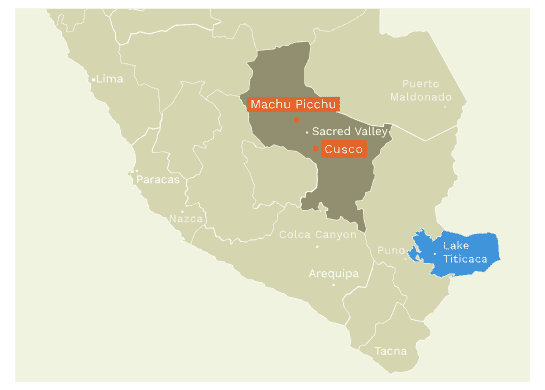
The city of Cusco represents the sum of hundreds of years of indigenous and cultural fusion throughout the southern Andes of Peru. Excavations in the Cusco basin have uncovered artifacts and temples from the ancient Killke Culture dating as far back as 900 AD.
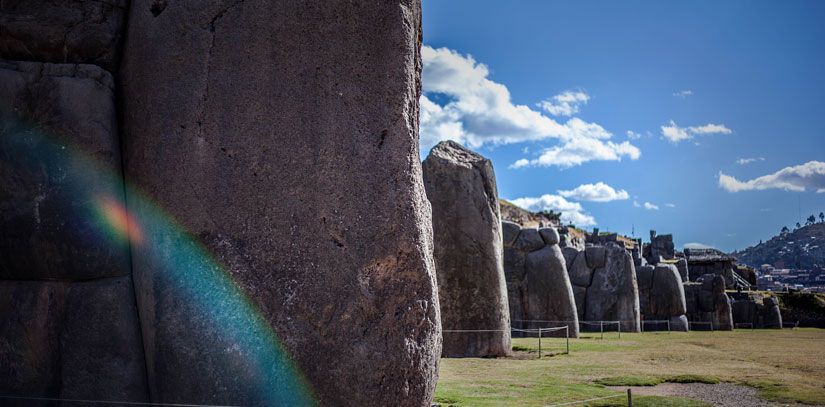
The Inca civilization began to develop as a city-state in 1200 AD, first co-existing with and then gradually absorbing neighboring ethnic groups. Inca oral traditions recorded after the Spanish conquest remember Manco Capac as the first Inca king.
Expansion of the Inca Empire did not begin until 1438, under the reign of Pachacutec-Cusi Yupanqui, whose name means "earth-shaker." The Inca called their lands Tawantinsuyu, which spread over much of South America and used their imperial capital of Cusco to impose political, religious, and administrative control.
The rectilinear layout of Cusco's streets is an Incan legacy. Pachacutec ordered the city rebuilt in the shape of a puma. The rivers Saphi and Tullumayo were canalized to control flooding and formed the outlines of the puma's body (the rivers continue to run underground), its loins centered on Qorikancha, and its head represented by Sacsayhuaman. This area of Cusco was reserved for the elite: the king and his lineage, priests, noble families, and their retinues. Separate areas were designated for agriculture, artisanry, and industry.
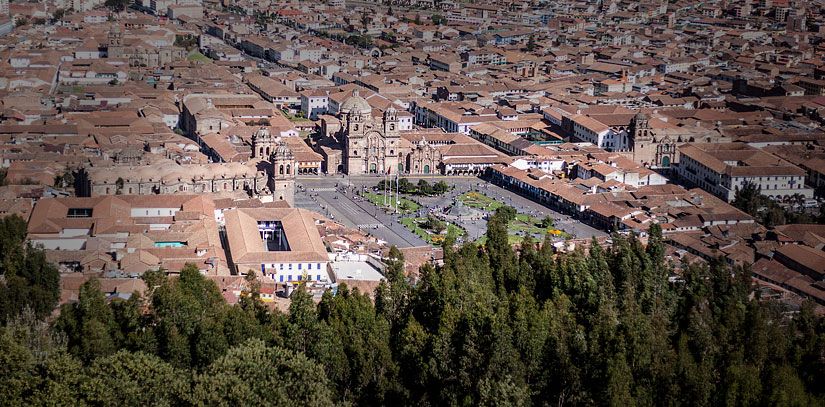
Francisco Pizarro and Spanish soldiers landed on the shores of the Inca Empire in 1531, thus marking the beginning of the end for the Inca. For a captivating re-telling of the Conquest and collapse of the Inca Empire, we suggest reading The Last Days of the Incas written by our Peru Specialist Kim Macquarrie.
In the years after the fall of the Inca Empire in 1533, the Spanish took control of Cusco. Many Inca palaces and temples were toppled completely, and the stones were used as the building blocks of Spanish-style churches and casonas. But in some cases, the Inca walls were kept intact and incorporated into the new buildings. Santa Clara Monastery, the Archbishop's Palace, and Palacio Nazarenas (formerly a convent, now a 5-star hotel) are examples of buildings with long sections of Inca walls that are on display to admire today.
Travel Tips
Traveling to Peru in the peak season (June, July, August) requires a lot of planning several months in advance. This includes booking hotels in Cusco and Aguas Calientes (Machu Picchu), flights to/from Cusco, train tickets to/from Machu Picchu, Huayna Picchu tickets (limited to 400 and sell out weeks in advance) and Inca Trail permits if applicable.
Altitude Sickness
Altitude sickness is a common health concern for travelers arriving in Cusco. Acclimation varies widely by individual, but many people adjust within 24 to 48 hours. Minor symptoms include headache, fatigue, insomnia, and loss of appetite. Severe reactions to high elevations are rare and hard to predict.
Before you travel, ask your doctor about medications to prevent altitude sickness. During your stay to Cusco, keep hydrated, avoid heavy meals, and try the local remedy, coca leaf tea. If you're planning to trek to higher elevations, plan to spend a few days acclimating in Cusco before beginning the journey.
What to Pack
Cusco day excursion checklist:
- Bring a daypack with snug straps
- Carry a bottle of water and stay hydrated
- Camera or phone with charged batteries
- Sweatshirt or jacket in case the temperature cools off
- Extra soles to purchase any souvenirs that grab your attention or for tipping (at your discretion)
Dry season packing suggestions:
- Wear light, comfortable clothes while you are out touring. Long-sleeve shirts and pants are recommended for extra protection from the sun.
- Bring a wide brim hat, sunglasses, and sunblock. The sun is quite intense at Cusco’s high elevation.
- Pack a cozy fleece or jacket. Temperatures in Cusco change drastically from day to night, especially during the peak dry season from June until August. If you need extra warmth, buy a handknit hat, mittens, and scarf at Mercado de San Pedro.
Rainy season packing suggestions:
- Wearing the right clothes to stay dry can make the difference between an enjoyable experience and a wet, miserable one. Stick to wearing jeans indoors, and opt instead for long pants made of synthetic, quick-drying fabric while outside in the rain.
- Pack an umbrella to using during day tours. Or, if you prefer, wear a rain poncho.
Best Place to Stay in Cusco
The best area to stay in Cusco is in the historic downtown, which has countless restaurants, museums, Inca ruins, and other top attractions within easy walking distance. Some of the city’s most charming hotels are an uphill walk from the Plaza de Armas in the San Blas neighborhood, which might not be the best option for anyone with physical limitations or concerned about overexerting themselves in the high elevation. Cusco accommodation ranges from backpacker party hostels, AirB&B, and comfortable hotels that include complimentary breakfast. Check out our preferred places to stay in the Hotels section above.
Getting Around Cusco
Walking is the best way to get around the historic center of Cusco. You can stroll from one side of the historic center to the other within 15 to 20 minutes. Around the Plaza de Armas you’ll find Cusco’s top attractions, restaurants, and nightlife options. The area around the main plaza is mostly flat, but the streets become steeply inclined when you walk toward the San Blas, San Cristobal, or Santa Ana neighborhoods.
How to Get from Cusco to Machu Picchu
- Cusco is a 4-hour train trip from the Machu Picchu Station in Aguas Calientes. To catch the train in Cusco, you need to drive to the Poroy Station about 20 minutes from the city’s Plaza de Armas.
- Travelers can also trek to Machu Picchu. Trekking packages are arranged so that you are picked up from your hotel in Cusco and then driven to the trailhead in the Sacred Valley. The iconic 4-day Inca Trail starts from KM 82 along the railway tracks in the Sacred Valley and is a 27 mi (44 km) journey on foot all the way to Machu Picchu’s Sun Gate.
Things to Do

Plaza de Armas

San Blas Neighborhood

Cusco Cathedral

Santo Domingo Church encloses one of Cusco's most impressive Inca ruins, the Coricancha or Temple of the Sun. According to chronicles written after the Spanish conquest, it was the largest and most opulent temple in all of South America, filled with gold, silver, and precious jewels. Inca oral traditions indicate that the temple, dedicated to the worship of Inti, the sun god, was built during the reign of Manco Capac in the 12th century atop a pre-existing temple. Beginning in 1536, Santo Domingo Church was built upon the ruins of the Coricancha, but tantalizing vestiges of the former Inca temple were kept intact. The most intriguing feature is an exceptionally well-crafted semicircular wall that's visible from Avenida El Sol.

Sacsayhuaman
The Sacsayhuaman ruins are on a hill overlooking Cusco and rise in front of a vast esplanade the length and width of four football fields. The original Inca-built walls were 10 feet (3 meters) taller. On the topmost platform were three circular towers. The gargantuan scale of Sacsayhuaman's zigzagging, terraced walls will make your jaw drop, even more, when you realize they represent just a fraction of the original site.

Tambomachay

Museum of Pre-Columbian Art (MAP)

Inka Museum

San Pedro Market

Cusco Planetarium
The Inca Empire placed profound importance on astronomy. The observations they made in their natural environment, like those up in the sky, were deeply rooted in their spiritual beliefs and day-to-day activities. A visit to the Planetarium Cusco is an opportunity to learn about Inca constellations and the southern night sky. If the weather permits, you can observe the star-studded sky over Cusco through a telescope. The planetarium is a family-run project located in an Andean-style house with adobe walls up in the surrounding hills next to Sacsayhuaman about a 10-minute drive from the Plaza de Armas.
Note: The Cusco Tourist Ticket (or boleto turístico del Cusco) gives you access to a variety of Inca ruins and museums. The popular Full Ticket is valid for ten days and includes entry to sixteen attractions, including Sacsayhuaman, Qorikancha, the Museum of Pre-Columbian Art, and many more.
As one of Peru's most popular destinations, Cusco boasts a range of hotels for every budget. Within the historic center of the city, you'll find colonial buildings that have been restored into elegant 4- and 5-star hotels, old family houses converted into cozy guesthouses, and everything in between. The following are our Top Pick Hotels in Cusco, selected for their excellent amenities, outstanding service, and convenient location.
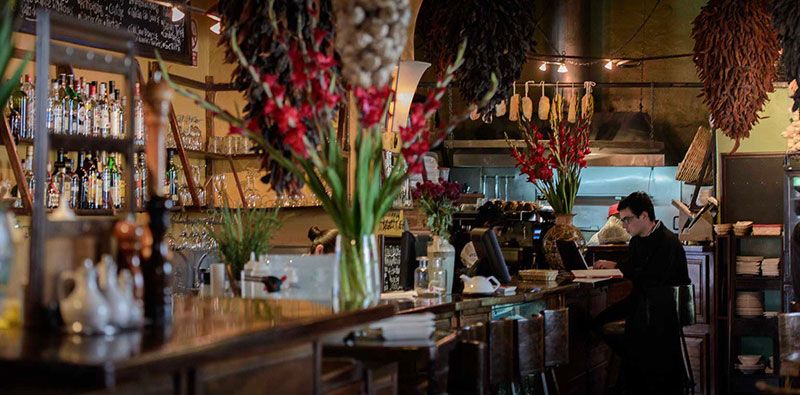
Palacio del Inka
Plazoleta Santo Domingo 259, Historic Center, Cusco

Casa Andina Premium Cusco
Plazoleta de Limacpampa Chico 473, Historic Center, Cusco

Casa San Blas
Tocuyeros 566, San Blas, Cusco

Anahuarque Boutique Hotel
Calle San Agustin 236, Cusco
Restaurants

Morena Peruvian Kitchen
Cultural events.

Tour Packages
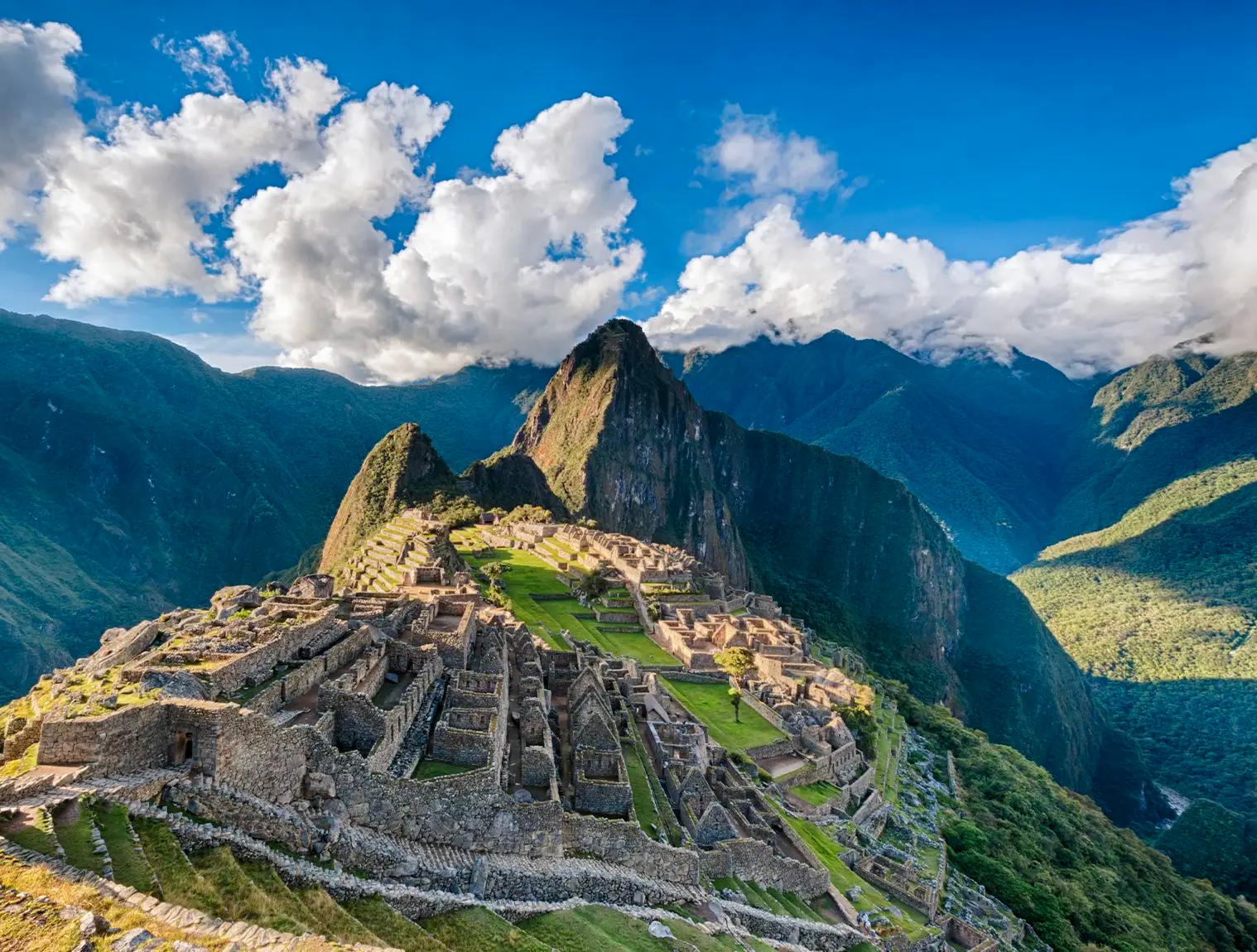
6 days from $ 1249
Cusco, Sacred Valley and Machu Picchu
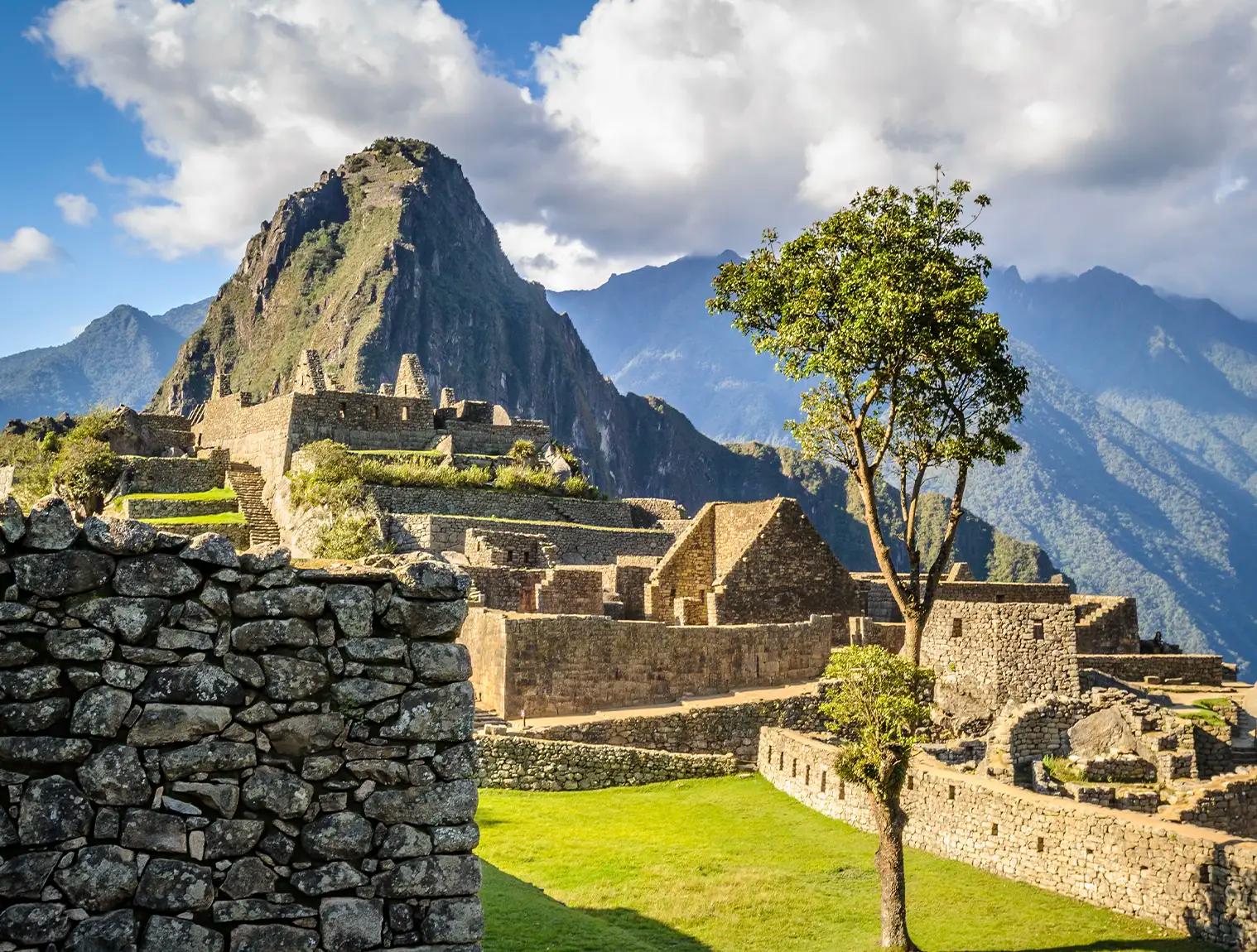
4 days from $ 989
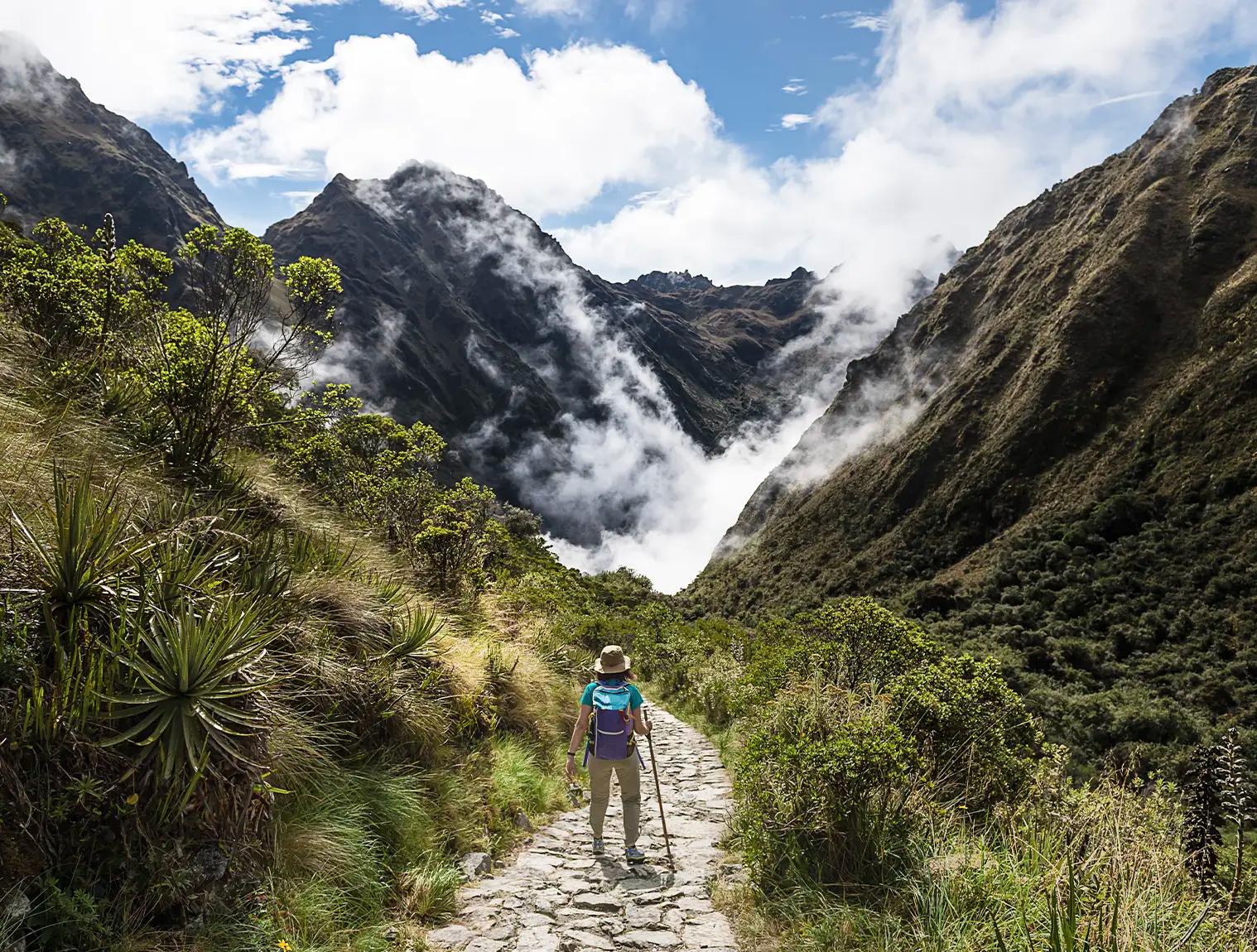
9 days from $ 2069
Cusco, Inca Trail, Sacred Valley & Machu Picchu
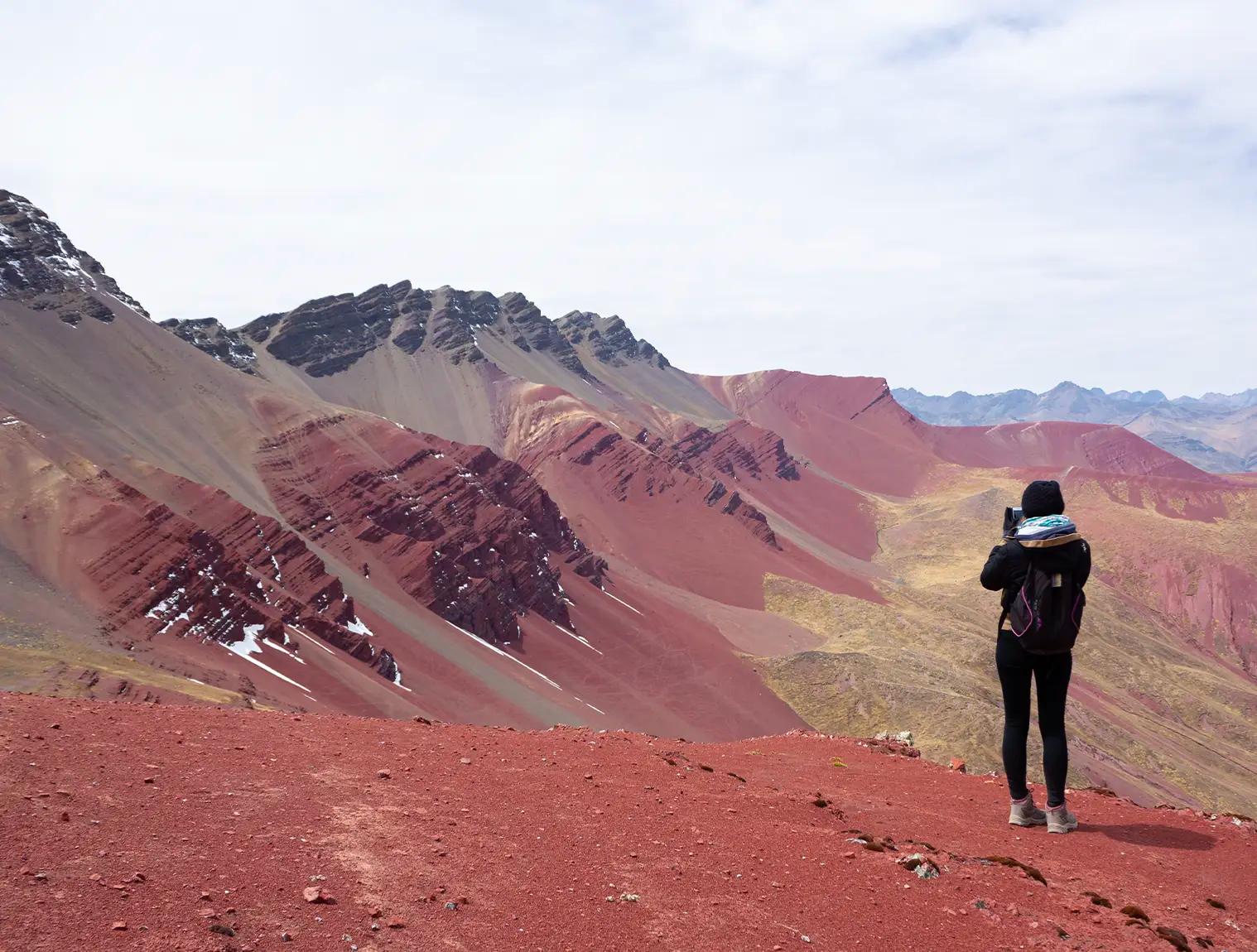
6 days from $ 1719
Cusco, Rainbow Mountain, Machu Picchu & 2-day Inca Trail
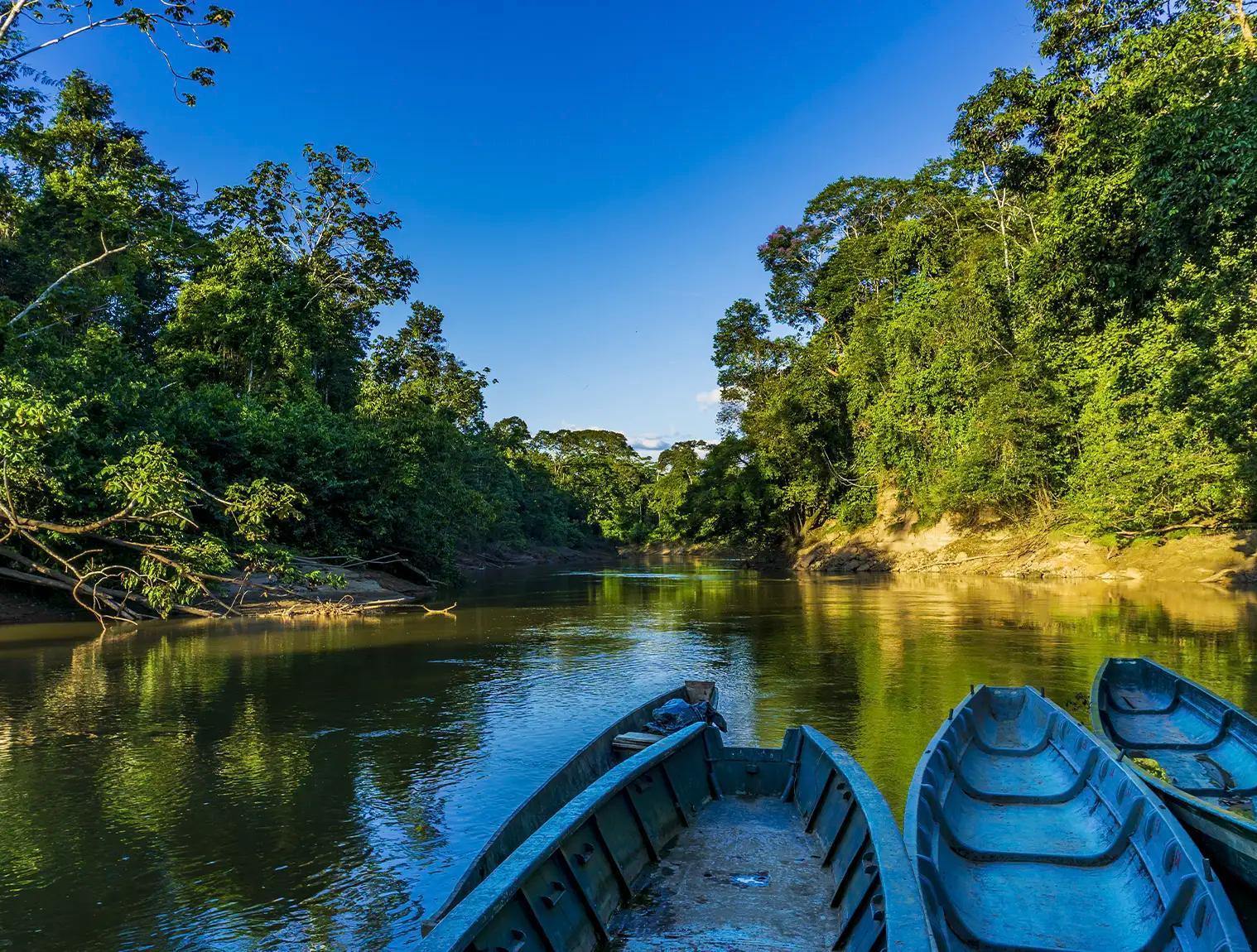
12 days from $ 2549
Machu Picchu, Sacred Valley, Cusco, Amazon, Arequipa & Colca Canyon
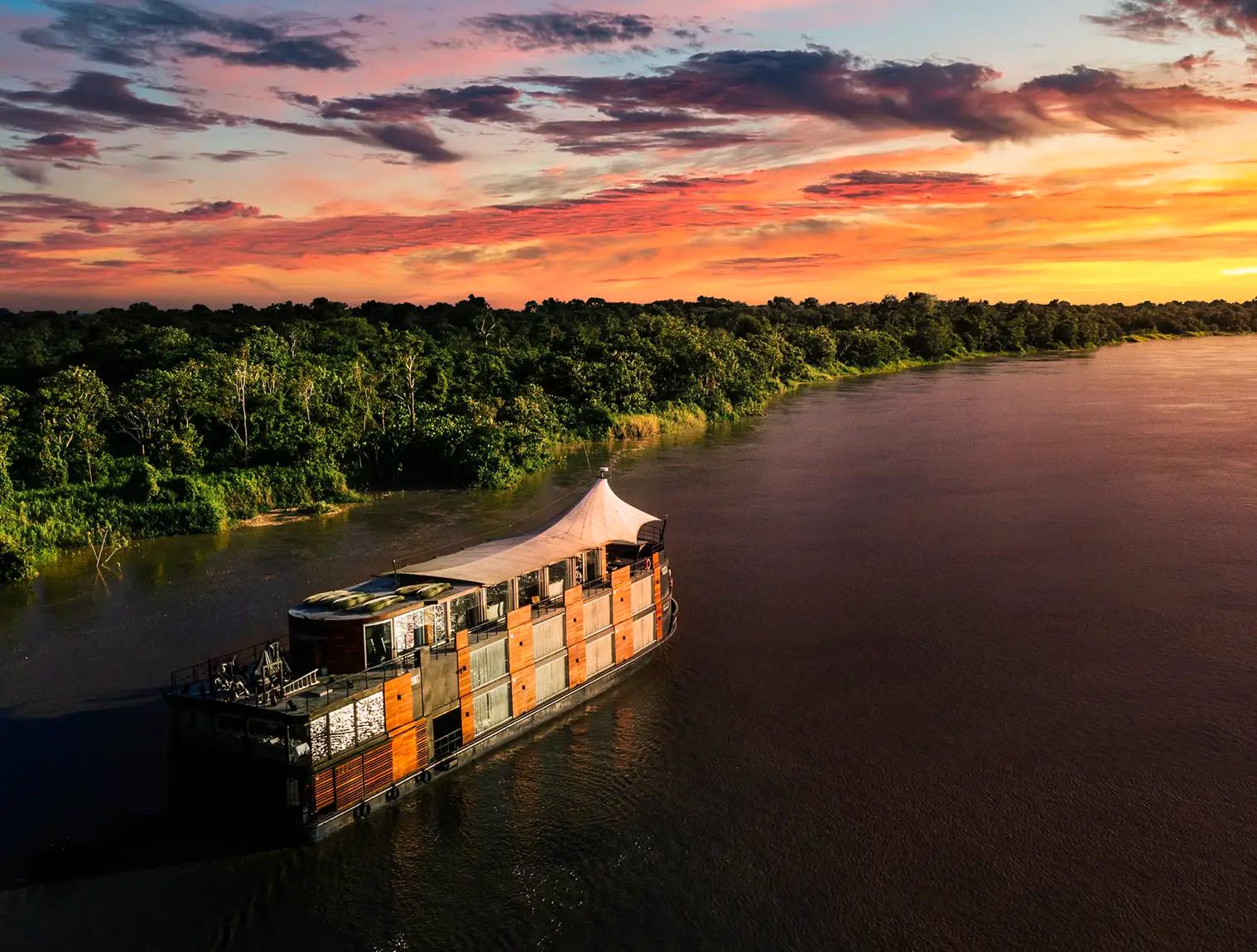
9 days from $ 3649
Cusco, Sacred Valley, Machu Picchu, Lima & Amazon Cruise
How long should I stay in Cusco?
What is the elevation of cusco, is cusco safe, where are the best places to shop in cusco, how can i visit the sacred valley from cusco, what’s included in a city tour of cusco, how can i visit rainbow mountain from cusco, where is the best place to exchange money in cusco, where is the cusco airport, how long is the flight from cusco to ____, how far is cusco from ____.

Book With Confidence
We're flexible! Postpone your tour with zero cost up to 10 days prior to departure.
Email: [email protected]
Sign up to receive our newsletter for great articles, stunning photos, and special deals.
1-817-230-4971
Sales & travel support
Cusco, Peru: The Ultimate Visitors Guide
Cusco, the ancient Inca capital, is a mix of Incan and Spanish architecture and history, with picturesque cobblestone stairs to climb up the narrow one-way streets. This UNESCO World Heritage Site is the starting point for the most spectacular things to do in Peru, like Machu Picchu and the Sacred Valley.
Itinerary Cusco Peru
Cusco is a fantastic city that functions as the perfect base for day trips to the Rainbow Mountain or Sacred Valley. Easily fill three to six days with all the things to do in Cusco .
It is a very safe city, a little more expensive than other cities in Peru, but the world-class restaurants are worth the extra dollars.
Here are all your hotel options in Cusco.
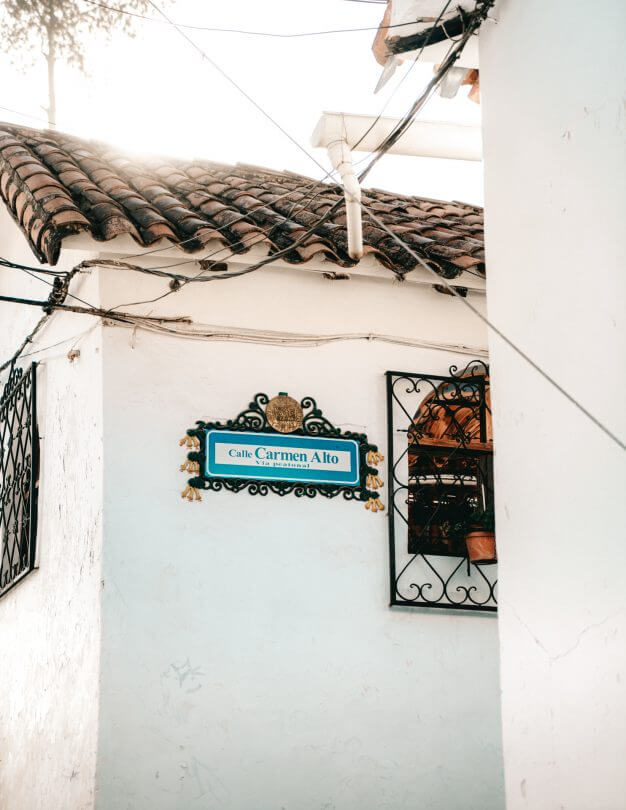
Day 1 – Cusco City
For your first day in Cusco, take it slow and let your body adjust to the altitude. Wander around in the San Blas District , sip a Peruvian coffee on the balcony of L’Atelier , and have lunch at Greenpoint .
Also: Discover the surprising capital Lima, Peru .
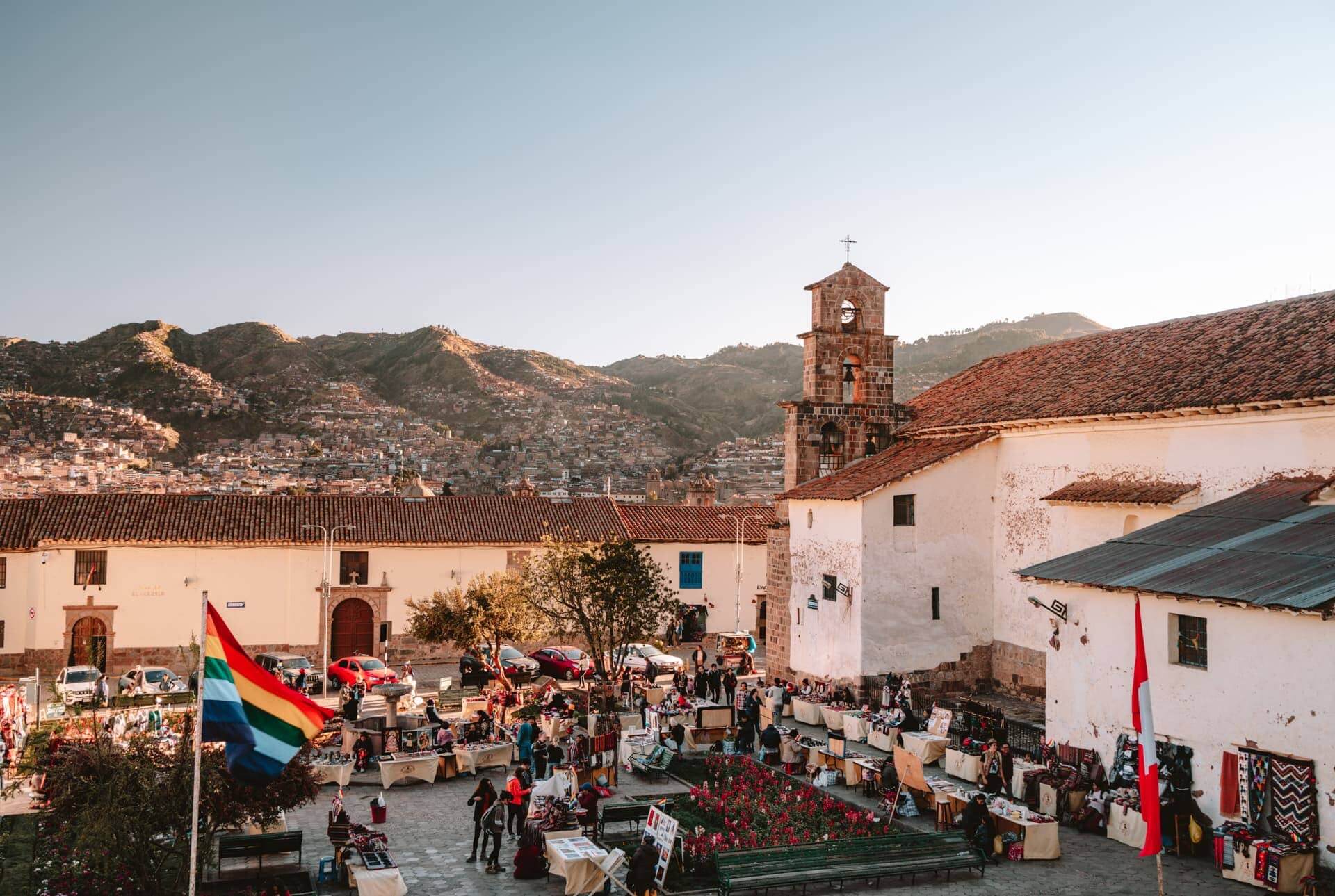
With your bellies filled with the finger-licking good food of Greenpoint, roll downhill to Qoricancha , the former Incan temple.
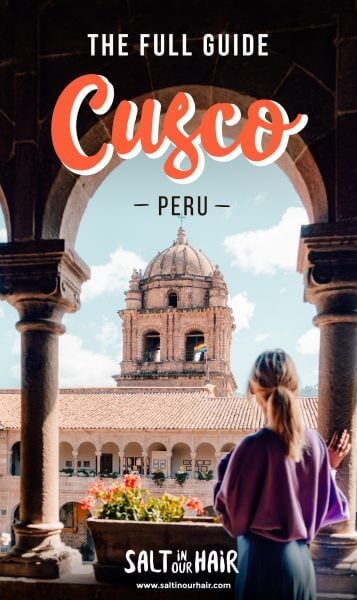
Finish off by visiting the local San Pedro Market where they sell everything from fruits and veggies to souvenirs. But wait, don’t buy your dinner at the market. Eat a Ceviche at Morena – it will be the best one you have in Peru!
Read more about the things to do in Cusco
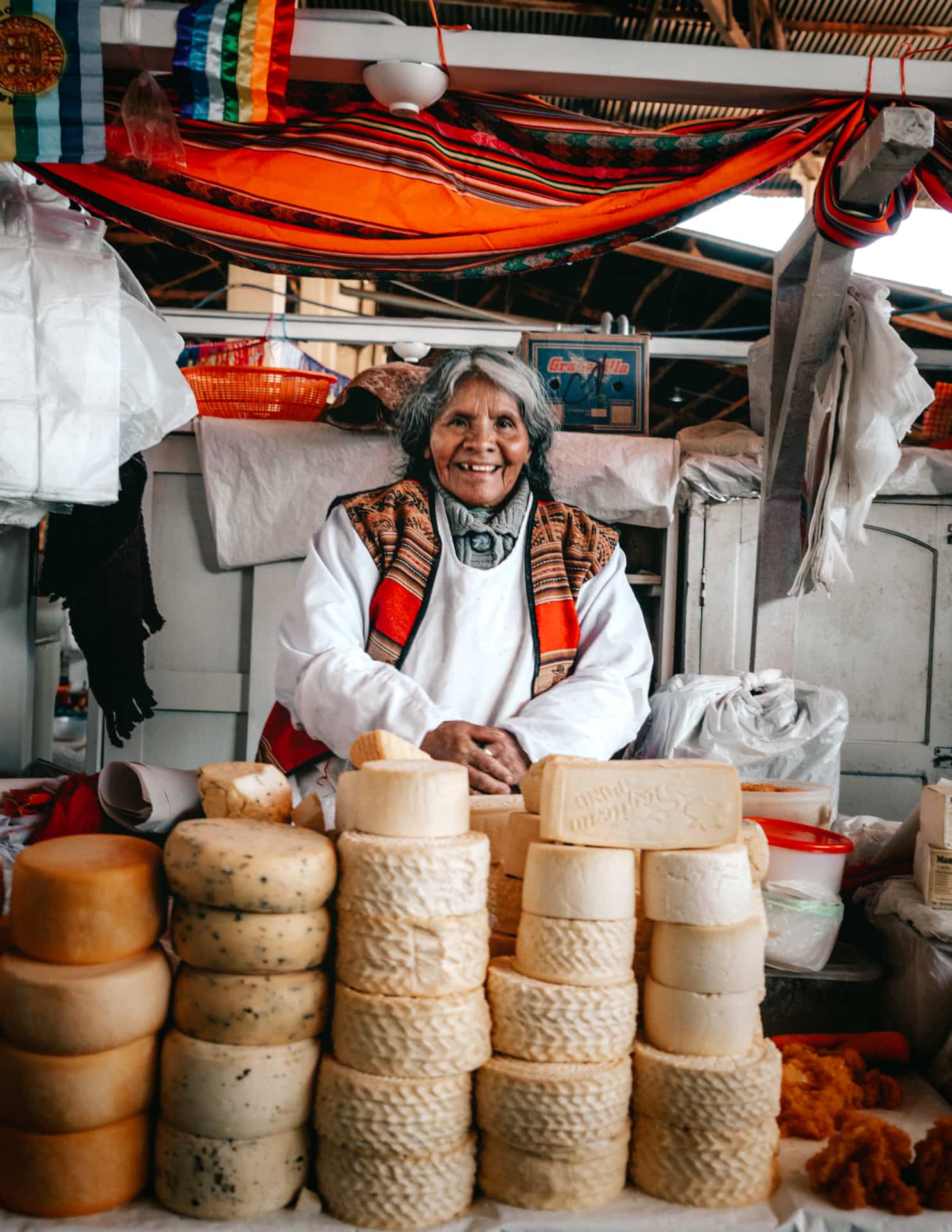
Day 2 – Sacred Valley Tour
Our guide to Peru’s Sacred Valley will show you the best things to do in the area of Cusco, the former Inca empire. Explore the beautiful ruins of Pisac, Ollantaytambo, Moray, Saqsaywaman, Chinchero, or Maras Salt Mines.
See tickets and availability for a Sacred Valley tour
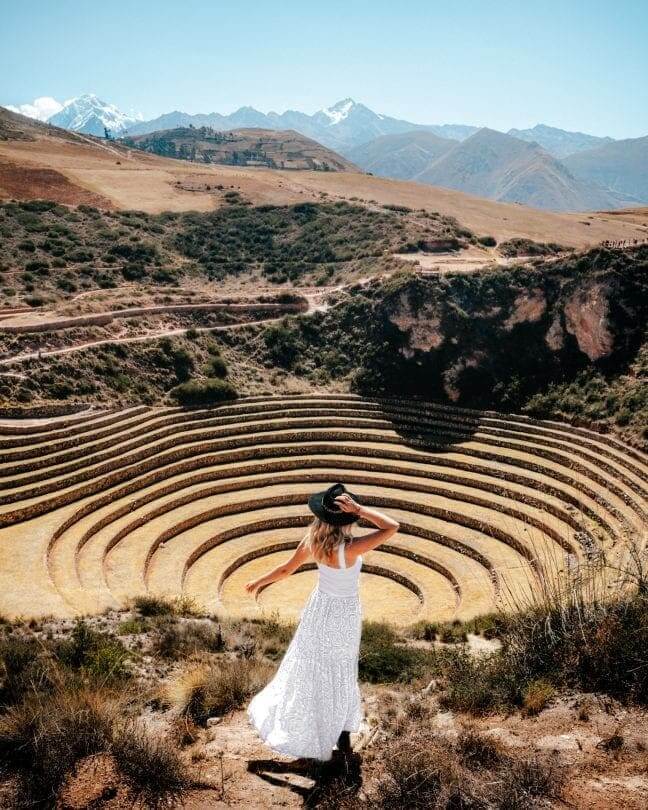
The Sacred Valley holds circular stone terraces, salt mines, and possibly the best scenic valley views of Peru . Visit Pisac, Ollantaytambo, Moray, and the Maras Salt Mines on a full-day tour from Cusco.
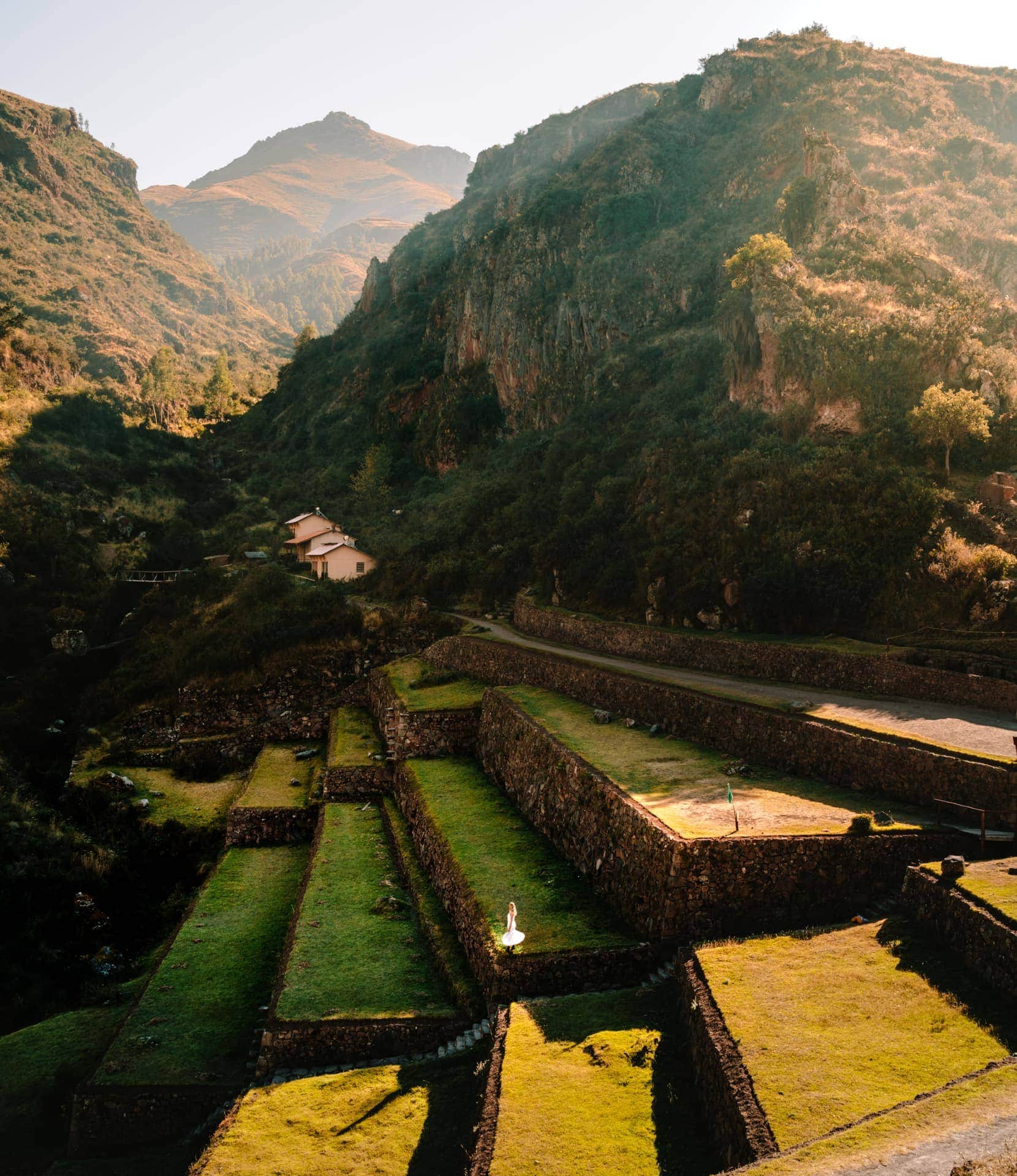
Day 3 – Rainbow Mountain
Wake up around 3 AM and sleep a little more in the 3-hour drive towards Rainbow Mountain. A 1 to 2-hour trek at 5000+ meters brings you to yellow, orange, blue, and red mountain tops. You can visit either the Vinicunca or Palccoyo Rainbow Mountain on a tour from Cusco.
Most tours include return transportation, a guide, and even meals. It’s also possible to do a tour in 1 full day. Alternatively, choose a longer hike over 2 days with a camping adventure included.
Must-read: Complete 3-week Peru Travel Guide
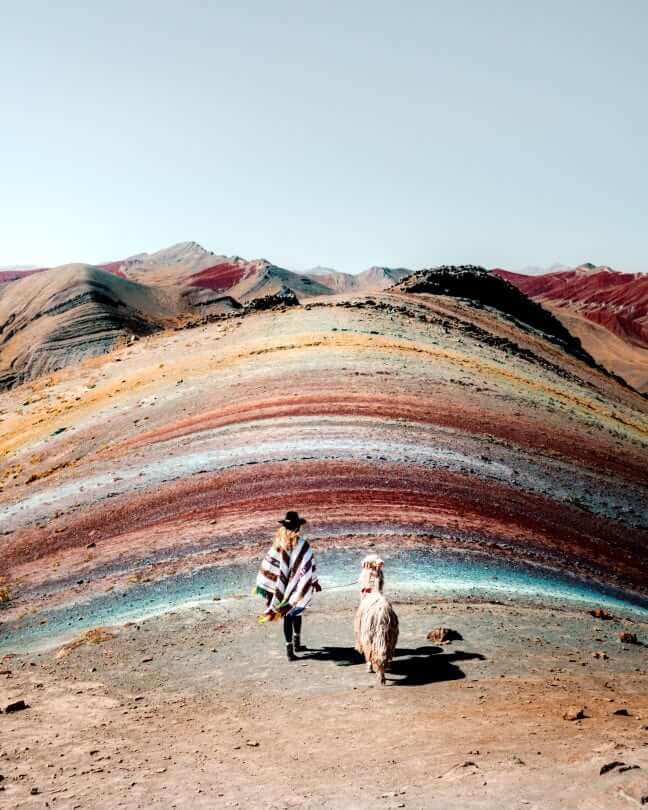
Day 4 – Cusco City
After two early mornings, sleep in a little bit and take it slow by exploring a bit more of the city. Start by visiting Saqsayhuaman , an old fortress with a great view over the entire valley. Make your way down to Cusco’s Historical Centre, where the cathedrals and Plaza de Armas are located.
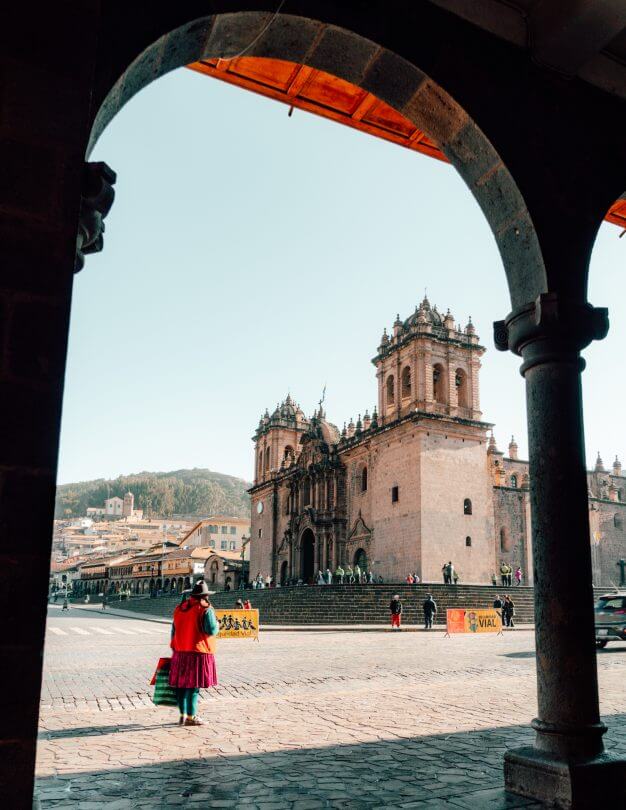
Relax with a delicious lunch at Rucula but don’t eat too much as up next is a Chocolate Museum . If you are into shopping; the boutique shops are worth your time! Around sunset, walk up to one of the many viewpoints overlooking the city and have dinner at Takysan for some incredible vegetarian Sushi!
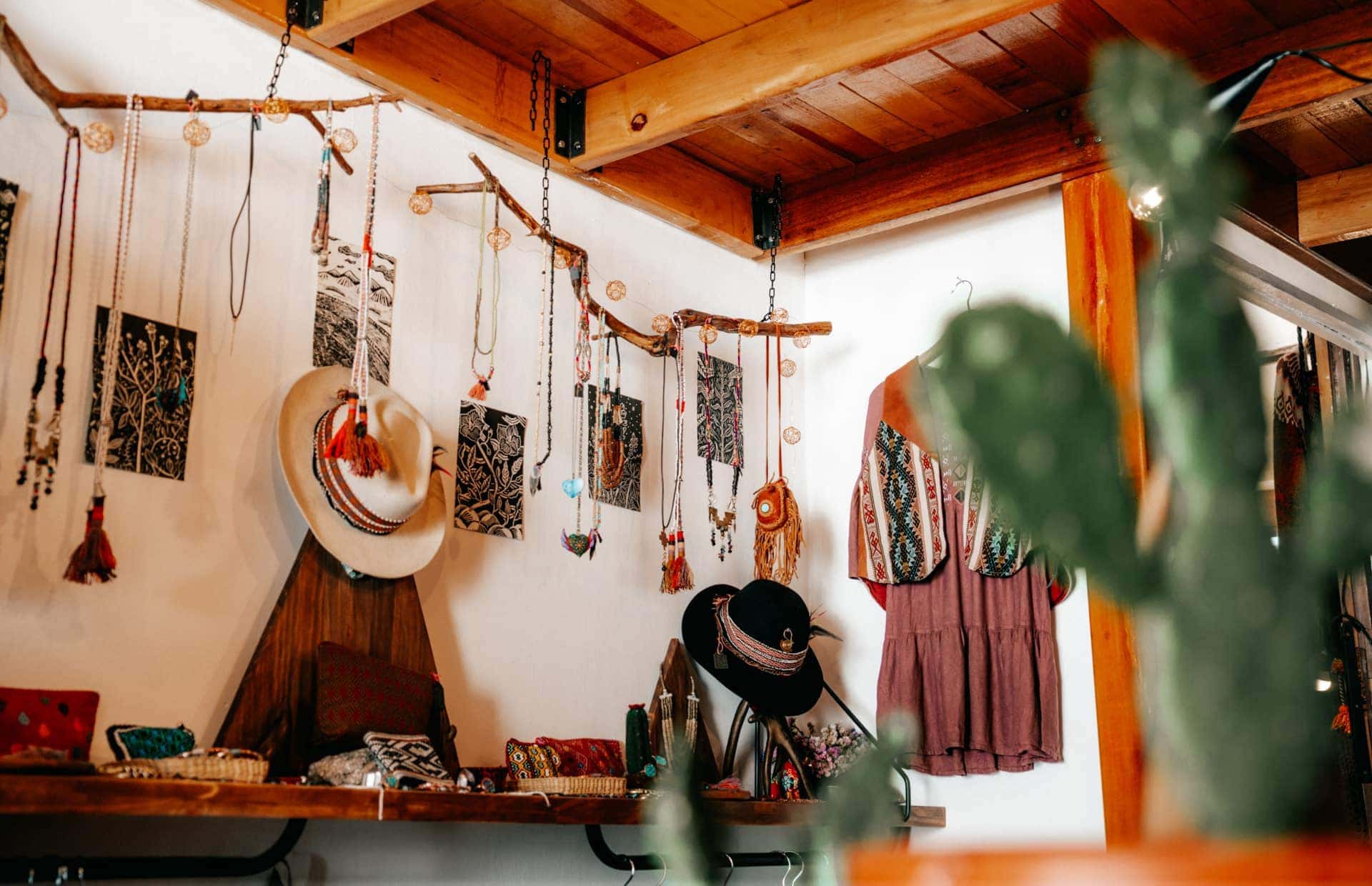
Day 5 – Machu Picchu Day Trip
A visit to Machu Picchu , the lost Incan city is a highlight of everyone’s Peru trip. From Cusco, you are able to do a day trip by taking the scenic train ride from Ollantaytambo. However, if you want to see the sunrise at Machu Picchu, then head there one day in advance and spend the night in Aguas Calientes.
Alternatively, book an organized day trip to Machu Picchu that includes a tour guide, entrance ticket, and return transportation from your hotel to the train station.
Book your tour to Machu Picchu here
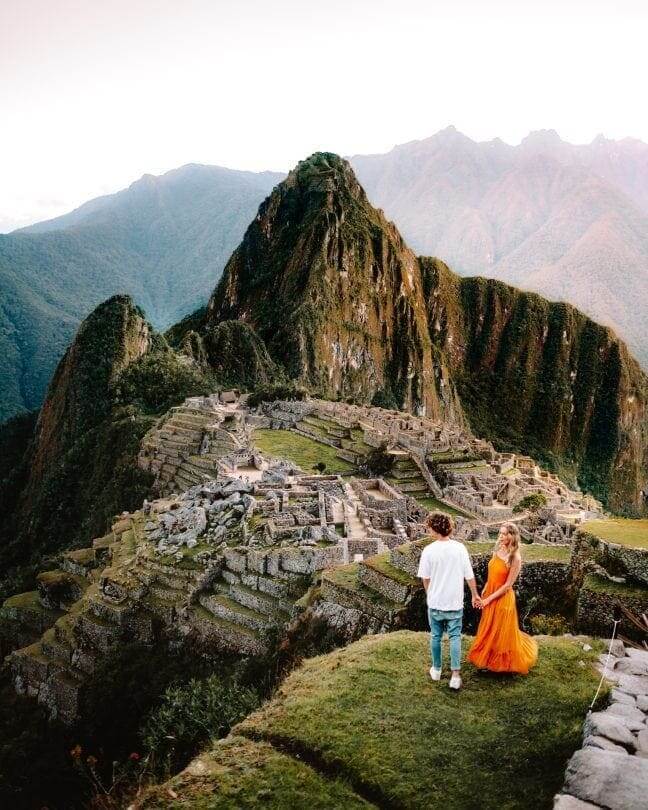
Day 6 – Humantay Lake
Your last day in Cusco is a hike to the pristine blue Humantay Lake located at an altitude of 4,200 meters. You can visit Humantay Lake in a 3-hour drive and 2-hour hike. If you need return transportation (and think you would benefit from a guide), you can book an organized tour to the lake.
This beautiful day trip will take you to the end of your time in Cusco. Please do not use the poor horses at Humantay and hike instead.
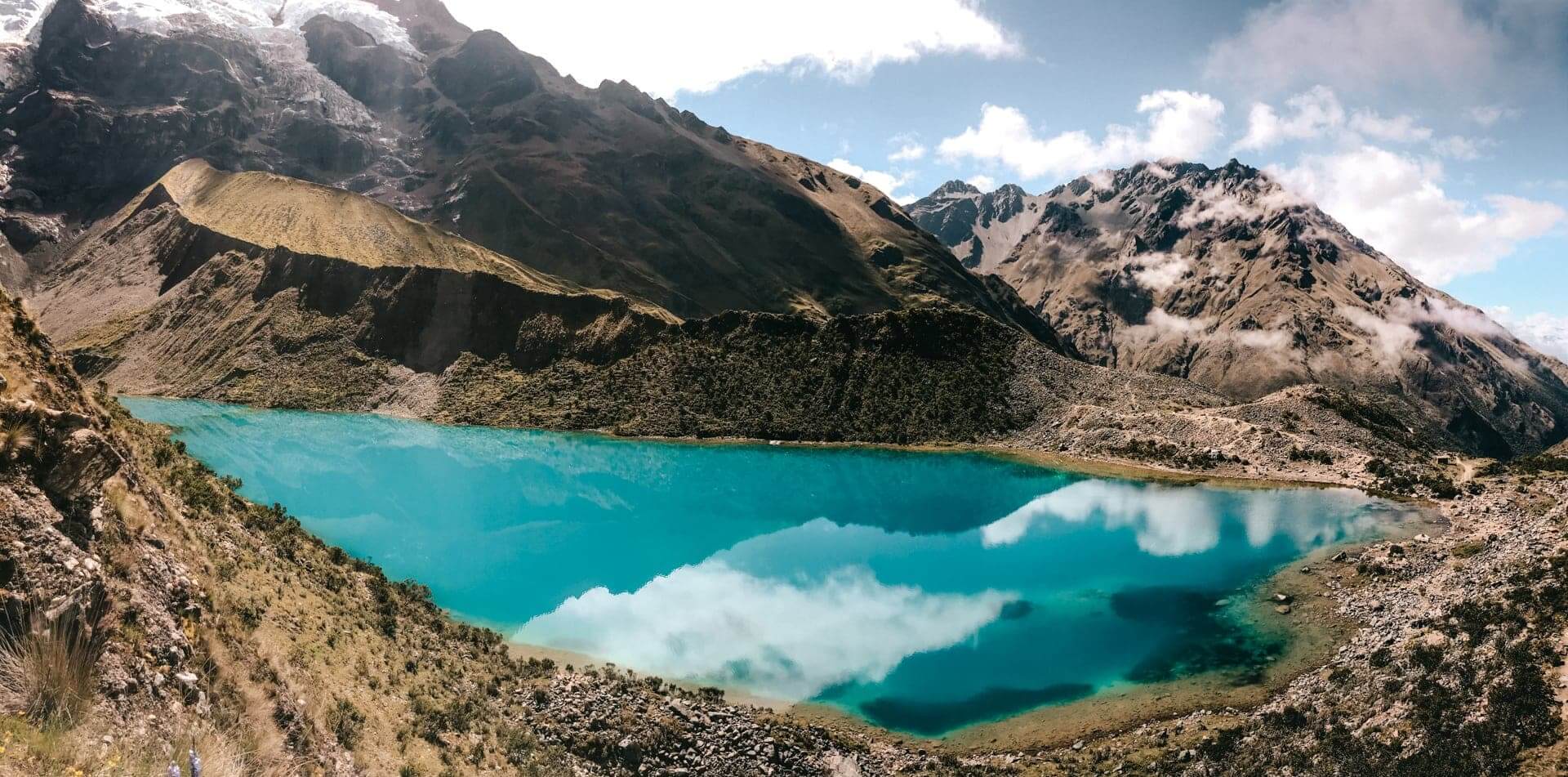
How to get to Cusco, Peru
The relatively small city of Cusco is best to reach by comfortable night bus or via Cusco’s international airport.
By Air – There are direct flights to Cusco from Lima (1h), Arequipa , La Paz (Bolivia), or Bogota (Colombia). From the airport, it is a short 15-minute taxi ride into the city center.
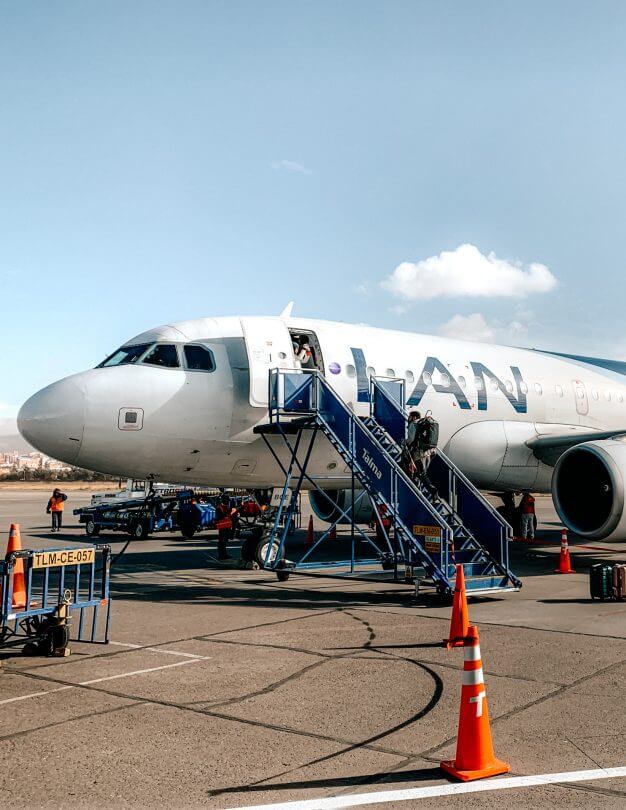
By Bus – The bus, on the other hand, allows you to slowly get used to the altitude. The best route to take is from Arequipa to Cusco (12h) inside the super comfortable night bus. The bus cannot enter Cusco’s main city center, so from the bus stand, you will need to get a taxi or Uber.
Book bus tickets online
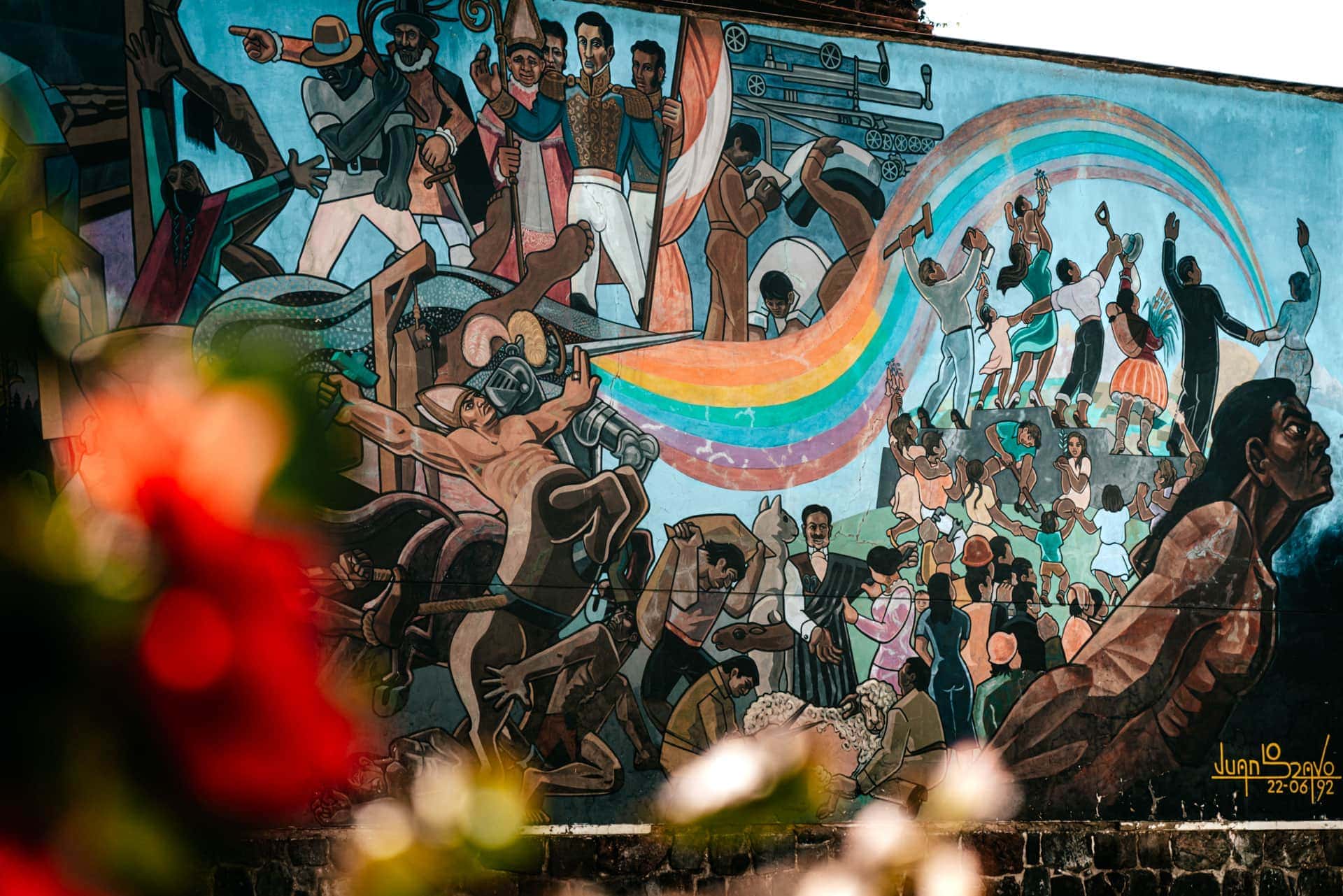
How to get around Cusco, Peru
By foot – Getting around Cusco is simple. Most of the city’s sights are within walking distance just remember to take your time on the sloping streets, as you will feel the altitude while climbing up the stairs. By taxi – Taxis are a good choice in Cusco as they all charge the same standard rates of 3-6 Soles per trip. (~ 1-2 USD)
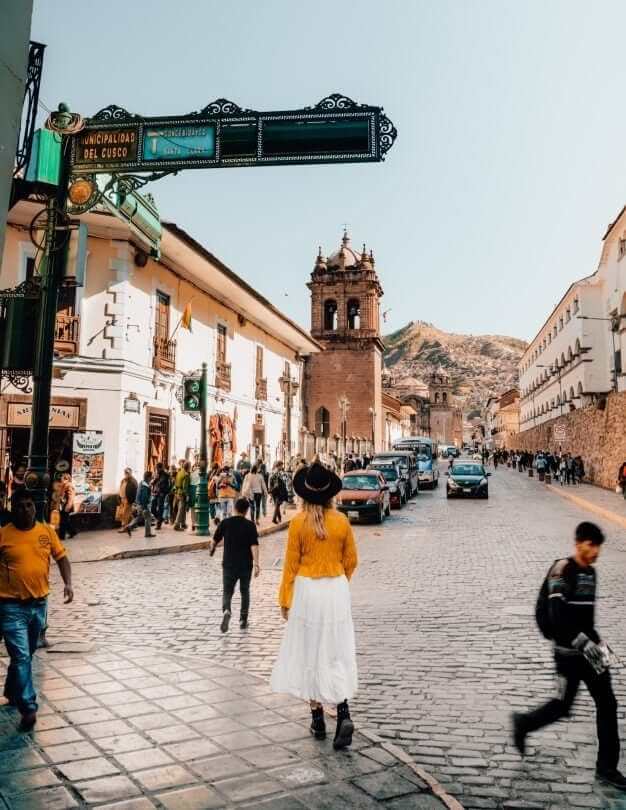
Best Hotels in Cusco
Whether you are on a backpacking budget or looking for a little more luxury, Cusco offers every kind of accommodation to suit your needs. There is no wrong area to stay in as long as it is 15 – 20 minutes walk to the city center. Personally, we would recommend the San Blas neighborhood. You can also find great hostels all around the city ( search for a hostel here ).
Hotels in Cusco 😴
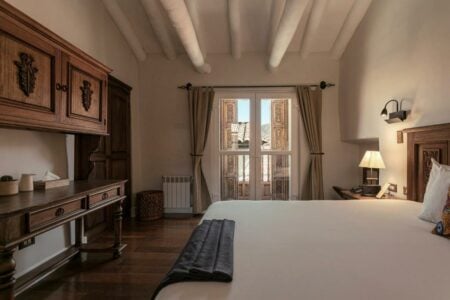
Best time to visit Cusco
Cusco has clear skies and comfortable temperatures from May to September, which is their winter.
Try to avoid June to August as these are the busiest months tourism-wise. The best time to visit Cusco would be in April and May or September and October.
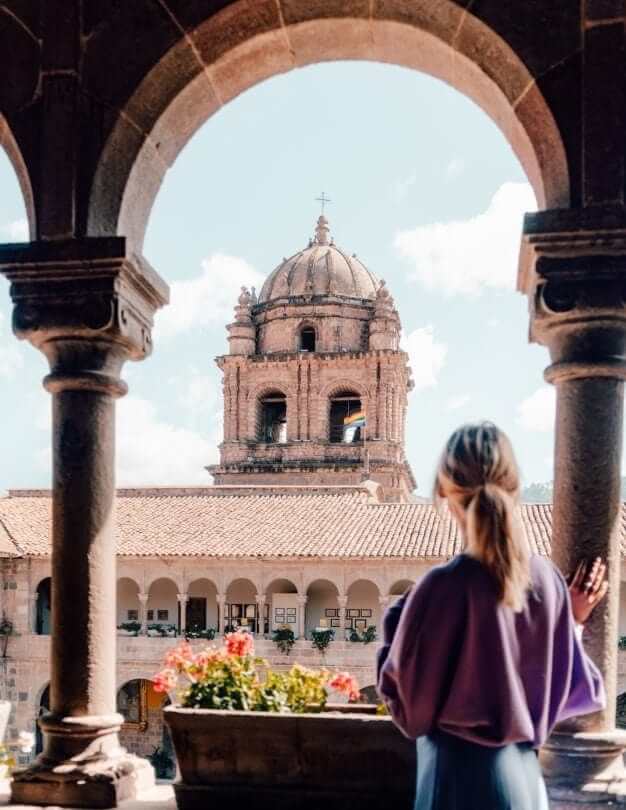
Best Restaurants in Cusco
The popularity of Cusco attracts many great chefs to the city. Cusco has some of the best restaurants in the country, from Italian and Japanese to Peruvian. And if you’re a vegan, Cusco is vegan heaven! These were our favorite restaurants in Cusco, Peru:
- Morena (trendy & delicious)
- Green point (incredible vegan food)
- Takysan Sushi (best sushi in Cusco)
- Qura Bowl Bar (poké bowls)
- Avocado, toast & more
- Rucula (try the pizza)
Fun fact: Due to the altitude, it takes longer to boil water. So, be a little more patient when ordering food (and showering).
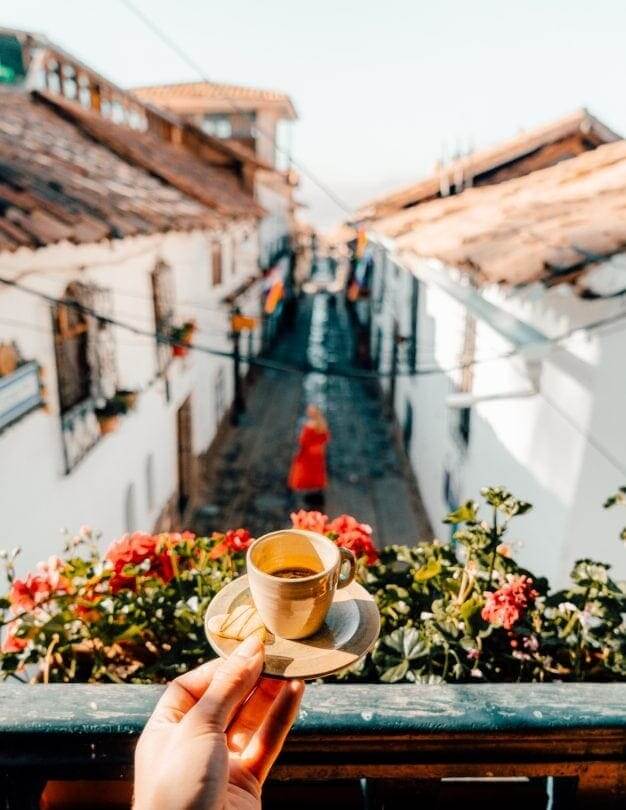
Altitude sickness in Cusco
At 3,400 meters (11,200 feet), it is very likely to get small symptoms of altitude sickness no matter how fit and healthy you are. Symptoms like pain in the back of your head, heavy breathing, dizziness, and you’re having a hard time sleeping.
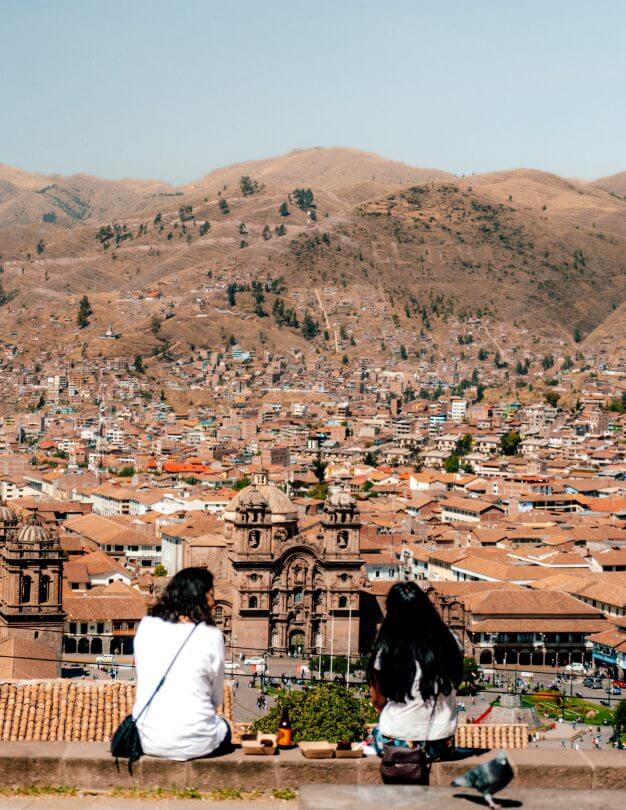
The best way to deal with the altitude is by slowly going higher. You can do this by staying in Arequipa at 2,400 for a couple of days. If you don’t have this option, take it slow in Cusco for two or three days.
Travel Insurance Don't forget a travel insurance for your Peru trip! Heymondo covers medical emergencies, theft, delays, cancellations, lost luggage, and more, with 24/7 worldwide assistance and medical chat. As a Salt in our Hair reader, we've got you 5% off! Check Heymondo here
Tip: Make coca leaf tea or use altitude sickness tablets. For most people, the natural coca leaves do the job.
By purchasing through our links, you support us at no additional cost. Thank you for your support. ♥️
- Find Hotels via Booking.com
- Find a Rental Car via Rentalcars.com
- Find Flights to Cusco via Skyscanner
- Get a Travel Insurance via Heymondo
- Book Tours & Attractions via GetYourGuide
- Book a Bus/Train/Transfer via 12Go
14 Best Things To Do in Cusco, Peru
Sacred valley peru: best things to do and see, machu picchu: tickets, accommodation, how to get there.
Looking for more travel information? Plan a chat with us for personalised travel advice or get an answer from the Salt in our Hair Travel Community on Facebook.
This looks amazing! I lived in Lima for 10 months, but never went to Cusco. I’ve been wanting to go back with my family and go to Cusco this time, so I’ll definitely use these ideas once we’re able to visit.
Your email address will not be published. Required fields are marked *
Notify me when new comments are added.

Getty Images/Flickr RF
Welcome to the navel of the world. The undisputed archaeological capital of the Americas, Cuzco is the continent’s oldest continuously inhabited city and the gateway to Machu Picchu. Cosmopolitan Cuzco (also Cusco, or Qosq’o in Quechua) thrives with a measure of contradiction. Ornate cathedrals squat over Inca temples, massage hawkers ply the narrow cobblestone passages, a rural Andean woman feeds bottled water to her pet llama while the finest boutiques sell pricey alpaca knits.
Attractions
Must-see attractions.

Museo Machu Picchu
This newish museum exhibits 360 pieces from Machu Picchu taken by Hiram Bingham's expeditions and recently returned by Yale University, including stone…

Cusco Planetarium
An excellent way to explore the fascinating Inca cosmovision. They defined constellations of darkness as well as light, used astronomy to predict weather…
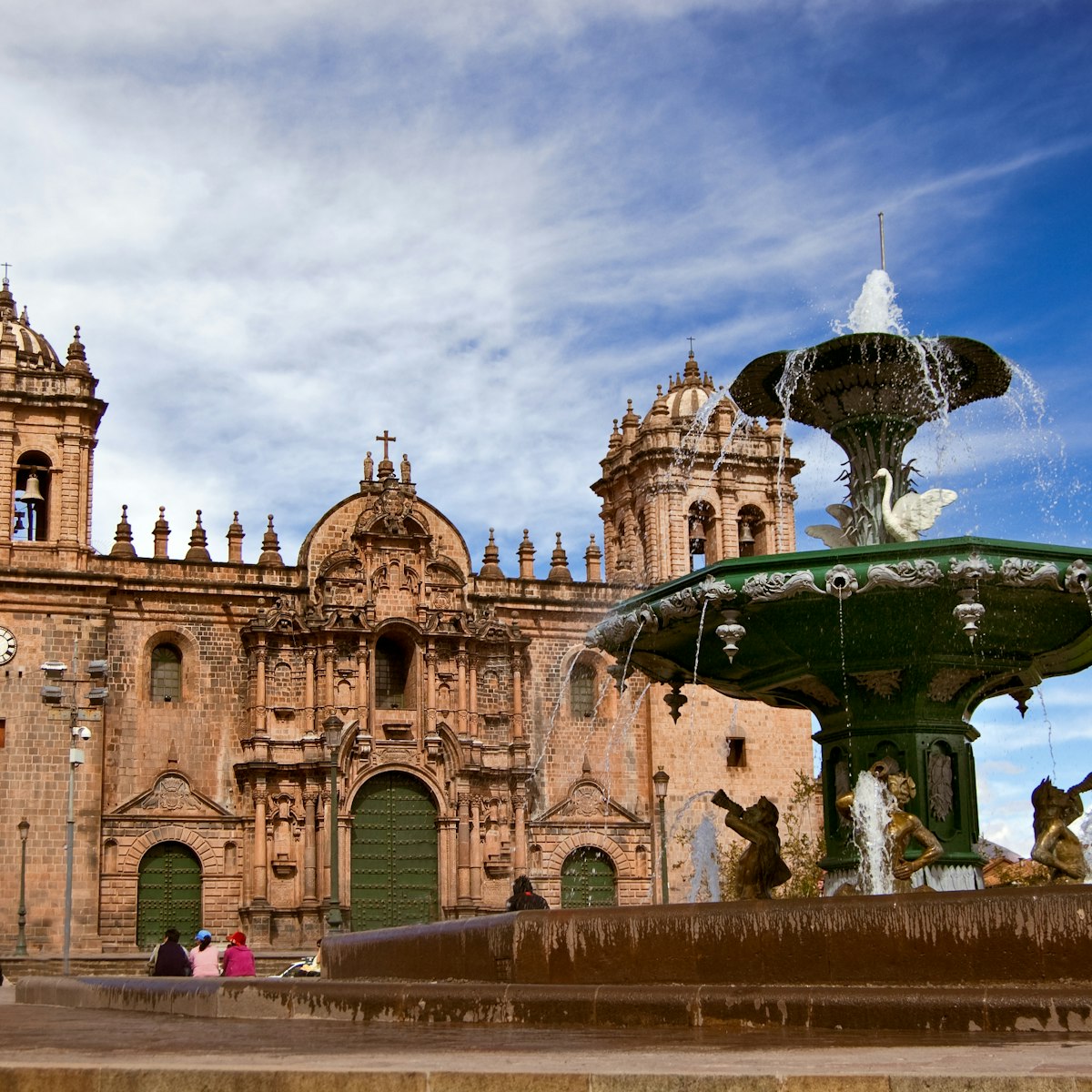
La Catedral
A squatter on the site of Viracocha Inca’s palace, the cathedral was built using blocks pilfered from the nearby Inca site of Sacsaywamán. Its…
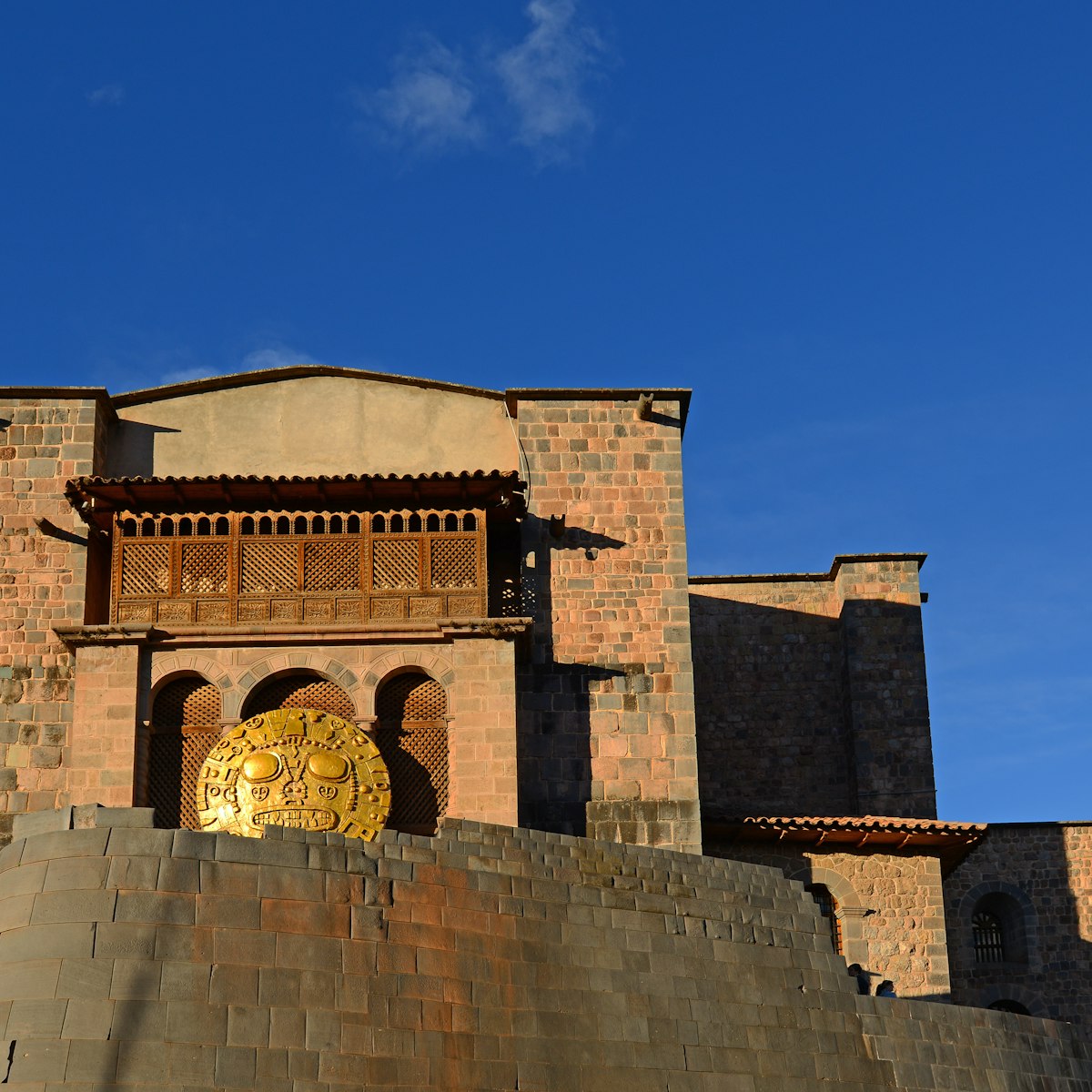
If you visit only one Cuzco site, make it these Inca ruins forming the base of the colonial church and convent of Santo Domingo. Once the richest temple…

Plaza de Armas
In Inca times, the plaza, called Huacaypata or Aucaypata, was the heart of the capital. Today it’s the nerve center of the modern city. Two flags usually…

Iglesia de La Compañía de Jesús
Built upon the palace of Huayna Cápac, the last inca to rule an undivided, unconquered empire, the church was built by the Jesuits in 1571 and…

Museo de Arte Precolombino
Inside a Spanish colonial mansion with an Inca ceremonial courtyard, this dramatically curated pre-Columbian art museum showcases a stunningly varied, if…

Templo y Convento de La Merced
Cuzco’s third most important colonial church, La Merced was destroyed in the 1650 earthquake, but was quickly rebuilt. To the left of the church, at the…
Plan with a local
Experience the real Peru
Let a local expert craft your dream trip.
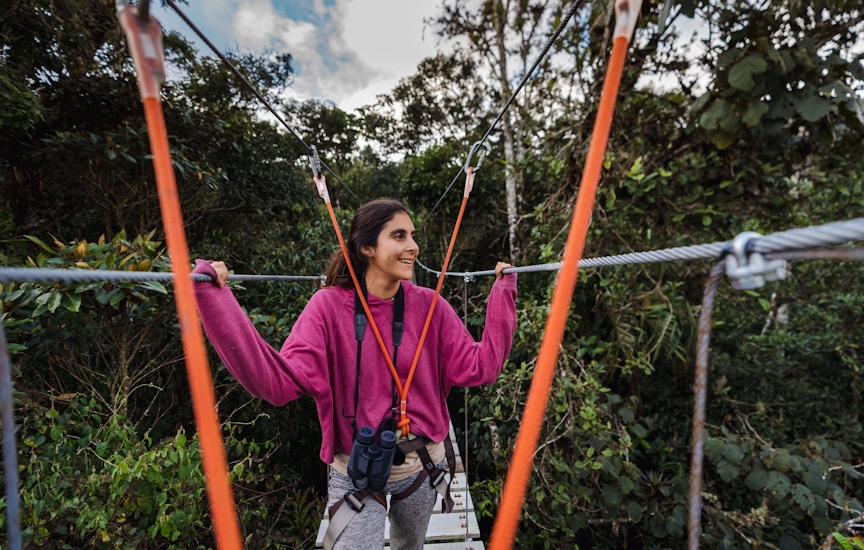
Latest stories from Cuzco
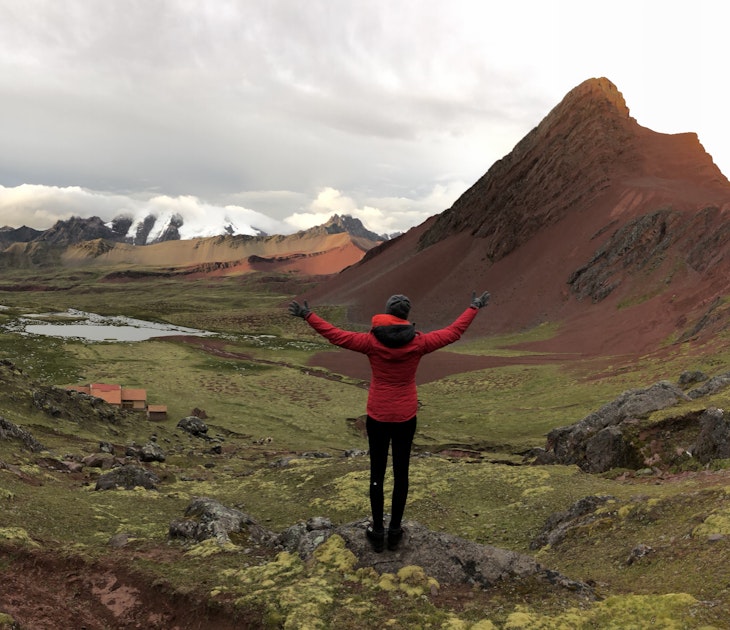
Feb 7, 2020 • 4 min read
Peru's Rainbow Mountains are stunning. But there's always a crowd. For a bit more elbow room and comparable views trek through the Ausangate Mountains.
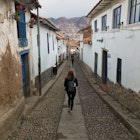
Jan 8, 2020 • 9 min read
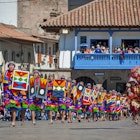
May 22, 2019 • 3 min read
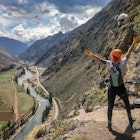
Feb 18, 2019 • 4 min read
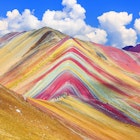
Nov 20, 2018 • 1 min read
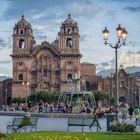
Mar 1, 2018 • 6 min read
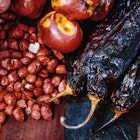
Nov 8, 2017 • 7 min read
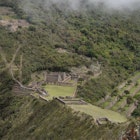
Oct 12, 2016 • 5 min read
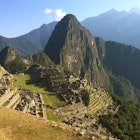
Oct 11, 2016 • 4 min read
in partnership with getyourguide
Book popular activities in Cuzco
Purchase our award-winning guidebooks.
Get to the heart of Cuzco with one of our in-depth, award-winning guidebooks, covering maps, itineraries, and expert guidance.

14 Amazing Things to Do in Cusco, Peru (2024 Guide)
- Last Updated: February 5, 2024
If you don’t know where to begin your Peruvian adventure, check out our list of the 14 most incredible things to do in Cusco, Peru!
Cusco is by far Peru’s most popular city among tourists. And for good reason, as there are plenty of epic things to do in Cusco.
Although it has long been a centre for Inca and other Andean natives, the discovery of Machu Picchu in the early 1900s put Cusco on the map.
It is now the main hub and gateway for visiting Machu Picchu and other Inca ruins scattered throughout the Sacred Valley.
The city itself is situated high in the Peruvian Andes. It lies in the Huatanay River valley and, despite its elevation of nearly 3,400 meters, has a moderate climate most days of the year.
Whether arriving by plane, train, bus or automobile, expect to feel overwhelmed by the beauty of the surrounding mountains.
The city of Cusco is home to a variety of cultural and archeological artefacts due to its rich history.
At one point it used to be the capital of the Inca Empire. In fact, the Incas built the city in the shape of a Jaguar, honouring one of their gods.
However, as the Spanish conquistadors explored and conquered the South American continent they built their own city in its place.
The Spanish replaced Inca temples and buildings with their own cathedrals and government buildings, many of which are still intact today.
In some cases, the Spanish buildings were literally stacked on top of the foundations of the Inca buildings.
Several earthquakes in the mid-1900s exposed this overlap and led Cusco to be designated as a UNESCO World Heritage Site in 1983.
As you wander the historic neighbourhoods, like Barrio de San Blas and Hatun Rumiyuk, you may also find some people in the city still speak Quechua, the main language of the Inca Empire.
Some locals will still walk through the cobblestone streets wearing traditional garments and offer photo opportunities in exchange for a Peruvian Sol or two.
There are also plenty of things to do around Cusco. Ancient ruins surround the city and make for excellent day trips.
Regardless of why you choose to visit the ancient city, there are plenty of things to see in Cusco!
READ MORE: Travelling elsewhere in Peru? Check out our ultimate guide to the best things to do in Lima !
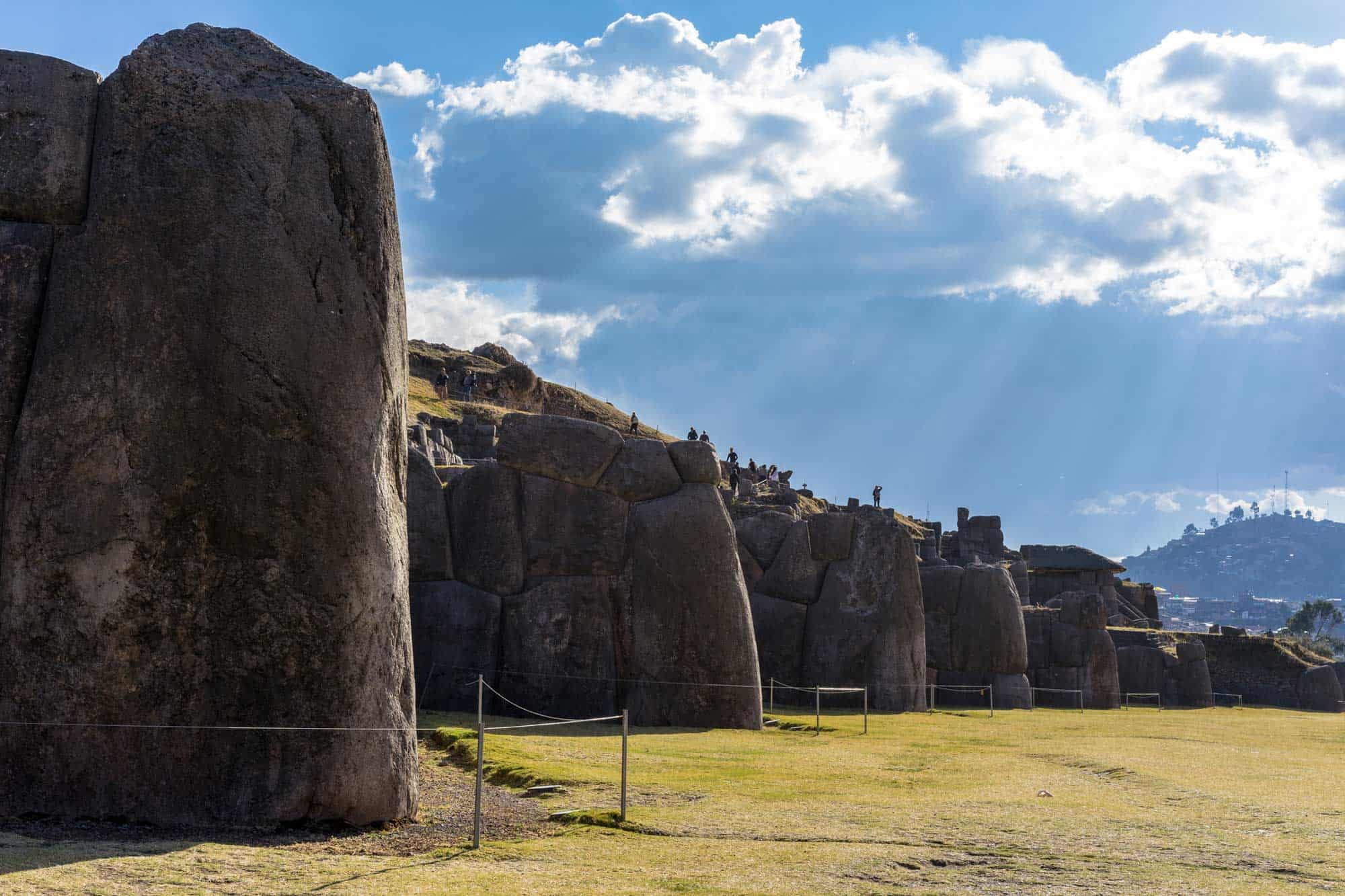
Table of Contents
1) Purchase the “Tourist Ticket To Cusco”
2) visit the ancient city of machu picchu, 3) orient yourself with the city from the plaza de armas, 4) visit iglesia de santo domingo and koricancha, 5) day trip to the maras salt mines and moray ruins by atv, 6) stargaze at the cusco planetarium, 7) take a stroll through the popular san blas neighbourhood, 8) sacred valley pisac, ollantaytambo and chinchero tour, 9) hike to sacsayhuaman fortress, 10) hike to the colourful “rainbow mountain”, 11) get your groove on at mama africa, 12) shop at the mercado central de san pedro, 13) hike to the cristo blanco statue above cusco, 14) day trip to as many other inca ruins as possible, the best hostel in cusco – saqray hostel, the best budget accommodation for couples – hotel sonnenthal cusco, best mid-range hotel in cusco – torre dorada residencial, best luxury hotel in cusco – antigua casona san blas, our list of the best things to do in cusco, peru.
If you’ve ever wondered what to do in Cusco, Machu Picchu was likely at the top of your list. And no trip to Cusco is complete without visiting the ancient ruins of Machu Picchu!
But there is a lot more to explore in and around Cusco than just Machu Picchu.
With mountains in every direction, there is no shortage of adventure activities in the area.
You can take ATV trips or go zip-lining, white water rafting or riding horses. For those wanting a more authentic Inca experience, you can hike several days of the famous Inca Trail.
If you’re interested in more cultural activities, you’ll find an abundance of delicious local foods to try. Give guinea pig or alpaca a try. Or just book a tour to learn how to make your own chocolate directly from the cocoa bean.
If you’re busy keeping up with all of the sights, just have a few pisco sours for happy hour and head out into town for some street food.
One thing is certain: You will not quickly run out of incredible things to do in Cusco, Peru!
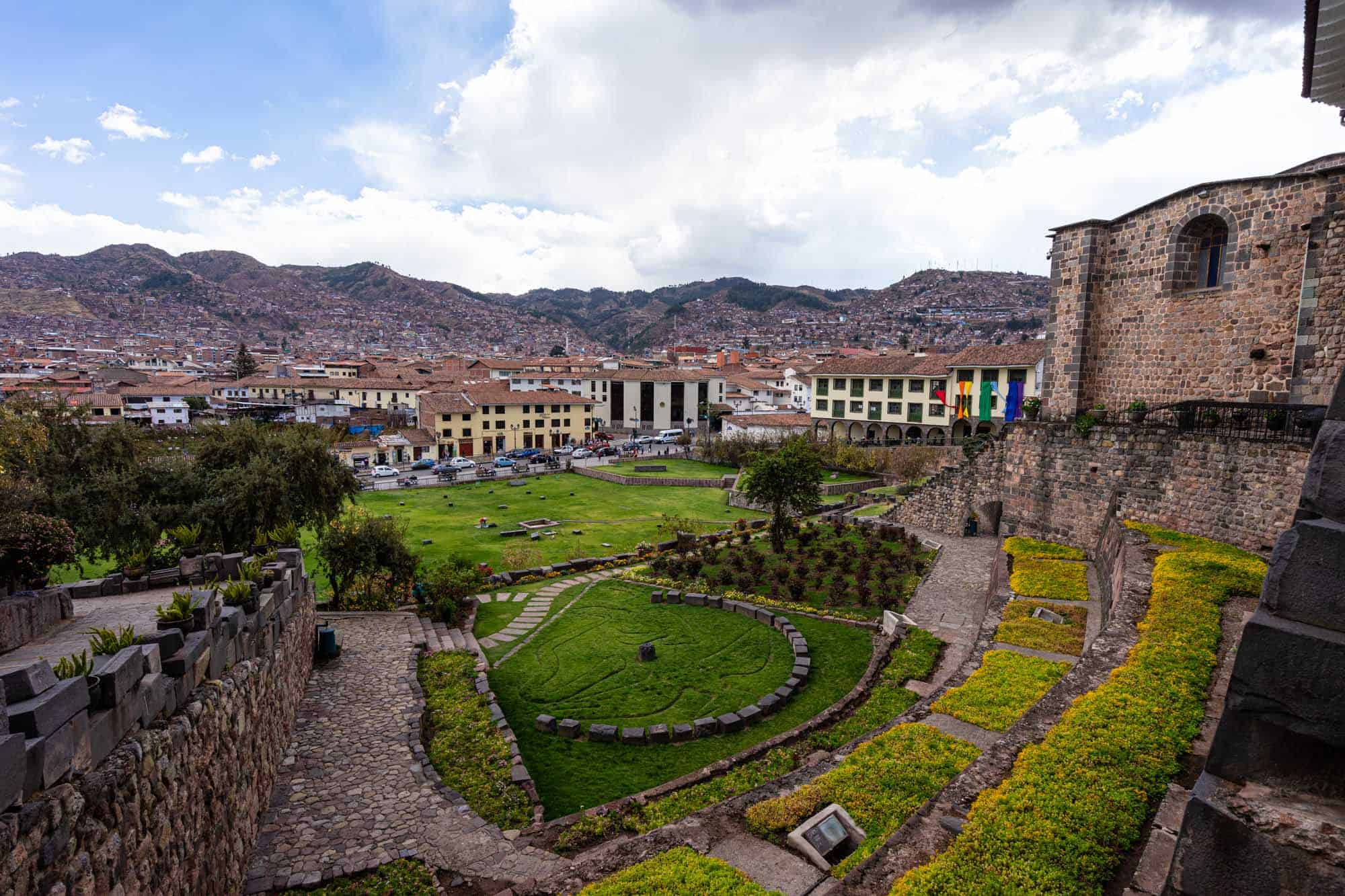
Yes, it may seem strange that our top recommendation is to purchase a tourist pass. However, most of the best things to do in Cusco are free once you have the tourist ticket.
We’ll list many of these places below. But know that the Boleto Turistico de Cusco (“Tourist Ticket to Cusco”) will give you free access to up to 16 sites in and around Cusco and the Sacred Valley (excluding Machu Picchu).
10-day passes are around USD$50 and include all 16 historical sites. However you can also purchase a 1-2 day limited ticket to select sites for around $25 per day.
If you have a few days in the area we advise you purchase the full ticket as many of the things we recommend would be free with the full ticket.
We’ll indicate in our list which places are included in the Tourist Ticket to Cusco.
You can purchase the Tourist Ticket to Cusco at one of the following locations:
The Central Counter Tourist Office
- Address: 103 Avenida del Sol
- Opening hours: Monday – Sunday 8 AM – 6 PM
Tourist Information Office
- Address: Mantas 109 (1 block from Plaza de Armas)
- Opening hours: Monday – Saturday 8 AM – 12 PM, 2 PM – 6 PM
Machu Picchu is the gold standard for Inca ruins. And if you’ve come as far as Cusco, you absolutely must plan to visit the world-famous Inca city.
Originally built in the 1400s, the ancient city was abandoned around the time the Spanish began to explore South America. As the Spanish conquered the region in the 1500s, Machu Picchu was overlooked and unknown.
It was not until 1911 when Machu Picchu was re-discovered by American historian Hiram Bingham.
Machu Picchu has grown in popularity since then. As a result, the Peruvian government has put very strict rules on visiting the site.
The best way to ensure that you follow these rules is to book an all-inclusive trip from either Cusco or Aguas Calientes.
However, it is possible for you to put together a trip to Machu Picchu without booking a complete tour.
Most people who choose to do this will take a train to Aguas Calientes, a small town at the foot of Machu Picchu. From there you can take a shuttle or hike the short remaining distance to Machu Picchu.
But if you do want to explore the ruins on your own make sure you know the basics.
- In addition to an entrance fee of around USD$60 you will also have to pick either a morning or afternoon time slot.
- You will also have to hire a guide (available on site) and may be herded along specific routes and time limits.
Because of the increasing popularity of visiting Machu Picchu, there are also other passes that you can purchase to visit other portions of the area.
Popular side trips include hikes up the local mountains of Huayna Picchu and Montana for even more spectacular views of the ancient city.
Machu Picchu is by far the most popular destination in South America. You will not be alone in your journey there.
But don’t let this discourage you! Machu Picchu is definitely at THE TOP of the list of things to do around Cusco.
READ MORE: Check out our blog post detailing our 5 days spent exploring Machu Picchu and the Sacred Valley .
Like many South American cities heavily influenced by Spanish colonial rule, Cusco boasts a beautiful central park known as the Plaza de Armas .
As with much of Cusco, the Spanish built the Plaza de Armas on the foundation of a previous Inca meeting ground known as The Great Inca Square.
The square is lined with cobblestone and features a water fountain, patches of lush grass and plenty of park benches ideal for taking in the scenery.
If you enjoy taking it easy, you can pick up a coffee nearby and find a bench to sit and enjoy people watching. Or grab a bite to eat at one of the many nearby cafes or restaurants and look in at the busyness of the park.
The Plaza de Armas also boasts excellent views of other historical buildings such as the Cusco Cathedral and the Museum of Natural History.
This is a great place to orient yourself. The popular neighbourhood of San Blas connects directly to the park.
And there are plenty of shops, street performers and other entertainment in and around the Plaza de Armas.
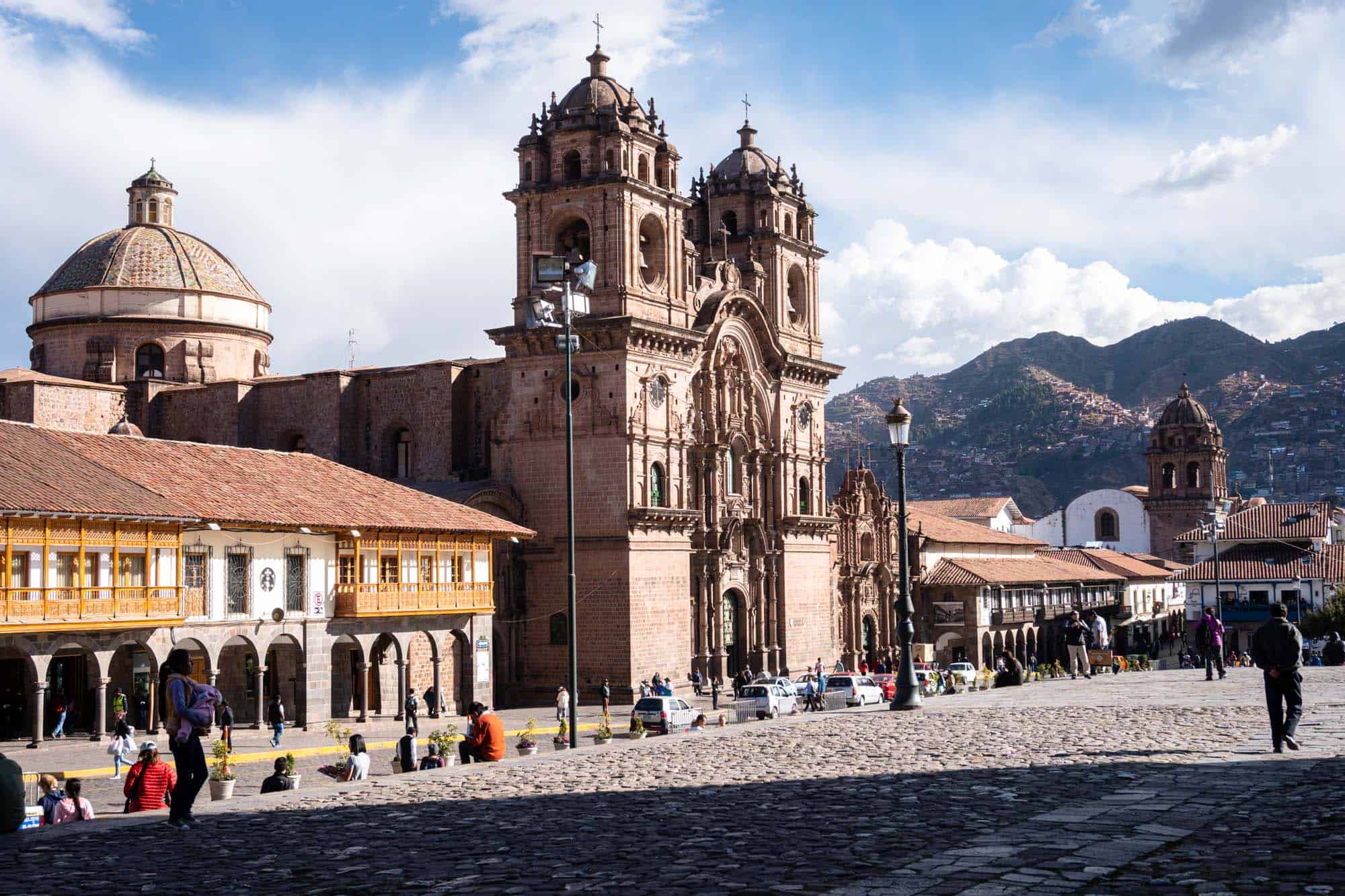
The Church and Convent of Santo Domingo is one of the best examples of the overlap between Inca and Spanish architecture.
Situated in the centre of Cusco, at the side of the Plaza de Armas, the church is built upon the ruins of an important Inca building.
Koricancha was once the Inca Temple of the Sun. However, when the Spanish conquered the Inca they destroyed the temple.
In its place, and literally built upon its foundation, lies the Iglesia De Santo Domingo.
As you tour the church there are places where you can see the stones from Koricancha.
In fact, as you enter the church you can pay for a separate tour of the Koricancha ruins in the centre of the church.
If you miss business hours for visiting the church, this is also one of the more beautiful things to see in Cusco at night.
Like many historical churches in Latin America, the Iglesia De Santo Domingo continues to be open and has daily and weekend masses. So please be mindful of services when you visit.
*Note: Entrance fees to Koricancha is included in the Tourist Pass to Cusco.
- Address: Ahuacpinta 659-A, Cusco, Peru
- Opening hours : Monday – Saturday 7 AM – 7 PM, Sunday 7 AM – 11 AM, 6 PM – 8 PM
- Price: Free of charge (USD$3.50 for Koricancha)
The salt mining town of Moras is approximately an hour outside of Cusco and provides an excellent day trip opportunity.
Situated in the Sacred Valley, the salt mines of Maras are operated today the same as they were over 500 years ago.
Thousands of shallow pools are dug into the mountainside. As saltwater fills the pans, eventually the water evaporates and leaves salt behind.
Locals then collect the salt and sell it in the markets and nearby shops.
While in the area, be sure to visit the Inca ruins at Moray. This unique ruin features sunken terraces throughout the countryside.
You can combine both activities with an adrenaline-pumping tour that takes you to each place on an ATV!
Explore the vast beauty of the famous Sacred Valley in a way many people will never know!
*Note: Entrance fee to Moray is included in the Tourist Pass to Cusco.
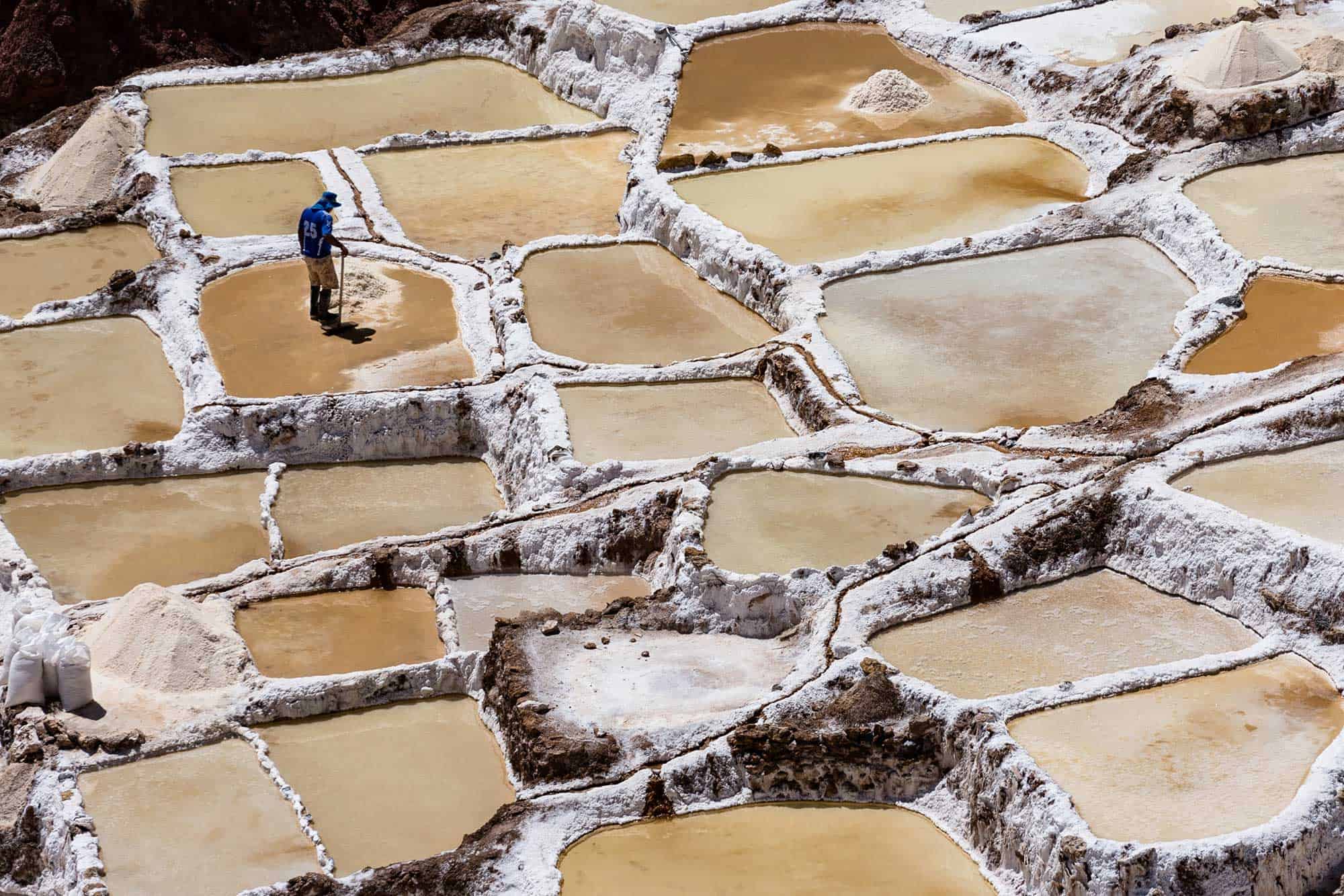
Cusco sightseeing is at its finest with a trip to the Cusco Planetarium.
South America boasts some of the best stargazing in the world. When you’re in Cusco, set an evening aside so that you can visit the Cusco Planetarium.
Situated on a hill just 15 minutes outside the city, the Cusco Planetarium provides a nightly show in English or Spanish.
Weather permitting, you will have an opportunity to view currently available constellations as well as the Inca constellations and hear the stories about them.
The planetarium is family owned and operated and you can either reserve your spot directly through the planetarium or through any number of tour operators.
Either way, travel to the planetarium is typically provided with purchase. But you can easily and cheaply have a taxi take you up the hill.
Reserve an evening for the planetarium, one of the breathtaking Cusco attractions.
- Address: Calle Lucrepata E-16, Cusco
- Phone: 084 231710
- Website: https://www.planetariumcusco.com/es/
San Blas is perhaps the most iconic neighbourhood and one of the top places to visit in Cusco.
Located adjacent to the main square in the city, the steep and narrow cobblestone streets are lined with shops and restaurants of all sorts.
Also known as the “balcony of Cusco,” the neighbourhood sits at the top of a hill and overlooks the main square and all adjacent buildings.
Because of the views, you can visit San Blas during the day or at night and find it equally beautiful and enchanting. The views are a Cusco must see!
Regardless of when you visit, expect to come across street performers of various kinds and pick your favourite spot to drink a pisco sour and people watch!
We recommend you give the Limbus Resto bar a try. Known for its location overlooking the town you can sit and plan out the rest of your day or evening with some of the best views of Cusco.
READ MORE: Don’t miss our complete guide to backpacking in Peru .
Ollantaytambo is the site of another of Peru’s most famous Inca ruins and another of the more popular things to do around Cusco.
Located approximately 2 hours north of Cusco in the Sacred Valley, Ollantaytambo was once an Inca stronghold and military base protecting Machu Picchu.
Today the ruins consist of a massive fortress and temple built among a series of large terraces.
Many people visit the Ollantaytambo ruins on a day trip from Cusco.
However, the town and ruins are also the most popular starting point for those people hiking the Inca Trail to Machu Picchu.
If you are not interested in booking a tour from Cusco, you can also catch the train to/from Aguas Calientes on your way to/from Machu Picchu.
Many tours will also stop at Chinchero, a typical Andean Indian village that will give you a taste and feel of the native way of life.
*Note: Entrance fees to both Ollantaytambo and Chinchero are included in the Tourist Pass to Cusco.
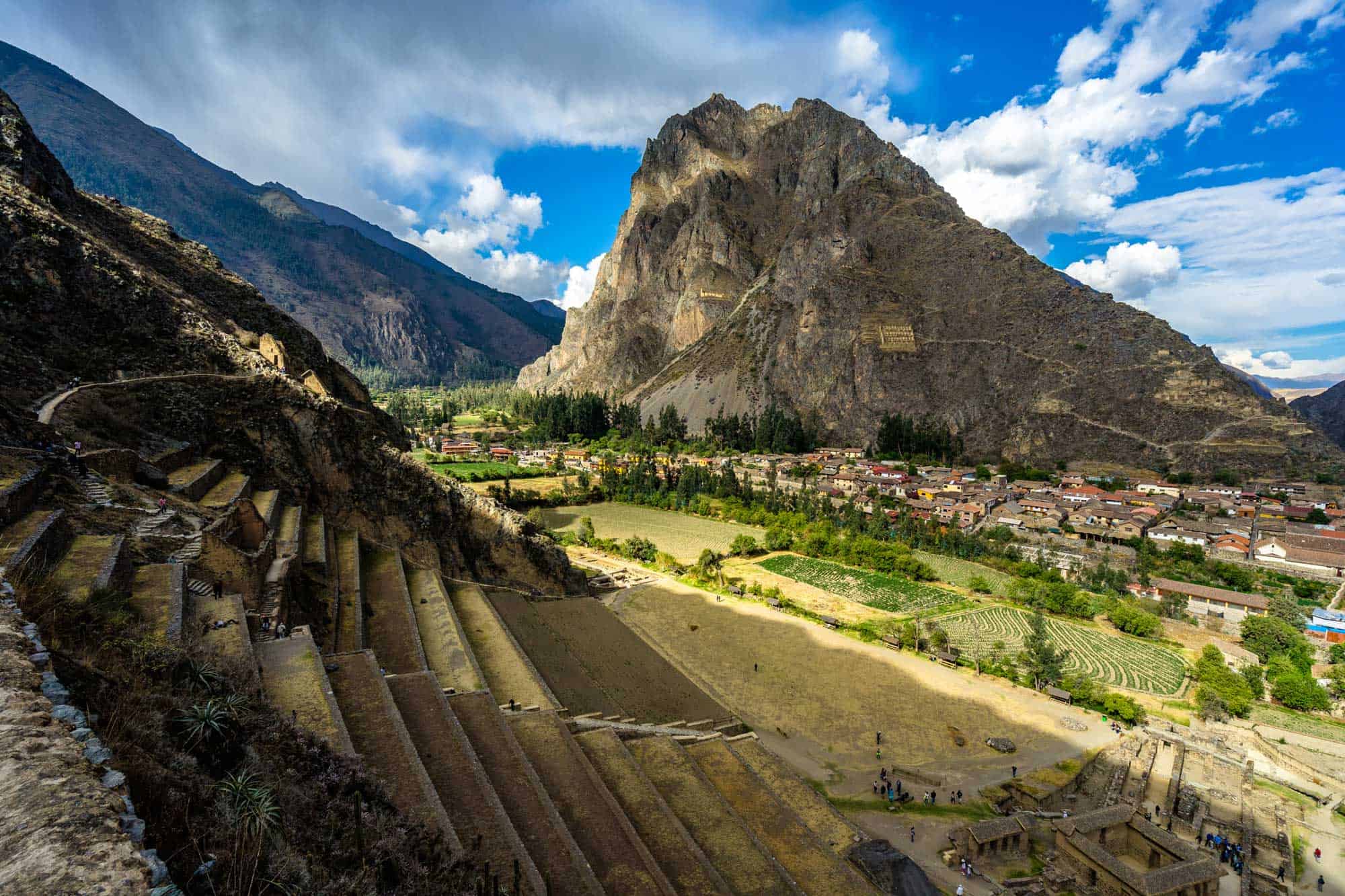
Sacsayhuaman is an ancient Inca fortress overlooking Cusco from the north. As it is just on the outskirts of town it is easily accessible.
Many people will visit Sacsayhuaman as part of a Cusco city tour. But it is only 2.2 km from the Plaza de Armas and makes for a great self-guided hike/walk.
Locals and tour guides will jokingly refer to the ruins as “Sexy Human” or “Sexy Woman.” The fortress and ruins are still very much intact, though less than half of its original structure remains.
You will see large stones stacked on each other to create the remnants of towers, shrines, roads and homes. It would be easy to spend an entire day exploring the ruins, so give yourself a few hours at the least.
Once you’ve crossed out everything from your list of what to see in Cusco, head to Sacsayhuaman for a fun and informative day trip.
Note: Sacsayhuaman is located at an even higher elevation than Cusco city. The hike to the ruins is uphill so consider your fitness when hiking to Sacsayhuaman. A better idea might be to take a taxi to the top of the hill and then hike back down to the city when you are done exploring the ruins.
- Opening hours: 7 AM – 5:30 PM
- Price: Only available with “Tourist Pass to Cusco”
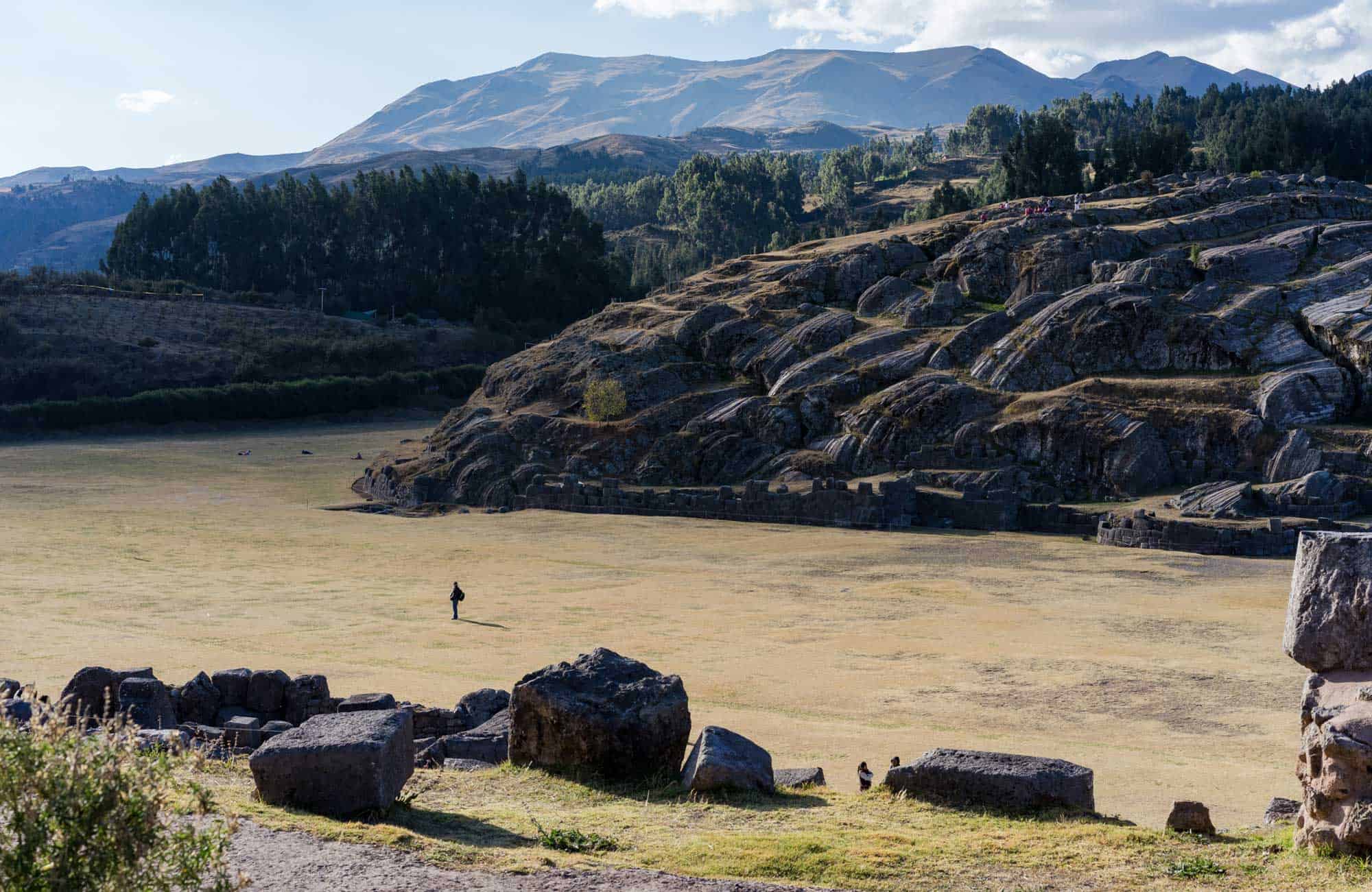
Rainbow Mountain, also known as Montana de Siete Colores (Mountain of 7 Colours), is a spectacular day trip opportunity.
The mountain itself looks as though someone scattered coloured sand in layers across the landscape.
It is truly a unique spectacle formed as ice melted and mixed with various minerals to stain the ground bright reds, greens, yellows and purples.
It is best to book a tour as getting to the mountain involves a 3 hour drive from Cusco.
Once you arrive at the base of the mountain you will hike for approximately 10 kilometres to the lookout.
Have a read of our tips for visiting Rainbow Mountain .
This hike in itself is worth the trip as you will come across wild alpacas. llamas and vicunas as you enjoy a panorama view of the surrounding mountains.
You may also come across large condors in flight – a spiritual symbol of good fortune to many of the Andean people in the region.
Note that the duration and terrain of the trail make it a moderate to difficult hike. This one is not for beginners.
If you are looking for entertaining nightlife and/or simply want to learn to Salsa dance, visiting Mama Africa is one of the best things to do in Cusco.
Located adjacent to the Plaza de Armas, Mama Africa is a great place to end your day… or begin your night.
It is popular among locals and tourists alike, so expect a decent crowd most nights of the week.
However, if you have ever wanted to learn to Salsa dance in a Latin American destination, it does not get more authentic than at Mama Africa.
Grab a beer to shake loose the nerves. Then shake it on the dance floor!
- Address: Portal de Panes 109 3th Floor, Portal de Panes 109, Cusco 08002, Peru
- Opening hours: Opens at 7 PM and closes sometime before the sun rises!
Mercado Central de San Pedro is the busiest market in Cusco and one of the best things to do in Cusco.
Located just 5 blocks from the Plaza de Armas, the Central Market boasts a wide variety of items to purchase.
Locals purchase most of their meat and produce from the market.
Additionally there are many shops that cater to both the functional needs of the traveler as well as to provide ample opportunity to purchase souvenirs.
Grab a bite to eat from a food stall. Or stock up on snacks for your day trips in and around Cusco.
You’ll be glad you experiences a true local market while visiting Cusco.
- Address: Tupac Amaru, Cusco 08003, Peru
- Opening hours: every day from 9 AM – 6 PM
Cristo Blanco (“White Christ”) is a statue of Jesus situated on a hill high above the town of Cusco.
Like many Latin American towns with deep Spanish roots, Cusco boasts a large statue of Jesus that towers above the city providing a metaphorical reminder to residents of their Catholic heritage.
If you are not interested in seeing the statue in person and just want to see a gorgeous view of Cusco, the hike to/from Cristo Blanco is hard to beat.
The hike to the statue is approximately 1.5 KM from the Plaza de Armas. If you’re interested in saving some energy, catch a taxi to the statue and hike back to the city.
And if you really want a spectacular view, take a taxi to the Cristo Blanco statue in the evening after the lights of the city turn on.
However, if you go at night make sure you are with other people and keep vigilant of your surroundings at the top of the hill.
If you purchased your Tourist Ticket Of Cusco and you have the extra time, plan to visit as many of the other places as you can!
We’ve highlighted only a few of the top things to do around Cusco. But your Tourist Ticket will also get you into the following places for FREE!
- Q’enqo – A 40 minute walk from Plaza de Armas in Cusco, Q’enqo is another Inca holy place built among the natural rock formations surrounding the city.
- Puca Pucara – An Inca military outpost located around 8.5 km from the centre of Cusco with notable walls, terrace and standing staircase.
- Tambomachay – Located near Puca Pucara, Tambomachay is a series of tunnels, waterfalls and aqueducts used to transport water in the Inca civilization
- Contemporary Art Museum – Located on the northwest corner of the Plaza de Armas, this museum features modern art in and from the region.
- Regional History Museum – Another short walk from the Plaza de Armas, the museum shares information on the social, geological, architectural, political and historical importance of the area.
- Museum of Popular Art – One block south of the Plaza de Armas, another quick museum visit featuring local art.
- Qosqo Native Art Center – Features performances of folk dance and musicals from various peoples in Cusco among other information about the people and culture of Cusco.
- Monument to the Inca Pachacuteq – Located on Avenida del Sol, this statue stands out in the city and features a museum built into a several-story tower.
- Pikillaqta – A Wari ruin from people settled in the region prior to the Incas, located around 20 km east of Cusco.
- Tipon – An terraced Inca ruin complex located near Pikillaqta likely used for agriculture
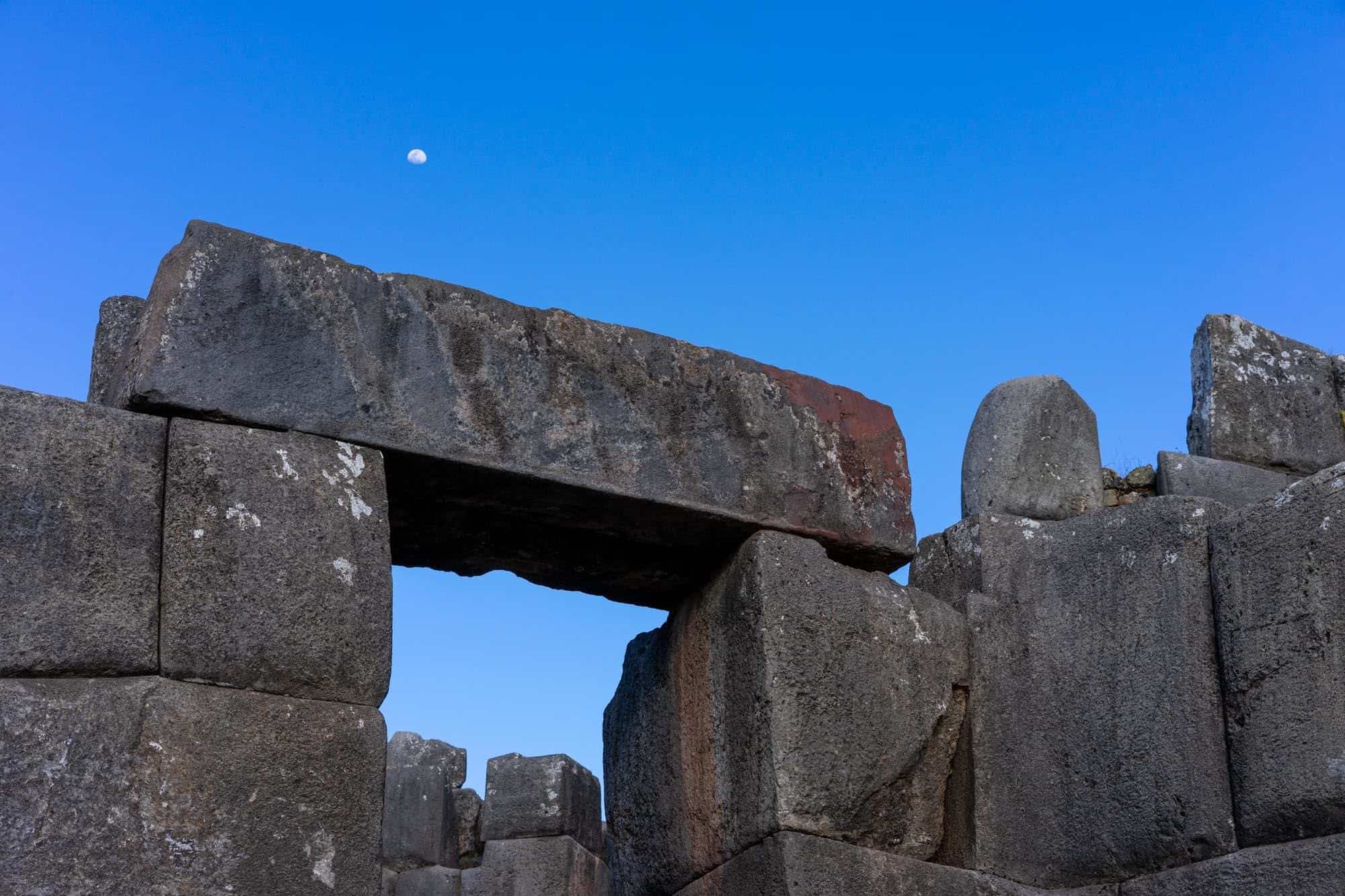
Our Cusco Travel Guide
To help you make the most of your trip exploring the best things to do in Cusco, Peru, we’ve put together this handy Cusco travel guide for you!
Best Accommodation – Where to Stay in Cusco
If you were wondering where to stay in Cusco, you have many options. From budget hostels to luxury hotels, Cusco has it all.
Whether you are looking for a quiet hotel tucked away in a corner of the city, or want to be closer to the hustle and bustle, you have many options.
Hostels in Cusco offer a great place to meet other travellers who are planning trips to Machu Picchu and the surrounding areas.
Or, if you prefer more privacy, you can find great budget accommodations for your family or significant other.
Although Cusco is a busy city, there are almost always places available that will suit your wants and needs. So don’t worry about where to stay in Cusco.
Instead, worry more about how much time you will end up spending there!
Saqray Hostel is your best bet for staying in Cusco. Located just a few blocks from the Plaza de Armas, Saqray Hostel is about as close to the action in Cusco as it gets.
With options that range from 6-bed mixed dorms to private double bed rooms you can rest in whatever comfort suits your budget.
Rooms are reasonably priced, starting at USD$12.50 for dormitories and $33.50 for private accomodations.
With a shared lounge, Saqray Hostel is a great place to meet other travellers. All rooms include free WiFi and an outdoor patio.
You can also expect to have hot water all day, lockers for your valuables and cable TV. A complimentary continental breakfast is included in your stay.
Located in the heart of Cusco, Hotel Sonnenthal Cusco is your best option for an affordable night’s stay.
Within walking distance to public transportation within and outside of the city, you’ll find everything you want in Cusco is a short distance away.
Rated as one of the top budget hotels, Hotel Sonnenthal Cusco offers a variety of rooms at incredibly reasonable prices.
Choose rooms with 1 king, 2 single beds or a suite that has both a king and single bed – all of which have a balcony/terrace.
Breakfast for 2 and WiFi is included with your stay. There is also a common cooking area for you to prepare your own meals if you choose.
All rooms come with a private bathroom with complimentary toiletries and on-demand hot water 24 hours a day.
The value does not get much better than Hotel Sonnenthal Cusco!
If you’re looking for a great deal on a moderately priced hotel with great location and amenities, Torre Dorada Residencial is your best bet.
The hotel is located in Cusco city centre, within walking distance to great restaurants, shops and public transportation. However, it is tucked away in a quieter part of the neighbourhood.
You can reserve several types of rooms with single, double or suite-style setups that include up to 3 different beds. This hotel is great for families or for those wishing to have a little more comfort in their stay in Cusco.
All reservations include free Wifi and complimentary breakfast for 2-3.
Additionally, the hotel provides medical care and has oxygen to accommodate guests having difficulty with Cusco’s elevation.
Hotel staff will help arrange tours and transportation throughout the city and to Machu Picchu.
The Antigua Casona San Blas in an exceptional choice in accommodations in the historic San Blas neighbourhood of Cusco.
When it comes to luxury, the value of Antigua Casona stands out among other high end chain hotels.
Rooms come as double or triple beds and include WiFi, flat screen TVs and complimentary breakfast. There is a common patio with a fire pit and an in-house bar, creating one of the most relaxing experiences you can have in Cusco.
One of the greatest things about Antigua Casana is the staff. Expect superior service and assistance in planning any trips or transportation in or around Cusco.
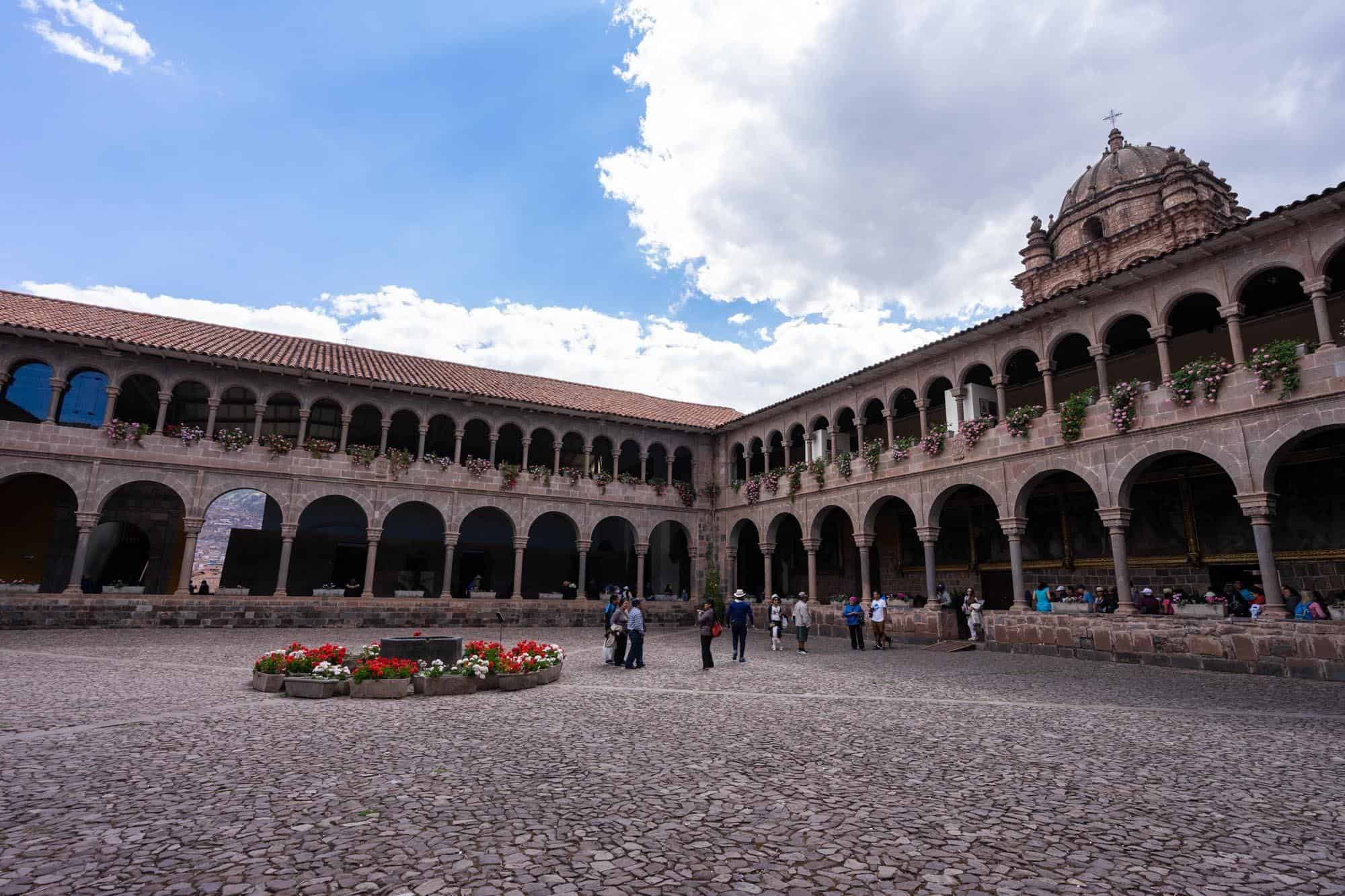
Best Restaurants in Cusco
Peruvian food is at its best in Cusco. Here are a few of our favourite restaurants in the city.
Rucula serves Peruvian and latin fusion plates sourced locally. With plates ranging from USD$2-6, vegetarian and vegan options, alcoholic beverages and complimentary WiFi you can’t beat the value.
The view from near the Plaza de Armas is nearly as great as the delicious options served up by the Limbus Resto Bar . Stop by in the afternoon or evening and enjoy a pisco sour and Peruvian cuisine as you watch the city come alive below.
Inti Raymi Restaurant offers the finest Peruvian dishes in the city with top notch service in a luxurious ambience. If you want a true taste of Cusco – from potato leek soup, traditional chicken stew and even trout ceviche and seared lamb – there is no finer dining experience than Inti Raymi.
DISCLAIMER: Some of the links in this article are affiliate links, which means if you book accommodation, tours or buy a product, we will receive a small commission at no extra cost to you. These commissions help us keep creating more free travel content to help people plan their holidays and adventures. We only recommend the best accommodations, tours and products that ourselves or our fantastic editorial team have personally experienced, and regularly review these. Thanks for your support, kind friend!
Chris Harvey
Hi, We’re Alesha and Jarryd!

We’ve been traveling the world together since 2008, searching for the planet’s best destinations and adventures.
Love Travel?
Sign up for our free weekly newsletter for the best travel tips, ideas and deals!
We respect your privacy. Unsubscribe at any time.
READ MORE...
Backpacking in Peru – The Ultimate Travel Guide
25 awesome things to do in lima, peru (2024 guide), 5 days in cusco, the sacred valley and machu picchu, related posts, 10 amazing adventure activities in peru, 2 thoughts on “14 amazing things to do in cusco, peru (2024 guide)”.
Hello, I noticed that Sacsayhuaman required you to have the tourist pass to visit it, what other sites require you to have the tourist pass to visit it? I am here for a month so I’d rather take my time with those that I do not need the tourist pass for and can instead pay for individually.
Hi Terra, this all depends how many days your pass is for. Here is a website explaining the different day passes and what they offer. Hope this helps. We are not too sure if you can do it individually. https://www.theonlyperuguide.com/peru-guide/cusco/tourist-ticket/
Leave a comment Cancel reply
Save my name, email, and website in this browser for the next time I comment.

- +51 957 326 998
- +51 965 730 786
Peru Destinations
Top Best Places and Tourist Attractions to Visit in Peru and Cusco
- Machu Picchu Tours
- Sacred Valley
- Lares Treks
- Huchuy Qosqo
- Rainbow Mountain
- Inca Trails Treks
- Choquequirao
- Inca Quarry
Live an unique vacation in Peru with our personalized itineraries designed exclusively through authentic tours, in harmony with the natural world. Travel to Peru and fuel your imagination on a diet of ancient treasures and wonderful landscapes. Surrounded by majestic Andean peaks, world wonder Machu Picchu and the historic city of Cusco highlight Peru’s dramatic birth from the encounter between Incas and Spaniards. Peru is one of the most diverse travel destinations on the entire planet. Full of wilderness, adventure, history, world-renowned cuisine and a colorful culture, this is a country that offers several exciting options for, literally, any type of traveler.
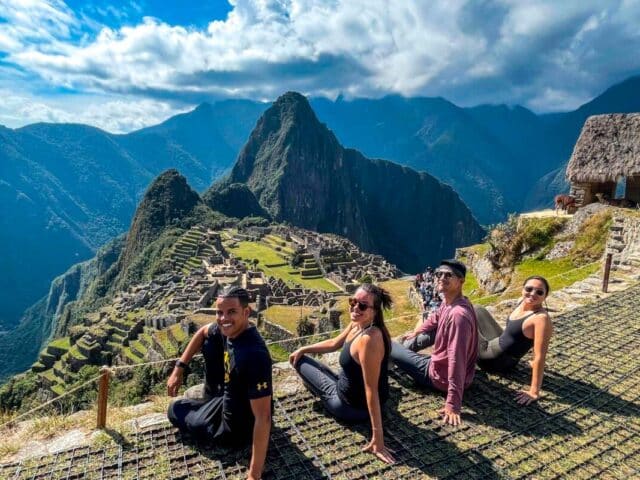
Custom Tours, Trips & Travel Packages in Peru
The best travel packages and tours to peru.
- Machu Picchu Tour with Rainbow Mountain Trek 5 Days
- Sacred Valley with Short Inca Trail & Rainbow Mountain Tour – 4 Days
Explore our selection of Peru tours and packages and get inspire with our journeys and find your perfect itinerary. Come to Peru to discover its mystical land with ancient citadels, magnificent natural beauty, traces of ancient civilizations, rich history, and vibrant culture, of course, Peru is a memorable destination. No matter your inclination or age, Peru Spirit Adventure has an exhilarating adventure ready to take you deep into the heart of Peru. From coastal metropolises, the lively Lima city, with its museums, galleries, and buzzing cuisine scene to the Peruvian Andes to explore Cusco, the historic capital of the Inca Empire, Sacred Valley with its bustling markets overflowing with vivid textiles and handicrafts, and end up with the most revered ruins in the world like Machu Picchu or keep exploring the dramatic snow-capped peaks, the vivid colors of Rainbow Mountain in the Andes Mountains with our carefully crafted custom tour packages in Southern of Peru
Best Tours & Trips to Machu Picchu
Embark an exceptional private tours of machu picchu in peru with an expert tour guide.
- Tour to Machu Picchu with Vistadome Train 1 Day
- Machu Picchu Tour by Train – 2 Days / 1 Night
- Sacred Valley & Machu Picchu Tour 2D/1N
- Cusco City Tour, Sacred Valley & Machu Picchu Tour 3D/2N
- Sacred Valley 2 Day & Machu Picchu – 3 Days / 2 Nights
- 4D/3N Cusco City, Sacred Valley 2 Day & Machu Picchu Tour
- Sacred Valley & Inca Trail to Machu Picchu 3D/2N
- 2-Day Moray, Maras Salt Mines & Machu Picchu Tour
The spectacular Inca citadel of Machu Picchu – Is the world’s greatest travel destination, a New Wonder of the World, South America’s top attraction, or purely a postcard-worthy ancient site that must be seen to be believed. Whether you travel to Machu Picchu by scenic train, hike the world-famous Inca Trail or venture off the beaten path, you’ll be able to enjoy a unique experience and discover the Lost City’s secrets. Once you step foot into this UNESCO World Heritage site, you’ll discover its refined architecture, spiritual meaning and astronomical importance. Machu Picchu – a bucket list experience!!
Best Inca Trail Tours to Machu Picchu Peru
Hike the famous inca trail to machu picchu, the best trekking route in all of south america.
- Inca Trail 4 Days Trek to Machu Picchu
- Inca Trail 5 Days Tour to Machu Picchu
- Inca Trail Short 2 Days Trek to Machu Picchu
- Salkantay Trek + Classic Inca Trail 6D/5N
- 1 Day Short Inca Trail to Machu Picchu
- 2 Days Inca Trail to Machu Picchu
The Inca Trail – Is one of the most iconic and famous trails in South America – perhaps the world – and a must-do, life-changing experience. This 26-mile (42km) trail to the 15th-century Inca citadel of Machu Picchu goes across the Andes mountains reaching 13,829 ft (4,215m) and it’s hiked in 4 days and 5 days. Along the route you’ll get to see some fascinating archaeological sites that can only be accessed by foot and witness a mix of ecosystems with abundance in fauna and flora where you’ll have high chances to spot gorgeous orchids, tall mountains ranging from the snow-capped Andes to the luscious cloud forest and in the middle of this region is where you’ll camp every night and live an unforgettable experience and this original Inca steps ends at the Sun Gate (Inti Punku), the entrance to Machu Picchu city.
The Greatest Hikes in Peru
Alternative Treks To Machu Picchu & Off The Beaten Path Adventure Travel in Peru
SALKANTAY TREKS
- Salkantay Trek to Machu Picchu 5 Days
- Salkantay Trek to Machu Picchu 4 Days
- Salkantay Challenge Trek 3 Days
- Salkantay Trek + Classic Inca Trail 6 Days
- Salkantay Trail to Machu Picchu & Zipline 5 Days
AUSANGATE TREKS
- Ausangate Trek to Rainbow Mountains – 4 Days
- Ausangate 5 Day Trek + Rainbow Mountains Cusco
- Ausangate & Sibinacocha Lake 7D/6N
LARES TREKS
- Lares Trek to Machu Picchu 3D/2N
- Lares Trek & Short Inca Trail 5D/4N
- Lares Trek 4 Days to Machu Picchu
HUCHUY QOSQO TREKS
- Huchuy Qosqo 1 Day Hike
- Huchuy Qosqo Trek 2 Days (With Machu Picchu)
- Huchuy Qosqo Trek to Machu Picchu 3D/2N
CHOQUEQUIRAO TREKS
- Choquequirao Trek 4D/3N
- Choquequirao Trek 5D/4N
ANCASCOCHA TREKS
- Ancascocha Challenge Trek 4D/3N
- Ancascocha Trek 5D/4N
INCA QUARRY TREKS
- Inca Quarry Trek 4D/3N
- Inca Quarry Trek + Short Inca Trail 5D/4N
INCA JUNGLE TOURS
- Inca Jungle 4 Days
- Inca Jungle 3 Days
DAY TRIPS IN CUSCO
Enjoy the best of the city of Cusco & surrond
- City Tour Cusco Half Day Tour – Morning or Afternoon
- Cusco City Highlights & Surroundings Tour – 1 Day
- Maras Moray & Salt Mines Tour – Half Day
- 1-Day South Valley Tour of Cusco
- Walking Tour Cusco Half Day Tour
- Cusco Horseback riding – Half day
FULL DAY HIKES
Off The Beaten Path Cusco Day Hikes
- Full-Day Huchuy Qosqo Trek
- Inca Quarry Trail 1-Day Hike
- Chinchero to Urquillos One Day Trek
- Pumamarca Hike to Ollantaytambo – 1 Day
- Qeswachaka Bridge One Day Tour
- Tipon, Pikillacta & Andahuaylillas Tour – 1 Day
BEST SELLER DAY TOURS IN CUSCO
Discover the Best Day Hikes in Peru
- Rainbow Mountain One Day Tour
- Horseback Ride Rainbow Mountain 1-Day Tour
- Palccoyo Rainbow Mountain 1-Day Tour
- Humantay Lake One Day Tour
- 1-Day Inca Trail Trek to Machu Picchu
- Ausangate 7 Lakes 1-Day Hike
Peru's Best Sacred Valley Tours in Private Service
Discover the best of sacred valley with a customized tour on your terms.
- CLASSIC Sacred Valley Tour (Pisac & Ollantaytambo)
- ALTERNATIVE Sacred Valley Tour (Chinchero, Moray, Salt Mines & Ollantaytambo)
- EXTENDED Sacred Valley Tour (Pisac, Salt Mines, Moray & Ollantaytambo)
- SUPER Sacred Valley Tour (Chinchero, Salt Mines, Moray, Ollantaytambo & Pisac)
- FULL-DAY TOUR ( Moray, Salt Ponds of Maras & Pisac)
- SACRED VALLEY TOUR from OLLANTAYTAMBO to CUSCO
Peru’s Sacred Valley – Just one hour away from Cusco, it’s a destination full of adventure, culture, and glimpses into local Andean life; nestled in the verdant foothills of the snow-capped Andes, with a stunning landscape, dotted with little villages and ruins. Explore Pisac and Ollantaytambo to witness and wander around stunning hillside Incan ruins, visit Chinchero to experience a traditional market day in the valley. Do not miss the ancient salt pans, known as the Maras Salt Mines and the Inca experimental terraces of Moray.
Rainbow Mountain Treks & Tours
Hike to the incredible rainbow mountain or vinicunca mountain in peru.
- Rainbow Mountain Trek & Red Valley 2 Days
- Ausangate & Rainbow Mountain Trek 3 Days
- Ausangate Trek to Rainbow Mountains 4 Days
- Machu Picchu Tour & Rainbow Mountain 5 Days
Vinicunca Mountain — also known as the Mountain of Seven Colors, or more simply Rainbow Mountain — was discovered four years ago when the snow covering it melted, revealing the natural beauty of the rock beneath. A visit to Rainbow Mountain is an absolute must for all those who love stunning landscapes and gorgeous scenery. This hike to Rainbow Mountain offer you one of the earth’s most amazing natural wonders in Peru.

TRAVEL GUIDE

The Imperial City of Cusco is known as the “Navel of the World” and the former capital of the Inca Empire. It is an enchanting introduction to the Andean culture and the main gateway to the Sacred Valley and Machu Picchu Citadel. Almost all people who like to travel, have the city of Cusco among the places they have to visit in life.
- Climate & Weather
- How to Get To
What to See
- Things to Do
- Tour Packages
- Visitor Guidelines
- Travel Info
Cusco is an ancient and impressive Inca capital located high in the Andes, in southeastern Peru, and the most incredible of South America and one of the world’s top destinations.
Visiting the ancient capital of the Inca empire must be one of the best cultural experiences you can have in life, the city of Cusco is recognized as the archaeological capital of the Americas, known since the time of the Incas as the “Navel of the World”; and is an integrating city, where experiences, people of all cultures, religions and nationalities come together and exchange experiences; making it one of the most cosmopolitan cities in the world.
The city of Cusco has a unique charm that is hard to put into words, with exquisite churches, fantastic museums and narrow cobblestone streets in the historic center that deserve at least several days of exploration. Add to this the impressive Inca ruins both in the city and in the surrounding hills, and you have the recipe for a magical trip.
The city today is built on ancient Inca temples and monuments, colonial architecture and modern buildings, and the cultural festivals held throughout the year, such as the “Señor de los Temblores” and “Inti Raymi”, highlight the region’s mixed Spanish-Indian heritage and illustrate the community’s continuing renewal of ancient Andean traditions. This fascinating and historically rich city is sure to be one of the most memorable places you will ever set foot in.
Climate & Weather
The weather is an important matter when deciding on a trip. Unlike other countries and regions. In the highlands of Peru, where Cuzco is located, there are two well-defined seasons, the rainy season and the dry season, with gradual changes in weather and temperature in between. The mountainous geography of the Cuzco region has a wide variety of microclimates, with drastic temperature differences between the warm and humid valleys and the frosty high altitude plains. Generally, as elevations climb higher, temperatures drop.
DRY SEASON:
The dry season in the Cusco region is from April until October when it’s winter in South America. June and July are the driest months but also the coldest with temperatures sometimes dropping below zero. During these months in Cusco, it’s typically beautiful and sunny. The average daytime temperature is around 65°F (18°C), but if you’re in direct sunlight it can feel a lot hotter. At night, without cloud cover to create an insulation effect, the temperature dips down to a chilly 25°F (4°C) in the evening, night and early morning.
RAINY SEASON:
The months of the rainy season begin in November and run until March and coincide with summer in South America. Rainstorms are unpredictable, the rains can be fierce when they hit, causing landslides and disrupted transportation schedules. January and February are the wettest months and typically receive the most rainfall. Cloudy skies are typical throughout the rainy season, but patchy sunshine comes through on some days. Average temperatures during the dry season range around 60°F (16°C) in the day and 46°F (8°C) at night.
Best Time to Visit
The best time to visit Cusco, Sacred Valley, Machu Picchu, Rainbow Mountain, Humantay Lake or hike the Inca Trail is before and after the rainy season, that is late March, April, May, and September, October, and early November, the dry season months, that is June July and August, are great too but beware of the crowds.
There are benefits to visiting Cusco during each season, as well as some drawbacks.
- The dry season is the most popular time to visit Cusco. Weather conditions in the Andes are usually sunny with a minimal chance of rain, but attractions tend to be crowded. Peak season in Machu Picchu and Cusco is from June to August when tours and accommodation are usually booked out well in advance.
- An ideal time to visit Cusco and the Sacred Valley is right before peak season in April – May because there are far fewer tourists and crowds, or just after peak season in September or October before the rains begin. Except for Semana Santa (Easter Week), when a lot of Peruvians are also taking a vacation. Weather-related travel delays are more common, especially in January and February, when it rains the most.
How to get There?
Lorem ipsum dolor sit amet, consectetur adipiscing elit. Nullam venenatis velit sed quam facilisis volutpat. Morbi eu turpis arcu. Sed congue hendrerit imperdiet. Phasellus nisi nisl, sollicitudin a euismod et, elementum pharetra erat. Donec consectetur viverra sodales. Proin venenatis fringilla mauris, id suscipit nisl dignissim in. Vivamus cursus lacus eget enim sagittis, quis accumsan felis sollicitudin. Duis egestas tellus ac congue egestas. Sed est diam, placerat sit amet mauris id, hendrerit hendrerit mi. Ut odio purus, faucibus eu interdum ac, varius vel metus. Pellentesque elementum pharetra metus tincidunt rutrum.
Duis ornare ipsum dui, vel egestas mauris elementum nec. Quisque vel interdum mi. Sed id fermentum neque, vel tempor arcu. Vivamus accumsan odio ac felis gravida mollis. Nullam arcu tortor, euismod in enim pulvinar, aliquam finibus ligula. Curabitur id feugiat risus. Pellentesque sit amet nibh nec dui lacinia auctor. Donec aliquet mi ultricies dapibus hendrerit. Nam sollicitudin ultrices vestibulum. Nullam at fermentum risus. Morbi lectus magna, vulputate sit amet sem vitae, aliquam porta tellus. Vestibulum commodo sit amet magna ac tristique. Aliquam suscipit auctor nisi nec porta. Nunc lacinia pharetra ornare. Mauris commodo, mi egestas ultrices sollicitudin, eros turpis posuere libero, vitae condimentum nunc lacus eget neque.
Pellentesque aliquam vulputate orci eu feugiat. Donec ut nibh sit amet justo sagittis pellentesque quis vel urna. Vestibulum consequat velit id purus euismod interdum. Aliquam tristique erat elit, a bibendum enim congue euismod. Donec turpis elit, eleifend et sodales nec, condimentum ut est. Ut sagittis velit libero, ut finibus metus cursus id. Morbi ultricies bibendum ex, nec lobortis tortor convallis at. Nullam dui ante, sollicitudin vel gravida et, sagittis a sem. Cras auctor, mi blandit pretium aliquam, nisi est venenatis ante, nec vehicula nisi elit ac dui.
Ut fringilla, ipsum eu imperdiet dictum, ligula tortor aliquam augue, ac aliquam magna justo a metus. Nullam in imperdiet dolor, finibus vestibulum orci. Donec quis dolor non augue commodo aliquam et vitae metus. Sed elementum diam id pellentesque rutrum. Praesent volutpat lorem mattis tellus ullamcorper pharetra. Nam vehicula a velit quis tempus. Curabitur dignissim lobortis malesuada. Mauris interdum porta faucibus. Curabitur et elementum justo. Duis tempus sollicitudin pellentesque. Suspendisse quis cursus nisl. In in lacus tristique, iaculis ante ut, fringilla erat. Sed id felis odio. Fusce finibus ante sem, eget pharetra quam pellentesque sit amet. Duis faucibus varius est non rutrum.
Ut ac lectus elit. In pulvinar orci vitae mattis vestibulum. Aliquam at leo et erat pretium cursus eu vel libero. Morbi quis rhoncus sem, non efficitur mi. Proin faucibus enim a nisl ullamcorper, sed maximus purus placerat. Maecenas augue felis, interdum quis tortor vitae, sagittis dignissim ante. Fusce urna erat, venenatis ac est nec, rutrum lobortis mauris.
History of Machu Picchu
dignissim ante. Fusce urna erat, venenatis ac est nec, rutrum lobortis mauris.
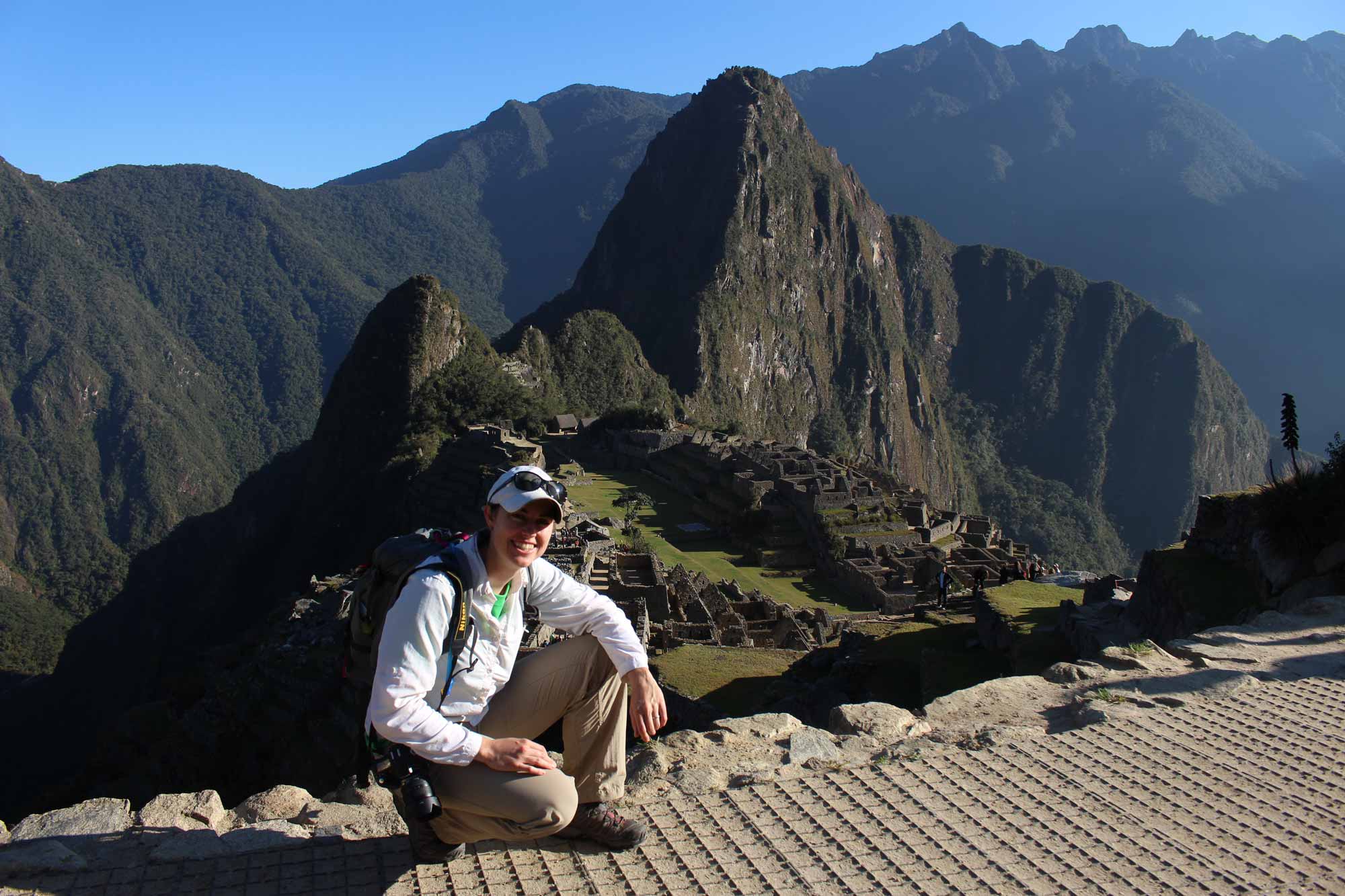
This is the heading
Lorem ipsum dolor sit amet, consectetur adipiscing elit. Ut elit tellus, luctus nec ullamcorper mattis, pulvinar dapibus leo.
Things to do
Lorem ipsum dolor sit amet, consectetur adipiscing elit.
Travel Information
Frequently asked questions.
In the city of Cusco, it is necessary to spend at least two days exploring the attractions of Cuzco in and around the city. If you are short on time, take a guided tour on the first day to learn about the city’s history and highlights, such as the Plaza de Armas, the Coricancha “Temple of the Sun” and Sacsayhuaman. On the second day, spend free time in Cuzco to explore the city at your own pace as you adjust to the high altitude.
The altitude of the imperial city of Cusco is 3,400 meters / 11,155 feet above sea level, located in the Peruvian Andes; and the Sacred Valley altitude is at roughly 2,800 meters/ 9,186 feet above sea level, 600 meters below Cusco; while Machu Picchu’s altitude is 2,430 meters/7,972 feet above sea level – almost a difference of 1000 meters/3,281 feet.
Cusco is a safe city in Peru, but like anywhere else in the world, it is necessary to take precautions when it is nighttime and after 6:00 pm it is dark. Taking a taxi is affordable since most rides in Cusco cost around 5-8 soles. However, there are, different types of taxis in Cusco and some are not registered official taxis.
For travelers short on time, half-day tours in Cusco are the best way to take in the highlights of South America’s oldest continuously inhabited city.
This half-day tour in Cusco usually begins in the afternoon, visiting Cusco’s main square known as the Plaza de Armas and the Coricancha (Temple of the Sun). These two sites introduce the drama of Cusco’s history through its architecture, from the rise of the Inca Empire to its defeat by Spanish conquistadors and the building of a colonial city atop the ruins. Then drive into the countryside to see impressive archeological sites, including Sacsayhuaman and other enclosures. This tour is the most extended way to start the visit to Cusco, Sacred Valley of the Incas, and Machu Picchu.
The easiest way to explore the Sacred Valley is to take a Sacred Valley Tour from Cusco that will pick you up and drop you off at your hotel. Usually, your tour will start in the town of Pisac and continue through the town of Urubamba and then visit the beautiful town of Ollantaytambo.
In addition, in the Sacred Valley of Peru, there are more of the most significant archaeological sites in the area that are worth a visit such as Moray (Inca ruin) and the Salt Mines of Maras. This itinerary can be done in an extra day as day trips from Cuzco, although travelers with more time will find much more to see and do. It is also possible to take a local bus or cab to the Sacred Valley and do some independent exploration.
NEED HELP FINDING SOMETHING?
We’re here to answer your questions about:.
- Peru Spirit Adventure vacations and itineraries
- Current deals and offers
- Why you should travel with us
Need an answer right away? Call us at +51 957 326 998
Your personal information will be used solely for purposes of responding to your request and to provide you with updates and information. Additional information is available in our Privacy Policy.
Peru Spirit Adventure
100% direct local tour operator.
Thank you so much for reaching out to us. We will respond to all email inquiries within 24 hours. We are also reachable by chat and phone and look forward to connecting.
Our main email: [email protected] / [email protected] Address: Urb. Picchu Alto J – 5, Cusco – Peru Mobile: +51 957 326 998 | +51 965 730 786 WhatsApp: +51 957 326 998
Please give at least two alternative start dates in order of preference. Write none if there are no other dates available for you View Payments Details
Sacred Valley Private Tours & Tailor Made with Local Experts
Connect with peru spirit adventure – 100% direct local tour operator.
Thank you so much for reaching out to us. Please complete the contact form below to tell us more about your dates, interests, the number of travelers, pick-up and drop-off places etc. We will do our best to help you organize your trip. You can be assured you will hear from us within 24 hours. Our Sacred Valley tour is available only in Private Service that offer you the flexibility to design your own trip exactly how you like it, as well as the duration of the visit in each case, not being subject to a larger group itinerary and timings.
Terms & Conditions
Thank you for booking and/or traveling on a Peru Spirit Adventure tour with Peru Spirit Adventure. We are 100% local Cusqueñan company and legally recognized by Peruvian law. These Terms and Conditions apply to any travel products and/or services purchased from Peru Spirit Adventure. A contract is entered into once PERU SPIRIT ADVENTURE receives your booking form and deposit, and we accept and confirm the booking. Please note that travel arrangements are not confirmed until stated so in writing by PERU SPIRIT ADVENTURE. All Peru Spirit Adventure based treks and tours are operated by Peru Spirit Adventure.
BOOKING & PAYMENT
To reserve any of our tours and treks services, the customer must submit his or her personal information and a deposit. The personal information we require is the following: Full name (as appears on passport), Date of Birth, Nationality, Gender, and Passport number.
- A picture of their passport photo page. A camera phone picture or similar is acceptable.
Once the customer confirms their reservation, we will send an email within 24 hours with a confirmation of their tour or trek and the deposit amount and also, details of the services included and not included in the service price. Once we send this information to the customer, if we do not receive any response from the customer it will be assumed by the company that the customer has accepted all terms and conditions. We provide a full pre-tour briefing at your hotel in Cusco. This gives the customer the chance to ask any questions they may have about the tour or trek itinerary. — ABOUT THE BRIEFING: The night before your tour or trek, there will be a pre-tour talk (briefing) at your hotel in Cusco at either 6:00 pm or 7:00 pm. (exact time will be confirmed by email). Once you receive your briefing time, if we do not hear back we will assume it is confirmed by you. Please take this into consideration when booking your travel plans to Cusco, ensuring you arrive in time for the briefing. If your tour or trek begins on a Monday then the briefing will be scheduled for the Saturday before.
- Please note that it is difficult to change the briefing time and date at short notice. Therefore, if we receive a request for a briefing change less than 48 hours prior to the scheduled briefing, we most likely will not be able to change the briefing time or date. We will, however, do everything we can to change to try and accommodate the schedule change.
We use PayPal for sending deposits, that way you can use your credit card. There is a 6% fee for deposits using PayPal (for the international transfer). We also use Western Union for sending deposits, Deposits through Western Union have variable fees. The deposit amount depends on the type of itinerary you will book, as follows;
- For all trek and multi-day tours, we require a deposit of $250 USD per person — Deposits for tours and treks are non-refundable and non-transferable to another individual. There are no exceptions.
- For the Rainbow Mountain tours & hikes we require a deposit of $100 USD per person — Deposits for tours and treks are non-refundable and non-transferable to another individual. There are no exceptions.
- For the Humantay Lake Day Trip, we require a deposit of $100 USD per person — Deposits for tours and treks are non-refundable and non-transferable to another individual. There are no exceptions.
- For the Sacred Valley Tours & Trips, we require a deposit of $100 USD (for the group) — Deposits for tours and treks are non-refundable and non-transferable to another individual. There are no exceptions.
- For the Cusco Half Day Tours, we require a deposit of $50 USD (for the group) — Deposits for tours and treks are non-refundable and non-transferable to another individual. There are no exceptions.
- For large groups, we accept wire transfer for deposits and final balances due. If you would like more information about the wire transfer option, please email us at [email protected]
FINAL PAYMENTS: We accept cash and PayPal for final payments. A client may not depart for the tour or trek until payment in full is received, either in cash or by PayPal.
- Cash payments are due the day before tour or trek departure and can be paid at the pre-tour or trek briefing. We accept US dollars and Peruvian soles for cash payments. If you will pay in US dollars. Take note. The Peruvian banks are extremely strict about the “quality” of dollars they will accept. Therefore, we have to request that your bills are what they call “unbroken”. Broken bills will not be accepted. Broken means — any tear (even as small as 3 mm) or excessive wrinkling
- PayPal payments are due one week before the tour or trek departure. a) There is an 8% fee on balance due payments using PayPal. b) If the balance via PayPal is not paid by 3 days prior to trek departure, the PayPal fee will be 10%. Our PayPal email is: [email protected]
- All banking fees will be covered by the client
CANCELLATION POLICY FOR TOURS & TREKS:
Notification
- Notification of cancellation must always be made in writing by the person that made the booking and paid the deposit to [email protected] .
- Your deposit for the tours and treks are 100% non-refundable. If you need to cancel for any reason, as you approach your tour start date, there may be additional cost due. There are no exceptions due to the fact, that PERU SPIRIT ADVENTURE expends a great deal of expense purchasing permits, entrance tickets, and making deposits for reservations or services, most of which are non-changeable, non-transferable, and non-refundable by government regulation. We also do not accept medical notes of any kind, as our out of pocket expenses are non-refundable to us.
CANCELLATION FEES
- Cancellations made 30 days in advance have no charge (with the exception of the non-refundable deposit) with the following exception:
- Inca Trail treks
- In the case of cancellation, the customer will not receive a refund of their deposit
- If the customer cancels between 30 and 10 days before their trek, they must pay 50% of the total trip cost.
- If the customer cancels between 10 and 3 days before their trek, they must pay 80% of the total cost.
- If the customer cancels 2 days or less before their trek, they must pay 100% of the total cost.
- In the exceptional case that a customer decides to leave once they have started the trek, no refund will be given. The customer must also pay any additional expenses they incur such as food, lodging, and transportation. On the last day, the customer will be able to rejoin the group and participate in the Machu Picchu tour.
- If after the tour has started a client cannot participate in the trek or tour (due to sickness, physical problems, etc.) no refund will be given. The customer must also pay any additional costs they incur for transportation, lodging, and food. On the last day, the tourist will be able to rejoin the group and participate in the Machu Picchu tour.
- In the case of natural disaster that prevents a service being completed, the customer will receive a 50% refund.
- In the case of a natural disaster that requires a change in the trek route, but the trek is still completed, there will be no refund.
- In the very unlikely circumstance that your service is not completed due to a fault of Peru Spirit Adventure, you will receive a full refund (including your deposit).
INCA TRAIL TOURS
- PERMITS: Permits for the Inca Trail are in your name and can not be transferred to anyone else under any circumstances. Change of dates is also not possible once a permit has been purchased. Permits are non-refundable and non-transferable. The deposit will be forfeited. Please note that this is a regulation of the Peruvian government and not Peru Spirit Adventure (or any agency).
- In extreme cases when the “Inca Trail to Machu Picchu” is declared closed for safety reasons, Peru Spirit Adventure will replace your trek with an alternative trek.
- Those who booked PERMITS with a Student ID must bring that ID with them on the trek. If they fail to show this card to the Park Rangers, they will not be allowed entry onto the trail.
CHANGES MADE BY CLIENT
- Please note that for the Inca Trail, permits are not-changeable, not-transferable, and not-refundable. Dates can never be changed by government policy.
With the exception of the Inca Trail treks, we are generally able to change a trek date.
- To change the date of your non-Inca Trail trek, there is a fee of US $75 per person if the change occurs more than 30 days prior to trek departure.
- If the change occurs 21 to 30 days prior to trek departure, the fee is US $100 per person.
- If the change occurs 10 to 20 days before trek departure, the fee is US $150 per person.
- Changes less than 10 days prior to trek departure will have varying fees, which can be discussed at the time the change is being made.
- Changes made must be to another group trek for a minimum of 2 individuals. If a single traveler needs to change dates, and there is not an existing option for that date, the change will not be possible.
TRAVEL INSURANCE
- We highly recommend travel insurance for all of our customers.
- Coverage should include baggage loss, accident, emergency air rescue and trip cancellation. Trip cancellation insurance should reimburse you for non-recoverable air or land expenses should you cancel your trip due to personal or family illness, as well as covering any medical or emergency evacuation expenses if you become ill during your trip.
- In the case of illness or injury on one of our treks or tours, we are trained to provide emergency first aid and arrange transportation to a proper medical facility. However, we are not responsible for the cost of those transportation services or the cost of medical care.
ABOUT YOUR PASSPORT IN MACHU PICCHU, HUAYNA PICCHU AND ON THE INCA TRAIL:
- Once you book your tour, we send your information immediately to “Machu Picchu Park” in order for permits to be issued as soon as possible.
- You will need to bring your actual passport for all services. A photocopy will not be accepted.
- If your passport number changes between reserving your spot and the start of your trek, you will need to bring your old as well as your new passport to the start of the Trek.
- If any of the information on your passport does not match the information we were previously provided, you won’t be able to start the trek.
- If you arrive in Cusco and did not advise us that you have a new passport number, and that your information has changed, Peru Spirit Adventure will not be held responsible. In this situation it will be the responsibility of the customer to pay the extra expense of returning to Cusco or Machu Picchu (transportation, food and other expenses).
TRAVEL IN PERU: Peru Spirit Adventure operates in regions, where standards of accommodation can vary. Transportation and other services might not be like those you would normally have back home. However, we strive with all due care and skill, to provide the best service for our clients. Traveling in Peru requires flexibility, patience, broad-mindedness, good humor and an understanding that changes may be made without notice due to circumstances or occurrences beyond our control. For example: a strike, protest, landslide, bad weather, etc. ( Force Majeure ). By booking any of our tours & treks, you agree to allow Peru Spirit Adventure to make necessary changes without liability.
FORCE MAJEURE
Force Majeure is any event that PERU SPIRIT ADVENTURE cannot with all due care foresee, control or avoid. This covers events such as war or threat of war, riot, civil strike, terrorist activity, industrial dispute, disease, natural disasters, adverse weather conditions, fire or all similar events beyond our control. In this case, PERU SPIRIT ADVENTURE will not accept liability and reserves the right to change, postpone or even cancel trips. (This is a last option, of course!)
By booking any of our adventure trips (Inca Trail to Machu Picchu, Lares, Salkantay, Ausangate, Choquequirao, Rainbow Mountain trek and more) you assume the risks associated with personal accidents, medical emergencies, air travel problems etc. For these treks, PERU SPIRIT ADVENTURE Agency accepts no responsibility.
FULL TERMS & CONDITIONS FOR ADVENTURE TOURS & TREKS
- You must advise Peru Spirit Adventure of any medical problems or allergies you may have. You need to be in good physical health, and if your health is questionable, then you should consult a doctor. If you are over the age of 70 years old, then you will need to present us with a current good health medical certificate.
- You must advise your guide if you wish to leave the group or the camping area for independent walks or sightseeing. If you are experiencing any problems with the services of the guide or tour, please advise the guide in that moment, so that he can resolve any problems.
- All balances need to be paid in either cash or PayPal (see “ FINAL PAYMENTS ” section above).
- In order to receive a student discount, you must send your valid University ID to Peru Spirit Adventure at the time of booking. ID must have your name, photo and valid expiration date. Any card without an expiration date will not be accepted. You will then be required to bring your student card with you on the trek – they will not allow you to pass through the checkpoint without this original card.
- You will be required to show the original passport (not a copy) that you booked with, at the checkpoint to enter the Inca Trail. If you originally booked with an old passport and then renewed your passport, you must also bring your expired passport along with your new, valid passport to permit entry or they will refuse your entrance to the trail.
- Cancellations: Your deposit is 100% non-refundable. If you need to cancel for any reason, as you approach your tour start date, there may be additional cost due. There are absolutely no exceptions (we do not accept medical notes of any kind) as our out of pocket expenses are non-refundable to us (see “CANCELLATION FEES” section above).
- PERMITS: Permits for the Inca Trail are in your name and can not be transferred to anyone else under any circumstances. Change of dates is also not possible once a permit has been purchased. Permits are non-refundable and non-transferable. The deposit will be forfeited. Please note that this is a regulation of the Peruvian government and not PERU SPIRIT ADVENTURE (or any agency).
- All Adventure Treks include transportation to Cusco. The return train route depends on train availability.
- If you become ill or injured on the trail and are unable to continue, a porter will be provided to accompany you back to an area with emergency assistance capabilities. Helicopter airlifts and medical assistance are at the expense of the trekker. If you are unable to complete the tour due to illness, we will assist you in meeting your group at Machu Picchu to recommence your tour at that point. There will be no refund of the original payment.
- PERU SPIRIT ADVENTURE will take all reasonable care in providing to our clients avoidance of accident, illness, and loss of personal property, and will only employ suitably qualified staff. We accept responsibility for the actions of our own employees. Peru Spirit Adventure cannot, however, be responsible for any action of third parties. You are totally responsible for your own personal property and rented equipment.
- PERU SPIRIT ADVENTURE does not take responsibility for unfavorable weather conditions, natural catastrophe, strikes, accidents, illness, injury, loss of personal ítems, etc. It is the client’s responsibility to carry insurance to cover these types of events. We reserve the right to modify or cancel the program due to any of the unforeseen conditions listed above.
VERY IMPORTANT:
- We strongly suggest spending time at high altitude (above 3000 meters / 9842 feet)- in Cusco or another high altitude area for a minimum of 2- 4 days before undertaking your trip. This is in order to minimize the possible effects of altitude sickness. By drinking plenty of fluids, adding sugar to your drinks, eating food high in carbohydrates, avoiding cigarettes, alcohol, and drinking coca tea (ancient traditional leaf) will help your body acclimatize.
- We recommend you arrive in Cusco 48 hours or more before trek departure because occasionally we need to leave earlier than scheduled in case of strikes or other events out of our control (see ‘Force Majeure’ section below)
RIGHT TO USE PICTURES
You accept and grant to Peru Spirit Adventure – Tour Operator the right to use your images, photos, and videos that show or describe during your participation in any tour, trekking or adventure, in any advertising of any type, without payment of any additional consideration.
Thanks again for choosing us and we look forward to seeing you in Cusco!
Peru Spirit Adventure Team!
Who is Peru Spirit Adventure ? We are a small tour operator company owned by a local Peruvian experts with more than 10 years of experience as a guide. Our office is based in Cusc o, a city in the Peruvian Andes and is located near the central square, Plaza del Armas. Our team is made up of knowledgeable and passionate tour guides from Cusco and Andes with many years of experience Read more
PERSONAL DETAILS
Email Address
Phone or WhatsApp United States Canada Mexico United Kingdom ----- Afghanistan Albania Algeria American Samoa Andorra Angola Anguilla Antigua and Barbuda Argentina Armenia Armenia Aruba Australia Austria Azerbaijan Azerbaijan Bahamas Bahrain Bangladesh Barbados Belarus Belgium Belize Benin Bermuda Bhutan Bolivia Bonaire Bosnia and Herzegovina Botswana Bouvet Island (Bouvetoya) Brazil British Indian Ocean Territory (Chagos Archipelago) British Virgin Islands Brunei Darussalam Bulgaria Burkina Faso Burundi Cambodia Cameroon Cape Verde Cayman Islands Central African Republic Chad Chile China Christmas Island Cocos (Keeling) Islands Colombia Comoros Congo Congo Cook Islands Costa Rica Cote d'Ivoire Croatia Cuba Curaçao Cyprus Cyprus Czech Republic Denmark Djibouti Dominica Dominican Republic Ecuador Egypt El Salvador Equatorial Guinea Eritrea Estonia Ethiopia Falkland Islands (Malvinas) Faroe Islands Fiji Finland France French Guiana French Polynesia French Southern Territories Gabon Gambia Georgia Georgia Germany Ghana Gibraltar Greece Greenland Grenada Guadeloupe Guam Guatemala Guernsey Guinea Guinea-Bissau Guyana Haiti Heard Island and McDonald Islands Holy See (Vatican City State) Honduras Hong Kong Hungary Iceland India Indonesia Iran Iraq Ireland Isle of Man Israel Italy Jamaica Japan Jersey Jordan Kazakhstan Kazakhstan Kenya Kiribati Korea Korea Kuwait Kyrgyz Republic Lao People's Democratic Republic Latvia Lebanon Lesotho Liberia Libyan Arab Jamahiriya Liechtenstein Lithuania Luxembourg Macao Macedonia Madagascar Malawi Malaysia Maldives Mali Malta Marshall Islands Martinique Mauritania Mauritius Mayotte Micronesia Moldova Monaco Mongolia Montenegro Montserrat Morocco Mozambique Myanmar Namibia Nauru Nepal Netherlands Netherlands Antilles New Caledonia New Zealand Nicaragua Niger Nigeria Niue Norfolk Island Northern Mariana Islands Norway Oman Pakistan Palau Palestinian Territory Panama Papua New Guinea Paraguay Peru Philippines Pitcairn Islands Poland Portugal Puerto Rico Qatar Reunion Romania Russian Federation Rwanda Saint Barthelemy Saint Helena Saint Kitts and Nevis Saint Lucia Saint Martin Saint Pierre and Miquelon Saint Vincent and the Grenadines Samoa San Marino Sao Tome and Principe Saudi Arabia Senegal Serbia Seychelles Sierra Leone Singapore Sint Maarten (Netherlands) Slovakia (Slovak Republic) Slovenia Solomon Islands Somalia South Africa South Georgia and the South Sandwich Islands Spain Sri Lanka Sudan Suriname Svalbard & Jan Mayen Islands Swaziland Sweden Switzerland Syrian Arab Republic Taiwan Tajikistan Tanzania Thailand Timor-Leste Togo Tokelau Tonga Trinidad and Tobago Tunisia Turkey Turkey Turkmenistan Turks and Caicos Islands Tuvalu U.S. Virgin Islands U.S. Minor Outlying Islands Uganda Ukraine United Arab Emirates Uruguay Uzbekistan Vanuatu Venezuela Vietnam Wallis and Futuna Western Sahara Yemen Zambia Zimbabwe
Phone Number
TRIP DETAILS
I am Interested in
Adults 0 1 2 3 4 5 7 8 Above 8
Children 0 1 2 3 4 5 7 8 Above 8
Departure Date
Questions and Comments
First Name:
Country: United Kingdom United States --- Afghanistan Albania Algeria American Samoa Andorra Angola Anguilla Antigua and Barbuda Argentina Armenia Armenia Aruba Australia Austria Azerbaijan Azerbaijan Bahamas Bahrain Bangladesh Barbados Belarus Belgium Belize Benin Bermuda Bhutan Bolivia Bonaire Bosnia and Herzegovina Botswana Bouvet Island (Bouvetoya) Brazil British Indian Ocean Territory (Chagos Archipelago) British Virgin Islands Brunei Darussalam Bulgaria Burkina Faso Burundi Cambodia Cameroon Canada Cape Verde Cayman Islands Central African Republic Chad Chile China Christmas Island Cocos (Keeling) Islands Colombia Comoros Congo Congo Cook Islands Costa Rica Cote d'Ivoire Croatia Cuba Curaçao Cyprus Cyprus Czech Republic Denmark Djibouti Dominica Dominican Republic Ecuador Egypt El Salvador Equatorial Guinea Eritrea Estonia Ethiopia Falkland Islands (Malvinas) Faroe Islands Fiji Finland France French Guiana French Polynesia French Southern Territories Gabon Gambia Georgia Germany Ghana Gibraltar Greece Greenland Grenada Guadeloupe Guam Guatemala Guernsey Guinea Guinea-Bissau Guyana Haiti Heard Island and McDonald Islands Holy See (Vatican City State) Honduras Hong Kong Hungary Iceland India Indonesia Iran Iraq Ireland Isle of Man Israel Italy Jamaica Japan Jersey Jordan Kazakhstan Kazakhstan Kenya Kiribati Korea Korea Kuwait Kyrgyz Republic Lao People's Democratic Republic Latvia Lebanon Lesotho Liberia Libyan Arab Jamahiriya Liechtenstein Lithuania Luxembourg Macao Macedonia Madagascar Malawi Malaysia Maldives Mali Malta Marshall Islands Martinique Mauritania Mauritius Mayotte Micronesia Moldova Monaco Mongolia Montenegro Montserrat Morocco Mozambique Myanmar Namibia Nauru Nepal Netherlands Netherlands Antilles New Caledonia New Zealand Nicaragua Niger Nigeria Niue Norfolk Island Northern Mariana Islands Mexico Norway Oman Pakistan Palau Palestinian Territory Panama Papua New Guinea Paraguay Peru Philippines Pitcairn Islands Poland Portugal Puerto Rico Qatar Reunion Romania Russian Federation Rwanda Saint Barthelemy Saint Helena Saint Kitts and Nevis Saint Lucia Saint Martin Saint Pierre and Miquelon Saint Vincent and the Grenadines Samoa San Marino Sao Tome and Principe Saudi Arabia Senegal Serbia Seychelles Sierra Leone Singapore Sint Maarten (Netherlands) Slovakia (Slovak Republic) Slovenia Solomon Islands Somalia South Africa South Georgia & S. Sandwich Islands Spain Sri Lanka Sudan Suriname Svalbard & Jan Mayen Islands Swaziland Sweden Switzerland Syrian Arab Republic Taiwan Tajikistan Tanzania Thailand Timor-Leste Togo Tokelau Tonga Trinidad and Tobago Tunisia Turkey Turkey Turkmenistan Turks and Caicos Islands Tuvalu U.S. Virgin Islands U.S. Minor Outlying Islands Uganda Ukraine United Arab Emirates Uruguay Uzbekistan Vanuatu Venezuela Vietnam Wallis and Futuna Western Sahara Yemen Zambia Zimbabwe
Adults 0 1 2 3 4 5 6 7 8 9 10 10+
Children 0 1 2 3 4 5 6 7 8 9 10 10+
Your Message
Accept terms and conditions - Terms and conditions
Please give at least two alternative start dates in order of preference. Write none if there are no other dates available for you
Inquire now

The Ultimate Cusco Itinerary for 5 Days
Are you visiting Peru for the first time and looking for the perfect Cusco Itinerary?
We’ve put together the best 5-Day Cusco Itinerary, including the popular attractions, the best tours, and some hidden gems.
Cusco is the perfect base for day trips to Machu Picchu , Sacred Valley, Rainbow Mountain, and Humantay Lake.
Our Cusco Travel Guide includes the best places to visit, how to get there, where to stay, and the best things to do in Cusco , Peru.
You’ll also find all the useful tips and information you need to plan your Cusco Trip Itinerary.
Disclosure: This post contains a few affiliate links, which means we may receive a small commission, at no cost to you, if you make a purchase through our link. This is a free way to support us and allow us to continue to create inspiring travel guides.
Boleto Turistico Cusco
Best hotels in aguas calientes, best restaurants in cusco, peru, best hotels in cusco, peru, no time to read now pin it.

Where is Cusco
Cusco is one of the most visited places in South America, located in the Peruvian Andes and easily accessible from Lima or Arequipa.
Best Time to Visit Cusco, Peru
Cusco has a subtropical highland climate. The weather is generally dry, with high humidity and lots of unexpected rain.
Cusco has two seasons the dry season runs from April to October, and the rainy season from November to March.
Cusco can be visited all year round, but the rainiest month is February. The busiest months are from June to August.
The best months to visit Cusco are between April and May or from September to October when the weather is pleasant for exploring, and there is little rain.
In high season, we strongly recommend booking accommodation and tours in advance!
TIP We did this Cusco Itinerary in May, and the weather was very cool during our visit. Therefore bring a light raincoat and walking shoes, and pack some warmer clothing for your trip to Peru.
Keep reading → Best Places to Visit in Peru

How to Get to Cusco, Peru
You can easily get to Cusco by plane or night bus from Arequipa , Lima, and La Paz and start your epic Cusco Itinerary.
Cusco has an International Airport , the Alejandro Velasco Astete International Airport (airport code CUZ).
But most travelers to Peru arrive at Jorge Chavez International Airport (airport code LIM), as you can get cheap flights to Lima.
We don’t recommend skipping Lima, but if your time is limited in Peru, you can fly directly to Cusco after arriving.
TIP Use Skyscanner to get cheap flights to Peru.
Unfortunately, there are no trains from Lima to Cusco!
Cusco is just a 1.5-hour flight from Lima and a 1-hour from Arequipa.
The Cusco Airport is about a 15-20 minute drive from the center, and taxi fare is 10-15 Soles (3-4 USD).
From Arequipa, we took an overnight bus to Cusco. The journey takes 10-11 hours, depending on traffic.
Bus tickets between Arequipa and Cusco start from 20 USD, and we recommend buy your tickets online.
Good to know The best way to get around Peru is to take the Peru Hop (hop-on, hop-off bus system) or the Cruz del Sur company (public buses).
Recommended post → Ultimate Peru Itinerary

Hi! We are Dittus & Máté
If you like our content and we’ve helped you with our free travel guide, please consider supporting what we do. Thank you.
Is Cusco a Walkable City?
Yes! Getting around in Cusco is easy, and most attractions are within walking distance.
However, there are many stairs and steep streets, and you may be slow going due to symptoms of altitude sickness.
You can also travel by Uber, but we recommend using the Beat app.
Another alternative is to take a taxi or join a sightseeing bus tour with Cusco Open Tour.
Good to know The bus tours last 2,5 hours and cost 14 USD per person.
See also → Best Day Trips from Cusco

Is Cusco Safe?
Yes, Cusco is generally safe. But small thefts and pickpockets can happen everywhere. So always take care of your valuables!
We don’t recommend walking alone at night!
Don’t forget to buy travel insurance for your Peru Itinerary! We always choose SafetyWing for our travels.

Wondering how to spend 5 days in Cusco? We took the route below during our visit to Peru.
But you can easily modify our Cusco Itinerary to extend or reduce the days.
For the perfect experience, book the best of Cusco in 3 days or choose an epic 4-day tour.
Day 1: Arrive in Cusco, Peru
Welcome to Peru! We hope you had a great flight or bus ride and are ready to explore charming Cusco.
Cusco is the perfect place to start or end your Peru Itinerary.
Depending on when you arrive in Cusco, you can choose to start city sightseeing or just relax.
But we reccomend planning your Cusco Itinerary to go slow on the first day, with a comfortable pace to discover the city.
Some people may experience mild symptoms of altitude sickness, such as headaches, dizziness, nausea, or heavy breathing.
Cusco is located at 3,400 meters above sea level.
Avoid altitude sickness in Peru! So drink plenty of water and coca tea, and avoid alcohol.
Good to know Arequipa is the perfect place to get used to the altitude of 2,335 meters before heading to Cusco and Machu Picchu.

One of the best things to do in Cusco is to walk around the city and explore the cobbled streets and beautiful buildings.
The historic center is a UNESCO World Heritage Site and was formerly the capital of the Inca Empire, so Cusco is well worth a visit.
There are many cozy cafés, great restaurants, and trendy boutiques here. So wear comfortable shoes and spend the afternoon wandering the area. Join a Cusco city tour.
TIP Are you looking for the best view in Cusco? Then visit Cappuccino Cusco Cafe for the delicious coffee and beautiful views.

Day 2: Cusco Sightseeing
Good morning! It’s time to continue your Cusco Itinerary and explore the best attractions.
Have a delicious breakfast at The Bagel Cafe and then join a sightseeing tour or discover the sights at your own pace!
Buy a Boleto Turistico Cusco ticket (scroll down for more information about where to buy it, how much it costs, and what attractions it includes)!
Wondering what to do in Cusco, Peru?
Stroll around the historic center, visit the best temples and museums, enjoy the beautiful viewpoints, buy Peruvian clothes, and explore Sacsayhuaman.
We’ve put together a detailed post on the best things to do in Cusco , with tips to help you plan your Cusco Itinerary.
Honestly, Cusco was our favorite place on our visit to Peru, so if you don’t have time to see all the sights, just enjoy the fantastic atmosphere of the city and wander around the cobbled streets.
TIP Book the best Sacred Valley tours through GetYourGuide , where you can get great prices.

The full Cusco tourist ticket costs 130 Soles (35,5 USD), is valid for 10 days, and gives access to 16 attractions (except Machu Picchu , Rainbow Mountain, Maras Salt Mines, and Huayna Picchu, all require separate ticket purchases!)
The ticket includes these 16 places:
- Museo de Arte Popular
- Museo de Sitio Qorikancha
- Centro Qosqo de Arte Nativo
- Monumento de Pachacutec
- Museo Histórico Regional
- Sacsayhuaman
- Museo de Arte Contemporáneo
- Puka Pukara
- Tambomachay
- Ollantaytambo
You can buy Boleto Turistico tickets at all attractions (except the Museum of Contemporary Art and the Pachacutec Monument) or Counter Central (Av. El Sol 103) in Cusco.
Good to know The tourist tickets are for personal use, and you must write your name on the ticket!
Keep reading → Things to Do in Lima

Day 3: Sacred Valley Tour
Good morning! Start the day early, have breakfast, and join an organized tour from Cusco to the Sacred Valley.
A must-do in Cusco Itinerary is a visit to the Sacred Valley. It is famous for its unique attractions, historic towns, and important archaeological sites.
Take a day trip from Cusco and discover the most beautiful sights of the Sacred Valley.
The altitude sickness in Peru can be a challenge for many people. Although the Sacred Valley is lower than Cusco, we recommend you drink plenty of water and wander slowly!
Chewing coca leaves or drinking coca tea is good for altitude sickness.
Good to know There are coca leaves in every hotel in Cusco, so have a cup of coca tea before you start the Sacred Valley tour.
Read our → Ultimate Guide to Sacred Valley

Wondering what to do in Sacred Valley, Peru? Walk around the Chinchero Ruins, see the best view at Ollantaytambo, visit the Maras Salt Mines, buy Peruvian souvenirs, and explore the Moray Terraces.
The best way to explore the attractions is to join a private or group tour.
Book a multi-day tour, including Machu Picchu.
You cannot buy individual tickets for most of the attractions in the Sacred Valley! You must therefore buy the full or one of the partial Boleto Turistico Ticket.
More about Peru → Arequipa

Day 4: Rainbow Mountain Tour
Are you ready for one of the highlights of your 5-day Cusco Itinerary?
Good morning! Get up early and take a day trip from Cusco to the colorful Rainbow Mountain!
Depending on traffic, the journey time from Cusco to Rainbow Mountain takes 3-3.5 hours.
The Rainbow Mountain, like Machu Picchu, Sacred Valley, and the Huacachina Desert Oasis , is a must-see attraction on your Peru trip.
There are two beautiful rainbow mountains in Peru, so if you’re in a limited time in Cusco, you’ll have to decide which one to visit. Both rainbow mountains can be reached on a day trip from Cusco.
No public transport to Rainbow Mountain. You can join a group tour or a private tour. Book your Rainbow Mountain tour in Cusco or online.
The pick-up time usually starts between 3-4 AM, but it’s worth it!
Read our → Guide to Palccoyo Rainbow Mountain

The most popular is Vinicunca Rainbow Mountain, which is always crowded. The Vinicunca Rainbow Mountain hike is steep and difficult, and it takes about 3-3.5 hours. Book your Cusco Rainbow Mountain Tour.
Did you know that Rainbow Mountain is the highest hike in Peru?
Because it is higher than Machu Picchu (2,430 meters) or the Sacred Valley (2,800 meters).
Palccoyo is 4,900m above sea level, while Vinicunca is 5,200m above sea level.
The hike to Palccoyo Mountain is much easier, with only a short steep part, and takes about 1.5-2 hours.
TIP If you want to take a day trip to Humantay Lake from Cusco, add an extra day to your Peru Itinerary.

Day 5: Visit Machu Picchu
The highlight of our trip was the picturesque train ride from Cusco to Machu Picchu.
The best part of every Cusco Itinerary is a trip to the famous Inca Ruins, Machu Picchu. From Cusco (Poroy station), you can easily get to Aguas Calientes (Machu Picchu) by train. Alternatively, hike the Classic Inca Trail.
We recommend booking your train ride at least a few weeks in advance!
The most popular of PeruRail’s trains are the Vistadome with its panoramic windows and the luxury trains of the Belmond Hiram Bingham.
We recommend you take the PeruRail Vistadome train from Cusco to Machu Picchu. After that, save money and travel back to Cusco on the PeruRail Expedition.
Make the most of your visit and book day trips from Cusco to Machu Picchu via Viator. This tour is one of the most reviewed, so you will not be disappointed.
Recommended post → How to Visit Machu Picchu

Once you arrive in Aguas Calientes, buy your bus ticket to Machu Picchu, which costs 24 USD round trip.
You can visit Machu Picchu at your own pace or join a group or private tour. To get to know more about Machu Picchu, hire a local guide.
Good to know Don’t forget to buy your Machu Picchu ticket at least 1 month in advance!
Spend a few magical hours exploring the Inca Ruins and then travel back to Cusco.
We hope you enjoyed your visit to Cusco and made the most of your trip to Peru. But it’s time to finish your Cusco Itinerary, catch a flight to Lima, and fly home, or continue your journey by visiting Bolivia.
The easiest way to get from Cusco to Lima is to take a short domestic flight.
Where to Stay in Machu Picchu
Machu Picchu Pueblo, also known as Aguas Calientes, is the closest town to the Inca Citadel.
- Luxury: Inkaterra Machu Picchu Pueblo Hotel
- Mid-Range: Hatun Inti Boutique
- Budget: Supertramp Hostel Machupicchu
TIP If you are only planning a day trip to Machu Picchu, you should choose accommodation in Ollantaytambo or Cusco.

Where to Eat in Cusco
In Peru, you can find many local restaurants, vegan options, national foods, or trendy restaurants with all budgets.
These are our recommendations in Cusco.
- Cappuccino Cusco Cafe (Delicious coffee at Plaza de Armas square)
- The Bagel Cafe (Perfect breakfast spot)
- Morena Peruvian Kitchen (Trendy restaurant with excellent food)
- L’atelier Café Concept (Best balcony view in Plaza San Blas)
- Green Point (One of the best vegan restaurants)
- Pizzeria Trattoria Casa Grande (Heavenly Italian dishes)
- Qura (Healthy smoothie bowls)
- Avocado, toast & more (Fantastic breakfast place with delicious food)
- Organika Restaurant (Perfect lunch or dinner spot)
- Ceviche Seafood Kitchen (You have to try Peru’s national dish, Ceviche)
Join a Peruvian cooking class.

Where to Stay in Cusco
If you don’t want to walk a lot or use a taxi, we recommend you stay near the historic center (Plaza de Armas). But the San Blas area also offers fantastic accommodations, about 15-20 minutes walk away.
The accommodation options are available for all budgets.
- Luxury: JW Marriott El Convento Cusco
- Mid-Range: Taypikala Hotel Cusco
- Budget: Wild Rover Cusco

How many Days do you Need in Cusco and Machu Picchu?
Depending on how many days you will be in Peru , plan your trip to spend at least 3-5 days in Cusco. This allows enough time to enjoy the best things to do in Cusco and visit Machu Picchu.
Make the most of your Cusco, Machu Picchu Itinerary, and spend one night in Aguas Calientes.
Are you spending limited time in Peru but want to make the most of your visit? Book the best 6-day Peru Tour, including a visit to Machu Picchu.

We hope our 5-day Cusco Itinerary will help you plan your next trip to Peru. If you have any questions or thoughts, let us know in the comments below.
Travel Resources
Hotels – Booking.com Car Rentals – Discover Cars Flights – Skyscanner Travel Insurance – SafetyWing Tours & Attractions – GetYourGuide Bus/Transfer – Bookaway
RECOMMENDED POSTS

How to Get from Lima Airport to Miraflores

The Ultimate Peru Itinerary for 10 Days

13 Best Places to Visit in Peru
Leave a comment cancel reply.
Your email address will not be published. Required fields are marked *
Save my name, email, and website in this browser for the next time I comment.
We use cookies on our website to give you the most relevant experience by remembering your preferences and repeat visits. By clicking “Accept”, you consent to the use of all the cookies. However, you may visit "Manage Settings" to provide a controlled consent.
Pin It on Pinterest
Wanderlust Travel & Photos
Seeing the world one trip at a time.
- Work With Me
- Travel Journal
- Privacy Policy
- Browse by Continent
- Thailand Travel
- Australia Travel
- Peru Travel
- Browse by Region
- East North Central
- East South Central
- Mid-Atlantic
- New England
- South Atlantic
- West North Central
- West South Central
- Central America
- North America
- South America
- Travel Vlog
- Instagram Photos
The Definitive Cusco Peru Visitor Guide
LAST UPDATED – 2/12/24 – Cusco Peru Visitor Guide
Nestled deep in the rolling hillside of the Peruvian Andes, the city of Cusco seems to capture the imagination of travelers more than most other South American cities. Because of its remote location in the mountains, the city has remained insulated from the hustle and bustle of modern life in many ways. Though you can find beautiful five-star hotels and most of the amenities that you find in bigger cities like the capital city of Lima, the city of Cusco still retains much of its small-town feel.
As one of the most important cities in the ancient Incan world, this also includes an abundant amount of historical and cultural sites. Whether you are visiting Cusco on your way to see Machu Picchu and the Sacred Valley, headed further into the Andes to see the beautiful Rainbow Mountains, or will be staying for an extended period in Cusco itself, you will be amazed by the beauty and warm hospitality that you will find in this amazing city.
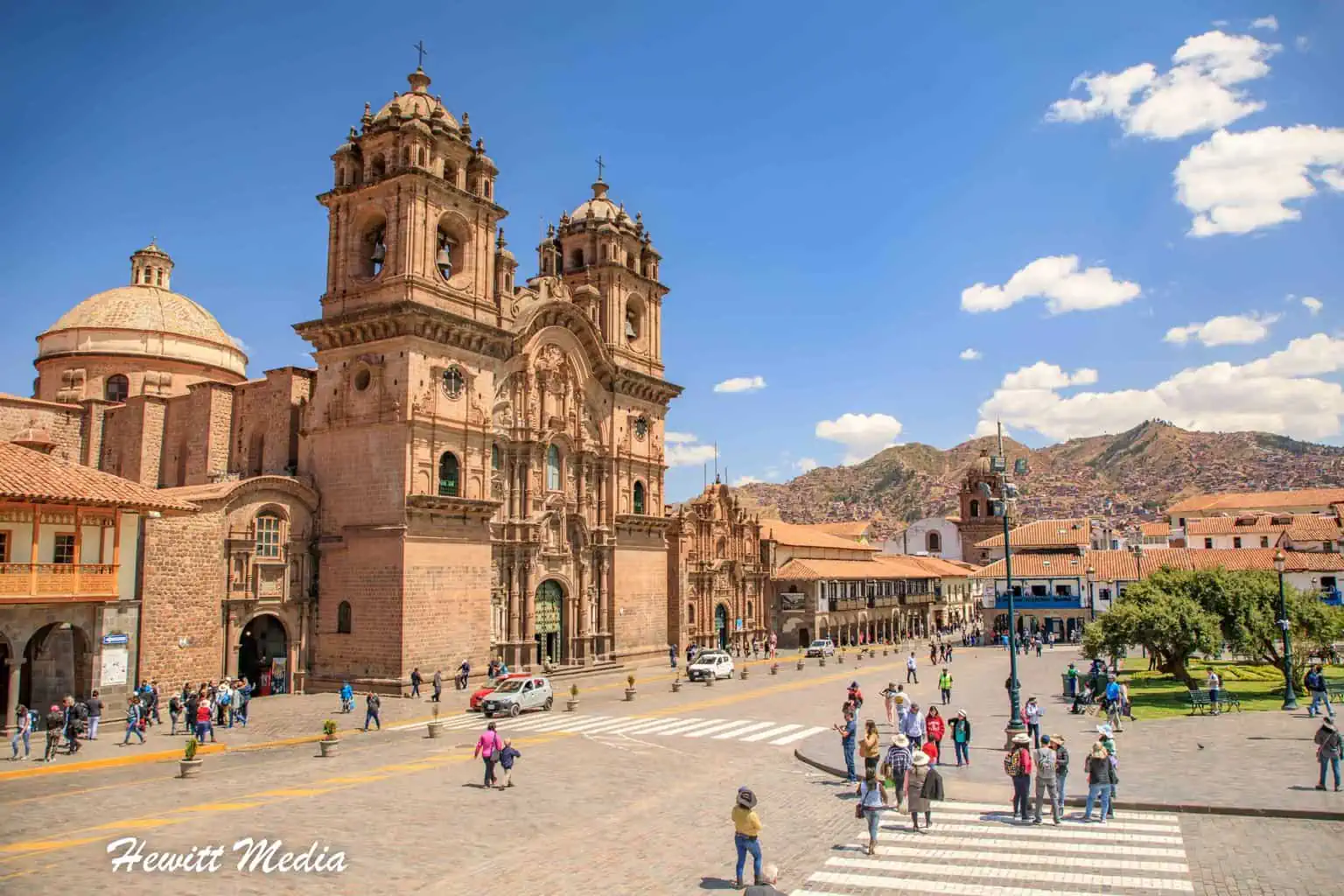
In this Cusco Peru visitor guide, I am going to give you all of the information you need to plan a successful trip to Cusco, Peru. I cover the best times to visit and the best ways to get there so that you can maximize what you can see and do on your trip. In addition, I outline the top things to see and do while you are there and where the best places to stay and eat are. With this information in hand, you can be confident that your trip to Cusco will be one that you remember for the rest of your life.
Cusco Visitor Guide Navigation Menu
At a glance.
Before you start making any travel plans, you need to be sure you meet the country’s entrance requirements. This includes all of the passport, VISA, and immunization requirements for Peru.
In addition, you need to make sure you have a clear understanding of what languages they speak in Peru. This way, you can plan any translation needs you may have. Not only that, but you will need to know what currency they use in Peru. Knowing this, you can plan to exchange currency before your trip if necessary.
I have included some of this key information in my Cusco , Peru visitor guide below for you to review as you start to make your travel plans.
Passport Requirements
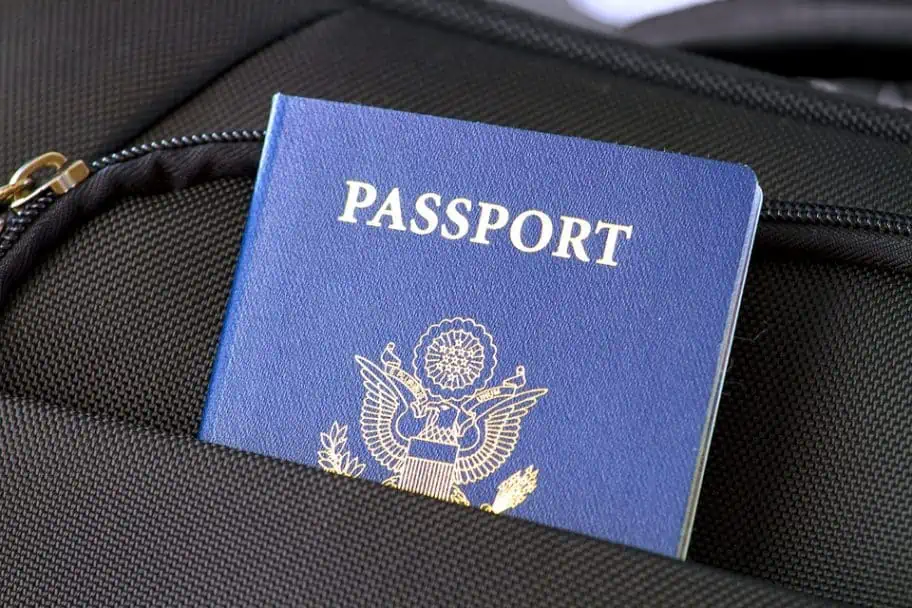
To enter Peru, you must have a passport that is valid for 6 months after the date on which you enter the country. If you plan on staying in Peru for 90 days or less, you will not need a VISA to enter the country. However, you must be able to show proof of return or onward travel to be admitted. For additional information, please refer to the website of the US Embassy in Peru .
Travel Immunizations
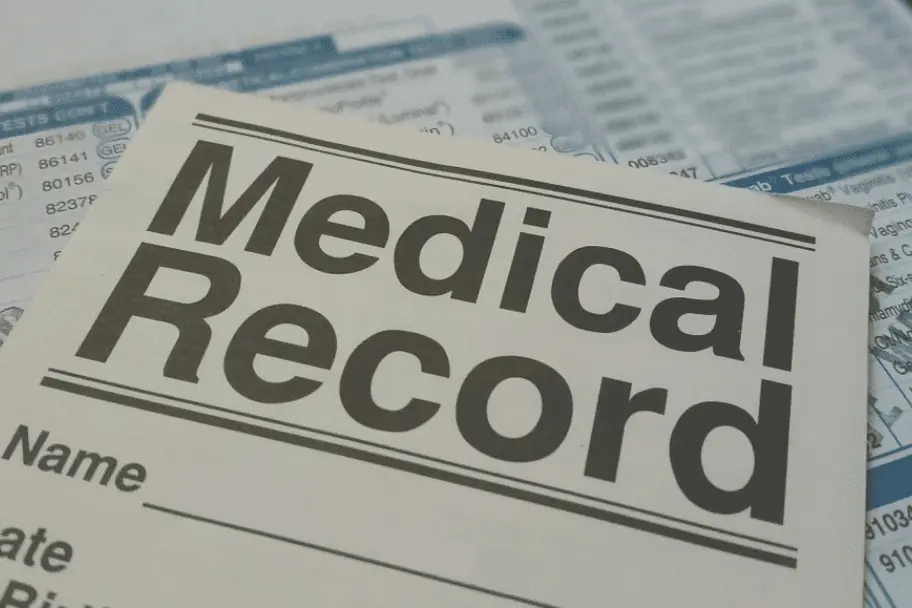
Before you leave for your trip to Peru, you need to make sure you have all of the proper vaccinations. Not only to protect yourself but to protect others. If you have questions on what immunizations you will need and what to look out for when you go to get them, below are some general guidelines I can pass on to you from experience.
- Most specialized travel clinics will not accept insurance so you will have to pay for your travel consultation and immunizations and then request reimbursement from your insurance company later.
- Some immunizations aren’t accepted by every insurance company, so check with your insurance provider before getting your immunizations.
- Check with your regular doctor first, as often they can do a travel consultation for you and write you the necessary prescriptions for your immunizations, even if they aren’t able to give them to you. This way you can ensure that at least your travel consultant will be covered by your insurance up-front.
- Check with Walgreens or other drug stores that give flu shots to see if they have any of the immunization shots that you require before going to a specialized clinic that doesn’t accept insurance to get them. Walgreens can give you many of the immunizations necessary for international travel, and they accept insurance up-front.
- The Centers for Disease Control (CDC) website can be a great resource for answering any travel immunization questions that you have.
Peru Travel Vaccinations
You may be wondering what vaccinations your physician will recommend. In case you are, I have compiled a list of what you might expect your doctor to recommend below.
- Typhoid (either a shot, which is good for 2 years, or a live virus pill, which is good for 4 years).
- Yellow Fever (The Yellow Fever vaccination is not required to enter Peru, and it is not recommended if you are staying within the areas around Cusco and Machu Picchu. However, if you are also traveling within the regions of Amazonas, Loreto, Madre de Dios, San Martin, Ucayali, Puno, Cusco, Junín, Pasco, and Huánuco it is recommended that you get the Yellow Fever vaccination. Please see the Centers for Disease Control (CDC) map of the areas where a Yellow Fever vaccination is recommended for more detail).
- Hepatitis A & B (if you haven’t had them).
- Tetanus (if you aren’t current).
- Dukoral (gives you 3-month protection against travel diarrhea).
- Acetazolamide – This prescription medication is used to treat the pressure buildup in your eyes from glaucoma, but can also be very effective in treating the pressure buildup in your sinuses and head caused by increased altitude. It is a good way to prevent the notorious headaches caused by an adjustment to higher altitudes.
Travel Insurance
Before you head to Peru, I would recommend that you purchase travel insurance. You will want to have this in case something happens and you have to either postpone or cancel your trip. It would also be a great idea to purchase emergency medical evacuation insurance . Should an emergency occur and you need to be medically evacuated from the country, that could cost you tens of thousands of dollars.
Altitude Tips
One of the things you need to be acutely aware of when you visit Cusco is the altitude of the area. The city of Cusco sits at an altitude of 11,152 feet (3,399 meters), which is a much higher elevation than many travelers are used to. For some people, this high elevation can be a bit much. People may experience shortness of breath, headaches, and even dizziness at these elevations. If you are suffering from pre-existing medical conditions such as a bad heart, the higher altitude can even be deadly. In extreme cases, people have even suffered from acute altitude sickness and even death from the altitude. You can protect yourself by preparing for the high altitude by following these tips:
- Always stay hydrated.
- Take time to acclimate to the higher altitude. After arriving in Cusco, stay a few nights in the Sacred Valley (which sits at a much lower elevation). The city of Pisac sits at 6,730 feet (2,050 meters). This will allow your body time to adjust to that altitude before going back to Cusco and adjusting to that elevation.
- Talk to your doctor about an Acetazolamide prescription. This medication is used to treat eye pressure for those suffering from glaucoma and can also decrease the painful effects of high-altitude headaches.
- Try coca leaf tea to relieve altitude symptoms. It is a local remedy for altitude discomfort that locals swear by. Most hotels in Cusco will offer the tea complimentary.
- Book a hotel in Cusco with pumped-in Oxygen. Most of the nicer hotels in Cusco will pump Oxygen into their hotel rooms. This is a great way to minimize the effects of the altitude when visiting.
- If you feel symptoms of altitude sickness and they don’t go away with any of the above remedies, get down to a lower altitude immediately. Your health isn’t worth the risk. Get to a lower altitude until you feel better and then consider returning back to Cusco.
Packing Tips
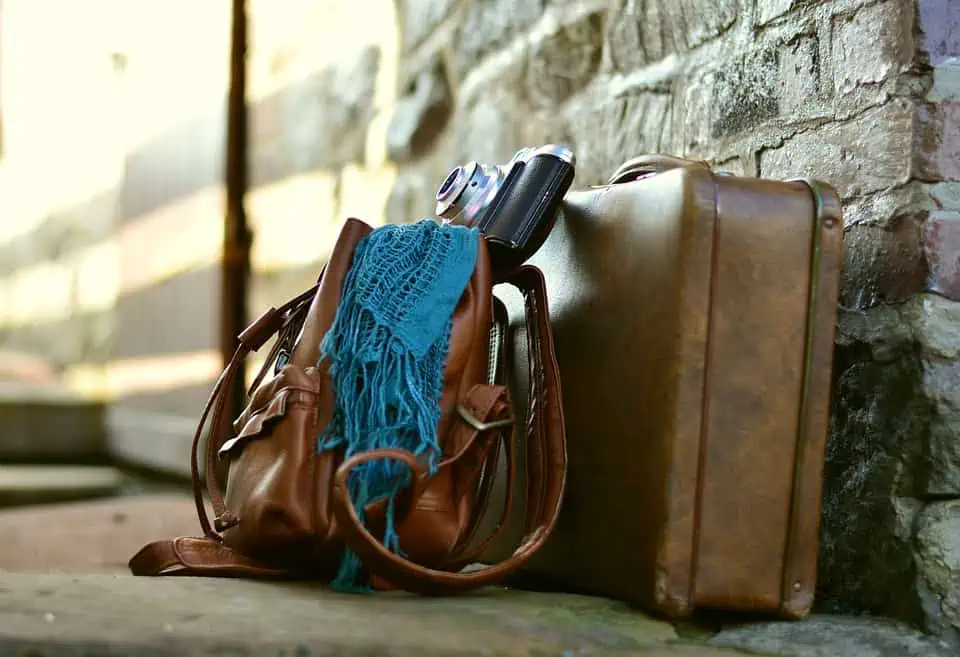
Before you start packing for your trip to Peru, you will want to make sure you have all of the gear that will keep you organized, comfortable, and safe on your trip. This is especially true if you are planning on visiting Machu Picchu and hiking the Inca Trail. To help you out, I have included links to some comprehensive packing resources I created for you to review in my Cusco Peru visitor guide below.
Top Things to See and Do in Cusco
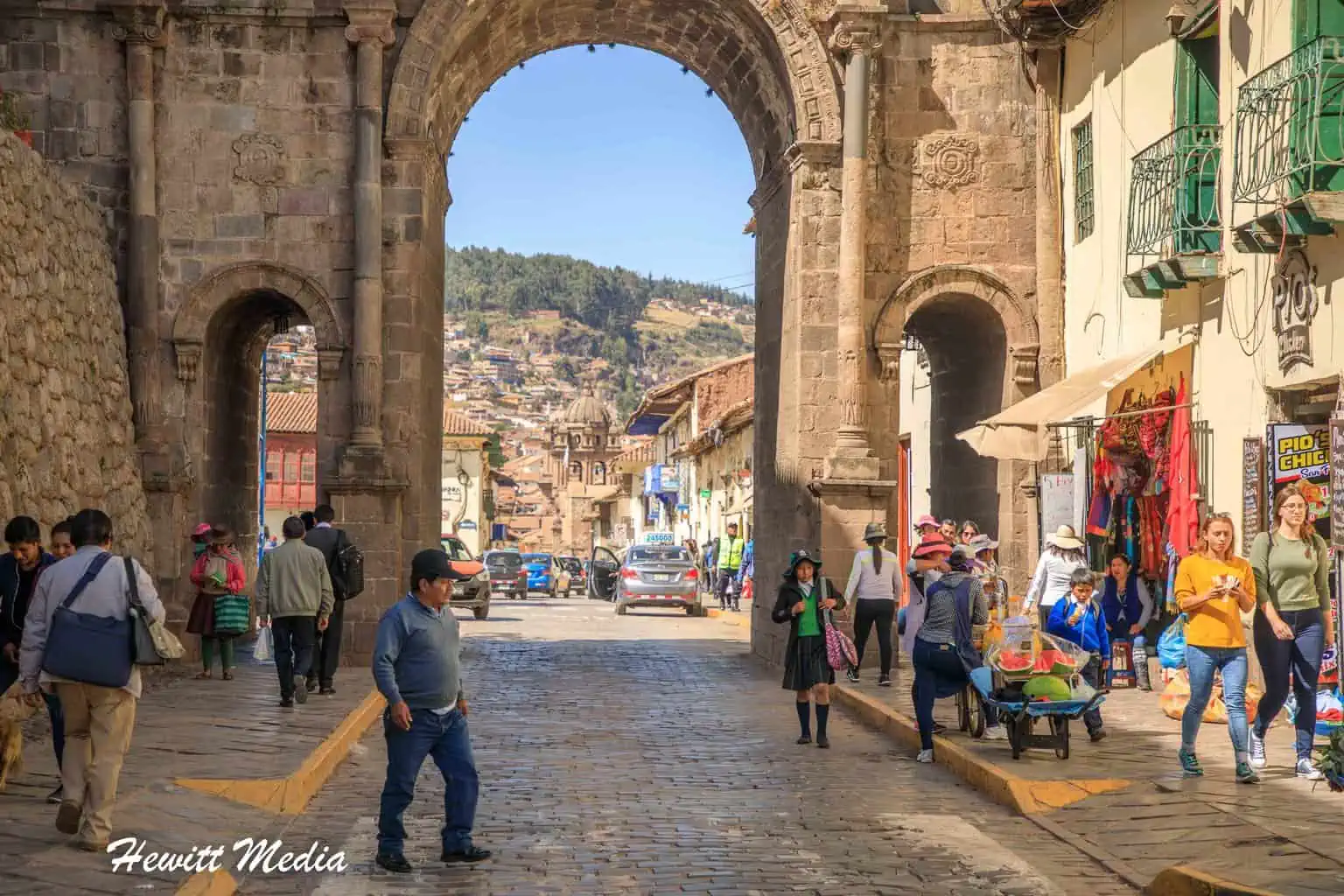
While most travelers who visit Cusco do so on their way to Machu Picchu, the Rainbow Mountain, or one of the other high-profile tourist destinations in the area, there are also several amazing things to see within the city itself. To assist you in filling out the itinerary for your trip, I have included a list of the top things to see and do within and around Cusco in my Cusco Peru visitor guide below.
Catedral del Cuzco
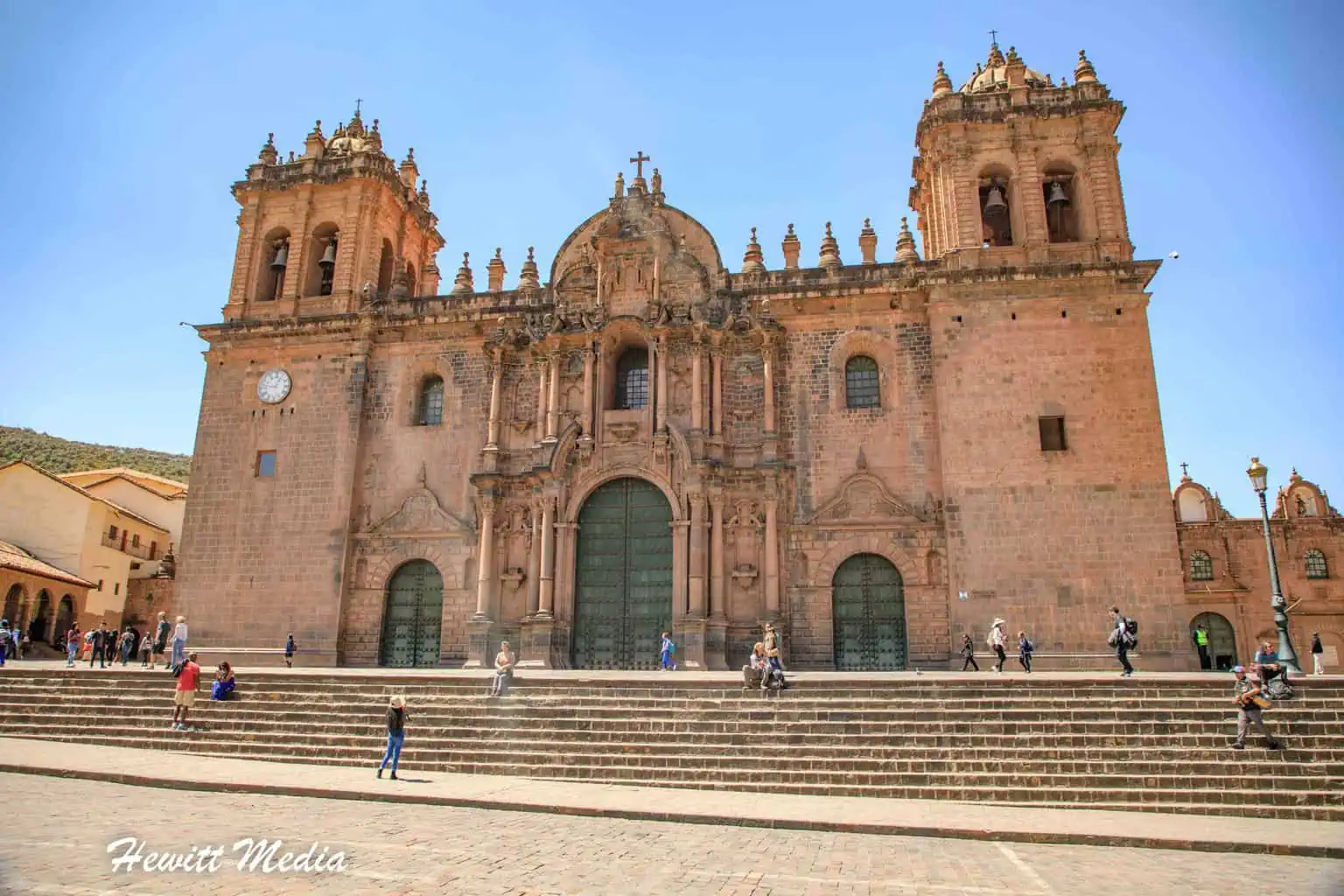
Located in the Plaza de Armas in the historical center of downtown Cusco, the Catedral del Cuzco, which is also known as the Cathedral Basilica of the Assumption of the Virgin, is the main Roman Catholic cathedral in the city. It was constructed between 1560-1654 and was designated as a UNESCO World Heritage Site in 1983. In addition to being an important religious institution in the area, the cathedral has also become a large repository of colonial art in Cusco.
Iglesia De La Compañia De Jesús
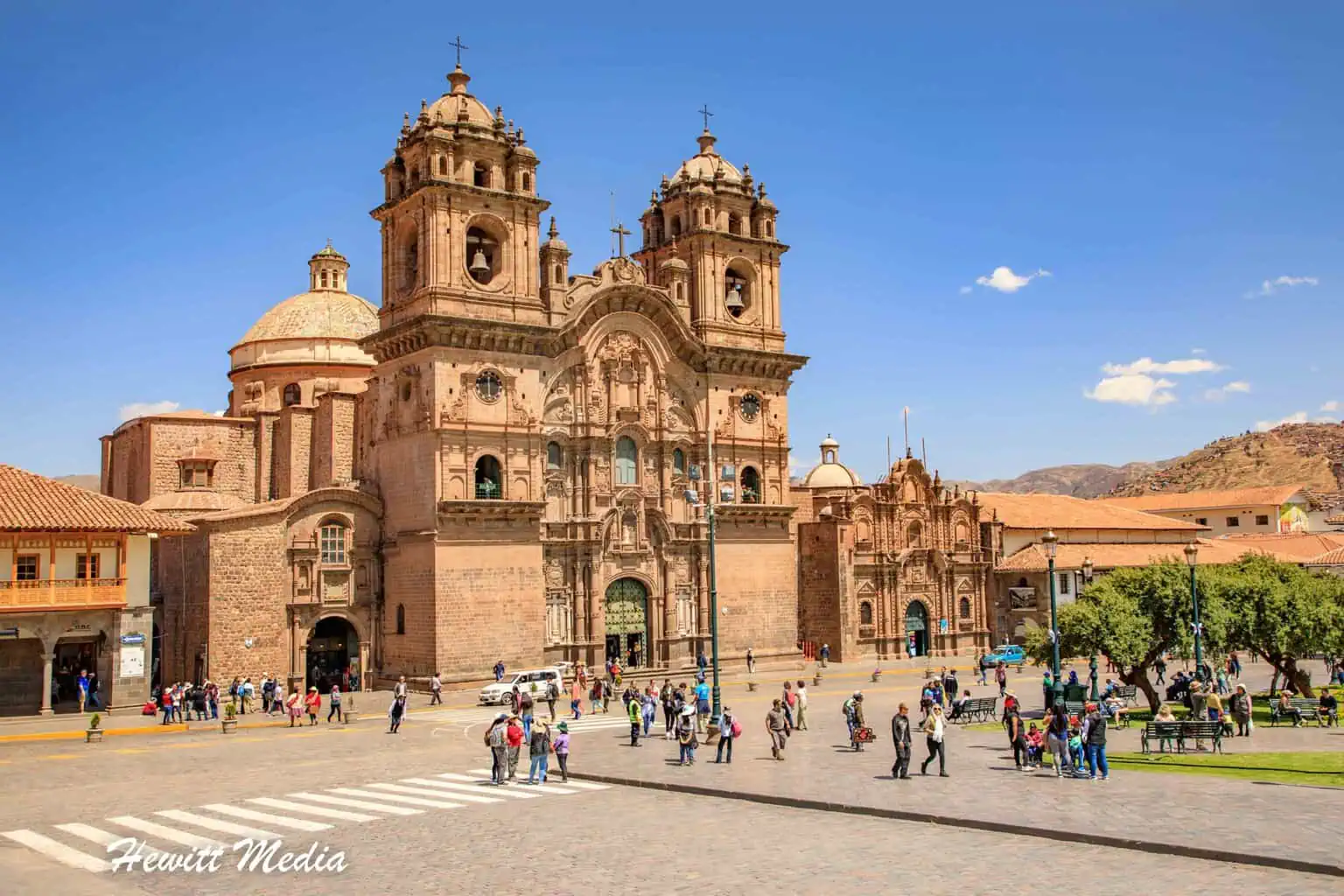
Constructed on top of an ancient Incan palace in the Plaza de Armas, which sits in the historical center of the city of Cusco, the Iglesia de la Compañía de Jesús translates to mean the Church of the Society of Jesus. This historic Jesuit church was constructed beginning in 1576, but badly damaged by an earthquake in 1650. The rebuilt church that you see today was completed in 1668. The beautiful Baroque architecture of the church is very distinct and is the main reason why the church is widely regarded as one of the prettiest in Peru.
Plaza de Armas
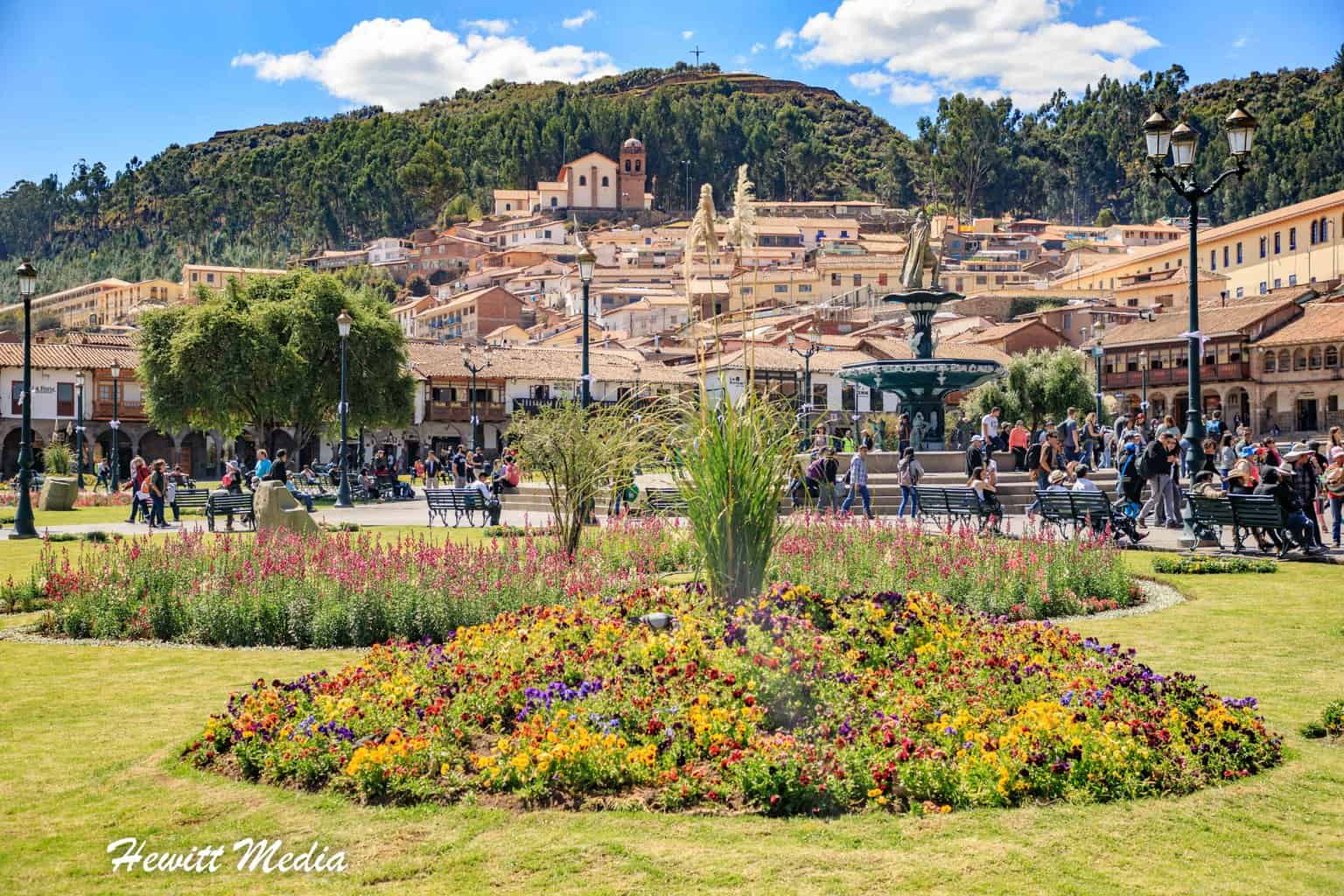
Widely considered to be the geographical and cultural hub of the city of Cusco, the Plaza de Armas has been considered the city center of Cusco dating all the way back to the days of the Incas. Today, it is located in what is referred to as the historical center of Cusco. Known as the “Square of the Warrior”, the plaza contains some of the city’s most prominent buildings.
This includes the Cusco Cathedral, the Church of the Society of Jesus, and the public university. From the plaza, you can see the Cristo Blanco statue high up on the hills overlooking the city. I would definitely recommend you spend a good deal of time exploring the Plaza de Armas and the surrounding buildings.
The San Pedro Market
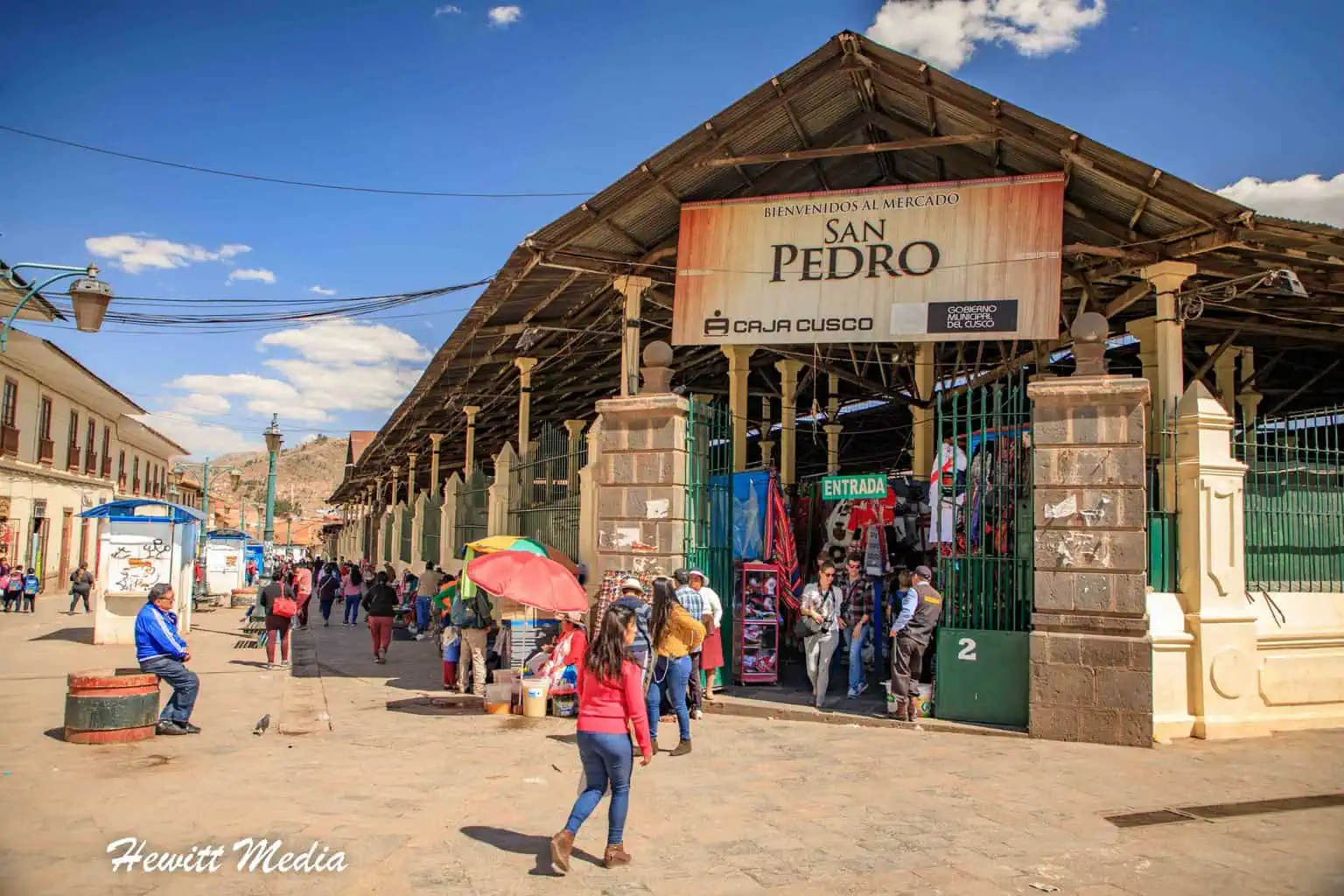
If you are looking to see what the people in Cusco like to shop for and eat, or you are just in the mood to do a little shopping for some souvenirs, then I would definitely recommend making a stop at the San Pedro Market. Vendors within the market sell a wide variety of fresh goods, including fruits, fruit juices, meats, produce, fabrics, dolls, and other gifts.
If you are looking for a quick bite to eat, I would suggest stopping into the market to grab one of the fresh empanadas (meat or cheese-filled pastry) or salchipapas (friend sausage and potatoes). They are amazing! If you are interested in seeing more of the market, I have some more pictures taken inside the market in my photo gallery at the bottom of this guide.
Iglesia de San Pedro
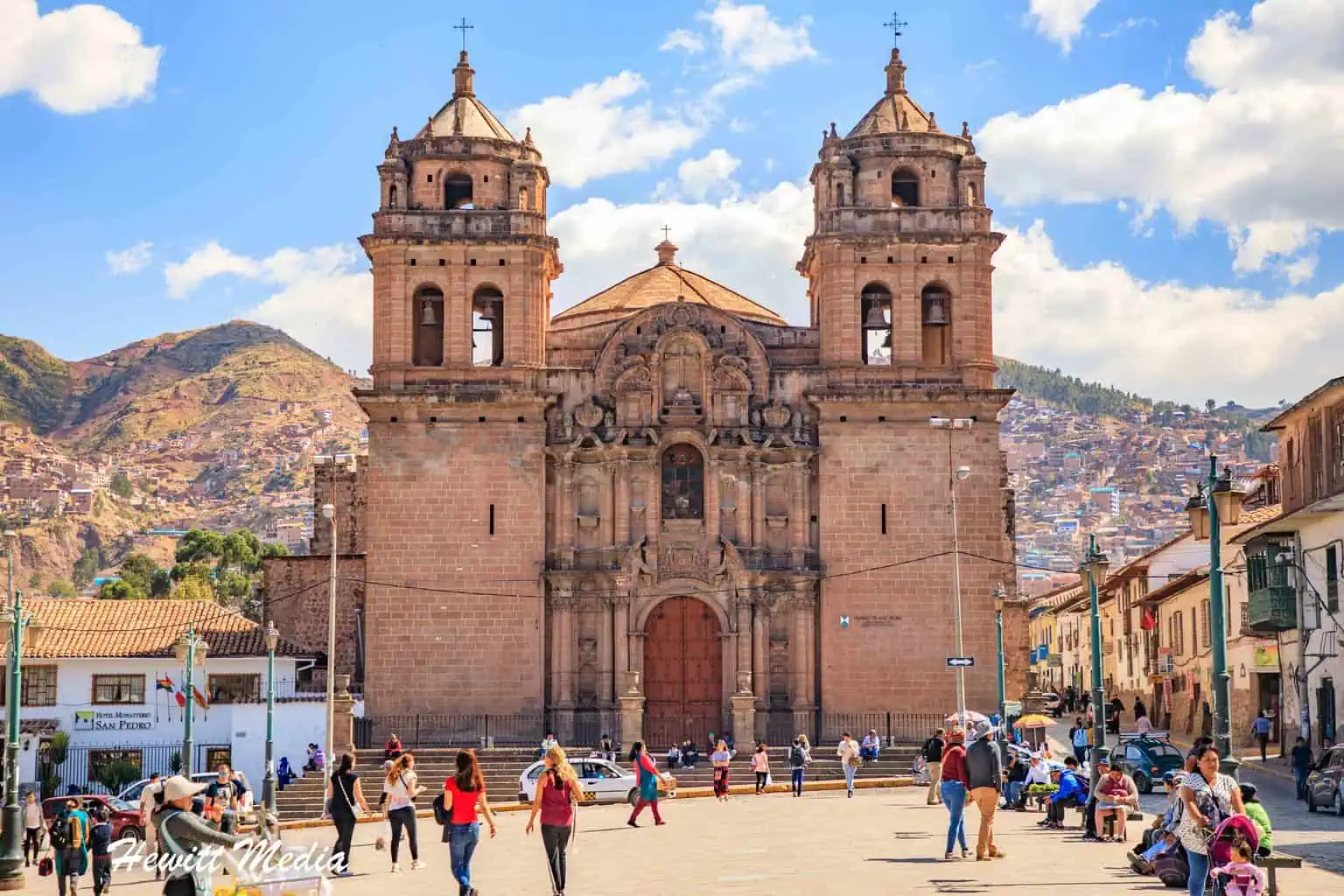
If you love to visit old, beautiful churches when you travel, then you will also want to make sure you visit the Iglesia de San Pedro or St. Peter’s Church, while in Cusco. While not as large or as intricate as the more well-known churches in the Plaza de Armas, St. Peter’s Church is a pretty and well-kept church that is worth seeing in person. It is very close to the San Pedro Market, so I would stop in and check it out on your way to do a little shopping.
Cristo Blanco
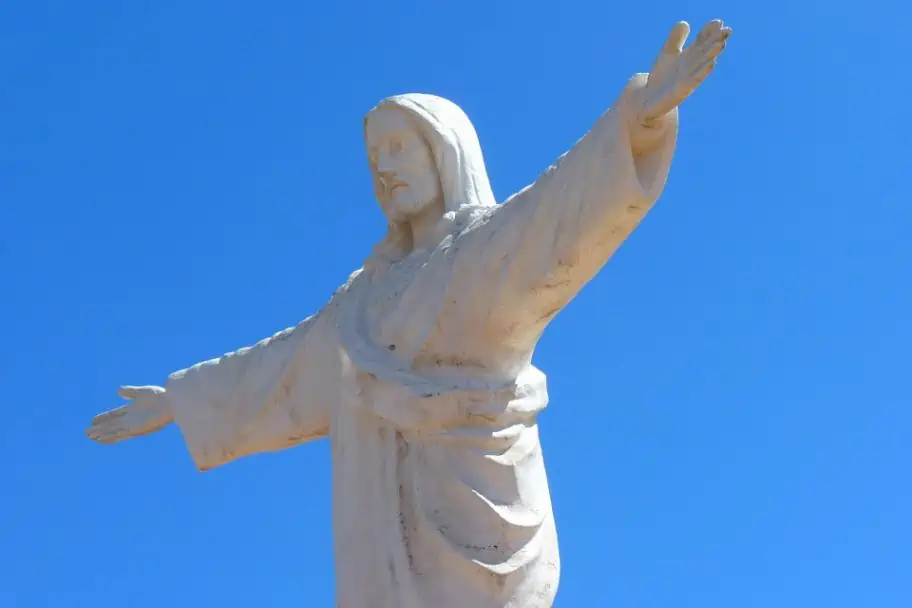
While not as large as the Christ the Redeemer statue in Rio de Janeiro, Brazil, the Cristo Blanco statue on the outskirts of Cusco is one of the more popular landmarks for tourists. Sitting at 26 feet high (roughly 8 meters), the statue can be seen from all the way down in Cusco’s historic city center. In fact, one of the best places to see the Cristo Blanco from the city of Cusco is the historic Plaza de Armas. If you would like a closer view of the statue, it is about a ten-minute walk from the Saqsaywaman ruins (see below).
Saqsaywaman
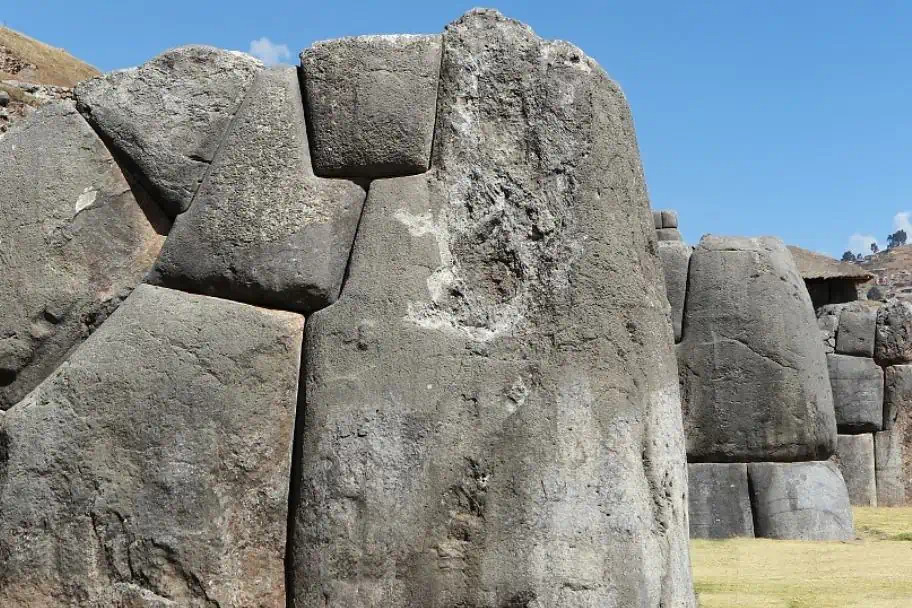
Constructed by the ancient Killke culture in roughly the year 1100, this stone complex was later added to by the Incans in the 13th Century. The stones used in the high walls of the structure were carefully moved, cut, and mortared to fit precisely with the stones around it.
Seeing the site first-hand gives you a great idea of just how much ingenuity the Incans had centuries ago. The site is remarkably well preserved, much to the thanks of being named a UNESCO World Heritage site in 1983. Machu Picchu may get all of the glory, but other ruins like Saqsaywaman throughout the Sacred Valley are definitely worth visiting as well.
Visit Machu Picchu
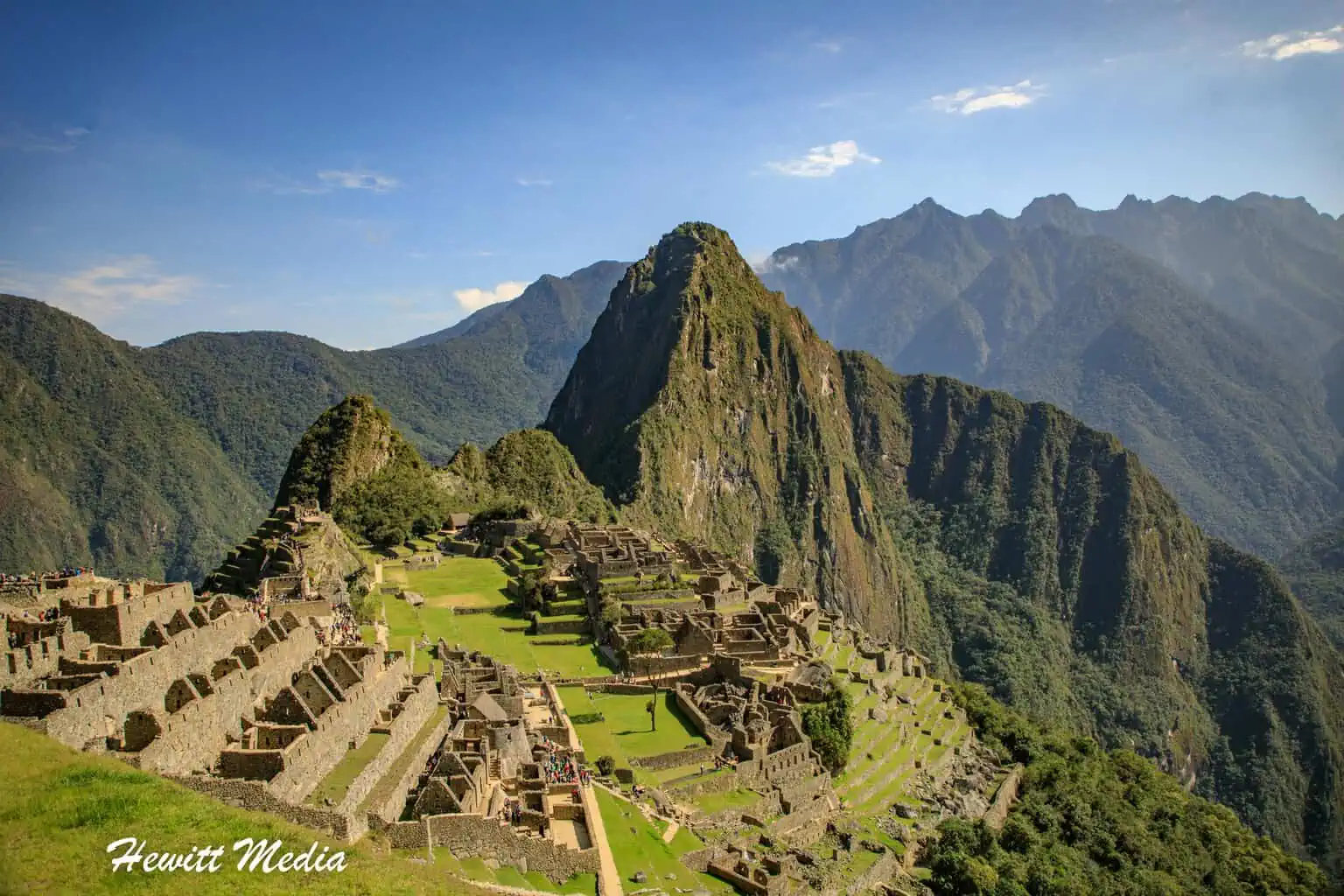
For most of you reading this guide, I am guessing the main reason you are visiting Cusco is as a launching spot for your hike of the Inca Trail and visit to Machu Picchu. As one of the new Seven Wonders of the World, Machu Picchu is without a doubt one of the top tourist destinations in all of South America, if not the entire world. If you would like more information on how to visit Machu Picchu from Cusco, I have included a link to my Ultimate Machu Picchu Visitor Guide for you to review below.
Climb Huayna Picchu

If you are looking for some added adventure during your visit to Machu Picchu, I would suggest exploring the option of climbing Huayna Picchu, which is the mountain you see behind the ruins of Machu Picchu in all of the famous photographs.
The views of the ruins and the surrounding Andes Mountains from the top of Huayna Picchu are out of this world. For more information on how to capture these amazing views and the other out-of-this-world vistas that you will see at Machu Picchu, please refer to my Machu Picchu Photography Guide linked below.
Hike the Inca Trail
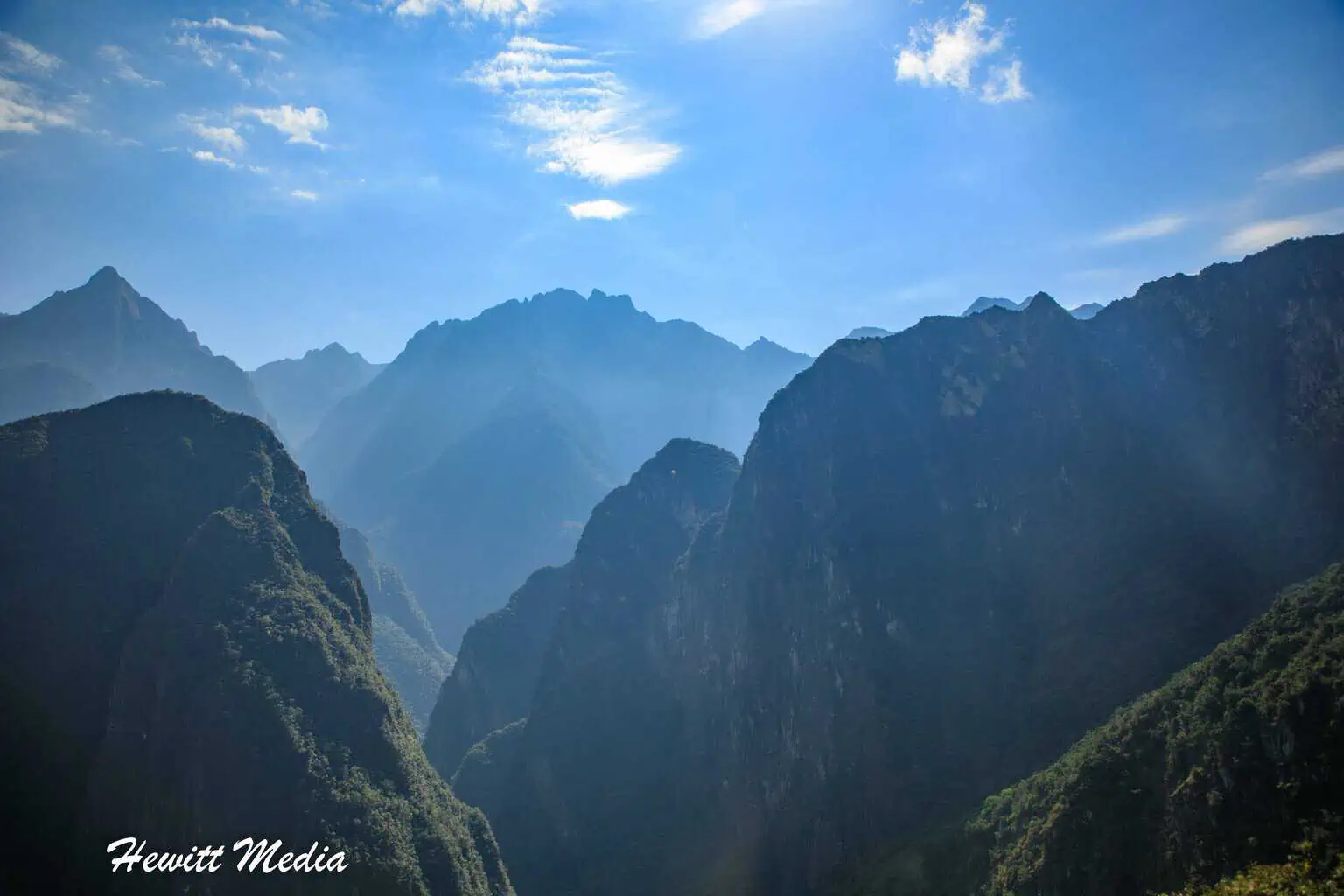
One of the ultimate adventures that you can take, not only in the Cusco area but in the entire world, is to hike the Inca Trail on your way to Machu Picchu. It is one of this world’s greatest multi-day hikes and certainly one of the world’s most beautiful as well.
If you would like to hike the Inca Trail, you will need to have a licensed guide with you by law. For this reason, and to make sure that you have the equipment and clothing that you will need for the hike, I recommend that you reference my Ultimate Guide to Hiking the Inca Trail referenced below before planning your trip.
Visit the Vinicunca Rainbow Mountain
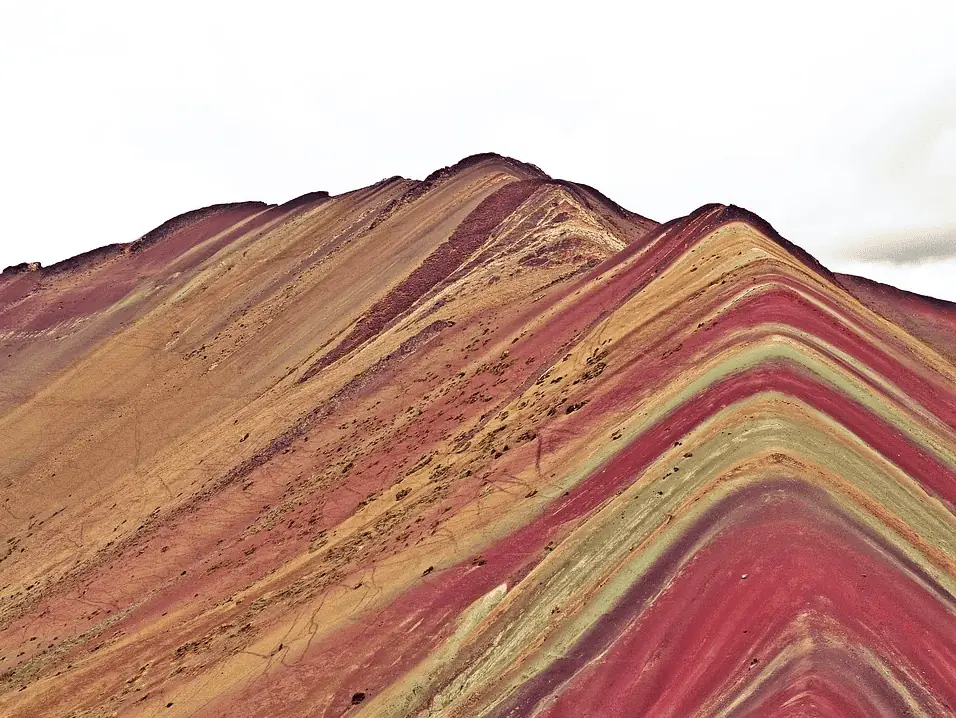
Referred to as Montaña de Siete Colores or Montaña de Colores in Spanish, Vinicuanca is a 17,000-foot (5,200 meters) peak in the Andes Mountains near Cusco that is world-famous for its multi-colored soil near the peak. Accessing the mountain requires a two-hour drive, arranged by your guide, from Cusco and then a roughly 3-mile hike.
There are few natural landscapes in this world as unique as the Rainbow Mountain, which is why it is such a popular tourist spot. if you plan to visit the mountain, I would strongly recommend that you properly plan for the altitude. I have included some tips at the beginning of this guide that should be helpful to you.
How to Get to Cusco
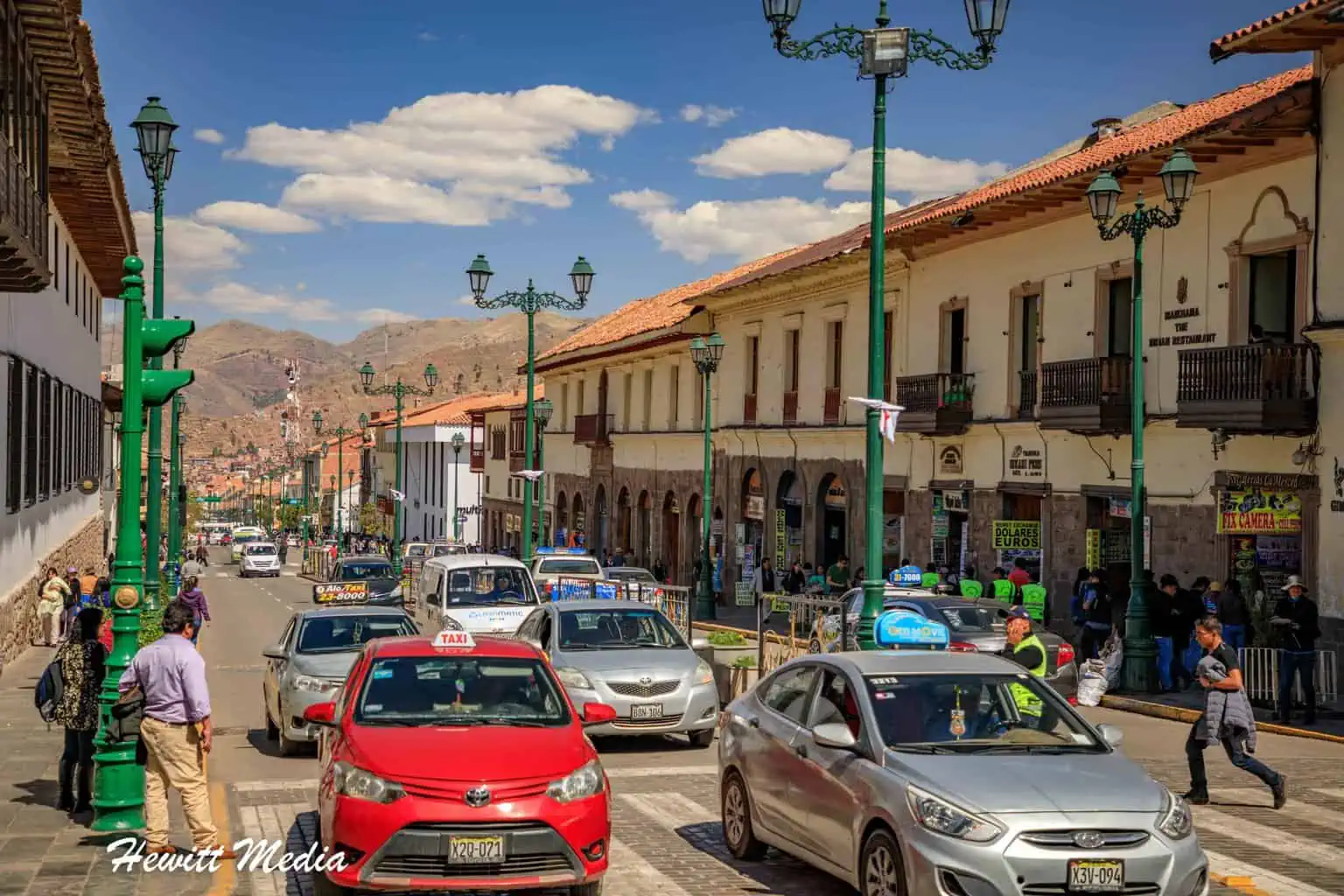
If you are visiting Cusco from outside of Peru, the quickest way to get there is to fly into the Alejandro Velasco Astete Airport (CUZ) in Cusco. If you are flying into Lima, Peru before you stop in Cusco, the quickest way to get from Lima to Cusco is by plane. It is a quick flight that will take about 1.5 hours and you can typically find some reasonable rates with local airlines like Avianca and Latin American Airlines.
Trains to Cusco
If you have some extra time to get there and are looking to save some money, there are more affordable travel options for getting from Lima to Cusco. There aren’t any trains that will take you directly between the two cities, but you can take a bus from Lima to Arequipa and then to Puno. From Puno, you can take a train to Cusco. The train ride from Puno to Cusco is beautiful, but it will take you roughly 8-9 hours to get there.

Bus Rides to Cusco
The cheapest option for getting from Lima to Cusco is to take a bus the whole way. It will take you between 18-27 hours to travel between the cities by bus, but you can also save a considerable amount of money if you have the time. Bus tickets with Cruz del Sur and Ormeño (the two most reputable bus companies) run between $25-60 USD. I have listed the two routes you have to choose from in my Cusco Peru visitor guide below, along with their advantages and disadvantages, for you to review.
Lima-Nazca-Abancay-Cusco
This is the quicker route (it takes between 18-21 hours to travel between Lima and Cusco), but it also has a reputation for being less safe.
Lima-Nazca-Arequipa-Cusco
This route is definitely longer and will take you between 24-27 hours to get from Cusco to Lima, but it has a reputation for being the much safer route. As a bonus, you can also see the infamous Nazca Lines (pictured below) on your way to Cusco.
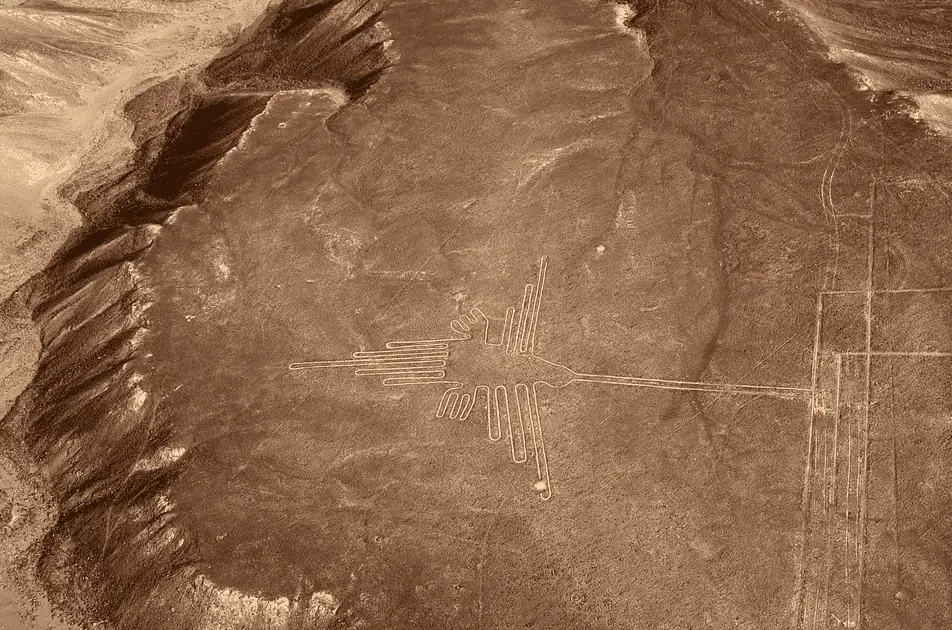
Hop on and off the bus
If you would like to do some additional exploration of Peru on your way from Lima to Cusco, you can also explore using Peru Hop , which is a hop-on-hop-off tour company that specializes in tourist stops throughout Peru. For instance, you can explore several interesting regions on your way to Cusco from Lima by taking the following route:
Lima – Paracas – Huacachina – Nazca – Arequipa – Puno – Cusco.
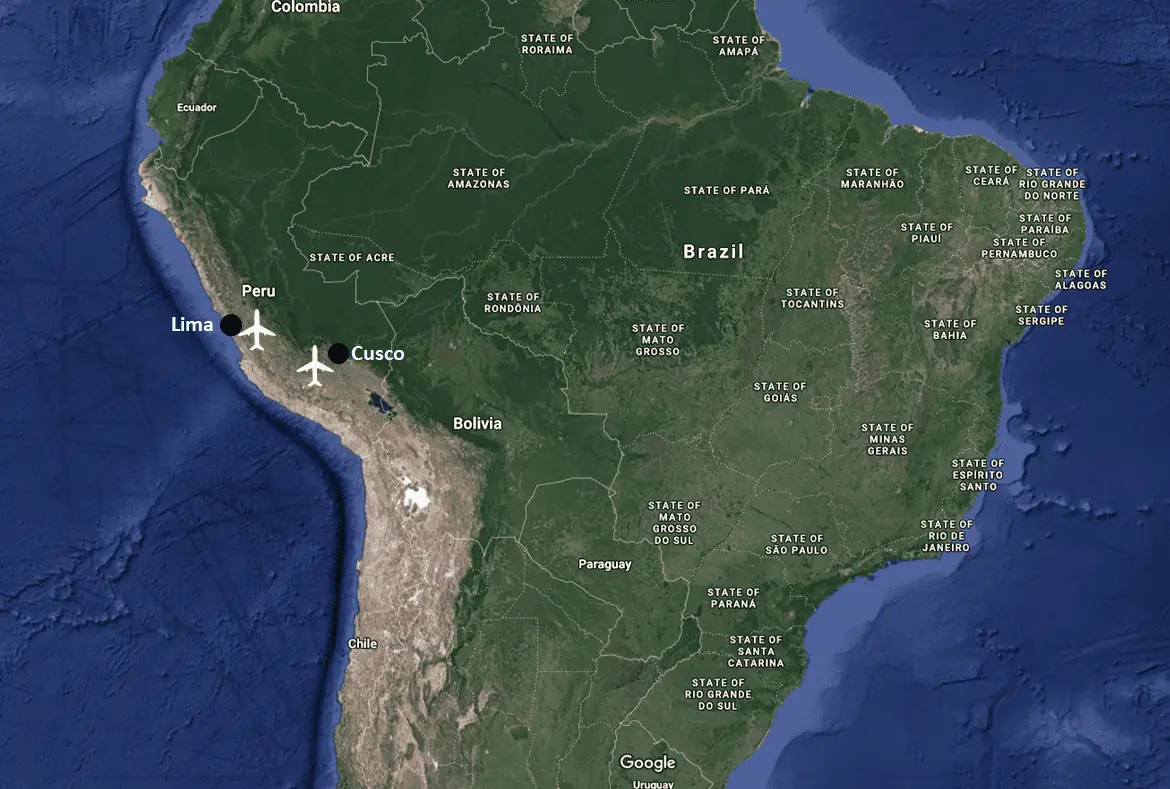
Best Times to Visit Cusco
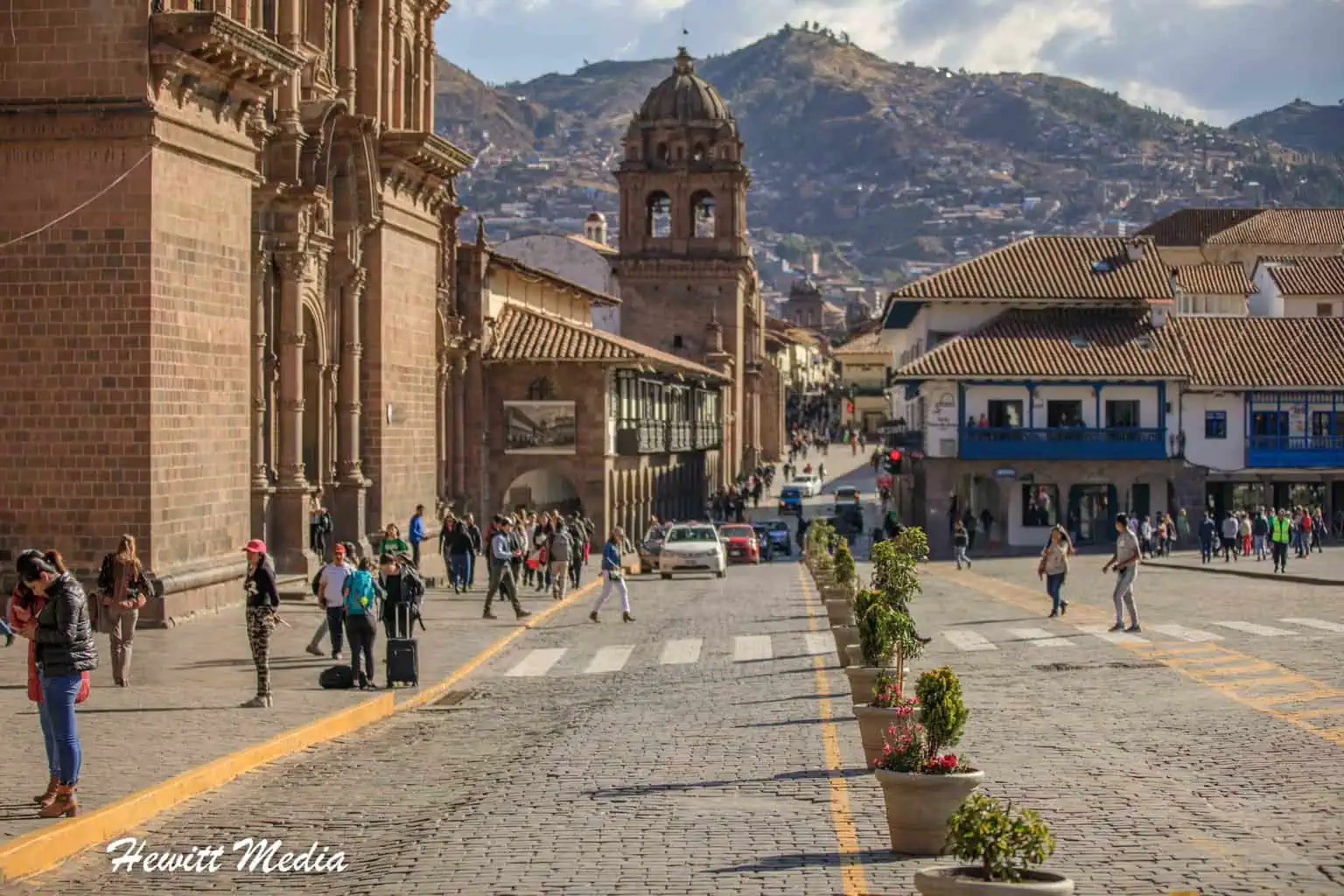
Average Temperature (°F)
As you can see in the chart below, the average high and low temperatures in the Cusco area are fairly consistent throughout the year. Because of the elevation, the average high temperature doesn’t get too hot at any point throughout the year.
Likewise, because of the area’s proximity to the Equator, the average low temperature doesn’t get too cold either, despite such a high elevation. This means that you can expect fairly comfortable temperatures no matter when you plan on visiting throughout the year.
Average Precipitation (Inches)
There are two distinct seasons in Cusco: The dry season, which runs from April to October, and the wet season, which lasts from early November until late March. The best time to visit Cusco and the surrounding area is definitely during the dry season because the skies are typically clear and the weather is dry.
During the wet season, it typically only rains a few hours during the day, but the mountains will be covered in a hazy fog for most of the day. As the day wears on the fog will dissipate, but I would avoid visiting during this time of year if you want to get really good photographs. If you must visit during the wet season, I would avoid the months of February and March as those months tend to be the wettest.
Where to Stay in Cusco
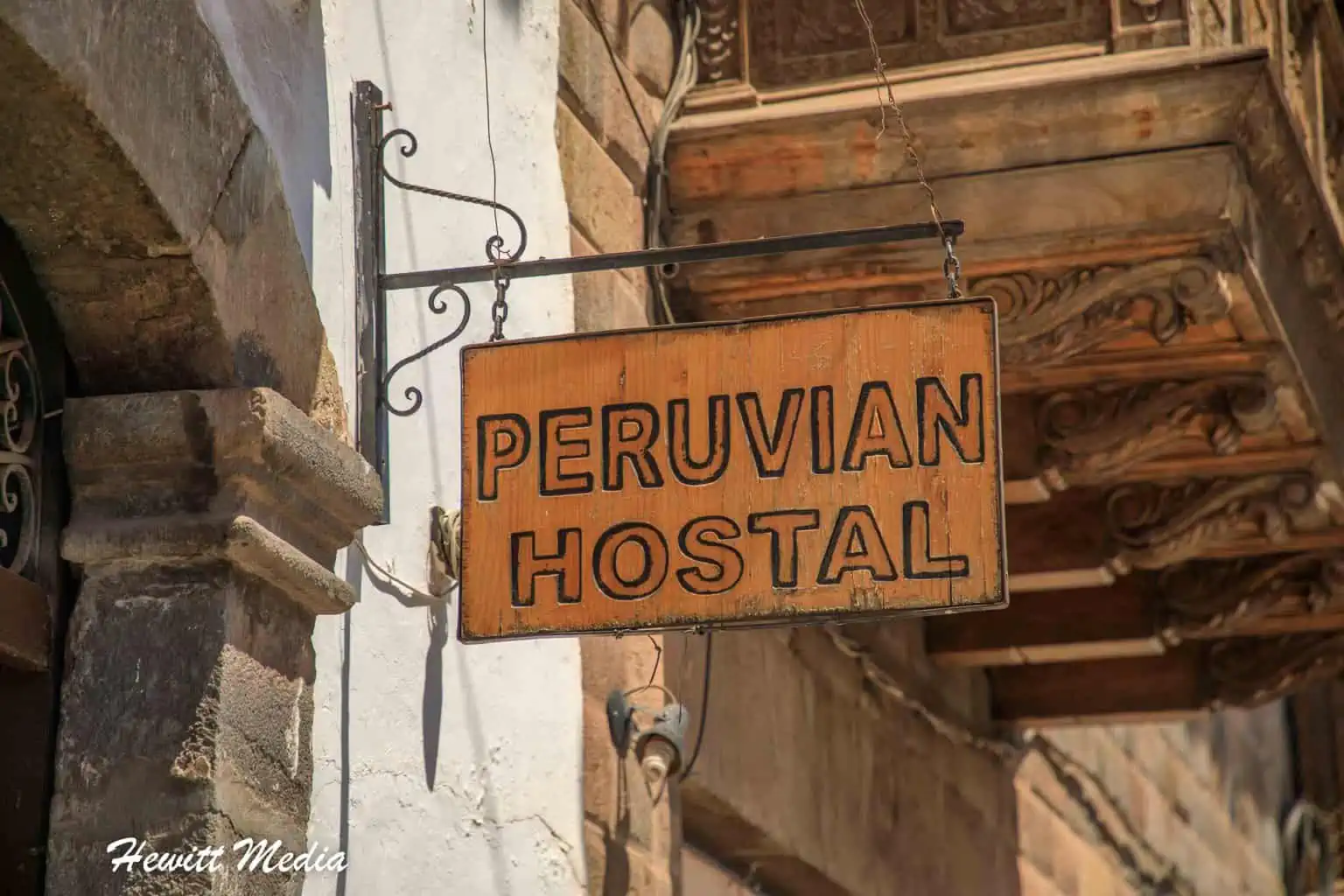
An important decision you need to make when planning your trip to Cusco is where you will stay. When you travel, the accommodations you choose are oftentimes amongst the biggest expenditures for your trip.
So, not only do you need to be comfortable, but you need to be able to afford to stay there. Finding the right accommodations for your trip involves looking at the amenities, the location, and most importantly, the price.
If you are starting to plan your trip to Cusco, you may be looking for some hotel and hostel suggestions. I included some great options at different price points in my Cusco, Peru visitor guide below. As always, don’t be afraid to expand your search to room-sharing sites such as Airbnb or VRBO if you aren’t finding a hotel or hostel that meets your needs.
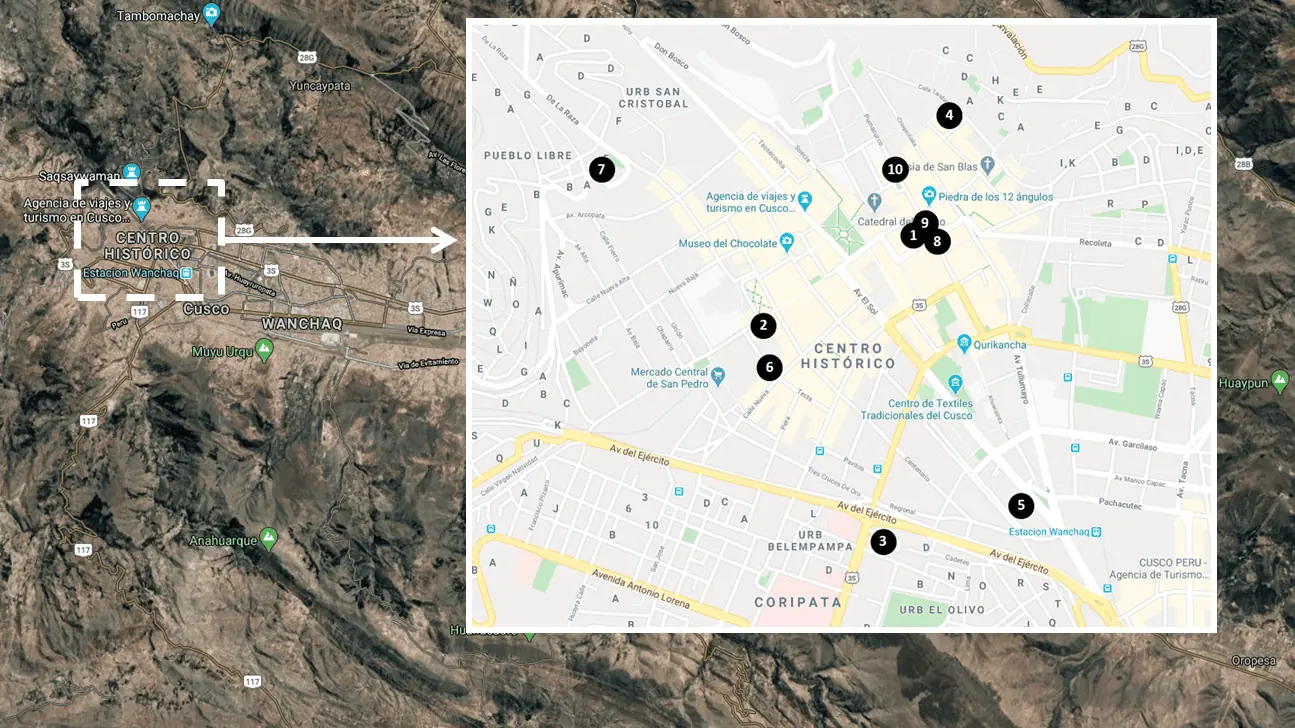
View Larger Map
Where to Eat in Cusco
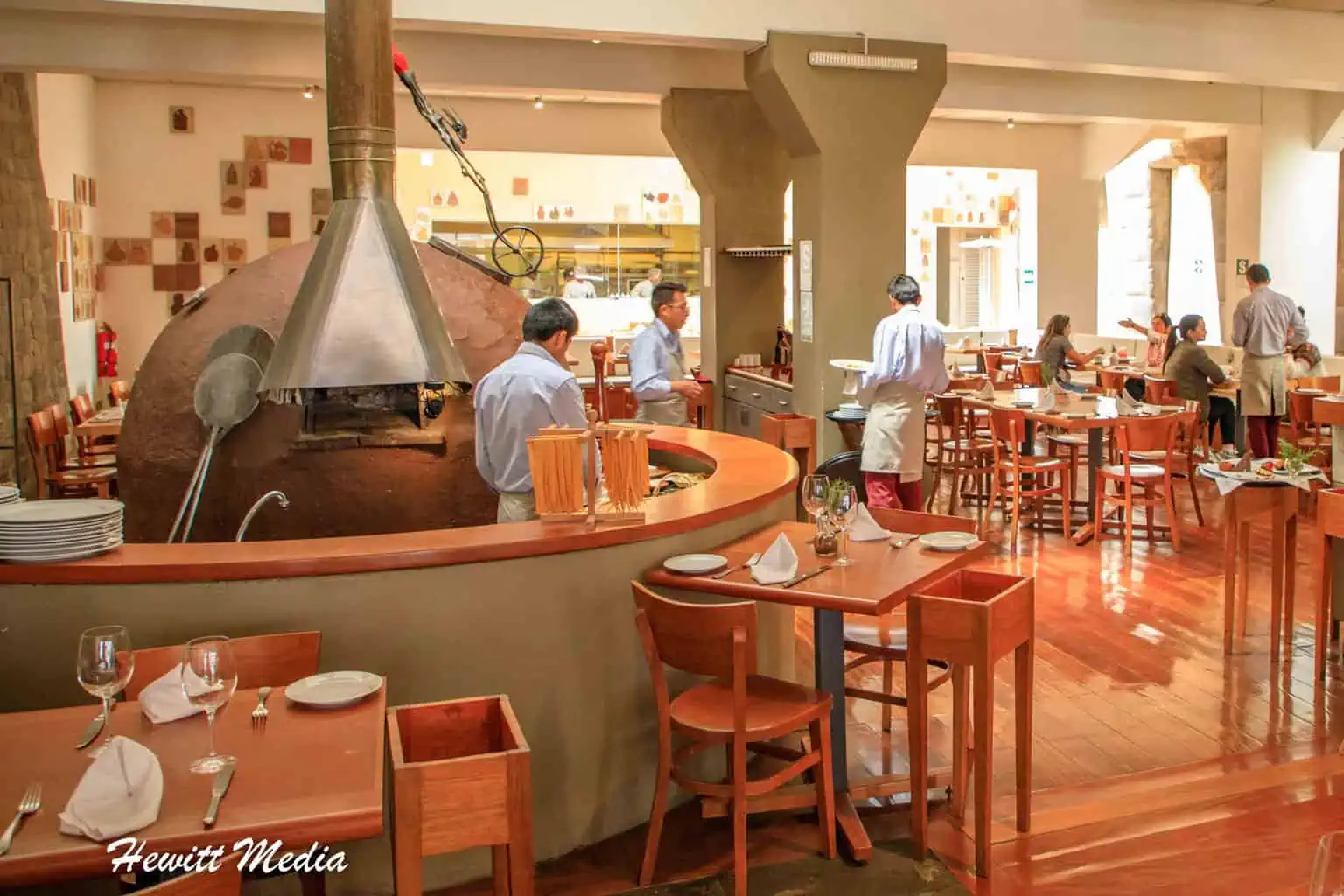
I knew the food would be good when I visited Peru, but I didn’t know just how much I would love the cuisine until I visited. There is a wide variety of restaurants in Cusco for you to try, so if you love to eat when you travel you won’t be disappointed. If you are looking for some restaurant recommendations for your trip, I have included some highly recommended options for you to review in my Cusco Peru visitor guide below.
Recommended Tours and Excursions in Cusco
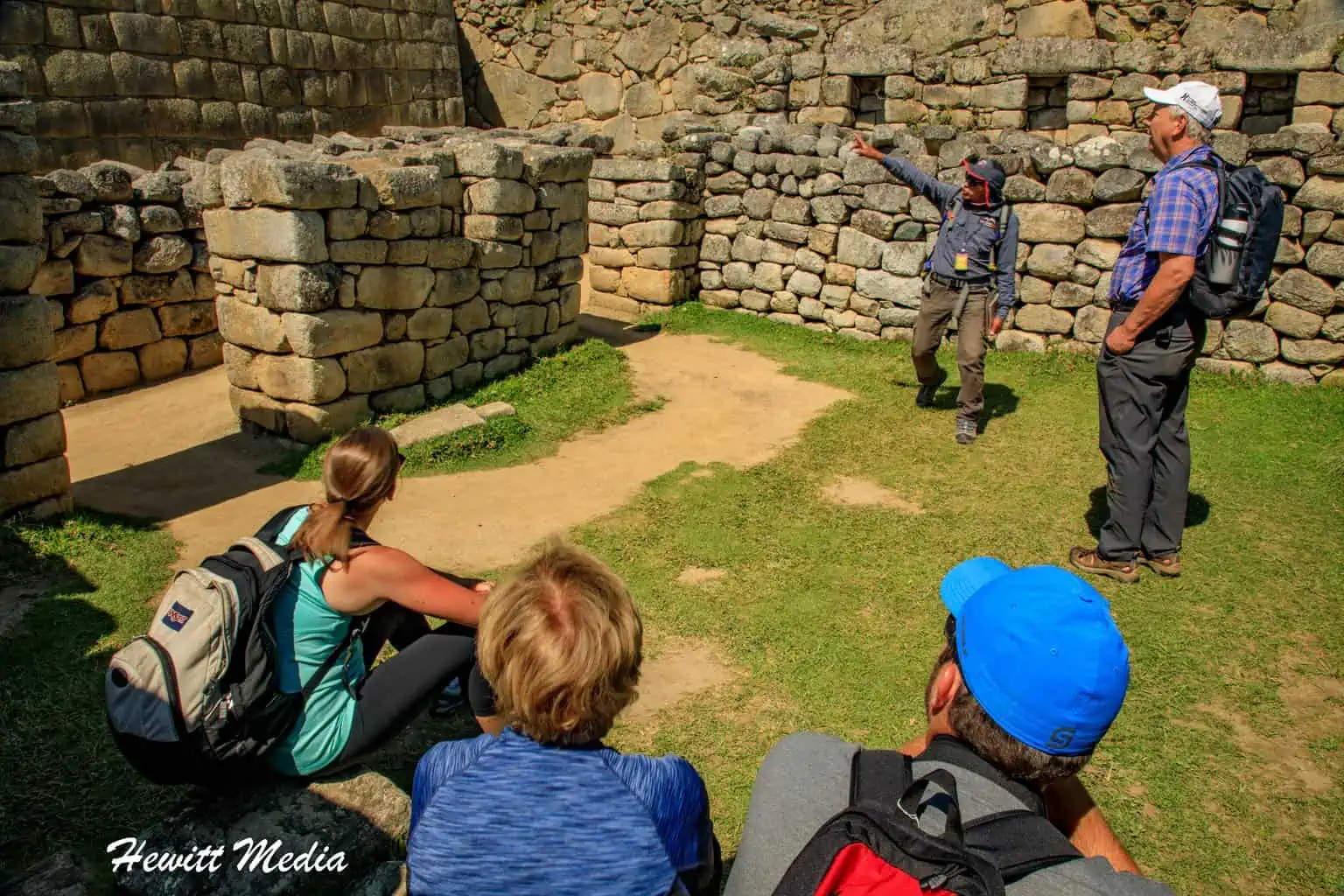
There is a seemingly endless supply of amazing things to see and do in the Cusco area, so you won’t have much trouble planning activities to keep you busy during your trip. If you are looking for some recommended excursions or tours to take while you are visiting, I have included links to some options for you to review in my Cusco Peru visitor guide below.
Cusco, Peru Photo Gallery
As an avid travel photographer, I was blown away by how beautiful the city of Cusco was. It seemed like something was amazing to photograph around every corner of the city. I have included some of the top photos I was able to take during my trip in my Cusco Peru visitor guide below.
If you would like to see more of my travel photography, I would also encourage you to give me a follow on Instagram . Putting this blog together to pass on my free guides, itineraries, and travel photography tips is a lot of work and your support in the form of a follow-on Instagram would be so very much appreciated!

Don’t Forget to Subscribe to My Adventures!
Type your email…

Let Me Help You Save On Your Next Adventure!
‘start exploring today’ merchandise available now.
Published by Josh Hewitt
Avid traveler and photographer who loves to see new places, meet new people, and experience new things. There is so much this world can teach us, we just need to explore! View all posts by Josh Hewitt
Related Articles

Planning an Epic Eastern National Parks Road Trip
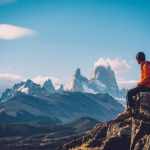
Argentina Entrance Requirements: A Guide for Travelers

How to Anticipate the Perfect Moment in Wildlife Photography
5 comments ›.
Whoa! Cusco is such an amazing place. I did a research sometime ago concerning San Pedro De Atacama, is this location in anyway close to where you stayed or visited? I’d like to know. That aside, I love how everything looks brown, most of the city seems to have a common theme and it’s very attractive!
Thank you so much for reading and for the kind words! I agree, Cusco is a beautiful place! I looked up San Pedro de Atacama and it looks wonderful.
It looks like a beautiful city with the mountains all around it. My colleague absolutely adores Peru – says it’s her favorite country she’s visited.
It is beautiful!! Definitely one of my favorites too!
Visiting Shimla and Manali in November offers stunning autumn views, pleasant weather, and fewer crowds, making it perfect for a…
[…] It’s important to pay attention to your subject’s social habits as well, including whether they hunt alone or in…
[…] https://wanderlustphotosblog.com/2024/01/24/the-20-best-travel-accessories-for-2024-an-essential-gui… […]
Thank you so much for the kind words!! 😊
Discover more from Wanderlust Travel & Photos
Subscribe now to keep reading and get access to the full archive.
Continue reading

Subscribe To My Adventures!

The ultimate Cusco travel guide: 25 amazing things to do in Cusco, Peru
Once considered the spiritual and political heart of the vast Inca empire, Cusco (meaning “centre of the universe” in Quechua) is still one of the most vibrant and historically significant cities in Latin America. Its close proximity to Machu Picchu and some of the country’s best high-altitude trekking have made this enchanting city the centrepiece of nearly every Peru itinerary and cemented its spot on the classic gringo trail , but Cusco is so much more than just a launch-pad to other adventures. It’s honestly impossible not to fall in love— with its intriguing mix of ancient Incan spiritualism, Spanish colonial architecture, and modern Andean culture, just walking down the lively, cobbled lanes of Cusco is like stepping through history.
One of the very first stops on my 3-month trip through South America in 2014, I fell hopelessly in love with Cusco and spent 2 weeks immersing myself in the sights and smells of the area, visiting local markets and just wandering through the narrow streets with no particular agenda. I had an incredible time and was dying to come back, but I spent my second visit a little differently— I wanted to uncover all of the history that I had skimmed over previously. Visiting more ruins and historically significant sites around the city to learn about the rise and fall of the Incas and the Spanish conquest ultimately gave me a much deeper appreciation for this multi-layered city. Use this complete guide to discover both the cultural and historical significance of Cusco , including all the best things to do, where to stay, how to get around, and how to deal with the altitude.
What's in this travel guide

La Catedral de Cusco
1 | Plaza de Armas
The main square of any South American city is its lifeblood, and Cusco’s impressive Plaza de Armas is no exception. Flanked by the Catedral de Cusco and the Iglesia de la Compañía de Jesús , the Plaza once functioned as the Incan main square Huacaypata (before the bloody arrival of the Spanish) and remains today a gathering place for tourists and cusqueños alike . At any time of the day, a flurry of activity fills the square with the sounds and smells of Cusco, and this is one of the very first places you should visit.
The Iglesia de la Compañía de Jesús was built by the Spanish in the late 1500s directly atop the Incan temple Amaru Cancha, as the invaders were wont to do, but is undeniably stunning and something of a Cusco icon today. It’s possible to tour the inside of the church and see the ornate gold-leaf detailing around the altar, but the view from the steps of the Catedral de Cusco is enough for most .

Rooftop cocktails at Limbus Restobar
2 | Drink pisco sours at a rooftop bar
Pisco Sour, the national drink of Peru and one of the country’s greatest inventions, is a sweet and tangy concoction served at every restaurant and bar in Cusco. It would be criminal to visit without trying at least one, but the very best way to enjoy your new favourite drink is from a terrace or rooftop bar overlooking the city.
Tip: Limbus Restobar is one of the most popular rooftop bars in Cusco, but it can get really busy around sunset. If you want to enjoy the view without the crowds, go mid-morning when you’ll have the place entirely to yourself.

Where to stay in Cusco
Unlike other cities in South America where you can just arrive and find somewhere to stay on the fly, it’s a good idea to book your room in Cusco online , as the best places tend to fill up quickly. Millions of people visit Cusco every year, with a particularly large influx during the austral winter, so you’re more likely to snatch a good room at a decent price if you plan ahead.
The very best areas to stay in Cusco are either San Blas or the Centro Histórico . San Blas is a trendy, artsy neighborhood on the hills of Cusco, still within walking distance of the Plaza de Armas but also located near some of the best artisan markets, coffee shops, and Sacsahuamán. Expect accommodation here to be slightly more expensive, but the views and atmosphere are surely worth the price. The Centro Histórico is also a wonderful place to stay, perfectly located for access to any of Cusco’s main attractions and with a wide variety of hotels, hostels, and Airbnbs on offer. I would suggest looking for a hostel near either the Plaza de Armas or Koricancha, as these areas are super central.
- Kokopelli: My absolute favourite hostel in Cusco is Kokopelli , which is slightly more expensive than other dorm rooms, but worth every sol . They offer pod-style dorm beds (S/50) that make it feel like you’re in a private room, a great free breakfast (or free packed lunch if you’re departing on an early morning tour), on-site tour booking, and a lively bar and restaurant with surprisingly reasonable prices.
- Loft in Cusco: If you’re travelling with friends or family, another highly recommended option is this awesome Airbnb near Koricancha . There are 2 levels with multiple beds, a full kitchen, and lots of space to hang out. Plus, it’s super reasonably priced!
Where to eat in Cusco
- Organika: Without a doubt one of the best restaurants I’ve eaten at ever , this organic farm-to-table Peruvian fusion restaurant serves food grown in the Sacred Valley. I’d highly recommend the alpaca steak and the mint lemonade, but honestly, I tried my friend’s meals too and it was all incredible.
- Rucula: One of Organika’s sister restaurants, this is an Italian-inspired restaurant with homemade pasta, pizza, and meat dishes.
- The Meeting Place: Charming cafe in San Blas serving huge plates of breakfast food, like drool-worthy waffles.
- San Pedro Markets: Eat like the locals at the Markets, where you can get a delicious, authentic meal from one of the stalls at the back for just a few soles .
- Restaurante Qori Sara: For an incredibly inexpensive Peruvian meal, try the S/10 menu del día at this local restaurant on Plaza San Francisco. It’s nothing mind-blowing, but for the price, it’s still bloody good.
- Antojitos Cusco: Authentic but inexpensive Peruvian food off the menu del día.
- Churro stand near Plaza Limacpampa: There are street vendors all over the city selling incredible churros (slightly different to the Mexican variety you might be imagining), but this seems to be a pretty consistent spot to find them.

Dealing with the altitude
Considering that altitude begins to affect our bodies at 2,500m and Cusco sits at 3,400m, there is a very real possibility that you will experience some symptoms associated with the altitude while exploring the former Incan capital. In most cases, your physiological response to the altitude won’t amount to anything more than some shortness of breath walking up stairs and minor lightheadedness — basically, you’ll just feel really unfit for a few days after you arrive in Cusco .
However, some people might suffer from altitude sickness (Acute Mountain Sickness) and experience symptoms like headache, feelings of dizziness or nauseous, difficulty eating, exhaustion, and diarrhoea/vomiting . According to recent research, only about 17% of travellers to Cusco will experience true altitude sickness, but you should still know how to recognise AMS early and take appropriate preventative/treatment steps just in case .
I wrote an extremely comprehensive post about dealing with altitude sickness in South American cities , plus another far more in-depth post about treating and preventing altitude sickness on high altitude treks , so please check out one or both of these posts for more information and heaps of useful tips to prevent altitude sickness from ruining your trip.
- A PRACTICAL GUIDE TO ALTITUDE SICKNESS IN SOUTH AMERICA
- HIGH-ALTITUDE TREKKING: A COMPLETE GUIDE TO PREVENTING & TREATING ALTITUDE SICKNESS IN THE MOUNTAINS
Travel tips
- Get a SIM card when you arrive in Peru, as this well enable you to use Google Maps and Uber to get around in Cusco. Claro and Movistar are the main providers, but Bitel also offers good packages specifically for travellers: get 20GB of data, 500min calling, and international call credit for S/49.
- Avoid pulling money out of any GlobalNet ATM (these are located in the airport and scattered throughout the city), as they charge a much higher fee than other ATMs.
- Even as a solo female traveller, I felt totally safe carrying my camera and handbag around in Cusco at all hours of the day and night . As long as you take basic safety precautions, you’ll be right (so leave the weird nude-coloured money belt at home).
- As with all places in Peru, a basic knowledge of Spanish is pretty much essential for visiting Cusco . At minimum, make sure you know how to check-in to a hostel, order food, ask for directions, and buy bus tickets in Spanish, because it’s pretty rare for anyone to speak English outside of tour companies. That being said, Peruvian people are amazingly friendly and truly want to help, so they will go out of their way to understand you even if your Spanish is somewhat clumsy and you can’t remember the exact word for something.
- Use the RedBus website to check public bus times and book tickets online or have a look at my comparison of public buses and the new hop-on/hop-off service Peru Hop to find out which is better for your trip.

Read more about Peru
WHAT TO DO IN LIMA: 10 AWESOME ACTIVITIES IN THE PERUVIAN CAPITAL
A COMPLETE TRAVEL GUIDE TO PARACAS, PERU: ISLAS BALLESTAS, PARACAS NATURE RESERVE & MORE
8 AWESOME THINGS TO DO IN HUACACHINA, PERU
ABSOLUTELY EVERYTHING YOU NEED TO KNOW ABOUT VISITING MACHU PICCHU (& NEW 2019 REGULATIONS)
THE ULTIMATE GUIDE TO INDEPENDENT & SOLO HIKING THE HUAYHUASH CIRCUIT IN PERU
PACIFIC COAST PERU: 2-3 WEEK PERU TRAVEL ITINERARY FROM LIMA TO CUSCO
INCAS & THE AMAZON: 2-3 WEEK PERU TRAVEL ITINERARY FROM LIMA TO MANU NATIONAL PARK
BEST OF THE PERUVIAN ANDES: 3-4 WEEK PERU TREKKING ITINERARY
12 BEST DAY HIKES AND MULTI-DAY TREKS IN PERU
THE ULTIMATE PERU TRAVEL GUIDE
brooke brisbine
I've spent the last decade exploring the world— everything from solo trekking in the Andes to overlanding in Zambia, all while completing a PhD in Biomechanics, teaching at a university & securing permanent residency in Australia. In 2020, I finally fulfilled my dream of becoming a full-time nomad! Whether it’s vanlife in Mexico, scuba diving in the Galápagos, ticking off incredible US National Parks, or climbing in the Dolomites, I hope this blog will inspire your future adventures & help you find wonder in every corner of the globe. xx bb
Leave a Comment Cancel Comment
You may also like, island of the sun: exploring lake titicaca’s isla del sol, what to do in guatapé: the best day trip from medellín, colombia, pacific coast peru: 2-3 week peru travel itinerary from lima to cusco.

An insider’s guide to visiting Cusco, Peru
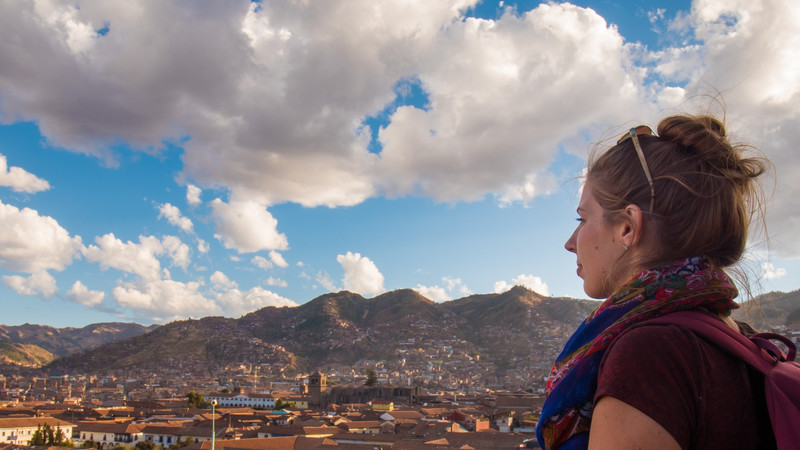
If you’re anything like most travelers to Peru, you’ll have a few days to wander the hilly, cobble-stoned streets of Cusco.
Likely, it’s penciled in between visits to Machu Picchu, Lima, the Amazon or the Sacred Valley. However, Cusco, with its unique architecture from past and present and its fascinating culture and history, as seen through the textiles, festivals, and rituals, is worth getting to know. And it doesn’t have to be at the expense of any of the above. You can know the real Cusco in just one day, if you know where to look.
Having lived in Cusco for more than a year and a half, I’ve come to discover some of the city’s local gems, places that will deliver you straight into the beating heart of Cusco’s incredible local culture, no matter how long (or how short) you have in the city.
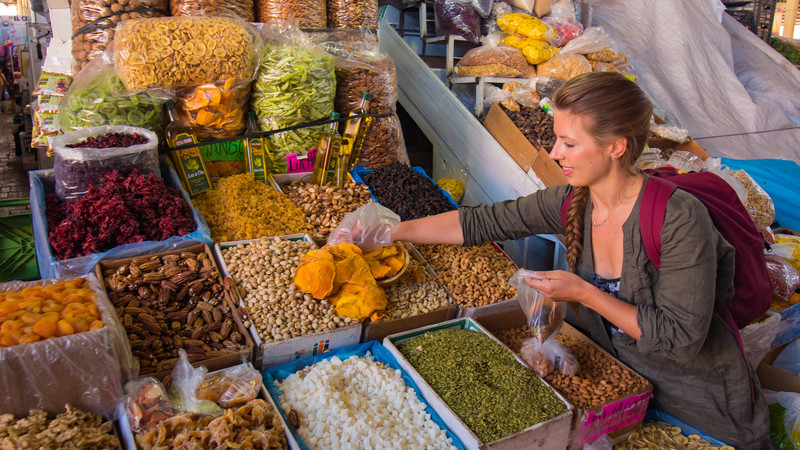
San Pedro Market
Consider this your quick guide to experiencing the real Cusco, your window into local life amidst and despite the chaos of the well-worn tourist circuit. And, because I know stepping into the world of a new culture can often be intimidating without the personal invitation of a local, each of the following tips and recommendations are located within the comfortable boundaries of any Cusco tourist map. You’re welcome.
Tip #1: Go where the locals go
When I need a break from the crowds and tourists (and you will), there are a few local oases I can always count on.
Super Café Extra
A remnant of the Cusco that existed before Machu Picchu stepped onto the global scene, Super Café Extra attracts locals from every corner of the city and countryside. Its reverence for tradition within the whirlwind of a changing Cusco is what endears it to the locals. A friend introduced me to this special spot early on and it has quickly become my go-to for a good cup of coffee and a lengua de suegra (a local Cusco pastry).
The café is located on Calle Espaderos between the Plaza de Armas and Plaza Regocijo.
LOOKING FOR A LOCAL-LED DAY TOUR IN CUSCO? CHECK OUT OUR SISTER COMPANY, URBAN ADVENTURES
Qenko Chico
You won’t need a tourist ticket to access these unique Inca ruins located at the crest of one of Cusco’s surrounding hills. However, this site isn’t about the Inca-worked boulders at Qenko Chico for me. This is a spot, adjacent to the better-known Qenko ruins, where you can find locals picnicking beneath the canopy of Eucalyptus trees and taking in the spectacular view of the Cusco valley below. Qenko Chico feels like a secret that only the locals have caught on to.
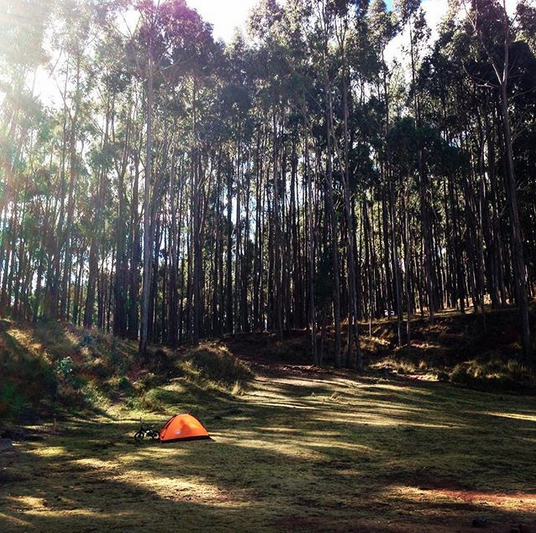
The site is located just a five minute walk from El Christo Blanco and a few minutes away from the gates of the Qenko ruins.
SUBSCRIBE TO INTREPID’S NEWSLETTER FOR TRAVEL INSPO, COMPETITIONS, GIVEAWAYS & MORE
Cusco is no stranger to a cold night, especially during the dry season. One of the ways locals cope is with te piteado , a hot herbal tea spiked with pisco and anise-flavored liqor. El Duende serves up some of the best in town by the pitcher. Grab a seat in its dark fairy tale-inspired interior and order a Te Macho, the house specialty. Between the cozy atmosphere, warm drinks, and lively local patrons, you won’t want to leave.
Find El Duende one block from the Plaza de Armas on Calle Tecsecocha.
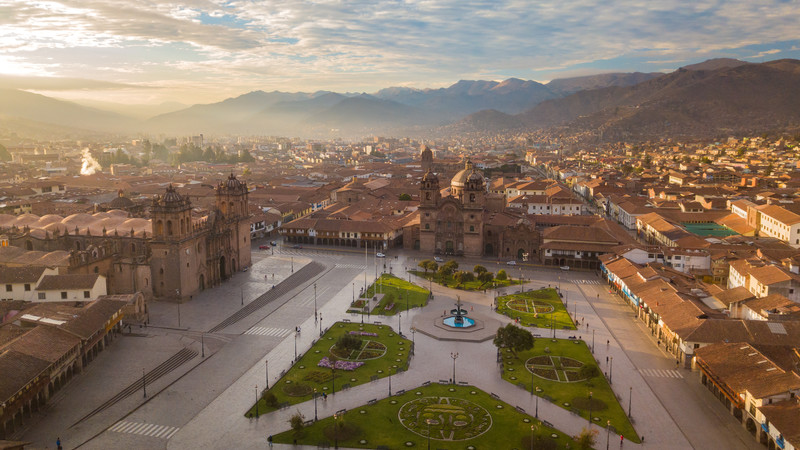
Plaza De Armas
Tip #2: Eat where the locals eat
There is plenty of fine dining in Cusco, but for a truly local culinary experience you’ll need to venture beyond the TripAdvisor-reviewed restaurants. (Not sure how? If you’re a foodie and interested in Peru you should check out our 10-day Real Food Adventure trip !)
Mercado San Blas
When I first visited Cusco, Mercado San Blas hardly crossed my radar. It wasn’t until I moved down the street from it that I discovered its unique local draw. The market is much less chaotic (and much cleaner) than its larger equivalent, Mercado San Pedro.
Locals gather daily for breakfast and lunch, grabbing a seat at whatever food stall is serving up their 5 soles (about US$1.50) meal of choice for the day.
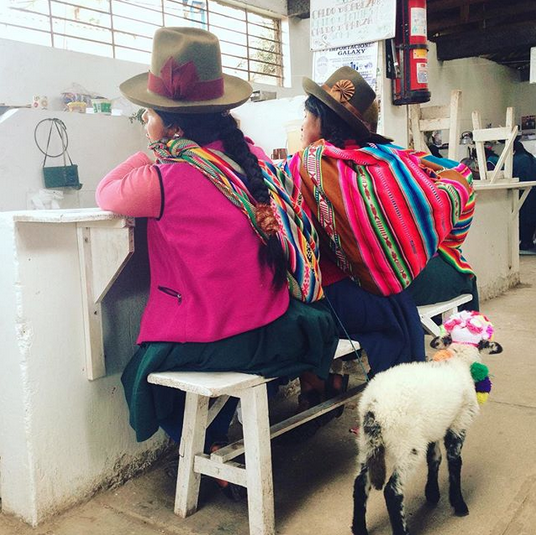
The daily menu is listed on chalkboards and typically includes a soup, entrée, and refresco (usually tea or the local purple corn drink called chicha morada). There’s also a row of juice stalls where you can design your own fresh fruit or vegetable juice. If headed there for lunch, go between 12pm and 2pm to experience the market at its busiest and to have the best selection of dishes.
Mercado San Blas is located at the corner of Lucrepata and Pumapaccha and just one block from the Plaza San Blas.
Foodie tips from Gary Cohen, Intrepid’s General Manager for South America:
In Cusco, some of my favorites restaurants include Bodega 138 for great Italian food with a Peruvian twist, and Cicciolina for something a little more gourmet. Baco has one of the best lomo saltados (Peruvian stir fries) in Peru and Uchu has amazing alpaca steaks and desserts.
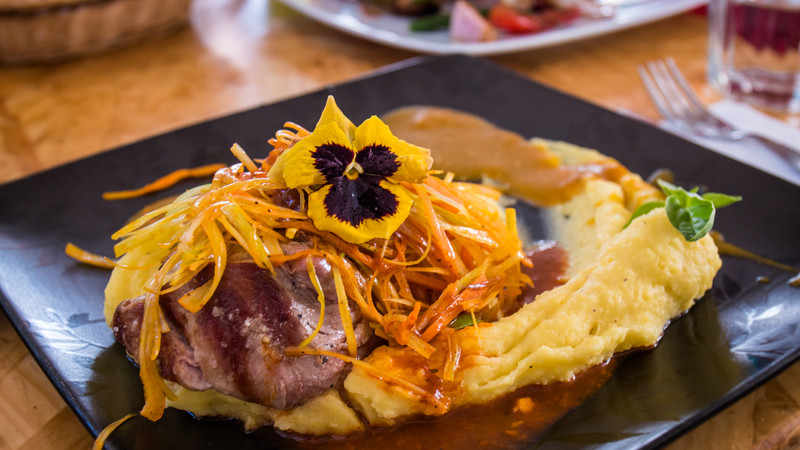
Alpaca in Cusco
If you happen to be in Cusco on a Sunday, make your way to the Plaza San Francisco for a festival of local dishes, music, and games. Bursting with locals, the weekly food feria , as it is locally known, is a chance to brush shoulders with local families and taste a variety of local dishes in one place. Sample everything from chicharon to ceviche to papa rellena and a syrupy sweet local dessert called picarones .
The Food Feria takes place from 10am to 3pm every Sunday on the steps of the Colegio Nacional de Ciencias at the edge of the Plaza San Francisco.
RELATED: A GUIDE TO PERU’S TASTIEST STREET FOOD
Tip #3: Do what the locals do
Dance the night away at ukukus.
Ukukus is a local bar located just off the Plaza de Armas on Calle Plateros. They have live music every night, including everything from Andean tribal music to rock, reggae, and latino music. The bar was started as a way to pay homage to the Andean culture and that it delivers and then some.
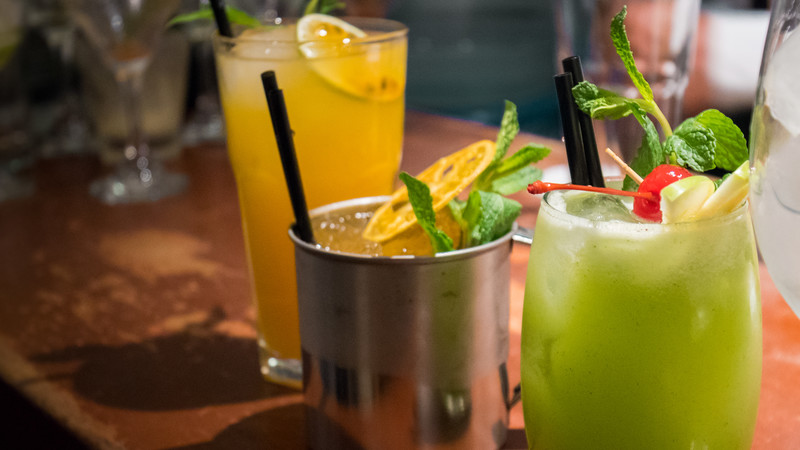
Delicious drinks in Cusco
The locals, and a few lucky tourists who know about it, start arriving around 10:30pm for happy hour and to get in ahead of the 20 soles cover charge that begins at 11pm. Think of Ukukus as your musical gateway into local culture. Definitely make your way to this bar at least once.
Nightlife tips from Gary Cohen, Intrepid’s General Manager for South America:
If you’re looking for great bars, head to Los Perros, La Calle del Medio or Museo del Pisco (it has live music some nights!). Nuevo Mundo is also great for craft beers.
Attend mass at the Cusco Cathedral
You don’t have to be Catholic to appreciate this local ritual. The population of Cusco, and Peru in general, is heavily Catholic. This means that mass in the Cusco Cathedral (also known as the Cathedral of Santo Domingo) is both an opportunity to immerse yourself in a local ritual born out of a colonial past and to see a magnificent historical structure come to life.
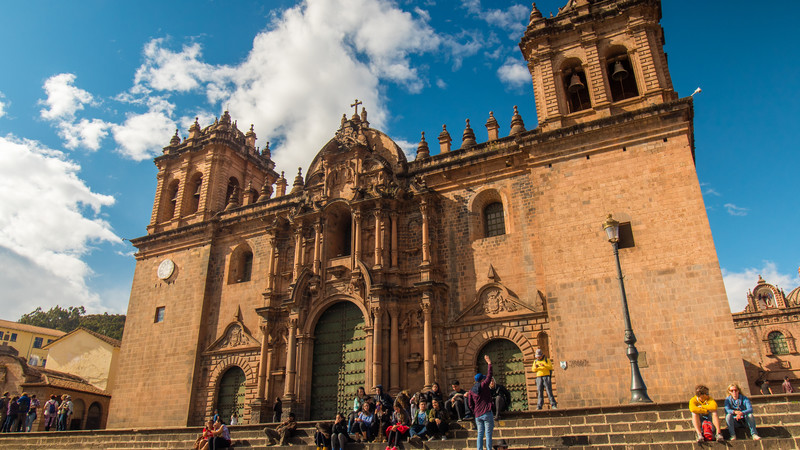
Cusco Cathedral
The Cusco Cathedral is Cusco’s oldest church, housing some of Peru’s greatest collections of colonial art from the famous Cuzco School of Art. Masses are held between 6am and 10am daily. La Cathedral is located in the Plaza de Armas of Cusco adjacent to the Church of the Society of Jesus.
RELATED: 10 FACTS YOU PROBABLY DON’T KNOW ABOUT PERU
Picnic near Sacsayhuaman
On a sunny weekend head up to the grassy fields behind the ruins of Sacasayhuaman and join the picnicking locals and families. Between the months of May and August (the dry season), you’ll find locals gathered around strange-looking earthen mounds, called huatias . A huatia is essentially a natural oven constructed with packed dirt and hot stones used to cook freshly harvested potatoes, sweet potatoes, and beans. The final plate is finished off with cheese and a spicy pepper sauce. If you dare, ask for a taste.
The wonderful thing about Cusco is how welcoming the locals are with visitors and how willing they are to share their culture with you.
Fancy paying this spectacular city a visit? Check out Intrepid’s range of small group adventures in Peru.
(Image credits from top to bottom: Intrepid Travel, Intrepid Travel, Amber Dunlap, Intrepid Travel, Amber Dunlap, Intrepid Travel, Intrepid Travel, Intrepid Travel)
Feeling inspired?
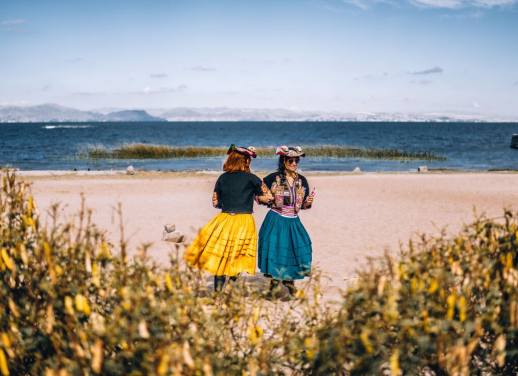
Amber Dunlap
Amber Dunlap is a digital nomad currently parked in South America, originally from Colorado USA. Between writing in coffee shops (or wherever the wifi proves functional), she’s happiest exploring new places, especially through the local cuisine. She’s traveled to 16 countries already and has no plans of stopping anytime soon. Follow her nomad lifestyle and adventures on Instagram @amber_dun.
You might also like
Tips and hacks for train travel in europe, why train travel is the one experience you..., everything you need to know about a night..., mind your manners: dining etiquette around the world, 5 places to escape the crowds in italy..., is australia safe everything you need to know, 10 fun facts you might not know about..., exploring the world through tea, 12 facts you probably don’t know about guatemala, the 7 best places to go on a..., 5 reasons to visit sri lanka in the....
Cusco Travel Guide

Why Go To Cusco
Cusco, known as the archaeological capital of the Americas, is home to a storied history that included the rise and fall of the Inca Empire followed by the invasion of Spanish conquistadors in the early 1500s. Today, remnants of both eras share the narrow city streets – from centuries-old baroque cathedrals to exquisite stone masonry – creating a rare collision of Andean and Spanish styles that makes Cusco like no other place on earth.
The city has come out of the shadow of Peru’s capital, Lima , in recent decades. Millions of tourists make the pilgrimage from Cusco and the Sacred Valley to get a glimpse of South America's greatest spectacle: Machu Picchu . Discovered by American explorer Hiram Bingham in the early 20th century, the fabled ruins are one of the most impressive architectural feats of the ancient world. If you're planning a visit to Machu Picchu while in Cusco, make the most of your time with these tips . But don't let this UNESCO World Heritage Site be the only thing you see while in Cusco. This enchanting city offers more: from the glimmering Qorikancha (Temple of the Sun) to the scrumptious Andean cuisine. It only takes a day to be charmed by this significant Peruvian city and all its wonders.
Find Flight and Hotel Deals
Navigate forward to interact with the calendar and select a date. Press the question mark key to get the keyboard shortcuts for changing dates.
Navigate backward to interact with the calendar and select a date. Press the question mark key to get the keyboard shortcuts for changing dates.
- # 1 in Best Cheap Vacations in Central and South America
- # 6 in Best Places to Visit in May 2024
Best of Cusco
Best hotels in cusco.
- in Palacio del Inka, A Luxury Collection Hotel, Cusco
- in Belmond Hotel Monasterio
- in Casa Cartagena

Best Things to Do in Cusco
- # 1 in Plaza de Armas
- # 2 in Machu Picchu
- # 3 in La Catedral

Popular Tours

Machu Picchu Day Trip from Cusco
(1325 reviews)
from $ 349.00

2-Day Tour: Sacred Valley and Machu Picchu by Train
(890 reviews)
from $ 479.00

Full Day Tour to Machu Picchu from Cusco
(357 reviews)
from $ 332.50
Cusco Travel Tips
Best months to visit.
The best time to visit Cusco is from June to mid-September. Though temperatures hover in the mid- to upper 60s throughout the year, the city sees fewer rain showers during its winter months. Still, this is peak tourist season, so expect plenty of fellow trekkers beside you as marvel at iconic sites. To escape swells of tourists and high room rates, visit during May or between late September and early November. Avoid visiting between late November and April, when heavy downpours delay and dampen exploration. Whenever you decide to plan your trip, bring warm clothing to arm yourself from the chilly nighttime temperatures, which dip into the low 30s and 40s.
Weather in Cusco
Data sourced from the National Climatic Data Center
What You Need to Know
- Acclimate with coca tea Surpassing 11,000 feet, Cusco's steep elevation takes some getting used to. Combat altitude sickness with mate de coca , a local herbal tea served at most hotels and restaurants.
- Watch your step While it's tempting to walk along the walls of ancient ruins, keep in mind that the stones have loosened over the last several hundred years. Your balancing act could damage their well-crafted masonry – not to mention your own body.
- Rely on bottled water Tap water here is not safe to drink. Instead, quench your thirst with bottled water.
- Plan ahead If you're hoping to see Machu Picchu while in Cusco, reserve your ticket several months to a year in advance. For more information on getting to Machu Picchu, tours and tips for visiting , check out our guide.
How to Save Money in Cusco
- Purchase a Boleto Turístico This pass grants access to 16 attractions in Cusco, some of which only accept this ticket in lieu of an entrance fee. A Boleto Turístico costs 130 Soles (roughly $40); however, there is also the option of buying boleto parcial (partial ticket), which allows access to fewer sites for half the cost.
- Rely on your own two feet The best way to take in this city is on foot, which so happens to be the most affordable way to get around .
- Arrive in spring You'll find much better hotel rates between late September and November, after the popular winter months.
Culture & Customs
In A.D. 1200, Cusco (known as the "navel of the world") served as the epicenter of the Inca Empire and anchored a vast political and military network that extended to Ecuador, Bolivia and Chile. After Spanish conquistador Francisco Pizarro seized the city in 1533, the Spanish established a new fortress, utilizing the Incan foundations. Today, the city showcases a rich infusion of Inca and Spanish heritage.
Now home to about 350,000 people, Cusco's culture is best seen during its lively outdoor festivals like the Festival of the Sun when thousands of revelers gather to celebrate fiestas and dance to pre-Columbian music. The majority of Cusco's population identifies as Roman Catholic, however, a variety of other religions are practiced and very few residents identify as atheist or agnostic. Catholic saint days, Andean ceremonies and Incan festivities are observed throughout the year.
Dress is generally casual in Cusco, but those planning to visit the Inca ruins should remember to bring waterproof clothing, sturdy hiking shoes and warm layers as the high altitude ushers in cooler temperatures at night. Keep in mind that Cusco's streets are cobbled, so you'll want to bring comfortable walking shoes for exploring the city by day and participating in the lively night scene after dark. Also, as you're wandering Cusco, remember to keep your wits about you. Petty thieves frequent Plaza de Armas , and pickpocketing happens to unsuspecting tourists.
The official language of Peru is Spanish, but you'll hear a mingling of Spanish, Aymara and Quechua (the official language of the Inca Empire). Cusco Quechua is its own distinct dialect, which varies greatly from Quechua spoken in other regions in Peru. English-speakers can be hard to find, so come prepared with a basic book of key Spanish phrases and plenty of patience.
The Peruvian Sol (PEN) is the official currency of Peru, which has a very favorable exchange rate to the U.S. dollar (about $0.30 per 1 Peruvian Sol). Make sure to check the current exchange rate before traveling.
What to Eat
In recent years, Peruvian cuisine has gained popularity in the world’s culinary landscape, but for the freshest (and most authentic) specialty dishes, Cusco will not disappoint. Most Peruvian dishes carry big flavor not seen in other Latin and South American fare. You may have already tried popular dishes like ceviche (a cold dish of fresh raw fish with spicy citrus flavors) or lomo saltado (stir fried beef with fries). If you’re feeling a bit more adventurous, try cuy (roasted guinea pig – yes, the American household pet) or charbroiled alpaca (also known as llama). Other delicious traditional dishes include adobo (a pork stew with corn beer), tamales, choclo con queso (boiled corn with local cheese) and the vegetarian stew capchi de setas . As far as vegetables go, Peru produces more than 4,000 varieties of potato, so you’ll find many dishes centered on them like papas a la huancaina (boiled potatoes with a spicy cheese sauce) and causa (a potato casserole with a variety of meat). Other staple veggies include corn and avocados. If your mouth isn't watering yet, check your pulse.
For a taste of traditional dishes, head to Pachapapa or the award-winning Chicha (visitors and locals recommend getting reservations well in advance). Peruvian cuisine often mingles with Asian influences, inspired by the culture brought by indentured servants and immigrants who came to Peru dating back to the original Spanish rule in the country. For a sampling of the Asian/Peruvian fusion cuisine, visit LIMO . If you're really looking to splurge on a fine dining experience, try MAP Cafe . Located in the courtyard of the Pre-Columbian Art Museum in a glass shipping container, the fare is more contemporary Peruvian cuisine. You can also kick-start your day with coffee and breakfast at Jack's Cafe , which serves breakfast all day. Many of the most popular restaurants are centrally located near Plaza de Armas .
Getting Around Cusco
The best way to get around Cusco is on foot. The Plaza da Armas serves as the historic center of the city and colorful cobbled pedestrian-only streets extend outward to many of the city's top attractions . That said, at an altitude of more than 11,000 feet, exploring Cusco requires stamina. Should you need to catch your breath, it's easy to flag down a taxi. Buses, often called colectivos or combis , are a more affordable way to get around, but the time schedules and limited routes can be less convenient than hailing a cab. For longer journeys to the Sacred Valley, you'll want to rent a car, but heavy pedestrian traffic can clog the narrow street, so driving in Cusco proper is not recommended.
When you're ready to journey to Machu Picchu , you'll want to snag a seat on one of PeruRail's daily trains from Estación Poroy (15 minutes from downtown Cusco) to Aguas Calientes, a station located at the base of Machu Picchu. A tour company can also arrange transportation for you; learn how here .
Most visitors fly into Cusco's Alejandro Velasco Astete International Airport (CUZ) – located about 4 miles southeast of the downtown area – via the one-hour flight from Lima's Jorge Chavez International Airport (LIM). Peruvian Airlines and LAN Airlines offer daily flights between Lima and Cusco.
Entry & Exit Requirements
A valid passport is required for entry into Peru. U.S. travelers can stay for up to 90 days without obtaining a visa as long as they possess documentation of return or continued travel. Staying beyond 90 days is prohibited without applying for a special visa prior to arrival. Peru requires an international departure tax of $30.74 per person, which is either included in the cost of your plane ticket or must be paid in cash upon departure from the airport. If you're flying domestically within Peru, expect to pay $10.68 in taxes. Although Peru does not require immunizations before entry, vaccination against yellow fever is highly recommended. For more information, check out the U.S. Department of State's website .
The heart of the city – both during Incan times and present day – the Plaza de Armas is constantly buzzing with activity.
Explore More of Cusco

Things To Do
Best hotels.

You might also like

Grand Canyon National Park
# 1 in Best Day Trips from Phoenix

# 1 in Best Cheap Couples Getaways for 2024

# 5 in Best Honeymoon Destinations for 2024
If you make a purchase from our site, we may earn a commission. This does not affect the quality or independence of our editorial content.
Recommended
The 28 Best Water Parks in the U.S. for 2024
Holly Johnson|Timothy J. Forster May 8, 2024

The 18 Best Napa Valley Wineries to Visit in 2024
Lyn Mettler|Sharael Kolberg April 23, 2024

The 25 Best Beaches on the East Coast for 2024
Timothy J. Forster|Sharael Kolberg April 19, 2024

The 50 Best Hotels in the USA 2024
Christina Maggitas February 6, 2024

The 32 Most Famous Landmarks in the World
Gwen Pratesi|Timothy J. Forster February 1, 2024

9 Top All-Inclusive Resorts in Florida for 2024
Gwen Pratesi|Amanda Norcross January 5, 2024

24 Top All-Inclusive Resorts in the U.S. for 2024
Erin Evans January 4, 2024

26 Top Adults-Only All-Inclusive Resorts for 2024
Zach Watson December 28, 2023

Solo Vacations: The 36 Best Places to Travel Alone in 2024
Lyn Mettler|Erin Vasta December 22, 2023

26 Cheap Beach Vacations for Travelers on a Budget
Kyle McCarthy|Sharael Kolberg December 4, 2023

About Cusco Peru
All About Cusco for travelers, tourists & expats
Welcome to Cusco, the old capital of the Incas, nestled high in the Andes Mountains in Peru. Cusco is a place of stunning natural beauty, friendly locals, full of culture and history, and with endless opportunities for adventure & exploration. Cusco is also the gateway to the Sacred Valley of the Incas and the Inca citadel Machu Picchu! Whether you want to visit Cusco while you are travelling in Peru, or you’re looking for place where you can spend more time, Cusco and surroundings are the perfect destination. This is your Cusco guide, full of tips and inspiration for what to do in Cusco, and what to see in Cusco, as you discover everything this stunning city has to offer.
Guide to Cusco
2021 Updated Information: Comprehensive guide including information on attractions, when to go, accommodation, festivals, restaurants, tours and treks and much more!
All you need to know to stay safe while in Cusco
Check out the best things to do in Cusco
Check out the best things to see in Cusco
Find out the perfect way to get to Cusco
GETTING THERE
Everything you need to know about Machu Picchu
MACHU PICCHU
Discover and read the guide to Rainbow Mountain
RAINBOW MOUNTAIN
Learn about the Incan festival that is still celebrated
Take a day trip and see more of what Cusco has to offer
TOURIST TICKET
Find the best place to stay in Cusco
ACCOMMODATION
Taste some of the best food Cusco has to offer
RESTAURANTS
Go to the best spots for a drink or 2 once the sun sets
Discover Cusco in different, unforgettable ways
YOU MAY LIKE

Lima to Machu Picchu – Agencies DON’T want you to read this!

#1 Rated Day Trips From Lima To Unforgettable Destinations

Everything You Need to Know to Avoid the Typical Tourist Mistakes At Machu Picchu

What NOT To Do When Visiting Rainbow Mountain

Spend 50% less and see 100% more in Peru

Machu Picchu Tickets – All You Need To Know!

These Hidden Destinations Just Outside Of Lima Will Blow Your Mind!

Peru – How to Avoid Being a Typical Tourist

OFFICIAL: This Company Was Voted The Best Way To Get Around Peru

Peruvian Travel Secrets That Only The Locals Know
- Destinations
- Southern Highlands
Cusco, Peru
Nestling in the dip of the Watanay River Valley, from above the city of Cusco takes the shape of a puma, which some historians theorize was a purposeful design. As the city expands, its borders creep up the sides of the surrounding mountains, but puma statues, fountains, and signs keep the big cat’s status of unofficial city mascot.
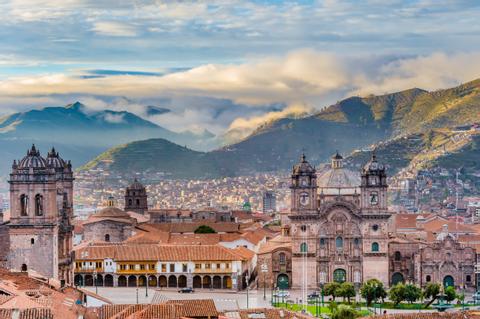
Though a popular “travel guide myth” is that Cusco means, in the Quechua language, "belly button of the world," this is a misnomer: the word actually derives from the Quechua word for a large bird or owl, or more fully, “rock of the owl.” This refers to an ancient legend of the founding or creation of the city. In its day, however, Cusco was very much the “belly button” or center of the great Inca Empire, which stretched across South America from Northern Chile to Colombia.
Cusco is famous for its curious blend of Inca and Spanish culture, most evident where colonial Spanish churches and convents have been built squarely on top of masterfully constructed Inca walls, such as Qoricancha (or Coricancha), the Inca temple poking out from under the colonial church of Santo Domingo.
Despite the Spanish colonists’ best efforts to pillage the city of its Inca riches, they failed to completely destroy the massive network of Inca stonework, which continues to withstand both time and the elements while the Spanish buildings crack and crumble around them.
It’s no wonder that droves of travelers visit the city every year; with its numerous Inca temples, colonial churches, and vibrant plazas, Cusco has so much to offer. Aside from the archaeological and religious sites of interest, Cusco is home to a multitude of quality restaurants, bars and cafes, offering an array of local and international drinks and cuisine.
Most of the major Cusco sights, including the Plaza de Armas, Qoricancha, La Iglesia de la Compañía de Jesús, and La Catedral, are within walking distance of one another and can be covered in about half a day, and it is worth devoting a decent amount of time to browsing the various shops and markets encountered along the way. Visitors might even be lucky enough to be in town during one of the many religious and cultural celebrations, for which the city’s streets fill up with music and dancing.
Cusco Personalized Trips
Customer Reviewed I learned so much of it's history and have such respect for it's culture.
Customer Reviewed PERU! is getting there. There are several areas where, for instance plastic bottles can be reused, by hotels providing large dispensers to refill existing bottles.
Customer Reviewed This trip was very well planned with professional and kind representatives helping us throughout. I would highly recommend Anywhere.com's Peru Team. Thank you for a wonderful trip!
Customer Reviewed Anywhere made this so easy! No glitches in our travels at all. From the hike to Machu Picchu to speeding through sand dunes in a buggy, the entire experience was out of this world.
Customer Reviewed I really could not be happier. The Anywhere Team made me feel like a VIP my entire time in Peru. The hotels were very nice & safe. The food was fantastic. Transportation was smooth, nice trains, safe airlines. I recommend Peru to all travelers!
Cusco Things to Do
Check out more tours and activities in Cusco .
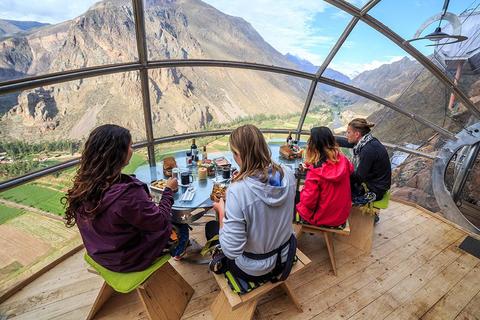
Overwhelmed with options?

Cusco Travel Guide
Book your individual trip , stress-free with local travel experts
Select Month
- roughguides.com
- South America
- cusco-and-around
- Travel guide
- Itineraries
- Local Experts
- Travel Advice
- Accommodation
Plan your tailor-made trip with a local expert
Book securely with money-back guarantee
Travel stress-free with local assistance and 24/7 support
Known to the Incas as the “navel of the world”, colourful Cusco was built by the Spanish on the remains of Inca temples and palaces, and is as rich in human activity today as it must have been at the height of the empire. One of South America’s biggest tourist destinations, the city boasts a thriving Andean culture, and Inca architecture and colonial treasures galore, not to mention exclusive access to the mighty Machu Picchu, an unmissable highlight to any trip to Peru. In high season – June to September – the entire Sacred Valley swarms with visitors. It may be difficult to avoid the crowds, but Cusco’s magnificent history and ancient feel may well tempt you to consider extending your stay.
Accommodation in Cusco
Activities around cusco, shopping in cusco, cusco drinking and nightlife, eating in cusco, fiestas in the cusco region, mountain sickness, the cusqueña school, inca sites near cusco, barrio san blas, south from cusco, towards the jungle from cusco, travel ideas for peru, created by local experts.

8 days / from 2429 USD
Peru: into the Incan Empire
Who were the Incas? What did they do? What happened to them? Discover the answers, and much more, with this unique trip into the heart of the former Inca Empire.

8 days / from 2822 USD
Female Empowerment Tour
From meditations in Miraflores over visits to craftswomen in Chincheros to gratitude rituals in the Sacred Valley. This itinerary will allow you to reconnect with your feminine energy and learn more about women's lives in Peru.

19 days / from 3510 USD
Culture, Nature and Adventure in Peru
Get to know Peru through its locals and breathtaking trails- full of history. Hop aboard a motorboat to get to know the local way of life of the Uros people, before you start the great Inca trail, where beautiful landscapes, archaeological sites and fresh air are waiting for you.
Nestling majestically in the belly of a highland valley and fed by two rivers, CUSCO’s unique layout was designed by the Incas in the form of a puma. Many of the city’s finest Inca architectural treasures were so masterfully constructed out of local stone that they are still in great shape today, and the city is ripe for exploring: one minute you’re walking down a shadowy, stone-walled alley, the next you burst onto a plaza full of brightly dressed dancers from the countryside, joining in what, at times, seems like the endless carnival and religious festival celebrations for which Cusco is famous.
Nearly every site you’ll want to visit is within walking distance of the main Plaza de Armas , and you can easily cover the main features of each quarter of the city in half a day. You should be able to cover most of Cusco Town in two or three active days, perhaps allowing a little extra time for hanging out in the bars and shops en route.
Enclosed between high hills, Cusco’s heart is the Plaza de Armas. Directly above it, the imposing ceremonial centre and fortress of Sacsayhuaman dominates the hillscape. Once the Incas’ capital, it is now home to a rich mix of traditional culture, lively nightlife and an endless variety of museums, walks and tours.
The wider region of Cusco is mainly mountainous, with several peaks over 6000m, all of them considered sacred. The entire region is high altitude and even the city of Cusco sits at 3399m, an altitude which needs to be treated with respect, particularly if arriving by air from sea level (see Mountain sickness). Within easy access of the city, there are dozens of enticing destinations. The Sacred Valley of the Río Urubamba is the obvious first choice, with the citadel of Machu Picchu as the ultimate goal, but there are hundreds of other magnificent Inca ruins – Pisac and Ollantaytambo in particular – set against glorious Andean panoramas.
The Cusco mountain region boasts some of the country’s finest trekking. The Inca Trail to Machu Picchu is by far the best known and most popular, but there are excellent alternative trails all starting less than a day’s overland travel from Cusco. The stunning Inca remains of Choquequirao, in the Río Apurímac area, arguably provides the best alternative archeological destination, with tours leaving from Cusco more or less daily. Salcantay to the north, and Ausangate , visible on the city’s southern horizon, are also appealing options.
East of Cusco, the Andean mountains slope steeply down into the lowland Amazon rainforest, where protected areas are helping to maintain some of the world’s most biodiverse wilderness areas. In particular, the Tambopata–Candamo Reserved Zone, or the slightly nearer Manu Reserved Zone, are among the best and most accessible ecotourism destinations. South of Cusco are the pre-Inca sites at Tipón and Pikillacta, nearly as spectacular as those in the Sacred Valley but far less visited. The luxurious train journey to Puno and Lake Titicaca passes through scenery as dramatic as any in the country.
The best time to visit Cusco and the surrounding area is during the dry season (May–Sept), when it’s warm with clear skies during the day but relatively cold at night. During the wet season (Oct–April) it doesn’t rain every day, but when it does, downpours are heavy.
Brief history
The Cusco Valley and the Incas are synonymous in many people’s minds, but the area was populated well before the Incas arrived on the scene and built their empire on the toil and ingenuity of previous peoples.
Founding Cusco
The Killki, who dominated the region from around 700–800 AD, while primarily agrarian, also built temple structures from the hard local diorite and andesite stones. Some of these structures still survive, while others were incorporated into later Inca constructions – the sun temple of Q’orikancha, for example, was built on the foundations of a Killki sun temple.
According to Inca legend, Cusco was founded by Manco Capac and his sister Mama Occlo around 1200 AD. Over the next two hundred years the valley was home to the Inca tribe, one of many localized groups then dominating the Peruvian sierra.

Morning sun rising with cloudy on Aden Mountain at Plaza de armas, Cusco, Peru © sharptoyou/Shutterstock
Building Cusco
It wasn’t until Pachacuti assumed leadership of the Incas in 1438 that Cusco became the centre of an expanding empire and, with the Inca army, took religious and political control of the surrounding valleys and regions. As Pachacuti pushed the frontier of Inca territory outwards, he also masterminded the design of imperial Cusco, canalizing the Saphi and the Tullumayo, two rivers that ran down the valley, and built the centre of the city between them. Cusco’s city plan was conceived in the form of a puma, a sacred animal: Sacsayhuaman, an important ritual centre and citadel, is the jagged, tooth-packed head; Pumachupan, the sacred cat’s tail, lies at the junction of the city’s two rivers; between these two sites lies Q’orikancha, the Temple of the Sun, reproductive centre of the Inca universe, the loins of this sacred beast; the heart of the puma was Huacapata, a ceremonial square approximate in both size and position to the present-day Plaza de Armas. Four main roads radiated from the square, one to each corner of the empire.
The overall achievement was remarkable, a planned city without rival, at the centre of a huge empire; and in building their capital the Incas endowed Cusco with some of its finest structures. Stone palaces and houses lined streets which ran straight and narrow, with water channels to drain off the heavy rains. It was so solidly built that much of ancient Cusco is still visible today, particularly in the stone walls of what were once palaces and temples.
The Spanish Conquest
In 1532, when the Spanish arrived in Peru, Cusco was a thriving city, and capital of one of the world’s biggest empires. The Spaniards were astonished: the city’s beauty surpassed anything they had seen before in the New World; the stonework was better than any in Spain; and precious metals, used in a sacred context across the city, were in abundance throughout Q’orikancha. They lost no time in plundering its fantastic wealth. Atahualpa, the emperor at the time, was captured by Spanish conquistadors in Cajamarca while en route to Cusco, returning from bloody battles in the northern extremity of the empire. Hearing from the Emperor Atahualpa himself of Cusco’s great wealth as the centre of Inca religious and political power, Francisco Pizarro reached the native capital on November 15, 1533.
The Spanish city was officially founded on March 23, 1534. Cusco was divided up among 88 of Pizarro’s men who chose to remain there as settlers. Manco Inca, a blood relative of Atahualpa – who was murdered by Pizarro – was set up as a puppet ruler, governing from a new palace on the hill just below Sacsayhuaman. After Pizarro’s departure, and following twelve months of power struggles, his sons Juan and Gonzalo came out on top and were then free to abuse Manco and his subjects, which eventually provoked the Incas to open resistance. In April 1536 Manco fled to Yucay, in the Sacred Valley, to gather forces for the Great Rebellion.
Within days, the two hundred Spanish defenders, with only eighty horses, were surrounded in Cusco by over 100,000 rebel Inca warriors. On May 6, Manco’s men laid siege to the city. After a week, a few hundred mounted Spanish soldiers launched a desperate counterattack on the Inca base in Sacsayhuaman and, incredibly, defeated the native stronghold, putting some 1500 warriors to the sword as they took it.
Spanish-controlled Cusco never again came under such serious threat from its indigenous population, but its battles were far from over. By the end of the rains the following year, a rival conquistador, Almagro, had seized Cusco for himself until Francisco Pizarro defeated the rebel Spanish troops a few months later, and had Almagro garrotted in the main plaza. Around the same time, a diehard group of rebel Incas held out in Vilcabamba until 1572, when the Spanish colonial viceroy, Toledo, captured the leader Tupac Amaru and had him beheaded in the Plaza de Armas.
Post-Conquest Cusco
From then on the city was left in relative peace, ravaged only by the great earthquake of 1650. After this dramatic tremor, remarkably illustrated on a huge canvas in La Catedral de Cusco, Bishop Mollinedo was largely responsible for the reconstruction of the city, and his influence is also closely associated with Cusco’s most creative years of art. The Cusqueña school, which emerged from his patronage, flourished for the next two hundred years, and much of its finer work, produced by native Quechua and mestizo artists such as Diego Quispe Tito Inca, Juan Espinosa de los Monteros, Fabian Ruiz and Antonio Sinchi Roca, is exhibited in museums and churches around the city.
The modern age
In spite of this cultural heritage, Cusco only received international attention after the discovery of Machu Picchu by Hiram Bingham’s archeological expedition in 1911. With the advent of air travel and global tourism, Cusco was slowly transformed from a quiet colonial city in the remote Andes into a major tourist centre.
While there are relatively inexpensive and reasonable mid-range hostels and hotels in most corners of the city, Cusco’s accommodation is centred in three main zones: east, west and south of the Plaza de Armas. To the west of the Plaza along calles Plateros, Procuradores and Saphi (Procuradores and Plateros are particularly noisy at night) there are plenty of busy budget hostels. You can find slightly pricier and more luxurious places in the area east of the Plaza around San Blas and Choquechaca in the artists’ quarter. To the south of the Plaza, the San Pedro region around the central market and near to the train station for Machu Picchu has improved its facilities in recent years, now offering comfortable and safe accommodation. Closer to the Plaza, along Calle Quera and around Avenida Sol, more varied accommodation can be found.
The Cusco region and nearby cloudforest and lowland Amazon provide a fantastic range of activities, from river-based ecotourism and whitewater kayaking to mountain biking, hiking and horseriding, not to mention white-knuckle experiences of the spiritual variety.
Hiking and horseriding
The mountains to the south and the north of Cusco are full of amazing trekking trails, some of them little touched, most of them still rarely walked (see Alternative treks to the Inca Trail). Less adventurous walks or horse rides are possible to Qenko, Tambo Machay, Puca Pucara and Chacan, in the hills above Cusco and in the nearby Sacred Valley. Many jungle trip operators are based in Cusco.
Whitewater rafting
Cusco is also a great whitewater rafting centre, with easy access to classes 2 to 5 (rivers are generally rated from class 1 – very easy – to class 5 – very difficult/borderline dangerous) around Ollantaytambo on the Río Urubamba and classes 1 to 3 between Huambutio and Pisac, on the Río Vilcanota. From Calca to Urubamba the river runs classes 2 to 3, but this rises to 5 in the rainy season. Calca to Pisac (Huaran) and Ollantaytambo to Chilca are among the most popular routes, while the most dangerous are further afield on the Río Apurimac. The easiest stretch is from Echarate to San Baray, which passes by Quillabamba. Costs range from around $40 to about $200 a day, with price usually reflecting quality, but it’s always recommended to use a reputable and well-established rafting company such as Mayuc. Remember that most travel insurance policies exclude this kind of adventure activity, and always ensure that you are fully equipped with a safety kayak, helmets and lifejackets.
Bungee jumping and hot-air balloon trips
Bungee jumping is big in Cusco. The tallest bungee jump facility in the Americas (122m) is offered by Action Valley Cusco, Santa Teresa 325 (240835, actionvalley.com), just a fifteen-minute walk from the plaza in Poroy (buses run here from block 8 of Avenida Sol). Equally breathtaking but slightly less scary is the option of a hot-air balloon adventure (from $400, shared between groups of 5 to 10 people) in the Cusco or Sacred Valley areas.
Psychedelic tourism
Psychedelic tourism is popular in Cusco these days, though not as developed as in Iquitos. This doesn’t involve taking drugs and wandering around the Andes: essentially, psychedelic tourism is based on traditional healing techniques that tend to focus on inner consciousness and well-being through often highly ritualized ceremonies. San Pedro and ayahuasca, the two principal indigenous psychedelic plants that have been used ceremonially in Peru for over 3500 years, can be experienced with the assistance of Etnikas Travel and Shamanic Healing (C Herrajes 148; 244516) or Another Planet (Triunfo 120; 2445168, anotherplanetperu.net), who also lead organized spiritual tours.
Most of the touristy artesanía and jewellery shops are concentrated in streets like Plateros around the Plaza de Armas and up Triunfo, though calles Herraje (first right as you head towards San Blas) and San Agustín have slightly cheaper but decent shops with leather and alpaca work. It’s worth heading off the beaten track, particularly around San Blas or the upper end of Tullumayo, to find outlets hidden in the backstreets.
The main street-market day for artesanía is Sat (10am–6pm). The central market, selling fresh produce, is at San Pedro. Out of town there are good markets for artesanía at Pisac and Chinchero, market days being Sun and Thurs, respectively.
Craft-shopping in Cusco
Crafts and artesanía are Cusco’s stock in trade, with the best value and range of alpaca clothing in Peru, apart perhaps from Puno. It’s an ideal place to pick up weavings or antique cloths, traditional musical instruments like panpipes, and colourful bags and leather crafts. There are artesanía (craft shops) all over the centre, but the best prices and fullest range are found at the Centro Artesanal Cusco (Mon–Sat 8am–10pm, with most stalls open 9am–6pm, Sun 9am–5pm) at the corner of Huanchac and Tullumayo, close to the huge sun-disc fountain on Avenida Sol. This large building brings together arguably the largest and best-value collection of artesanía under one roof in Peru; it’s a nice, clean and relatively hassle-free shopping environment very close to the train ticket office at Huanchac station.
Another good part of town for quality artesanía is the barrio of San Blas. This is the traditional artisan area of Cusco, home to a number of jewellers and art and antique shops. The Cuesta San Blas itself contains some of the finest artesanía, selling new and old oil paintings, while Hathun Rumiyoq has more good shops at its bottom end. There are some funky shops around the San Blas plazoleta too. The main street-market day for artesanía is Saturday (10am–6pm).
Apart from Lima, no Peruvian town has as varied a nightlife as Cusco. The Plaza de Armas is a hive of activity until the early hours, even during the week. Most venues in the city are simply bars with a dancefloor and sometimes a stage, but their styles vary enormously, from Andean folk spots with panpipe music to reggae or jazz joints, as well as more conventional clubs. Most places are within staggering distance of each other, and sampling them is an important part of any stay in Cusco. Most really get going between 10 and 11pm, then keep on going until 2 or 3am.
Cusco prides itself on its traditional dishes, which have evolved this century into a novo andino cuisine, fusing the best ingredients of the Andes with exquisite Mediterranean and even Argentinian influences. Generally speaking, trout is plentiful, reasonably priced and often excellent, and roast guinea pig (cuy) can usually be ordered – but pizza seems to lead in the popularity stakes.
The central market by San Pedro train station sells a wonderful variety of meats, tropical and imported fruits, local vegetables, Andean cheeses and other basics. The market also has a wide range of daytime hot-food stalls where you can get superb, freshly squeezed juices.
Eating out in Cusco is enjoyable, and restaurants range from cheap-and-cheerful pizza joints to exceptionally fine gourmet establishments. Many of the best restaurants and bars are within a block or two of the Plaza de Armas and uphill towards San Blas; the more central places serve anything from a toasted cheese sandwich to authentic Andean or criolla dishes. Quintas – basic local eating houses – serve mostly traditional Peruvian food, full of spice and character. It’s difficult, if not impossible, to categorize some of the establishments in Cusco as distinctly cafés, restaurants or bars since many fulfil all three functions, occasionally simultaneously, sometimes varying between different hours of the day.
As the imperial capital during Inca times, Cusco was the most important place of pilgrimage in South America, a status it retains today. During Easter, June and Christmas, the city centre becomes the focus for relentless fiestas and carnivals celebrated with extravagant processions blending pagan pre-Columbian and Catholic colonial cultures.
- Around Jan 20 Adoración de los Reyes (Adoration of the Kings). Ornate and elaborate processions leave from San Blas church and parade through Cusco.
- Last week of Jan Pera Chapch’y (Festival of the Pear). A harvest festival in San Sebastián, 4km southeast of Cusco, with lively street stalls and processions.
- First week of March Festival de Durasno (Festival of the Peach). Food stalls and folk dancing in Yanahuara and Urubamba.
- Easter Week Semana Santa. On Easter Monday there’s a particularly splendid procession through Cusco, with a rich and evocative mix of Indian and Catholic iconography. The following Thursday a second procession celebrates the city’s patron saint, El Señor de los Temblores (Lord of Earthquakes), and on Easter Friday, street stalls sell many different traditional dishes.
- May 2–3 Cruz Velacuy, or Fiesta de las Cruces (Festival of the Cross). All church and sanctuary crosses in Cusco and the provinces are veiled for a day, followed by traditional festivities with dancing and feasting in most communities. Particularly splendid in Ollantaytambo.
- Weekend before Corpus Christi Qoyllur Rit’i (Snow Star, or Ice Festival). Held on the full-moon weekend prior to Corpus Christi in an isolated valley above the road from Cusco via Urcos and Ocongate to the Amazon town of Puerto Maldonado. The festival site lies at the foot of a glacier, considered an apu, or mountain god. Close by, and visible during the climb to the festival, is the sacred snowcapped peak – Ausangate. This is one of the most exciting festivals in the Americas, with live music that continues for days, several processions, and bands and dancers from various communities who make an annual pilgrimage to recharge spiritually at a time when the mountain is said to be blossoming in a metaphysical rather than botanical sense. As it involves camping at around 4600m at the foot of a glacier, it’s only for the adventurous; some tour operators organize trips, but it’s primarily a Quechua festival, with villagers arriving in their thousands in the weeks running up to it.
- Corpus Christi (always nine weeks after Easter). Imposed by the Spanish to replace the Inca tradition of parading ancestral mummies, saints’ effigies are carried through the streets of Cusco, even as the local mayordomos (ritual community leaders) throw parties and feasts combining elements of religiosity with outright hedonism. The effigies are then left inside the cathedral for eight days, after which they are taken back to their respective churches, accompanied by musicians, dancers and exploding firecrackers.
- Second week of June Cusqueña International Beer and Music Festival. Lively, with big Latin pop and jazz names, at its best from Thursday to Sunday.
- June 16–22 Traditional folk festivals in Raqchi and Sicuani.
- June 20–30 Fiesta de Huancaro. An agricultural show packed with locals and good fun, based in the Huancaro sector of Cusco (S/5 taxi ride from Plaza de Armas, or go down Avenida Sol and turn right at the roundabout before the airport).
- Last week of June Cusco Carnival. Daily processions and folk dancers, plus lively music on the streets throughout the day and night, peaking with Inti Raymi.
- June 24 Inti Raymi. Popular, commercial fiesta re-enacting the Inca Festival of the Sun in the grounds of Sacsayhuaman.
- July 15–17 Virgen del Carmen. Dance and music festival celebrated all over the highlands, but at its best in Paucartambo.
- July 28 Peruvian Independence Day. Festivities nationwide, not least in Cusco.
- Sept 14–18 Señor de Huanca. Music, dancing, pilgrimages and processions take place all over the region but are especially lively in Calca, with a fair in the Sacred Valley.
- First week of Dec Yawar Fiesta. A vibrant, uncommercial corrida de toros (bull fight) at the end of the week in Paruro, Cotabambas and Chumbivilcas. A condor, captured by hand, is tied to the back of a bull that battles to the death.
Soroche, or mountain sickness, is a reality for most people arriving in Cusco by plane from sea level and needs to be treated with respect. It’s vital to take it easy, not eating or drinking much on arrival, even sleeping a whole day just to assist acclimatization (coca tea is a good local remedy). After three days at this height most people have adjusted sufficiently to tackle moderate hikes at similar or lesser altitudes. Anyone considering hiking the major mountains around Cusco will need time to adjust again to their higher base camps.
If you do encounter altitude-related health problems, many hotels and restaurants have oxygen cylinders to help; alternatively, for serious cases, try the Clinica Peruano Suiza (English spoken) at Calle Meson de la Estrella 168 (open 24hr; t237009, wclinicaperuanosuiza.com), which also has a dedicated medical network whose details can be accessed at wo2medicalnetwork.com, and the Clinica Cima at Av Pardo 978 (t255550).
Colonial Cusco evolved into an exceptional centre for architecture and art. The era’s paintings in particular are curious for the way they adorn human and angelic figures in elaborate lacy garments and blend traditional and ancient with colonial and Spanish elements. They are frequently brooding and quite bloody, and by the mid-seventeenth-century had evolved into a recognizable school of painting.
The Cusqueña art movement dedicated itself to beautifying church and convent walls with fantastic and highly moralistic painting, mainly using oils. The Cusqueña school is best known for portraits or religious scenes with dark backgrounds, serious (even tortured-looking) subjects and a profusion of gold-leaf decoration. Influences came from European émigrés – mainly Spainish and Italian – notably Juan de Illescas, Bernardo Bitti and Mateo Perez de Alessio. At the close of the seventeenth century, the school came under the direction of Bishop Manuel Mollinedo. Bringing a number of original paintings (including some by El Greco) with him from his parish in Spain, the Bishop was responsible for commissioning Basilio Santa Cruz’s fine 1698 reproduction of the Virgen de la Almudena, which still hangs behind the choir in Cusco’s Catedral. He also commissioned the extraordinarily carved cedarwood pulpit in the church at San Blas.
The top Cusqueña artists were Bernardo Bitti (1548–1610), an Italian who is often considered the “father of Cusqueña art” and who introduced the Mannerist style to Peru, and Diego Quispe Tito Inca (1611–81), a mestizo painter who was influenced by the Spanish Flamenco school and whose paintings were vital tools of communication for priests attempting to convert Indians to Catholicism. Bitti’s work is on display in the Museo Historico Regional, while some of Quispe’s works can be seen in rooms off the second courtyard in the Religious Art Museum at the Archbishop’s Palace in Cusco. The equally renowned Mauricio García (painting until the mid-eighteenth century) helped spur the form into a fuller mestizo synthesis, mixing Spanish and Indian artistic forms. Many of the eighteenth- and nineteenth-century Cusqueña-mestizo works display bold compositions and colours.
By the eighteenth century, the style had been disseminated as far afield as Quito in Ecuador, Santiago in Chile and even into Argentina, making it a truly South American art form and one of the most distinctive indigenous arts in the Americas.
The megalithic fortress of Sacsayhuaman, which looks down onto the red-tiled roofs of Cusco from high above the city, is the closest and most impressive of several historic sites scattered around the Cusco hills. However, there are four other major Inca sites in the area. Not much more than a stone’s throw beyond Sacsayhuaman lie the great huaca of Qenko and the less-visited Salumpuncu, thought by some to be a moon temple. A few kilometres further on, at what almost certainly formed the outer limits of the Inca’s home estate, you come to the small, fortified hunting lodge of Puca Pucara and the stunning imperial baths of Tambo Machay.
Originally known as T’oqokachi (“salty hole”), the San Blas barrio was the first parish to be established by the Spanish in Cusco and one of twelve administrative sectors in the Inca capital. After the Conquest it became the residence for many defeated Inca leaders. It rapidly grew into one of the more attractive districts in the city, reflecting strong mestizo and colonial influences in its architecture and high-quality artesanía – even today it’s known as the barrio de los artesanos (artesans’ quarter). Hit hard by the 1950 earthquake, it has been substantially restored, and in 1993 was given a major face-lift that returned it to its former glory. The process of rebuilding continues, with many old houses being converted to hostels, shops and restaurants.
At the barrio’s centre, on the southeast side of the Iglesia San Blas, lies the Plazoleta San Blas, with 49 gargoyles set on a fountain that’s laid out in the form of a chakana, or Inca cross, with four corners and a hole at its centre.
The first 150km of the road (and rail) south from Cusco towards Lake Titicaca passes through the beautiful valleys of Huatanay and Vilcanota, from where the legendary founders of the Inca Empire are said to have emerged. A region outstanding for its natural beauty and rich in magnificent archeological sites, it’s easily accessible from Cusco and offers endless possibilities for exploration or random wandering. The whole area is ideal for camping and trekking, and in any case, only the rustic towns of Urcos and Sicuani are large enough to provide reasonable accommodation.
A few kilometres further up the valley, the superb Inca remains of Tipón lie high above the road, little visited but extensive and evocative. Closer to the road, the Huari city of Pikillacta is easier to find and worthy of an hour or two. Beyond Urcos but before Sicuani, a rather dull transport hub of a town, the great Temple of Raqchi still stands unusually high as a monument to Inca architectural abilities.
Pikillacta and Rumicolca
About 7km south of Oropesa, the neighbouring pre-Inca ruins of Pikillacta and Rumicolca can be seen alongside the road. After passing the Paucartambo turn-off, near the ruins of an ancient storehouse and the small red-roofed pueblo of Huacarpay, the road climbs to a ledge overlooking a wide alluvial plain and Lucre Lake (now a weekend resort for Cusco’s workers). At this point the road traces the margin of a stone wall defending the pre-Inca settlement of Pikillacta.
Spread over an area of at least fifty hectares, PIKILLACTA, or “The Place of the Flea”, was built by the Huari culture around 800 AD, before the rise of the Incas. Its unique, geometrically designed terraces surround a group of bulky two-storey constructions: apparently these were entered by ladders reaching up to doorways set well off the ground in the first storey – very unusual in ancient Peru. Many of the walls are built of small cut stones joined with mud mortar, and among the most interesting finds here were several round turquoise statuettes. These days the city is in ruins but it seems evident still that much of the site was taken up by barrack-like quarters. When the Incas arrived early in the fifteenth century they modified the site to suit their own purposes, possibly even building the aqueduct that once connected Pikillacta with the ruined gateway of Rumicolca, which straddles a narrow pass by the road, fifteen minutes’ walk further south.
This massive defensive passage, RUMICOLCA, was also initially constructed by the Huari people and served as a southern entrance to – and frontier of – their empire. Later it became an Inca checkpoint, regulating the flow of people and goods into the Cusco Valley: no one was permitted to enter or leave the valley via Rumicolca between sunset and sunrise. The Incas improved on the rather crude Huari stonework of the original gateway, using regular blocks of polished andesite from a local quarry. The gateway still stands, rearing up to twelve solid metres above the ground, and is one of the most impressive of all Inca constructions.
Scenic routes to Puno and Lima
Even if you aren’t planning to spend time around Lake Titicaca, the rail journey south to Puno is worth taking. The journey starts in the Cusco region and takes around twelve hours, covering a soul-stirring route that climbs slowly through stunning green river valleys to a desolate landscape to the pass, beyond the town of Sicuani. From here it rolls down onto the altiplano, a flat high plain studded wih adobe houses and large herds of llama and alpaca, before reaching Lake Titicaca and the port city of Puno.
If Lima is your destination, consider the 20-hour direct highland route northwest from Cusco through Abancay and then down to the coast at Nasca. Known as the Nasca-Cusco Corridor, it offers access to a range of potential stop-overs on the way: the archeological sites of Choquequirao and Sahuite; the city of Abancay and protected mountain forest area of Ampay; the thermal baths at Chaullanca and the alpaca and vicuña centre at Puquio; and, of course, the mysterious archeological sites around Nasca itself.
The Tipón temples and aqueducts
Both in setting and architectural design, the TIPÓN RUINS are one of the most impressive Inca sites. With no village or habitation in sight, and fresh running water, it’s also a breathtaking place to camp.
The lower ruins
Well hidden in a natural shelf high above the Huatanay Valley, the lower sector of the ruins is a stunning sight: a series of neat agricultural terraces, watered by stone-lined channels, all astonishingly preserved and many still in use. The impressive stone terracing reeks of the Incas’ domination over an obviously massive and subservient labour pool; yet at the same time it’s clearly little more than an elaborate attempt to increase crop yield. At the back of the lower ruins, water flows from a stone-faced “mouth” around a spring – probably an aqueduct subterraneously diverted from above. The entire complex is designed around this spring, reached by a path from the last terrace.
The reservoir and temple block
Another sector of the ruins contains a reservoir and temple block centred on a large, exploded volcanic rock – presumably some kind of huaca. Although the stonework in the temple seems cruder than that of the agricultural terracing, its location is still beneficial. By contrast, the construction of the reservoir is sophisticated, as it was originally built to hold nine hundred cubic metres of water which gradually dispersed along stone channels to the Inca “farm” directly below.
The upper ruins
Coming off the back of the reservoir, a large, tapering stone aqueduct crosses a small gully before continuing uphill – about thirty minutes’ walk – to a vast zone of unexcavated terraces and dwellings. Beyond these, over the lip of the hill, you come to another level of the upper valley literally covered in Inca terracing, dwellings and large stone storehouses. Equivalent in size to the lower ruins, these are still used by locals who have built their own houses among the ruins. So impressive is the terracing at Tipón that some archaeologists believe it was an Inca experimental agricultural centre, much like Moray, as well as a citadel.
The two major places to visit northeast of Cusco are Paucartambo, 112km from Cusco, and Tres Cruces, another 50km beyond Paucartambo. The road between the two follows the Kosnipata Valley (“Valley of Smoke”), then continues through cloudy tropical mountain scenery to the mission of Shintuya on the edge of the Manu National Park. Legend has it that the Kosnipata enchants anyone who drinks from its waters at Paucartambo, drawing them to return again and again.
The area along the Río Urubamba from Machu Picchu onwards, to the north, is a quiet, relatively accessible corner of the Peruvian wilderness. As you descend from Ollantaytambo, the vegetation along the valley turns gradually into jungle, thickening and getting greener by the kilometre, as the air gets steadily warmer and more humid. Most people heading down here get as far as the town of Quillabamba, but the road continues deeper into the rainforest where it meets the navigable jungle river at Ivochote. Many come to this region to explore its mountains, cloud forest and rainforest areas, either to check out known Inca ruins or to search out some new ones. It’s relatively easy to visit the hilltop ruins of the palace at Vitcos, a site of Inca blood sacrifices, and possible – though an expedition of six days or more – to explore the more remote ruins at Espíritu Pampa, now thought to be the site of the legendary lost city of Vilcabamba.
New discoveries
Major Inca sites are still being discovered in this jungle region. In April 2002 British explorer Hugh Thomson – author of The White Rock – and American archeologist Gary Ziegler, following rumours of a lost city, led an expedition, which discovered an Inca city in the virtually inaccessible valley bottom at the confluence of the ríos Yanama and Blanco in the Vilcabamba region. Apparently seen briefly by Hiram Bingham nearly a hundred years ago, the coordinates were never recorded and this settlement of forty main buildings set around a central plaza hadn’t been spotted since. Although very difficult to access – due to river erosion – there appears to have been an Inca road running through the valley, probably connecting this site to the great Inca citadel of Choquequirao. This settlement is believed to have been Manco Inca’s hideout during his rebellion against the conquistadors, which lasted until his execution in Cusco in 1572.
Paucartambo
Eternally spring-like because of the combination of altitude and proximity to tropical forest, the pretty village of PAUCARTAMBO (“Village of the Flowers”) is located some 110km from Cusco in a wild and remote Andean region, and guards a major entrance to the jungle zone of Manu. A silver-mining colony, run by slave labour during the seventeenth and eighteenth centuries, it’s now a popular destination that is at its best in the dry season between May and September, particularly in mid-July when the annual Fiesta de la Virgen del Carmen takes place; visitors arrive in their thousands and the village is transformed from a peaceful habitation into a huge mass of frenzied, costumed dancers. Even if you don’t make it to Paucartambo for the festival, you can still see the ruined chullpa burial towers at Machu Cruz, an hour’s walk from Paucartambo; ask in the village for directions. Travellers rarely make it here outside of festival time, unless en route to the rainforest by road.
Plaza Principal
The beautiful main plaza, with its white buildings and traditional blue balconies, holds concrete monuments depicting the characters who perform at the fiesta – demon-masked dancers, malaria victims, lawyers, tourists and just about anything that grabs the imagination of the local communities. Also on the plaza is the rather austere iglesia, restored in 1998 and splendid in its own way, simple yet full of large Cusqueña paintings. It’s also the residence of the sacred image of the Virgen del Carmen, unusual in its Indian (rather than European) appearance. When the pope visited Peru in the mid-1980s, it was loaded onto a truck and driven to within 30km of Cusco, then paraded on foot to the city centre so that the pope could bless the image.
Fiesta de la Virgen del Carmen
Paucartambo spends the first six months of every year gearing up for the Fiesta de la Virgen del Carmen. It’s an essentially female festival: tradition has it that a wealthy young woman, who had been on her way to Paucartambo to trade a silver dish, found a beautiful (if body-less) head that spoke to her once she’d placed it on the dish. Arriving in the town, people gathered around her and witnessed rays of light shining from the head, and henceforth it was honoured with prayer, incense and a wooden body for it to sit on.
The energetic, hypnotic festival lasts three or four days – usually July 16–19, but check with the tourist office in Cusco – and features throngs of locals in distinctive traditional costumes, with market stalls and a small fair springing up near the church. Clamouring down the streets are throngs of intricately costumed and masked dancers and musicians, the best known of whom are the black-masked Capaq Negro, recalling the African slaves who once worked the nearby silver mines. Note the grotesque blue-eyed masks and outlandish costumes acting out a parody of the white man’s powers – malaria, a post-Conquest problem, tends to be a central theme – in which an old man suffers terrible agonies until a Western medic appears on the scene, with the inevitable hypodermic in his hand. If he manages to save the old man (a rare occurrence) it’s usually due to a dramatic muddling of prescriptions by his dancing assistants – and thus does Andean fate triumph over science.
On Saturday afternoon there’s a procession of the Virgen del Carmen itself, with a brass band playing mournful melodies as petals and emotion are showered on the icon of the Virgin – which symbolizes worship of Pachamama as much as devotion to Christianity. The whole event culminates on Sunday afternoon with the dances of the guerreros (warriors), during which good triumphs over evil for another year.
Discover more places in Peru

- Choquequirao
- Plaza de Armas
- Sacsayhuaman
- The Inca Trail
- The Sacred Valley
The Rough Guides to Peru and related travel guides
In-depth, easy-to-use travel guides filled with expert advice.

Find even more inspiration here

Planning your own trip? Prepare for your trip
Use Rough Guides' trusted partners for great rates
written by Rough Guides Editors
updated 10.05.2021
Ready to travel and discover Peru?
Get support from our local experts for stress-free planning & worry-free travels.
- Where to stay
- Travel advice
- Cleaning Campaign of the Lucre-Huacarpay Swamp
- Mother’s Hands that Save the World
- Salkantay Trekking is Recognized for its Social Service
- Alternative treks to the Inca Trail to reach Machu Picchu
- Things you need for traveling to Peru – What to wear
- Adventure Sports you should practice when in Cusco
- Machu Picchu Mountain vs Huayna Picchu
- Everything you Need to Know About the Inca Trail in 2024
- Five tips before taking the Inca Trail
- 7 Famous Foods you Must Try in Cusco
Salkantay Treks
Salkantay trekking companyy.

Corpus Christi in Cusco | A Religious and Cultural Feast.
With grandeur and devotion, every year the city of Cusco dresses up for the Corpus Christi celebration. This traditional festivity blends the Catholic heritage from the Spanish colonial era with ancestral indigenous beliefs. Moreover, it stands as one of the most significant festivities in the regional religious calendar. This valuable syncretism of colonial and indigenous cultures reaches new heights, drawing thousands of faithful and visitors from around the globe to partake in the processions, masses, and rituals that mark this special occasion.
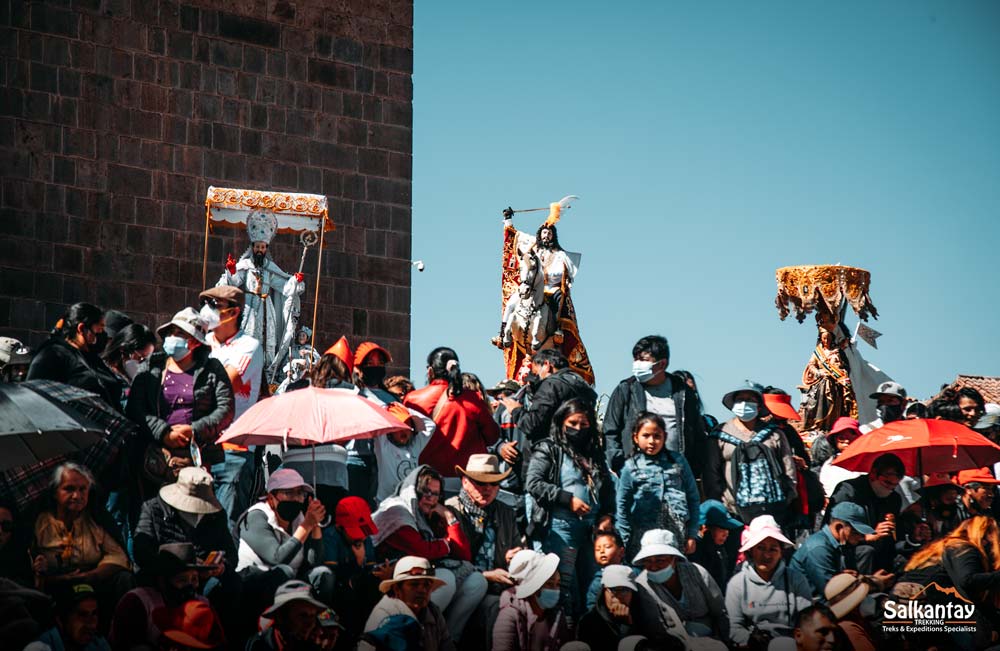
Brief History.
San antonio abad / saint anthony the abbot, san jerónimo / saint jerome, san cristobal / saint christopher, san sebastian / saint sebastian, santa bárbara / saint barbara, santa ana / saint anne, santiago apostol / saint james the apostle, san blas / saint blaise, san pedro / saint peter, san josé / saint joseph, virgen de la natividad / virgin of the nativity, virgen de los remedios / virgin of remedies, virgen purificada / purified virgin, virgen de belén / the virgin of bethlehem, virgen inmaculada concepción / immaculate conception virgin, traditional customs., tips to enjoy corpus christi to the fullest., conclusion..
In Latin America, Corpus Christi celebration became a significant occasion to showcase the cultural richness and religiosity of communities. Solemn processions, traditional dances, and other festive events commemorate the presence of Christ in the Eucharist.
The celebration of Corpus Christi was introduced by the Spanish in the 16th century and has deep roots in Cusco’s colonial history. It was in 1538, eight years after the Spanish foundation of the city, that the first Corpus Christi procession took place. Today, squares and streets are adorned with flower and sawdust carpets, generating both solemnity and festivity.
What would the Cusco celebration have been like in pre-conquest times? Pinpointing this information is somewhat challenging as there isn’t much evidence available. Drawing from various bibliographic sources, it’s believed that these were religious festivals of different kinds. It’s thought that during the time of the Incas, numerous mallquis or ancestral mummies were still venerated, and these deities also embarked on journeys around the city periodically.
Exactly 20 years ago, on August 8, 2004, the Corpus Christi festival in Cusco was declared a cultural heritage of Peru. It was declared then that this festivity is one of the most relevant expressions of Peruvian culture as it is a source of national identity. This solemn tradition takes place in the months of May or June, according to the Catholic calendar.
Compilation of the Saints Venerated in the Corpus Christi of Cusco.
Throughout the Corpus Christi celebration in Cusco, fifteen saints, holy figures, and virgins are venerated, each with their own history and significance. The procession of these images surrounded by dances, represents a unique blend of Catholicism and indigenous beliefs. This festivity reflects the rich cultural diversity of the region. Let’s explore the history of each one:
Patron saint of animals and farmers, was born in Egypt in the 3rd century. He withdrew to the desert to lead a life of prayer and penance, and numerous miracles are attributed to him, including his ability to communicate with animals.
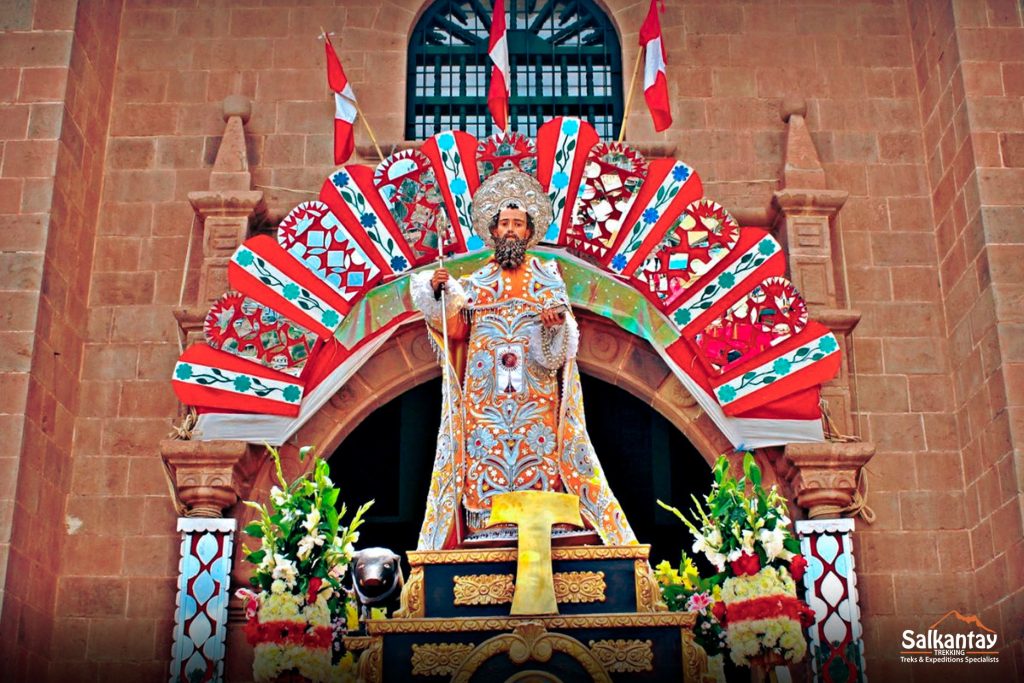
A priest and hermit who lived in the desert of Palestine in the 4th century. He is known for his translation of the Bible into Latin, known as the Vulgate, and is revered as the patron saint of scholars and translators.
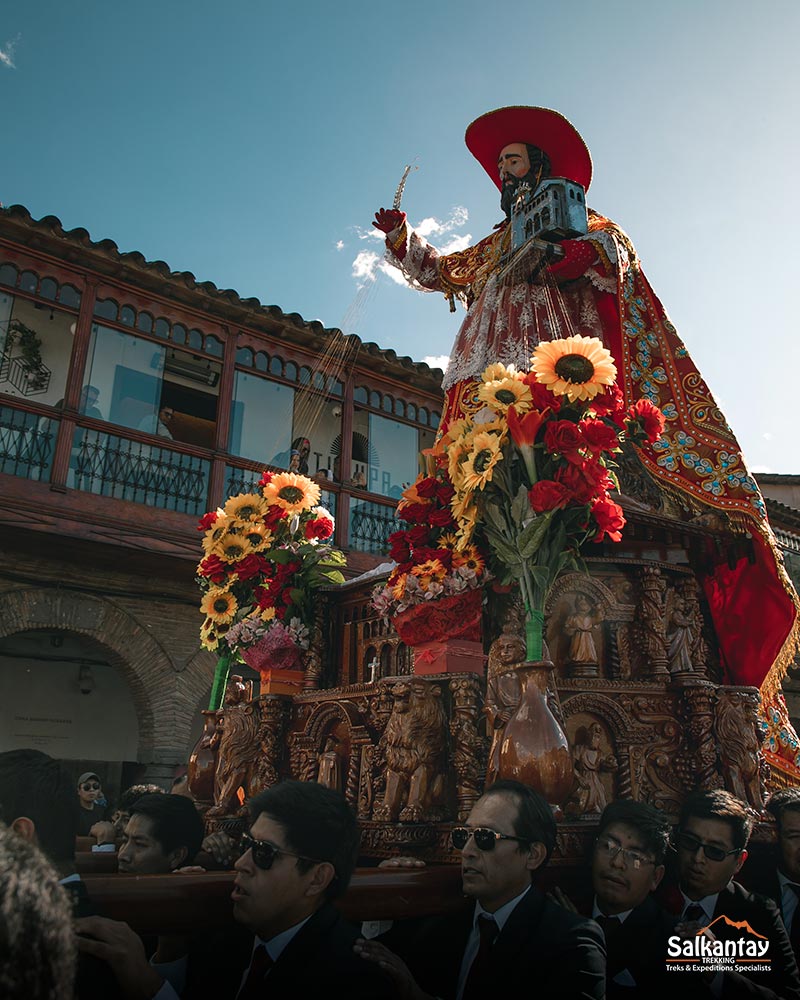
Venerated as the patron saint of travelers and transporters. According to legend, he helped Christ cross a river by carrying him on his shoulders. He is invoked to protect travelers during their journeys.
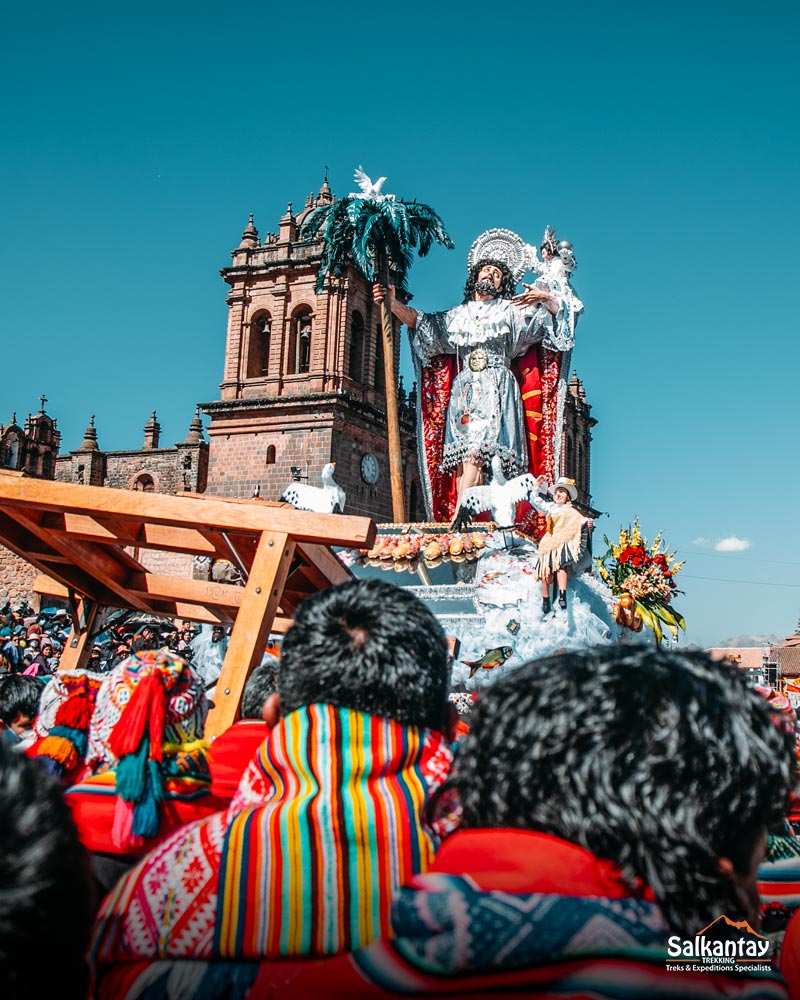
He was a Roman soldier who converted to Christianity and was martyred for his faith in the 3rd century. He is venerated as the patron saint of archers and soldiers.
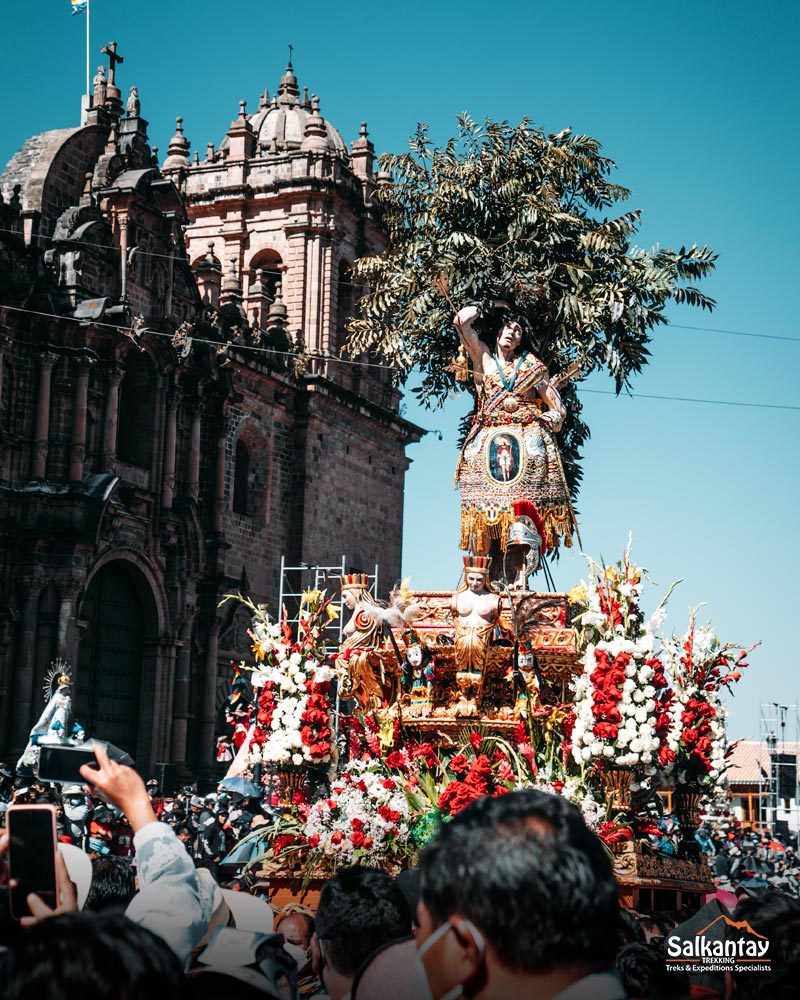
It is said that she was imprisoned and tortured for her faith and ultimately martyred for her refusal to renounce Christianity. She was a young Christian woman who lived in the 3rd century. She is venerated as the patron saint of artillerymen and protector against dangers.
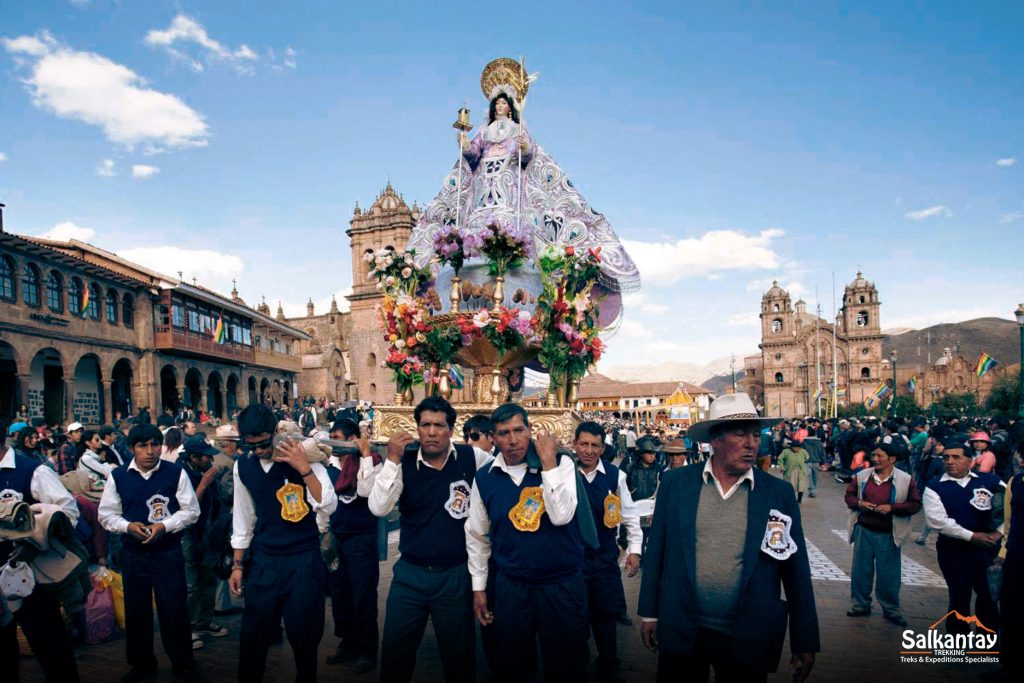
She was the mother of the Virgin Mary and the grandmother of Jesus. However, she is not directly mentioned in the Bible; her cult developed over the centuries from apocryphal writings and oral traditions. She is venerated as the patron saint of various causes, including pregnant women, grandparents, and carpenters.
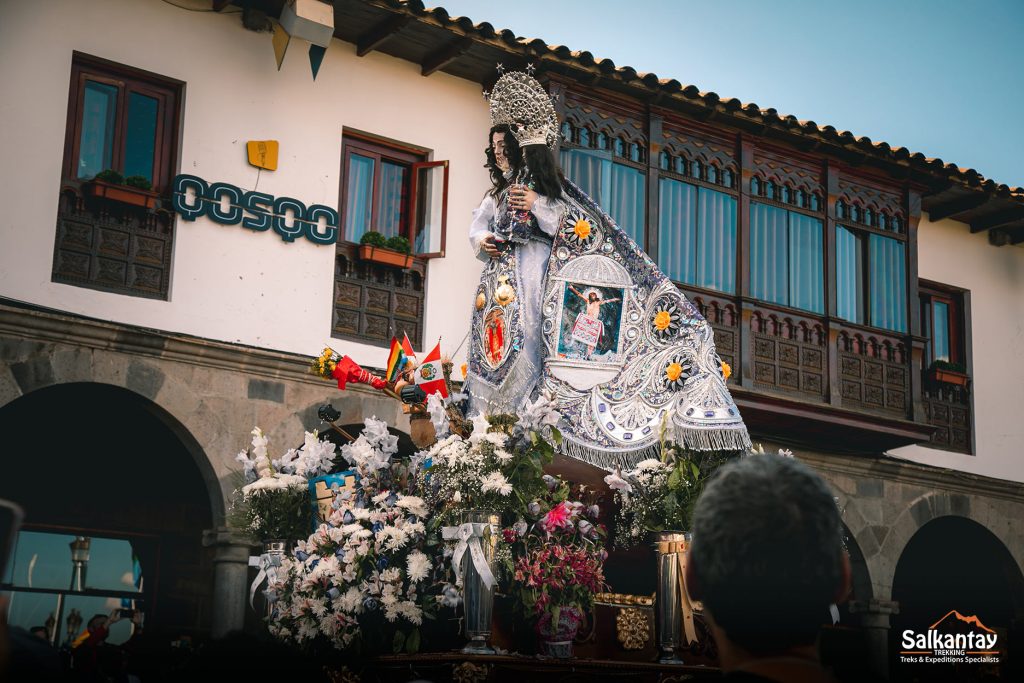
Also known as Saint James the Greater, he was one of the twelve apostles of Jesus Christ. According to Christian tradition, he became an important leader in the early church. He preached Christianity in Spain before returning to Jerusalem, where he was martyred.
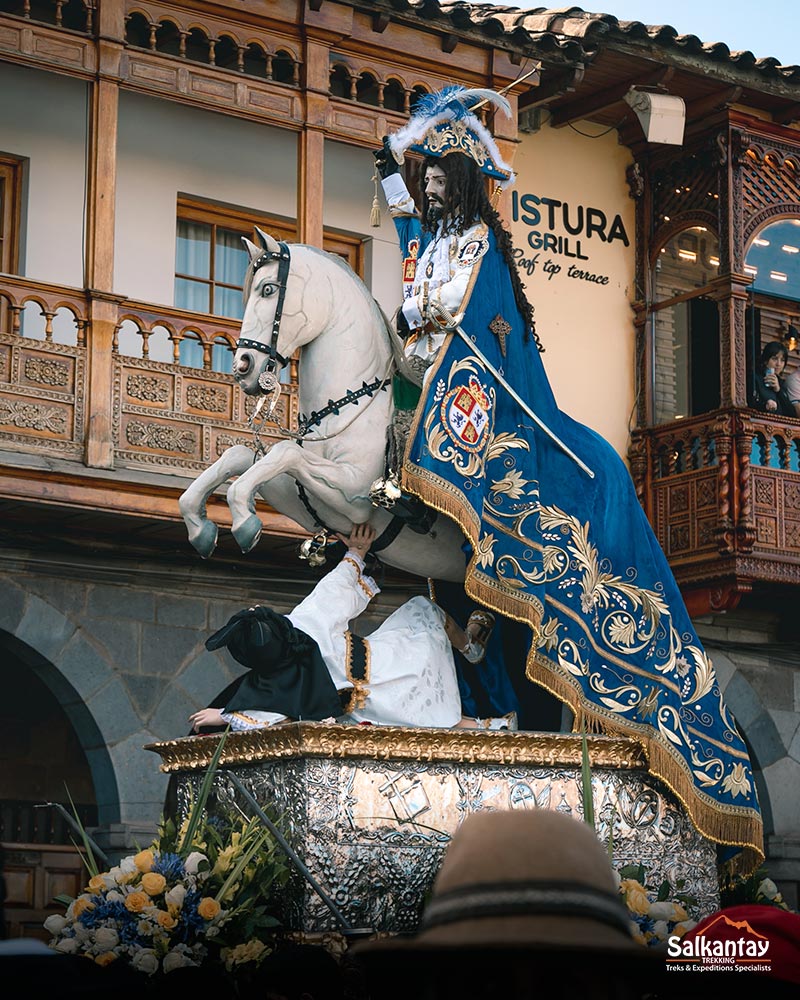
He was a physician and bishop in Armenia during the early centuries of Christianity. He is credited with the miracle of curing a child who was choking on a fishbone in the throat, which made him the patron saint of throat illnesses.
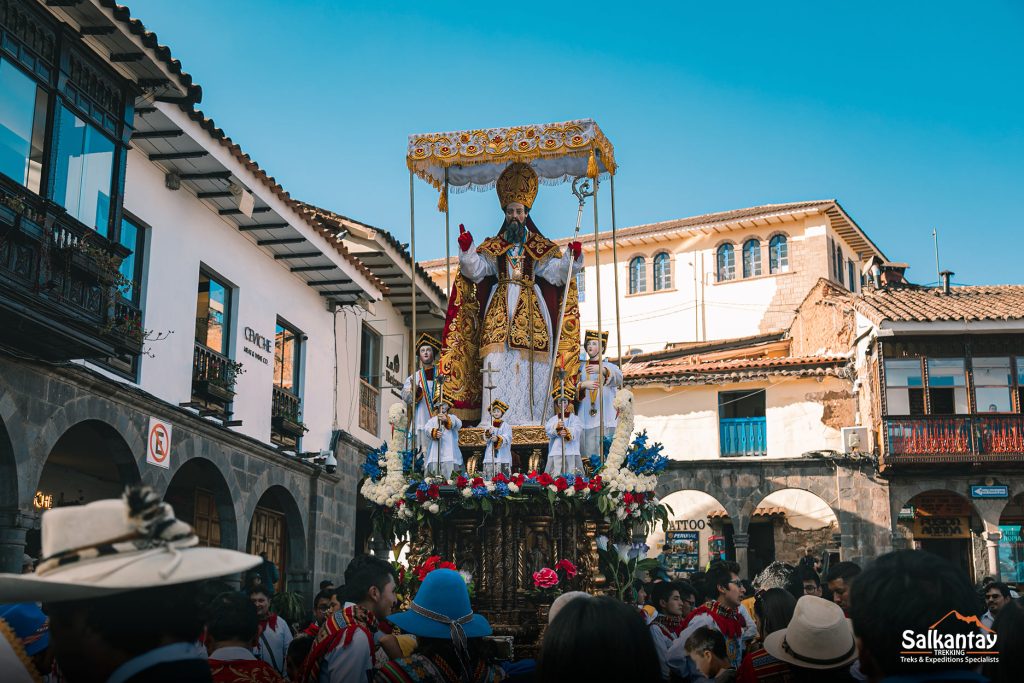
He was one of the twelve apostles of Jesus Christ and is considered the first pope of the Catholic Church. He is venerated as the patron saint of fishermen and the Catholic Church, and is known for his leadership in spreading early Christianity.
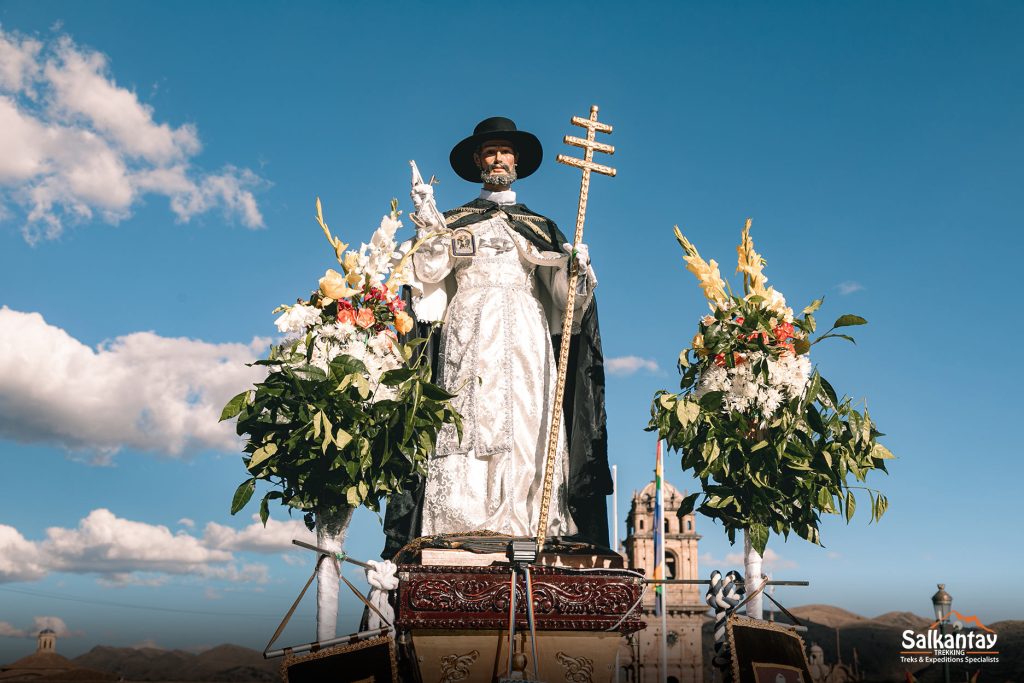
The figure of Saint Joseph is more prominent in the Gospel of Matthew, where his role as the husband of Mary and the adoptive father of Jesus is narrated. He is described as a devout man who obeyed the divine instructions he received in dreams.
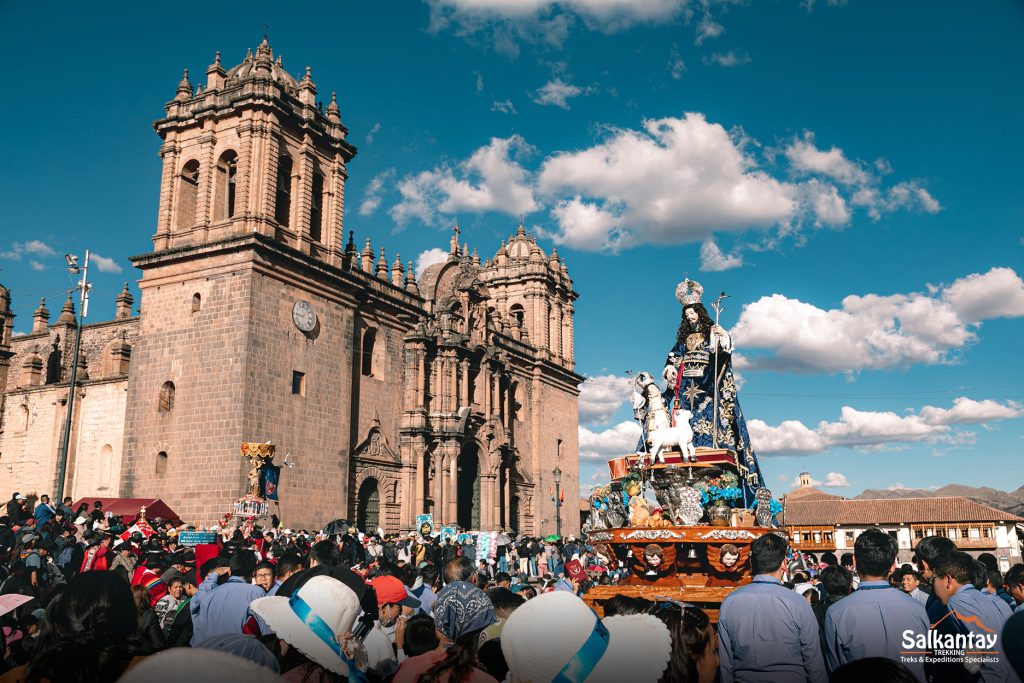
Her artistic representation has been a source of inspiration for artists and believers over the centuries. She is often depicted as a loving mother holding her newborn, surrounded by shepherds and angels, who in turn celebrate the arrival of Jesus.
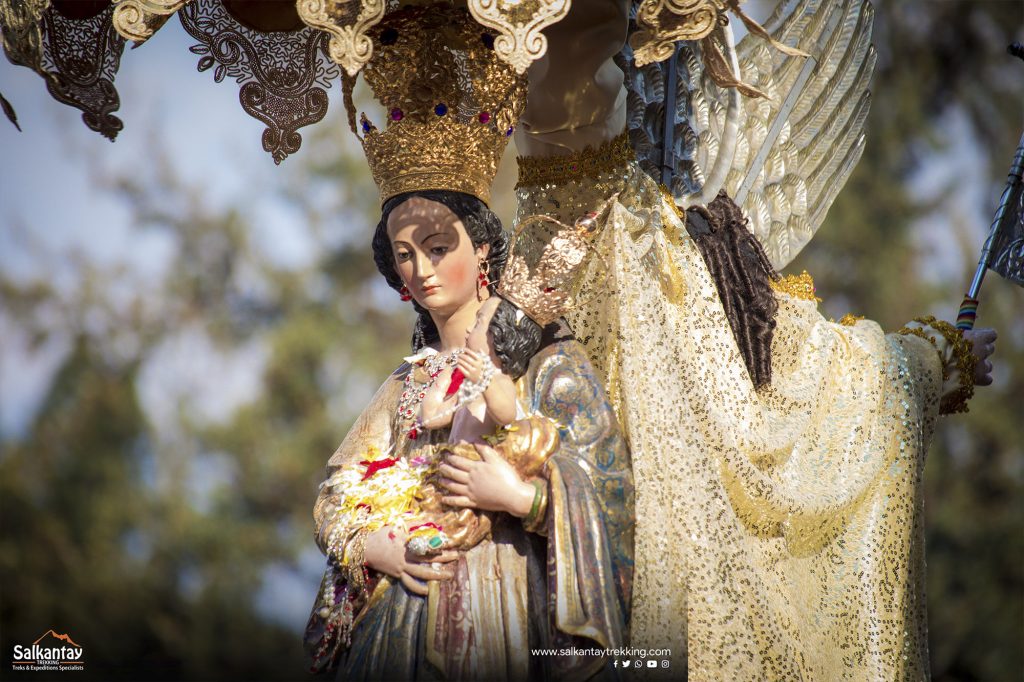
Her story is closely related to the evangelization of the indigenous peoples of America. This image is a Marian advocacy venerated in the Catholic Church, associated with protection and intercession in times of difficulty, being a source of comfort and hope.
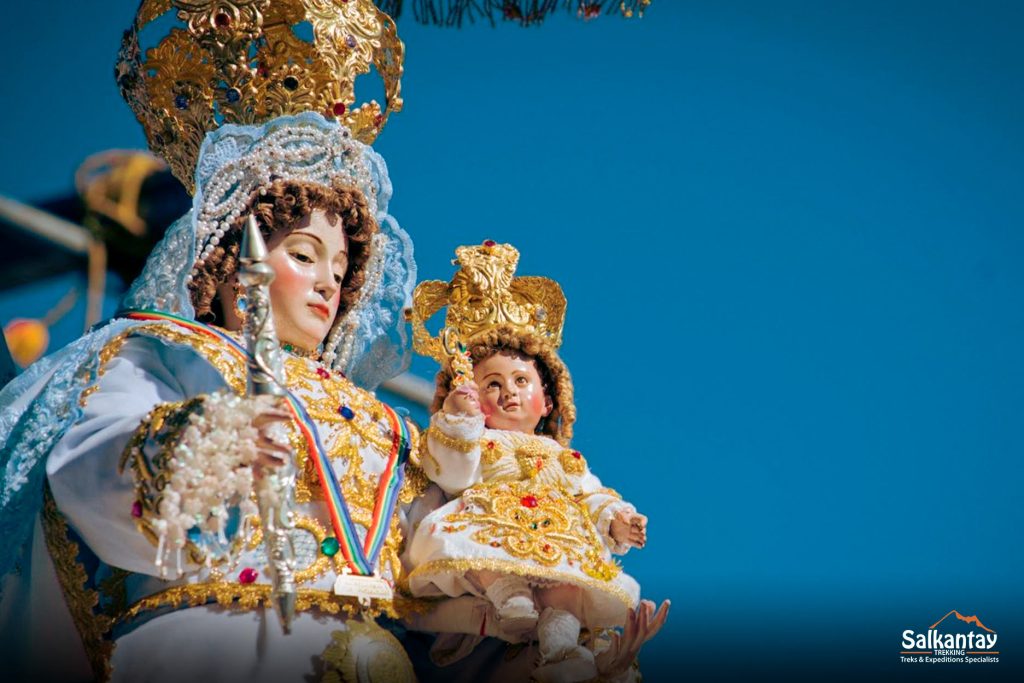
She is considered a model of Christian life for those who seek to imitate her dedication. It is said that Joachim and Anne, parents of Mary, who were sterile for a long time, conceived her miraculously. In gratitude, they dedicated their daughter to the service of God and took her to the Temple when she was only three years old.
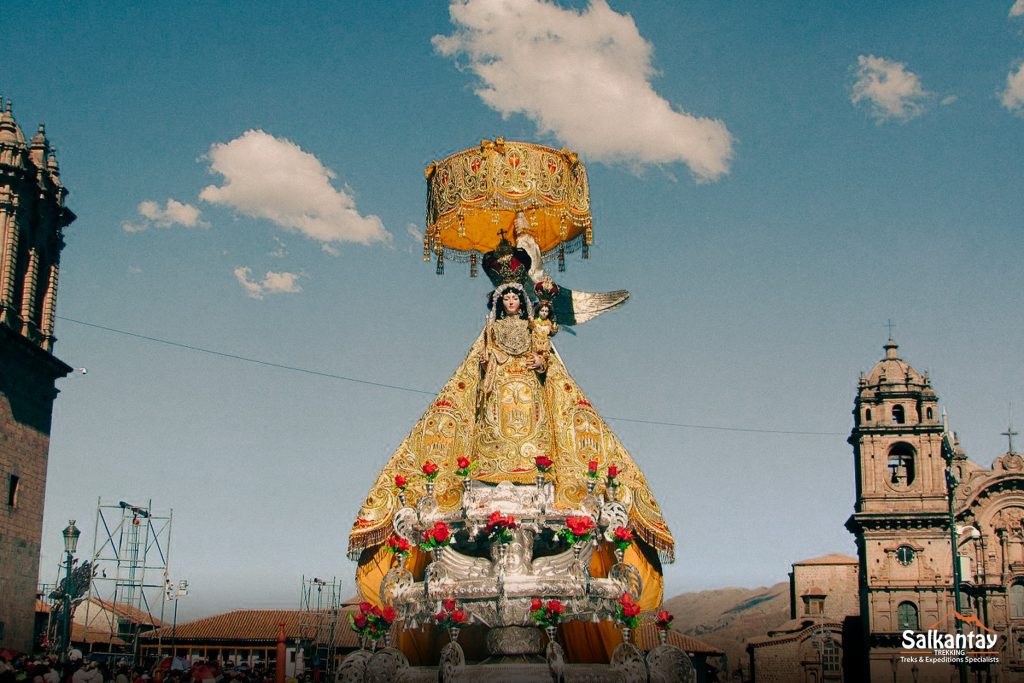
Also known as “Mamacha Belén”, she is considered a loving and compassionate mother who intercedes for her children before God. According to tradition, devotion to this Virgin originated in Cajamarca in northern Peru. Her image was found by a local shepherd on “Cerro de Belén” in the 16th century.
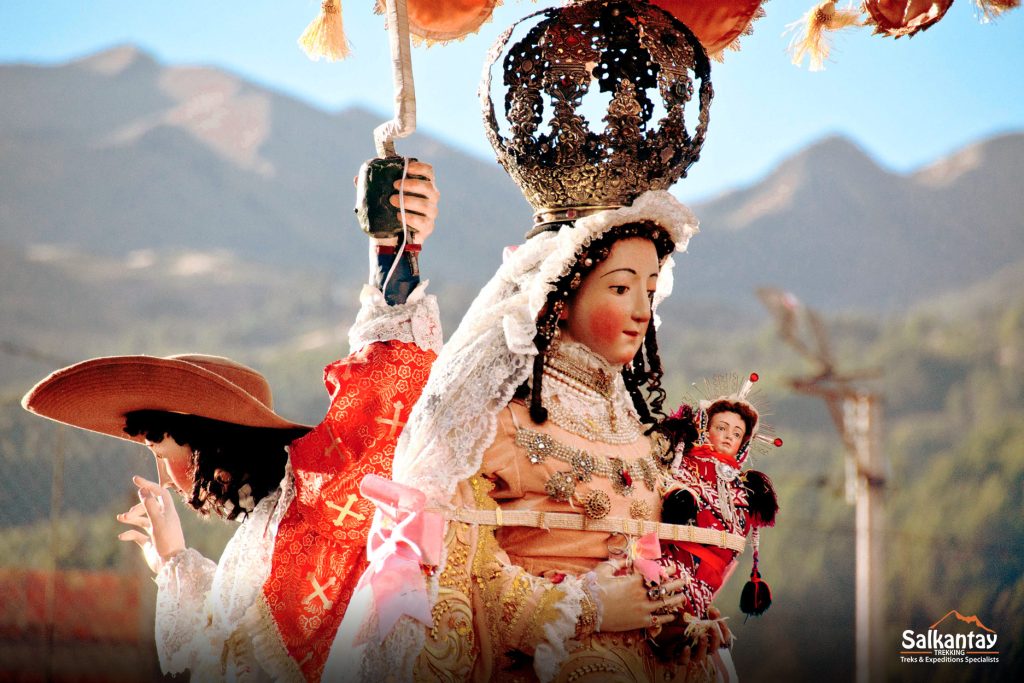
Affectionately known as “La Linda” for her beauty and spiritual purity, this image is venerated as an example of grace and holiness for Catholic faithful. She is often depicted as a celestial figure, surrounded by stars and with a moon at her feet, symbolizing her victory over evil.
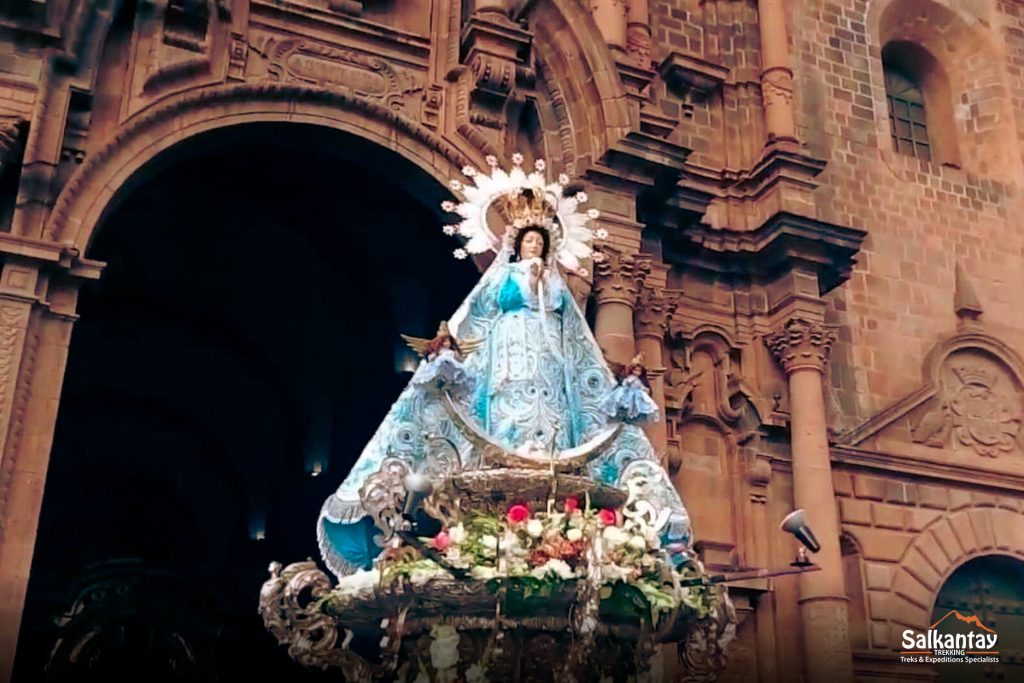
Sale of typical dishes. In the squares and streets surrounding the historic center of the city, the commercialization of the famous and acclaimed “Chiriuchu” increases. This is the main dish of the eagerly awaited procession. You can also find all kinds of street vendors selling seasonal fruits, handicrafts, and clothing.
Chiriuchu. It is a traditional dish of Cusco’s gastronomy in Peru, especially associated with the Corpus Christi festivity. The term “Chiriuchu” comes from the Quechua language. Some claim it means “cold spicy,” while others say it means “cold mix.”
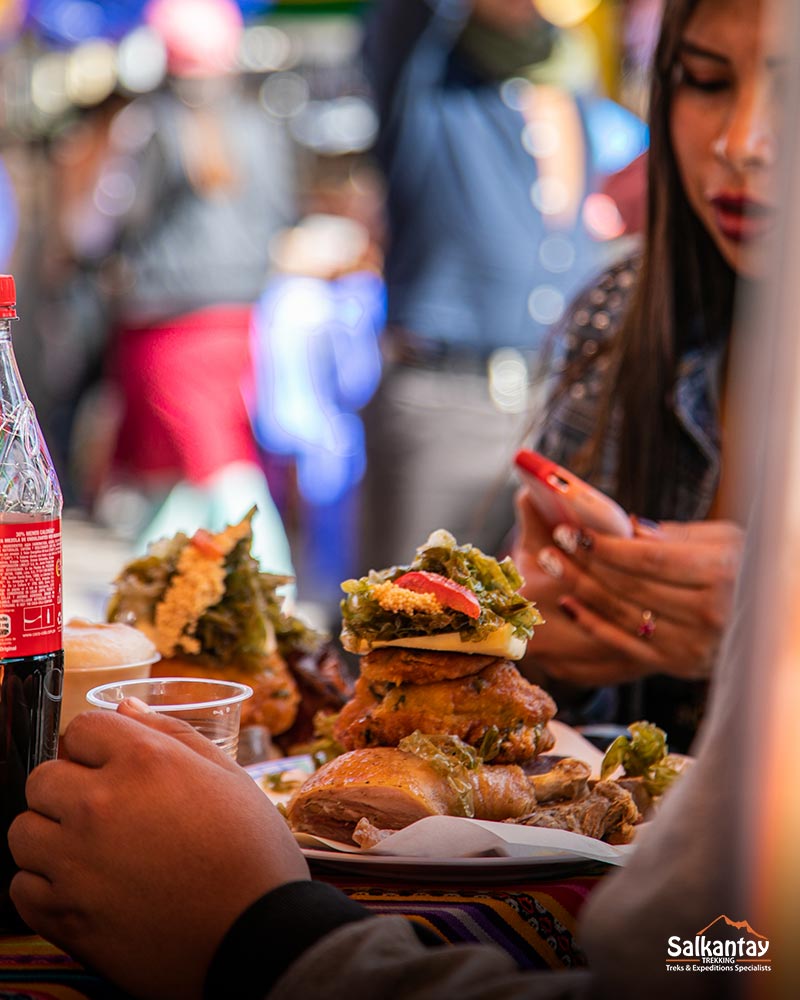
Regional products in one dish. Among the main ingredients of Chiriuchu are guinea pig, chalona or dried llama or alpaca meat, “rocoto relleno” peppers stuffed with cheese, chicken, “tortilla”, sausage, hard-boiled egg, “cochayuyo” or seaweed, toasted corn, fish roe, among others.
Octave of Corpus. After blessing the faithful, the saints stay in the Cusco Cathedral, from where they will leave again eight days later. It is then that the celebration is renewed with the arrival of “the octave” of Corpus Christi. All activities are renewed, and the streets once again witness the passage of the saints returning to their respective parishes.
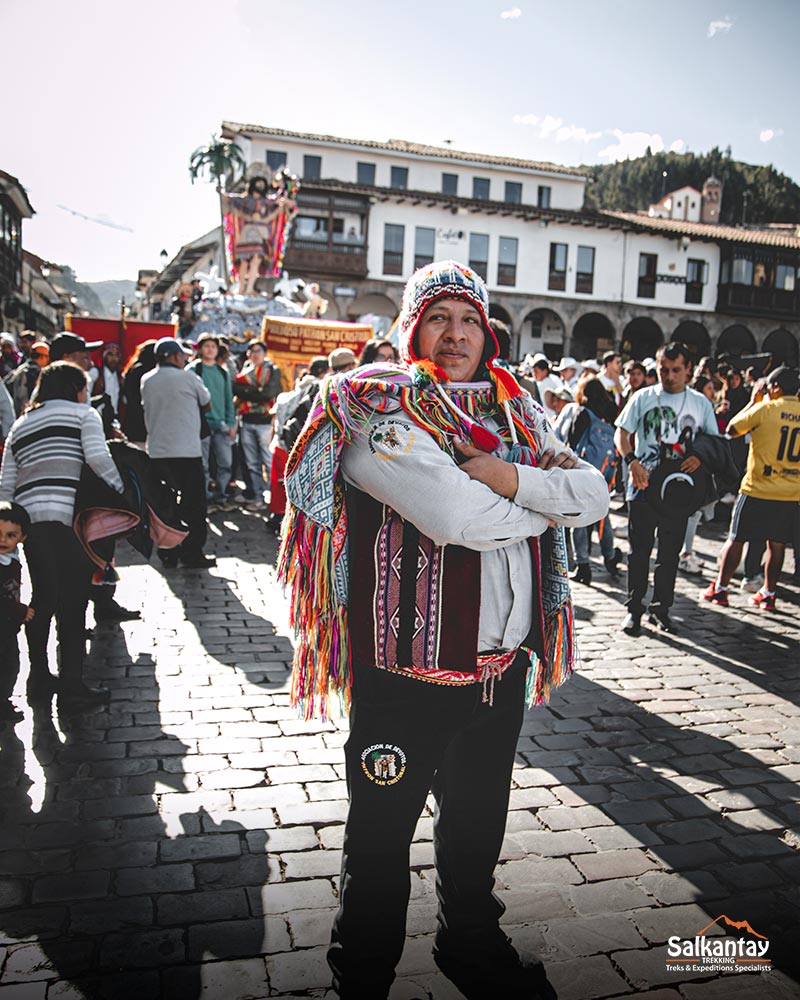
Different dances. Many traditional dances like Mestiza Qoyacha, Contradanza, and Capaq Qoya showcase their presence in the city. The population enjoys watching the performances of the inevitable and joyful Chauchos, Qollas, and Ukukus or Pabluchas also known as bear men. Each costume symbolizes a mythical character of the region.
Bands and troupes competition. Musicians from each neighborhood play for their respective dances, generating a competition with other bands. These troupes and orchestras, in their own way, celebrate their traditional festival.
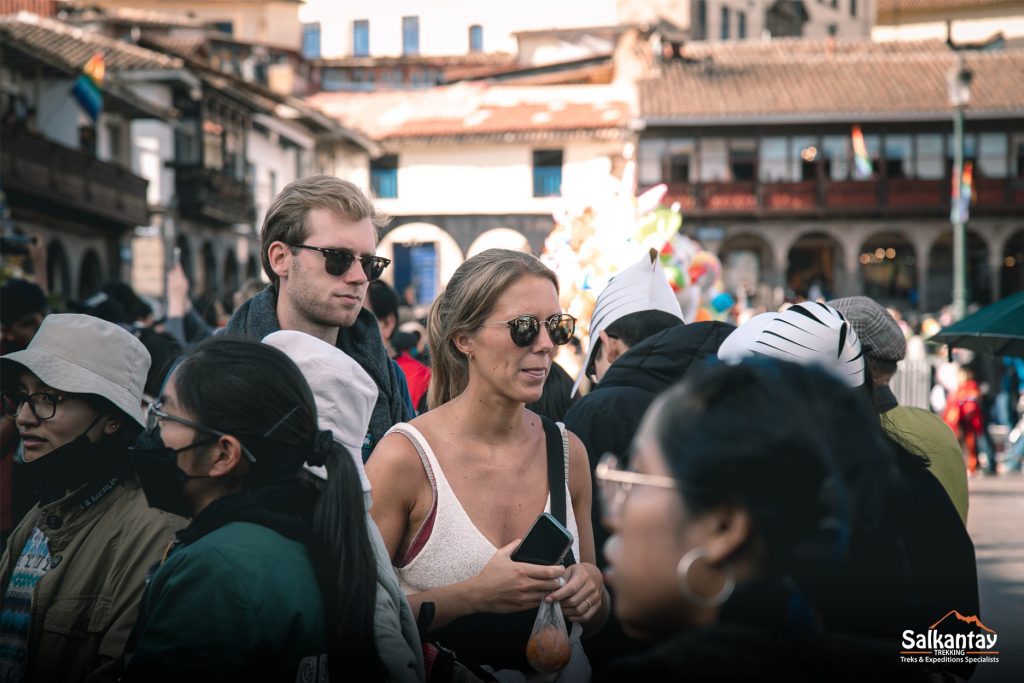
You can enjoy an unforgettable experience during Corpus Christi in Cusco by following these tips:
Plan ahead. Make sure to book accommodation and transportation in advance. Planning ahead is crucial as Corpus Christi is a highly popular festival in Cusco. Take precautions if you’re planning to visit during this time.
Participate in the processions. Try to join the processions as they are the focal point of the Corpus Christi celebration. It’s a unique and thrilling experience where you can traverse the streets of the city’s historic center.
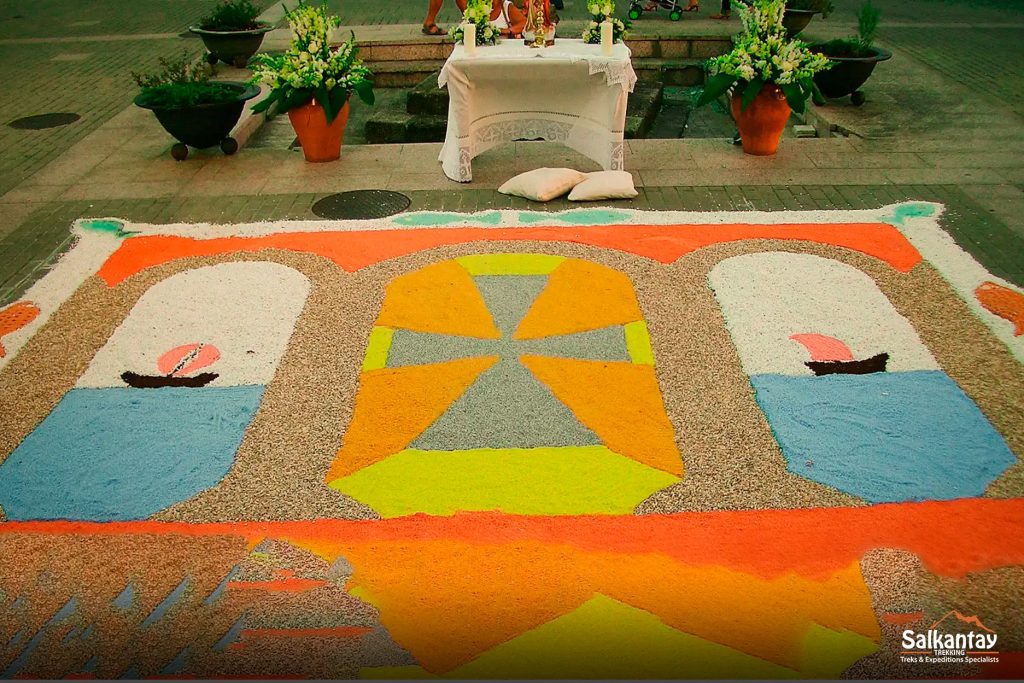
Admire the flower and sawdust carpets. During the celebrations, the streets and squares of the city are decorated with elaborate flower and sawdust carpets. Take the time to admire these beautiful ephemeral artworks and capture some memorable photos.
Explore local cuisine. Seize the opportunity to taste delicious Peruvian food during your visit to Cusco. Enjoy the delightful Chiriuchu with your friends and family.
Enjoy music and dance. Don’t miss the chance to enjoy traditional Andean folk music and witness dancers perform colorful folk dances in the streets and squares of Cusco.
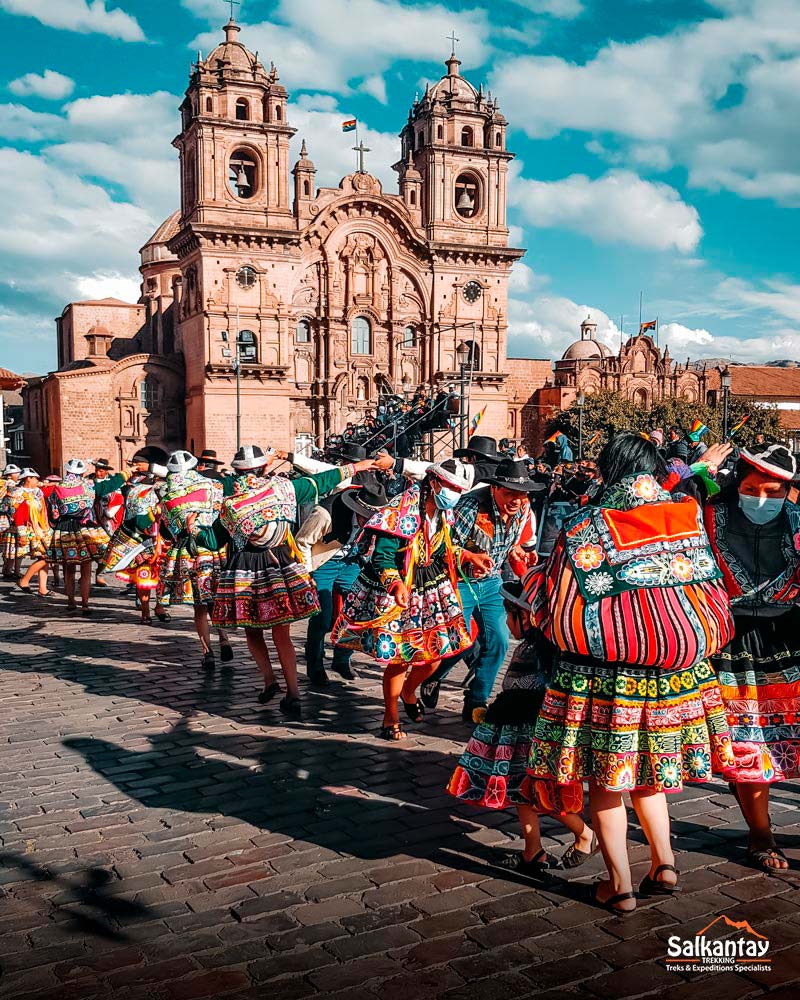
Respect traditions and religion. Remember that Corpus Christi is an important religious festival for the local community. Participate respectfully in religious activities if you decide to join them.
Explore the surroundings of Cusco. Take advantage of your visit to Cusco during Corpus Christi to also explore nearby archaeological sites, such as the Sacred Valley and the Inca ruins of Sacsayhuamán.

The Corpus Christi festival in Cusco, Peru, is a celebration rooted in the arrival of Catholicism to the region during the Spanish colonial era. Although it didn’t exist before the conquest, it has become an integral part of the cultural and religious identity of Cusco and the entire Andean region.
This year, Corpus Christi continues to be an occasion to celebrate faith and tradition where people from all over the world gather to honor the saints who have been a source of inspiration and comfort. Moreover, this celebration is an opportunity to experience the rich cultural and religious heritage of the region.
Salkantay Trekking
You might also like.
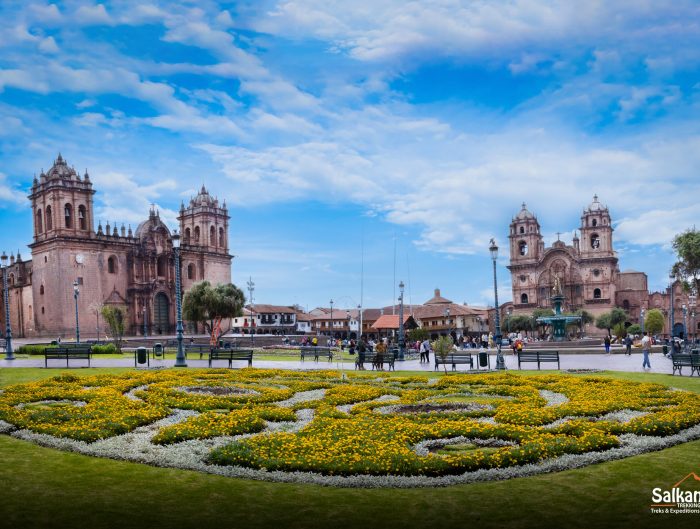
Leave A Reply
Leave a reply cancel reply.
Your email address will not be published. Required fields are marked *
Save my name, email, and website in this browser for the next time I comment.
Popular Posts

Recent Posts
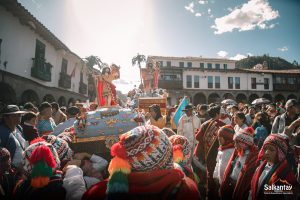
- Choquequirao Treks
- Huchuy Qosqo Trek
- Lares Trek to Machu Picchu
- Inca Jungle to Machu Picchu
- Inca Trail Classic 4 Days
- Inca Trail Short 2 Days
Alternative Treks
- Machu Picchu One Day Tour
- City Tour Cusco – Half Day
- Sacred Valley of The Incas 1 Day
- Ausangate Rainbow Mountain 1 Day
- Huchuy Qosqo Trek 1 Day
- Humantay Lake Full Day
- Sky Camp & Humantay Lake 2 Days
Social Media

The Esquire Travel Guide: Ecuador, the Galapagos, and Peru
S hould a trip to Ecuador or Peru be on your bucket list , know this; either destination alone is entirely worth travelling across the globe for.
Know also that a single trip will, inevitably, barely scratch the surface – rather than having ‘done’ these countries, you will instead find yourself filled with a persistent and insatiable desire to go back, to explore vastly more of each country’s rich and extraordinary culture, ecosystem, and cuisine.
And know, finally that, when you set foot on the shores of the Galapagos, you will almost certainly be greeted, immediately, by a sea lion, and it will take every ounce of willpower that you have not to stroke its furry fat belly.
There are, of course, infinite ways you could explore Ecuador, the Galapagos, and Peru – but here’s one, and it’s real good. Trust us, we’ve checked.
To begin in Quito is a win-win. The capital of Ecuador is a beautiful historic city in which to acclimatise to the altitude which will be your perennial companion (and occasional nemesis) throughout your trip.
Casa Gangotena , a beautifully-restored colonial mansion in Quito’s Old Town, is a perfectly-placed base from which to explore the relaxed, bustling neighbourhood. Up on the rooftop terrace, look out across the city and drink in both the spectacular view and one of the signature cocktails - go for the ‘ Diablada de Píllaro ’, a punchy combination of rum, apple, ginger and hot pepper, if you’ve got nowhere to be the next morning. Down in the restaurant , gorge on ceviche (NB. assume you’ll be gorging on ceviche more or less constantly throughout your trip) but do take pains to seek out the cream of potato soup - no, genuinely – which, with its delicate combination of truffle, poached egg, cocoa nibs and onion foam, is an absolute showstopper.
CHECK AVAILABILITY
The Old Town is a UNESCO World Heritage Site – full of ornate, beautiful cathedrals, tiny family-run shops, and street vendors offering everything from scarves to corn. For a concentrated hit of traditional commerce, head to Mercado Central – the vibrant and lively market. Amidst bustling stalls piled high with fresh fruit and vegetables, chilled meat counters, and vendors selling almost addictively-moreish herbal teas, the market is also home to the curanderas - traditional healers who use natural remedies to cure ailments and imbalances, both spiritual and physical.
Ecuador is home to some of the finest chocolate in the world – much of it made with the superior Arriba bean – so take a Chocolate Masterclass to learn all about it. Chez Tiff offers an immensely-enjoyable afternoon which deftly combines rigorous academic study with eating huge quantities of incredibly high-quality chocolate, so arrive hungry to learn (and, you know, in general).
A short cycle away from the Old Town is Quito’s beautiful Botanical Garden . Ecuador is also the orchid capital of the world – there are over 4500 species – and here a dazzling array are on display (along with a wide-ranging collection of bonsai trees, if that’s your thing).
And from more or less wherever you are, look up and you will be greeted by the enormous statue of the Virgen de El Panecillo, who overlooks the city. A pilgrimage up to her hilltop vantagepoint is well worth it.
THE CHOCÓ RAINFOREST
There’s no quick ‘n’ easy means of making it to Masphi Lodge , but the bumpy three-hour drive northwest of Quito is more than worth it. Deep in the heart of the Chocó Cloud Forest, through gates not unreminiscent of the entrance to Jurassic Park, Masphi Lodge is a lush modernist hotel and resort that blends entirely into its unique surroundings.
Mashpi began as an ecological project – the owner, Roque Sevilla, a businessman and former mayor of Quito, purchased the land in order to protect it from destruction at the hands of a timber company. Today the 6,178-acre nature reserve, which is entirely carbon neutral, is home to over 400 species of bird, frog, tree, and endemic species – many of which can be seen through the spectacular floor-to-ceiling windows which cover one entire side of the building. You’ll inevitably want to get up closer than that, though, and Mashpi’s expert team of guides offer round-the-clock expeditions in which to inspect the flora and fauna in thrilling detail. For a truly staggering view, ascend to the canopies and ride the Dragonfly gondola or the pedal-powered Skybike, which allow you to travel, suspended through the air, through the very tops of the trees, surrounded by endless forest on every side. It’s a dreamlike, awe-inspiring experience. And, before you leave, make sure you take in a night walk – it’s then that the forest seems to come truly alive, teeming with glass-bottom frogs, glow-in-the-dark spiders, skittish lizards, and umpteen more unseen (but loudly heard) creatures.
THE GALAPAGOS
A short series of flights and an entire universe away from the Ecuadorian mainland, the Galapagos - another UNESCO World Heritage Site - is an unreal destination.
Closely-monitored and carefully-preserved, the islands are a marvel of the natural world – both for what they contain, and the fact that they have been left so immaculately preserved. Much of the latter due to the fact that they are 97% national park – every visitor is accompanied by a well-trained National Guide, and preserving the sanctity of the ecosystem is paramount (no snack-smuggling onto the island is permitted).
For a restful hotel experience, Finch Bay Hotel is a winning destination. With a warm and welcoming team, and fresh seasonal food served at their poolside restaurant (you will also be attended by a number of friendly and helpful ducks), the hotel is a short water-taxi away from Santa Cruz island’s bars, shops and restaurants.
STAY, EXPLORE:
But there is, famously, more to the Galapagos than bars, shops and restaurants – you are in the midst of one of the most extraordinary ecosystems on the planet, and you’ll want to explore. So hop on board the Yacht La Pinta – the sunny and hugely-experienced crew run a tight ship, with expeditions which start bright and early in the morning, though you can opt out if you want to (NB. you don’t want to).
Each day will see you hopping into a dinghy and sailing off across a vibrant and pure blue sea which is the stuff of Hollywood films and screensavers. You’ll see Giant Tortoises – who give off a quiet hiss when they sense an approaching foe. You’ll hike across Islands formed entirely from cooled lava, the folds and rivulets of the flow forever hardened, but still giving off a feeling of rapid and powerful movement.
You’ll encounter basking sea-lions at every turn, scuttling crabs, languid iguanas, the occasional proud penguin stood, meerkat-like, surveying its surroundings before diving into the sea, and an array of mad-eyed staring blue-footed boobies (fear not, ‘I love boobies’ t-shirts are readily available in any and all of the Galapagos’ gift shops).
To snorkel in the Galapagos is to experience an embarrassment of riches. At a minimum, you’ll swim with darting schools of vibrantly coloured fish, but remain keen-eyed and you’ll likely find yourself dancing an aquatic dance with a sea lion or two (infinitely more elegant in the water than when blubbering happily across land), keeping pace with turtles as they soar angelically across the surface of the ocean, or coming into contact with dolphins, sharks (cheerfully benign), rays, and penguins.
Your life thusly changed forever, bid a fond farewell to your companions, both human and animal (it is not inconceivable that a sea lion may quite literally wave you goodbye upon your exit…) and make your way to Peru.
For a whistle-stop tour of The Land of the Incas, taking in the mighty Machu Picchu – but travelling, make no mistake, via the (incredibly) scenic route – look no further…
SACRED VALLEY
A short ride from Cusco airport, the Rio Sagrado is home to stunning views, gorgeous boutique rooms, and baby alpacas which guests can help milk twice-daily (a winning combination, overall). The property is in the lush and verdant Sacred Valley, a wonderfully-relaxing stopping off point as you begin the next leg of your expedition.
Visit the Catarata Poc Poc (Poc Poc Waterfall), a beautiful waterfall with a 30-metre drop, known as ‘the birthplace of the rainbow’.
HIRAM BINGHAM
All aboard the Orient Express of Peru – the Hiram Bingham is a fabulously-appointed luxury train which is simply the only way to get to Machu Picchu (NB. Many other ways to get to Machu Picchu are available).
A golden-age throwback, replete with cocktails on arrival, table service, a cocktail bar carriage with accompanying live band, and a gorgeous open-ended viewpoint at the back of the train, it’s the only train service in which a slower-than-expected journey time would be immensely welcome. You’ll set off from the Sacred Valley’s Ollantaytambo train station, and travel in fine style to a destination unlike any other…
MACHU PICCHU
Iconic, spectacular, and an almost-certainly-essential component of any first-time trip to Peru, Machu Picchu is a Peruvian Historical Sanctuary, a UNESCO World Heritage Site, and in 2007 was voted one of the new seven wonders of the world. It’s not difficult to see why.
Sanctuary Lodge has the twin advantages of a) being extremely beautiful and b) being directly outside the entrance. You can’t go far wrong.
Though you’ll have seen all the photos, the Incan citadel is even more incredible in the, erm, stone. Set across vertiginous mountainside, the intricately-designed outpost seems utterly implausible.
Find a reputable guide, and hurl yourself into experiencing as much of Machu Picchu as your schedule, fitness and altitude acclimatisation permits. There are five day hikes available for the professional explorer – but one can glean a taste of the ancient Incan city in two or three hours, by starting at the top and marching downwards. Either way – come for the jaw-dropping ancient construction, and stay for the surprise community of llamas who will greet you utterly ignore you about halfway up.
Oh, and if you can manage it, set your alarm for 4.30am and get there bright and early, for a spectacular, brag-worthy, tourist-free photo of Machu Picchu in all its considerable glory.
Peru’s charming second city, Cusco can be reached from Machu Picchu via one all-too-short journey on the Hiram Bingham (or, again, via multiple ‘more sensible and less extravagant’ means, if you’re so inclined).
Palacio Nazarenas is a former nunnery, which has been converted into an exquisite, romantic hideout in the heart of the old city. The suites offer butler service – so enjoy a Pisco Sour made theatrically in your room, before heading down for dinner at Mauka, the hotel’s superb restaurant overseen by highly influential Peruvian chef Pía León (winner of World’s Best Female Chef in 2021).
Take a tour around San Blas, a short stroll from Cusco’s historic centre – it’s a beautiful artisan neighbourhood, and home to the remains of Pachacutec, the Incan leader who ordered the construction of Machu Picchu.
With reality on the horizon, finish your trip in Peru’s vibrant capital.
The grand, elegant Miraflores Park offers a rooftop infinity pool and a ground floor culinary treat. Tragaluz, the restaurant, is no vibeless corporate dining room, but a fully-fledged destination in its own right – offering a zingy modern menu and lethally-strong cocktails - that simply happens to be attached to the hotel.
Wander through the historic square of the Plaza de Armas, breeze through in the cafés and boutiques of the Barranco neighbourhood, and take in the pottery of the Larco Museum , replete with a vast array of treasures from across the Peru’s history, including more pre-Columbian erotic pottery than you can shake a stick at (though many of the subjects appear to be doing something along those lines).
Finally, before you leave, make sure you enjoy the ceviche you deserve. In one final shout-out to UNESCO, ceviche has been recognised by the organisation as an expression of Peruvian traditional cuisine, and appears on their ‘Intangible Cultural Heritage of Humanity’ list, and there’s truly no better example of the dish than at Al Toque Pez. The hole-in-a-wall café is as rough and ready as they come, but there’s real magic in the soup – so work up your appetite in the queue, and treat yourself to a truly transcendent bowl of the good stuff.
And there you have it – a once-in-a-lifetime trip. The only snag being, you’ll immediately want to start planning your return.
Esquire was a guest of Belmond , Metropolitan Touring , and Rainbow Tours . Rainbow Tours can offer an 11-night Ecuador & Galapagos itinerary incorporating stays at Casa Gangotena, Mashpi Lodge, Finch Bay and a four-night cruise aboard the yacht La Pinta from £7,995 per person.
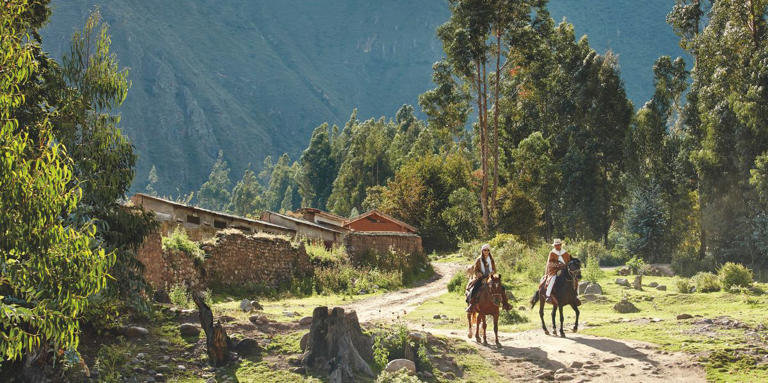

IMAGES
VIDEO
COMMENTS
Travel Tips Plan Ahead. Traveling to Peru in the peak season (June, July, August) requires a lot of planning several months in advance. This includes booking hotels in Cusco and Aguas Calientes (Machu Picchu), flights to/from Cusco, train tickets to/from Machu Picchu, Huayna Picchu tickets (limited to 400 and sell out weeks in advance) and Inca Trail permits if applicable.
Our comprehensive travel guide to Cusco, the former capital of the Inca Empire, covers things to know before you go. One of the best cities in Peru, Cusco is also known as a gateway to Machu Picchu. Read tips on the best things to do in Cusco, top attractions, tours, day trips, safety, where to stay
Cusco, Peru: The Ultimate Visitors Guide. Cusco, the ancient Inca capital, is a mix of Incan and Spanish architecture and history, with picturesque cobblestone stairs to climb up the narrow one-way streets. This UNESCO World Heritage Site is the starting point for the most spectacular things to do in Peru, like Machu Picchu and the Sacred Valley.
The undisputed archaeological capital of the Americas, Cuzco is the continent's oldest continuously inhabited city and the gateway to Machu Picchu. Cosmopolitan Cuzco (also Cusco, or Qosq'o in Quechua) thrives with a measure of contradiction. Ornate cathedrals squat over Inca temples, massage hawkers ply the narrow cobblestone passages, a ...
Table of Contents. Our List of the Best Things to Do in Cusco, Peru! 1) Purchase the "Tourist Ticket To Cusco". 2) Visit the Ancient City of Machu Picchu. 3) Orient Yourself with the City from the Plaza de Armas. 4) Visit Iglesia de Santo Domingo and Koricancha. 5) Day Trip to the Maras Salt Mines and Moray Ruins by ATV.
The Imperial City of Cusco is known as the "Navel of the World" and the former capital of the Inca Empire. It is an enchanting introduction to the Andean culture and the main gateway to the Sacred Valley and Machu Picchu Citadel. Almost all people who like to travel, have the city of Cusco among the places they have to visit in life.
Cusco is just a 1.5-hour flight from Lima and a 1-hour from Arequipa. The Cusco Airport is about a 15-20 minute drive from the center, and taxi fare is 10-15 Soles (3-4 USD). From Arequipa, we took an overnight bus to Cusco. The journey takes 10-11 hours, depending on traffic.
I have listed the two routes you have to choose from in my Cusco Peru visitor guide below, along with their advantages and disadvantages, for you to review. Lima-Nazca-Abancay-Cusco. This is the quicker route (it takes between 18-21 hours to travel between Lima and Cusco), but it also has a reputation for being less safe. Lima-Nazca-Arequipa-Cusco
Mirador San Blas: The perfect place to watch the sunset over the ochre roofs of Cusco, this viewpoint is only about 200m from Plaza San Blas along Calle Tandapata. Limbus Restobar: Widely regarded as one of the most scenic bars in Cusco, expect crowds but also some pretty incredible sunset views from the terrace.
Cusco Cathedral. The Cusco Cathedral is Cusco's oldest church, housing some of Peru's greatest collections of colonial art from the famous Cuzco School of Art. Masses are held between 6am and 10am daily. La Cathedral is located in the Plaza de Armas of Cusco adjacent to the Church of the Society of Jesus.
Best Months to Visit. The best time to visit Cusco is from June to mid-September. Though temperatures hover in the mid- to upper 60s throughout the year, the city sees fewer rain showers during ...
Explore Cusco with our travel guide. Find top attractions, local culture, and travel tips to make the most of your journey to this historic Peruvian city. ... In 1532, when the Spanish arrived in Peru, Cusco was a thriving city, and capital of one of the world´s biggest empires. The Spaniards were astonished: the city´s beauty surpassed ...
17. Visit Machu Picchu. And now last, but certainly not least, the real reason most travelers make their way through Cusco: to visit the famous Machu Picchu Inca ruins. As one of the Seven New Wonders of the World, travelers from all over the globe come to marvel at the ancient wonder.
Getting To Cusco By Plane. The quickest way to get to Cusco is to hop on a short flight from Lima. It depends on when you book, but the price will usually be around $90 USD for the one hour flight (including a checked bag). LatAm, Viva Air, and Sky are the main airlines serving Lima to Cusco.
Complete Cusco guide for travelers in Peru and expats with useful Cusco information, travel tips, best things to do and see in Cusco, addresses, and Cusco tours and more. ... nestled high in the Andes Mountains in Peru. Cusco is a place of stunning natural beauty, friendly locals, full of culture and history, and with endless opportunities for ...
Guide to Cusco. 2021 Updated Information: Comprehensive guide including information on attractions, when to go, accommodation, festivals, restaurants, tours and treks and much more! All you need to know to stay safe while in Cusco. SAFETY. Check out the best things to do in Cusco. HIGHLIGHTS. Check out the best things to see in Cusco. HIGHLIGHTS.
Cusco, Peru. Nestling in the dip of the Watanay River Valley, from above the city of Cusco takes the shape of a puma, which some historians theorize was a purposeful design. As the city expands, its borders creep up the sides of the surrounding mountains, but puma statues, fountains, and signs keep the big cat's status of unofficial city mascot.
For more info on travel in Peru, check out our comprehensive Peru travel guide and this list of 19 beautiful places. And if you could use some personalized local advice and one-on-one help planning your trip, consider scheduling a Peru travel consultation! 2 Week Peru Itinerary. Guide to the Peruvian Amazon. Ayacucho & the Central Highlands ...
Bungee jumping and hot-air balloon trips. Bungee jumping is big in Cusco. The tallest bungee jump facility in the Americas (122m) is offered by Action Valley Cusco, Santa Teresa 325 (240835, actionvalley.com), just a fifteen-minute walk from the plaza in Poroy (buses run here from block 8 of Avenida Sol).
At Cusco Local Friend, we understand that a local tour guide is an essential part of any trip to Peru; they provide valuable insights into the country's history and culture, take you to lesser-known sites, ensure your safety and security, help with the language barrier, and provide a personalized experience.
😊 Hey there description box reader! If you feel so inclined, please consider buying us a coffee or using one of our affiliate links down below to keep us on...
Top Things to Do in Cusco, Peru. 1. Grab a Boleto Turistico (Cusco Tourist Ticket) Most of Cusco's tourist sites are accessible with the purchase of the Boleto Turistico. The ticket will cost you approx. 130 soles (around $40USD) and grants you access to the chosen locations for a total of 10 days.
The Corpus Christi festival in Cusco, Peru, is a celebration rooted in the arrival of Catholicism to the region during the Spanish colonial era. Although it didn't exist before the conquest, it has become an integral part of the cultural and religious identity of Cusco and the entire Andean region.
Peru's charming second city, Cusco can be reached from Machu Picchu via one all-too-short journey on the Hiram Bingham (or, again, via multiple 'more sensible and less extravagant' means, if ...
Feb 15, 2024 - Cusco is the highlight of every Peru Itinerary, so spend at least 3-5 days in the city and enjoy the best things to do in Cusco.